




















During the late summer of 2021, I was personally working on an article covering the Chase Hill Farm in Albany, NH, and their production of hard, dry cider from heritage apple trees on the property (MWV Vibe, Volume 5: issue 17). I was there to visit the 230-acre property, meet the owners, and grab a few photos for the article.
Farm owners, Beth (Chase) Thomas and Malcolm Thomas were kind enough to include the inside of the multi-generational home as part of the tour. I noticed quite a few unique paintings in the great-room area, and it was then that I first set my eyes on the original watercolor by artist Dwight Shepler—and what is now the front cover of this very edition.
Titled Ski Runner–Carter Notch, 1938, the skier in the foreground drew me in first, and then the familiar Carter Notch region, with the Conways in the distance, and the southern stretch of the Moat Mountain Range in the background. The Thomases felt confident that the clearings just to the left of South Moat in the painting were likely their farm as it appeared during that time with its clearings
Mt Washington Valley Vibe is published four times annually and is available for pick-up, free of charge, in over 300 locations throughout the White Mountain Region of New Hampshire and into the communities of Western Maine.

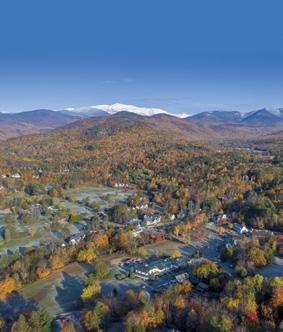

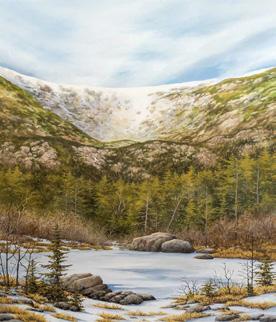

MWV Vibe is also available at many New Hampshire Welcome Centers throughout the state.
MWV Vibe can also be found in select retail shops, dining establishments, lodging properties, and grocery stores throughout the same area. If your business, or one you know, would like to make MWV Vibe available to its customers, please contact us.
©2023 Wiseguy Creative Media. All rights reserved. Content may not be reproduced or copied in any form, in part or in whole, without explicit permission. The views and opinions presented here are those of their respective authors and may not reflect the views of the MWV Vibe or its staff.

For advertising, feedback, and subscriptions, call (603) 986-5761 or email info@mwvvibe.com.
Four editions annually - $32 www.mwvvibe.com/subscribe
and open pastures. But other than that, they knew very little about Shepler. And thus began my somewhat obsessive search for additional information about the relatively unknown artist.
What we discovered was the fascinating journey of a pioneer watercolorist of the high ski country. The impact of his winter scenes helped propel skiing to its current popularity. Yet Shepler would have an even deeper attraction to the sea— one that began when he enlisted in the Navy and was assigned to duty as one of our first fighting artists.
We discovered that Shepler had ties to local ski clubs and a strong friendship with none other than local folk hero, Joe Dodge, AMC hut-master, and “Mayor of Porky Gulch.” Shepler was fascinated with Mount Washington and Tuckerman Ravine, which is quite likely the reason he chose to spend so much time in this area to begin with.
We hope that you enjoy learning more about this little-known treasure of the Eastern Slope Region. Researching Shepler’s time in the region has uncovered many tidbits of additional information—many that we share in this edition and even more that will certainly lead to future articles to come.
Visit www.mwvvibe.com/subscribe.
Dan Houde dan@wiseguycreative.com
What we discovered was the fascinating journey of a pioneer watercolorist of the high ski country. The impact of his winter scenes helped propel skiing to its current popularity.
Clem McAuliffe, Bartlett, NH
As owner of Vista Bev & Market in Intervale, Clem loves beer. He loves talking about beer, reading about beer, writing about beer, and of course, drinking beer. All who enter the store quickly understand the benefit of asking, “Clem, what am I drinking today?”

Matt Maloney, Jackson, NH
Matt is a teacher naturalist at Tin Mountain Conservation Center in Albany, New Hampshire. Formerly the Adirondack Mountain Club’s coordinator for interpretive programs, he has a degree in environmental education from Antioch in Keene, NH.

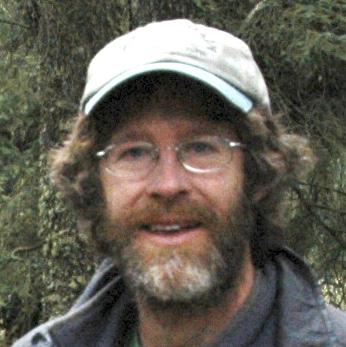
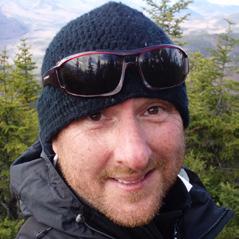
Lily Hartman, Seabrook, NH
Lily is a writer residing on the NH Seacoast who enjoys writing about health and outdoor recreation. She spends most weekends hiking the White Mountains and is part of Hiking Buddies NH 48, a hiking Facebook group. She also enjoys blogging about her adventures and going on trail runs.

Marty Basch, Conway, NH Marty writes about the outdoors, travel, food, and sports. He lives on a Valley dirt road and has been known to shovel some snow, but only after the plow guy’s done. Then he can drive to a groomed trail and play. He’s won some writing awards. Go figure.
Bernadette Donohue, Fryeburg, ME
Bernie’s love of adventure, beauty, and people started her 35-plus-year real estate career. Co-chair of White Mt Board of REALTORS Community Service Committee, Creator of MWV Photo Contest/Calendars for Charities & Hands of Hope cancer survivor banner.

Ed Bergeron, North Conway, NH
Ed Bergeron is a local weather observer, trustee, and previous executive director of the Mount Washington Observatory. He hosts the Morning Weather Show each day at 7:45 a.m. on 93.5 WMWV FM.
Charlie Buterbaugh, Fryeburg, ME
Charlie is the director of communications at Mount Washington Observatory, where he enjoys working with scientists to understand the unique relationship between weather and mountains. Whenever possible, he’s outside cycling, hiking, and skiing through the region’s stunning landscapes.
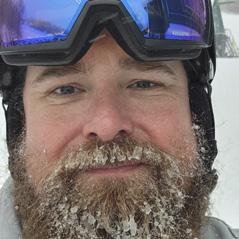
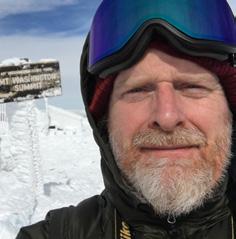
Matt Howe, Casco, Maine
Matt joined Green Mountain Conservation Group in Effingham as executive director in 2019, after a three-decade career in nonprofit management and leadership in Maine. He holds a B.A. from Bowdoin College and an M.A. in public policy from Tufts University.
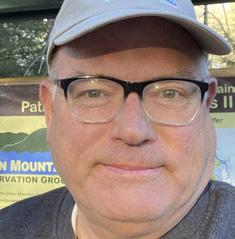
Sam Trombley, Gorham, NH
Sam is the Marketing Manager at Backyard Concept and focuses on promoting New Hampshire’s vibrant outdoor economy. In her free time, Sam can be found doing anything outside, usually skiing, trail running, or rock climbing, depending on the season. She loves to play with her new pup Scarlett and host trivia on Thursdays at Big Day Brewing in Gorham.
Brian Fitzgerald, North Conway
Brian is the director of science & education for Mount Washington Observatory. As a former weather observer for MWO and naturalist for AMC, he can be found marveling at mountains and clouds in his free time. Brian, his wife Stephanie, and their son Cameron live in North Conway.
Heather Corrigan, North Conway, NH
Originally a flatlander, Heather has called the White Mountains home for a decade now. She enjoys snowboarding down mountains and hiking up them, and exploring the natural beauty of the outdoors. When she’s not rooting for the “wrong” baseball team, she enjoys reading, music, and taking too many pictures of her cat.
Ray Gilmore, Bartlett, NH
Ray is an MWV native with degrees in biology, nursing and public administration. He is a retired Army officer with multiple combat deployments, a PSIA-certified ski instructor & USSA coach who returned to the MWV following his military service. He resides in Bartlett with his wife and their five children.
Lauren Clem, Madison, NH
Lauren has spent her weekends and vacations in the Valley for as long as she can remember. She enjoys meeting the people who make the area tick and any story that requires her to put on her hiking boots. When she’s not exploring the White Mountains, she writes for a magazine in her home state of Rhode Island.
Hilary McCloy, Jackson, NH is a Doctor of Physical Therapy and runs her own PT and coaching business in Jackson, NH. Hilary is an alumnus of the U.S. Alpine ski team and now finds enjoyment in running, biking, and skiing in the White Mountain Region and beyond.
Janis A. Pryor, Jackson, NH


Janis is a native New Yorker, a southerner by upbringing, and a New Englander by choice. A graduate of Bennington College, she majored in studio art with secondary studies in architecture. After 30-plus years of professional employment in politics and media, she has returned to her first love of painting and writing. Her next book, Mother’s Madness, will be published in the fall of 2023.
Meg Pierce is an engineer based out of the greater Boston area. She is a member of the Inclusive Ski Touring Board of Directors and enjoys leading the Women’s Program tours throughout the winter. Stories of her skiing, biking, hiking, and climbing adventures can be found on Norrona’s blog.
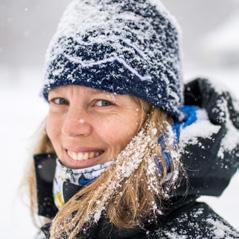

If you reside locally or have ties to the Valley and would like to offer your creative talents, please contact us at info@mwvvibe.com.
Dr. Trish Murray Andrew Drummond Tim Scott


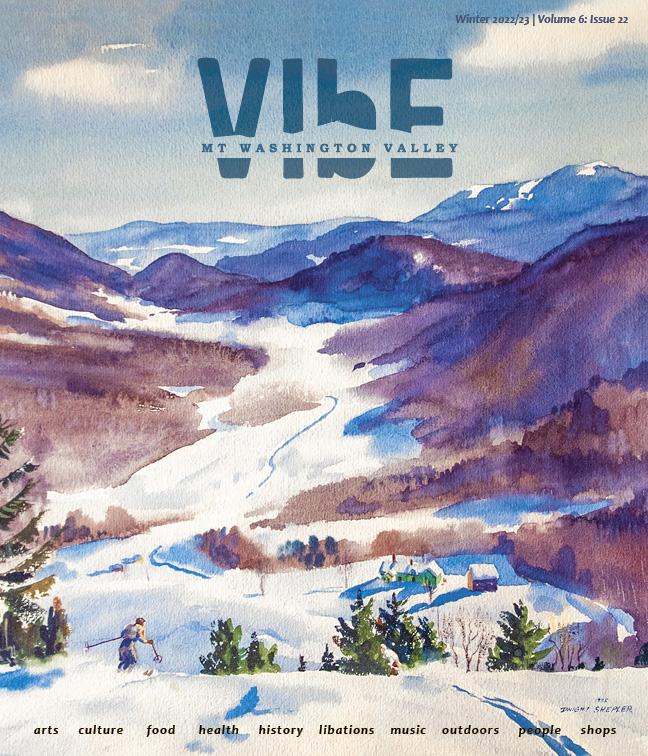
It’s a smart idea to check back often, making sure the hose remains in the place you thought you left it when filling up a hot tub. After about half an hour of water pouring into my garage, I found out the hard way that a watering hose has a mind of its own when left unattended. Like life, even when everything appears to be flowing well and in a positive direction, it’s a good practice to monitor and redirect your focus and energy to continue filling the right buckets. For me, that means family, friends, and quality time.
Recently on one of those unseasonably warm autumn days, I was taking a break from other people’s real estate needs to get some of my home projects finished. As many know, preparing for the upcoming winter season in New England is more than just prepping for holiday happenings. With the unpredictable weather arriving anytime, buttoning up things in early November still felt like I was running on borrowed time. As I had just purchased a brand-new cover for my five-person hot tub, I was excited to get that ready for enjoyment again. As I did, I recalled how much it meant to me to be the recipient of a “free” hot tub back when I was going through some of life’s unexpected challenges. A real estate client, now a very dear friend, had offered it to me when her condo association voted to no longer allow tubs on site. For years beforehand, I had imagined that someday I would be able to indulge in this luxury, like a mini vacation right from the comfort of my abode.
Excited to be able to share this gift with family and friends, it also forced me to make additional exterior improvements before being able to explore the benefits, many of which were unknown to me at the time I first stepped foot into this round Nordic spa. Starting with having a patio built, to put the tub on level ground, gave the outdoor living space a wonderful lift both aesthetically and functionally. Enjoying the outdoors without needing to leave home, became yet another one of its pleasures (and helped with our sanity during COVID times).
Over the five years that the hot tub has been part of our landscape, my three (now adult) children have all enjoyed their time together and with friends. All express continued appreciation for this next-level opportunity to soak in some bonding time over laughs and deep conversations. My son even wrote his high school speech on the many philosophical discussions that he and his friends would have during their late-night hot tubbing. Not to mention relaxing sore muscles from their days of athletics and warming up après ski under a starry, clear, and
cold night sky before rolling in the snow and warming up all over again.
As for me, I enjoy the mornings when it is quiet and the sun is still low in the sky. A cup of tea, a good stretch, and my mind easily wanders to my gratitude list of life’s many blessings. A meditative time for mind, body, and soul as I soak it all in, and allow myself some breathing time before the day’s tasks and obligations take over with a more activity-oriented pursuit.
I continue to feel like a proud mother of the younger version of myself for having taken the initiative to purchase a home, in spite of my youth and life’s uncertainties. That was over 35-plus years ago. As I would come to find out, my bold decision back then opened the door to my passion for real estate, helping others to find housing stability and a sense of place. Over the years, and with the unpredictable ups and downs of life, I think many will agree that homeownership offers much more than a roof over your head. It offers a foundation from which to grow.
My appreciation extends well beyond the four corners of my property, out to the neighborhood and community. Being a part of western Maine and the greater Mt. Washington Valley constantly fills my pleasure and purpose buckets. I’m grateful to live and to have raised my family so close to many lakes and mountains, an easy drive to the ocean or city, and in a community of wonderful people who share a fun-loving spirit, a focus of well-being, and connections that really matter.

Whatever joy and connections you wish to nurture in your home—or in that special home-away-from-home—do so with intentionality. Always remember, too, that it’s a good idea to check back and refocus your energies so that they continue to flow into the buckets you believe you were aiming for.
Bernadette Donohue, a trusted name in real estate since 1985. Bernie is a seasoned professional and dedicates her career & lifestyle to serving the community, client’ housing goals and the greater good. For up-to-date real estate & happenings, Bernie can be found in Badger Realty’s North Conway office, (603) 356-5757 x 310, (207) 542-9967, BernieD@BadgerPeabodySmith.com, www.facebook.com/NHandMERealEstate, www.berniedonohue.badgerpeabodysmith.com.
At the White Mountain Winery, you can enjoy a wide variety of wonderful wines. They carry a wide assortment of types and styles of wine, from fruit-flavored wines that are basically adult juice, to just about any dry red or white that you can imagine. White Mountain Winery also makes a wide array of dessert-style wines, including a Maple Ice Wine that tastes like pure maple syrup and packs a punch.
The next time you’re in the area, swing in and say hi to the adorable rescue pups that will greet you and keep you company while you wait to get to the bar to have a tasting. In the summer, enjoy wine slushies, and in the winter, luxuriate with some warm mulled wine—both are delicious. Tastings are done every day that the winery is open and are offered in a couple of ways to make it easy for all.
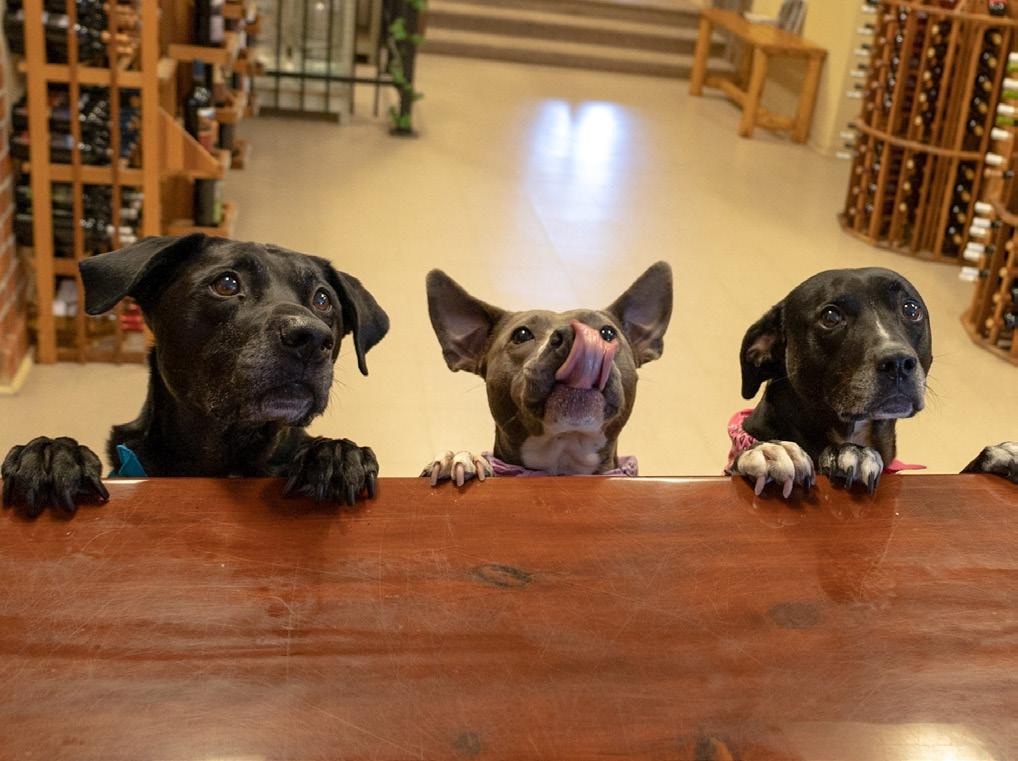
If you just want to stock up, the owners can help you with that, too. White Mountain Winery offers discounts that grow with the number of bottles that you get: the more you buy, the more you save.

The easiest way to find the winery is to walk down Reporter Court in North Conway Village; it’s just past Boston Brothers’ Pizza on the right.
For more information, call (603) 356-9643 or visit www.whitemountainwinery.com.







Spruce Hurricane has been the Valley’s foremost boutique since 1992, specializing in women’s fashion apparel and accessories. Footwear, activewear, and skiwear are among the curated collection in their distinct “mountain chic” style. All items are hand-selected with a focus on quality and artistry for the discerning shopper.

Western boots and handcrafted Navajo jewelry echo the owner’s native ancestry. Moccasins and leather goods are staple items that were carried on from her grandparents’ trading post. European designs in fashion honor the historic ski town in which the shop is located. All of these influences come together in the merchandise mix, that for 30 years, has created a following of Spruce Girls.
The Spruce Girl loves an active lifestyle of outdoor adventures, travel, and leisure. She feels connected to nature while still embracing her femininity. At Spruce Hurricane in North Conway Village, you will find something for all of life’s moments.

For more information, call (603) 356-3854.
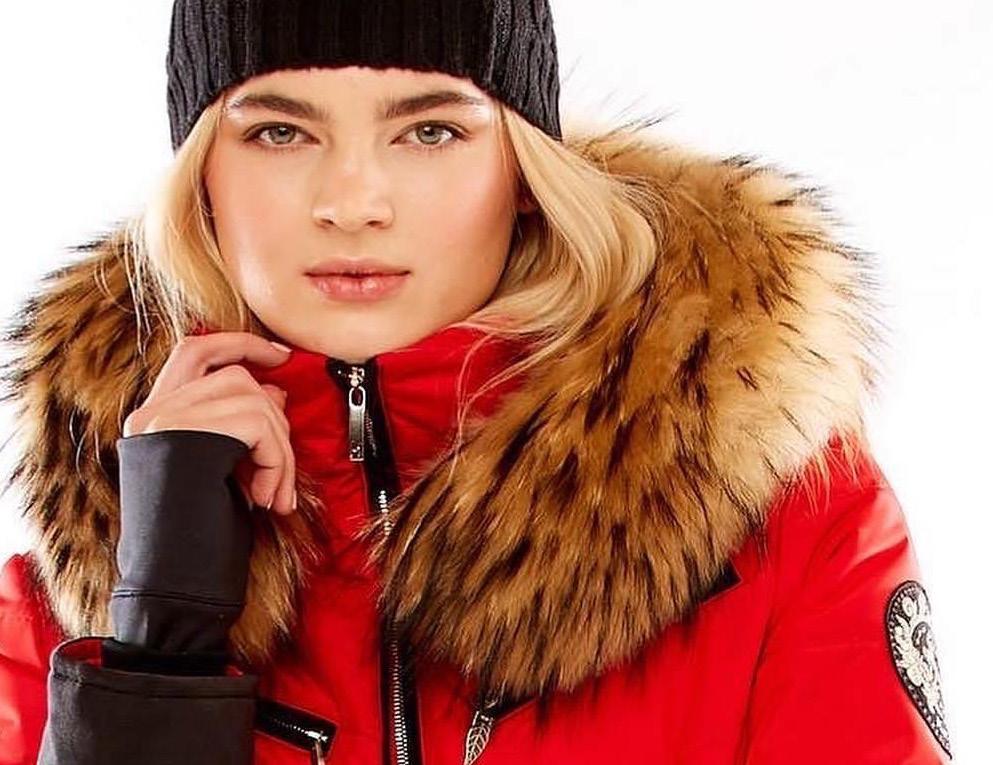
Many skiers of all disciplines will likely remember the early 1970s, a time when downhill (alpine) skiing was in its heyday. The newly christened Mt. Washington Valley (previously known as the Eastern Slope Region) had five booming ski areas, with three more close by. In the years following World War II, the little village of Jackson had seen the benefits of this outdoor endeavor, as winter was no longer a dormant time in the area for visitors. Winter enjoyment was here to stay.
Not to be overshadowed by the booming downhill ski business, a group of innkeepers in and around Jackson seized upon the idea of creating a cross-country (or Nordic) ski resource to
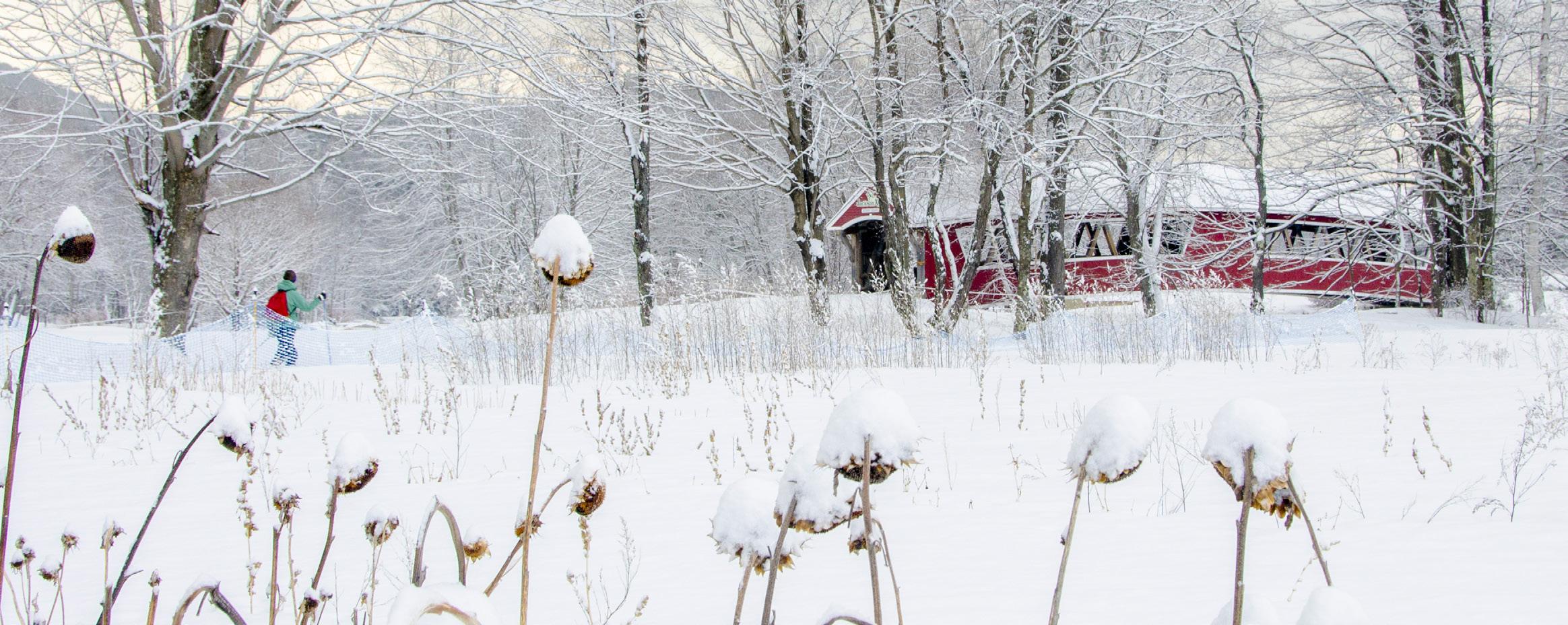
skiing locations, including Great Glen Trails in Pinkham Notch, Mount Washington Valley Ski Touring in Intervale, Bear Notch Ski Touring in Bartlett, and Bretton Woods XC in Crawford Notch. In addition, public access trails have been created in and around the Valley.
Framed as a non-profit educational organization, Jackson XC continues to follow its mission to provide healthy outdoor sporting activities for people of all ages at a reasonable cost. School children enrolled in the local grammar school enjoy a cross-country ski day each week alongside their corresponding Eastern Slope Ski Club downhill day. With the integration of a seasonally available base lodge facility in downtown Jackson and daily trail grooming reports, Jackson XC has become arguably the preeminent Nordic skiing resource in New England.
The idea for the Jackson cross-country network likely came from Brad Boynton, who owned the Wildcat Tavern. Along with locals such as Peggy Frost, these individuals began to stitch together a loose contingent of Jackson landowners who were willing to open their land for this arguably light-impact activity.
offer a way for visitors to get out and enjoy the snow. Wonderfully cost effective (no lifts, no lodges, and far less expensive gear), cross-country had long been the pursuit of a small but passionate population of outdoor enthusiasts. Aligned in some ways to the people of Scandinavian countries, cross-country skiing also was the precursor to downhill skiing, dating back centuries.
The idea for the Jackson cross-country network likely came from Brad Boynton, who owned the Wildcat Tavern. Along with locals such as Peggy Frost, these individuals began to stitch together a loose contingent of Jackson landowners who were willing to open their land for this arguably light-impact activity. What made Jackson XC unique from the start was the unusually cooperative arrangement between the ski foundation and Jackson citizens that has stood the test of time. Fifty years later, after much expansion, this model is both unique and thriving. Jackson’s growth has spawned other nearby cross-country
But as it celebrates its 51st anniversary during the 2022/23 season, there is still much more to be done!
Much has been said about how warmer winter months and declining snowfall rates have affected the availability and longevity of the cross-country skiing season. Once snow covered from November until April, the far edges of the ski season here in New Hampshire have slowly crept nearer. To alleviate this problem, Jackson XC along with other ski areas, have taken active steps to prolong the season. These actions include adapting trail terrain to better hold snow, as well as incorporating portable and fixed snowmaking capabilities. For the first time this year, Jackson XC is seriously considering the latter with the help of a capital fundraising campaign currently in progress.
For more information on Jackson Ski Touring foundation’s winter operations or non-profit mission, visit the Jackson Ski Touring Foundation’s website at www.jacksonxc.org or call (603) 383-9355.

The obscurity of this prominent artist belies his talent and the breadth and scale of his contribution to the Eastern Slopes Region—and the world.
The White Mountains of northern New England have enticed many artists to the region, especially during the winter months. Artists are often asked, “What’s your muse? Your source of inspiration?” Look around. The jaw-dropping natural beauty of the White Mountains—previously called Eastern Slopes Region—has always been quite the draw for many notable artists such as Benjamin Champney, Thomas Cole, and Alfred Thompson Bricher. Rivers, lakes, waterfalls, the wide-open night sky sprinkled with stars, the silence of freshly fallen snow, and the dazzling light that bounces off fields of snow and the granite mountains clothed in white, are gifts to many artists. The drama of the notches, the omniscient presence of the Presidential Range, and the presiding, preeminent authority of Mt. Washington, are humbling. Under the right conditions, the White Mountains, Tuckerman Ravine, Mount Washington, and the Presidential Range, can be mesmerizing.
There was one artist who was captivated by this region. He was impressively talented, a professional artist who mastered one of the most difficult mediums—watercolor. His artistic skills left their mark on the region, reflecting a powerful way of literally seeing the White Mountains and the Eastern Slopes region. Yet

few people know of him. His name didn’t populate conversations about art. There are few books still in print about him or his work that started in this region during the 1930s. His name is Dwight Shepler, and he has not received the attention his work deserves.
Born in Everett, Massachusetts in 1905, Dwight Shepler graduated from Williams College and taught painting in several Boston area schools. Best known for watercolors of his favorite sports—skiing and sailing—Shepler also created illustrations and advertisements for a number of major magazines and corporations. Shepler would eventually be recognized as a pioneer watercolorist of the “high ski country,” but it’s not completely clear what brought him to northern New England. We do know that his passion for winter landscapes and his love for skiing delivered him to the Eastern Slopes Region of New Hampshire via his ski club in Woodstock, Vermont. The breathtaking beauty of Vermont yielded to the powerful height and dramatic landscape of northern New Hampshire.
It was during the late 1930s when Shepler’s Woodstock ski club started visiting the Eastern Slopes of New Hampshire for ski races and other winter activities. A great deal of time was spent on the Bear Mountain Trail in Bartlett, the Taft Trail on Cannon
LEFT: This Dwight Shepler watercolor from the 1930s shows local ski club members skiing on the Bear Mountain Trail, in Bartlett, NH. Cut by the Civilian Conservation Corps (CCC) in the summer of 1933, the Bear Mountain Trail was over 2 miles long with nearly 2,000 feet of vertical drop. Regional ski clubs, including Shepler’s Bartlett club, ran invitational races on this trail starting in 1937. ABOVE: Shepler was fascinated with Mount Washington and made numerous trips to the Tuckerman Ravine area between the 1930s and early 1970s. “Tuckerman Ravine became to me something like what Mont Sainte-Victoire was to Cézanne; but the parallel stops there!” said Shepler in his book, An Artist Horizons. “Countless times I have made studies in that great bowl; and about once a decade have produced a watercolor or oil, all of them different.” It was during these early trips when we feel that Shepler and Joe Dodge would become close friends. Dodge, also known as “The Mayor of Porky Gulch,” was the chief hut-master of the Appalachian Mountain Club chain whose headquarters were in Pinkham Notch.
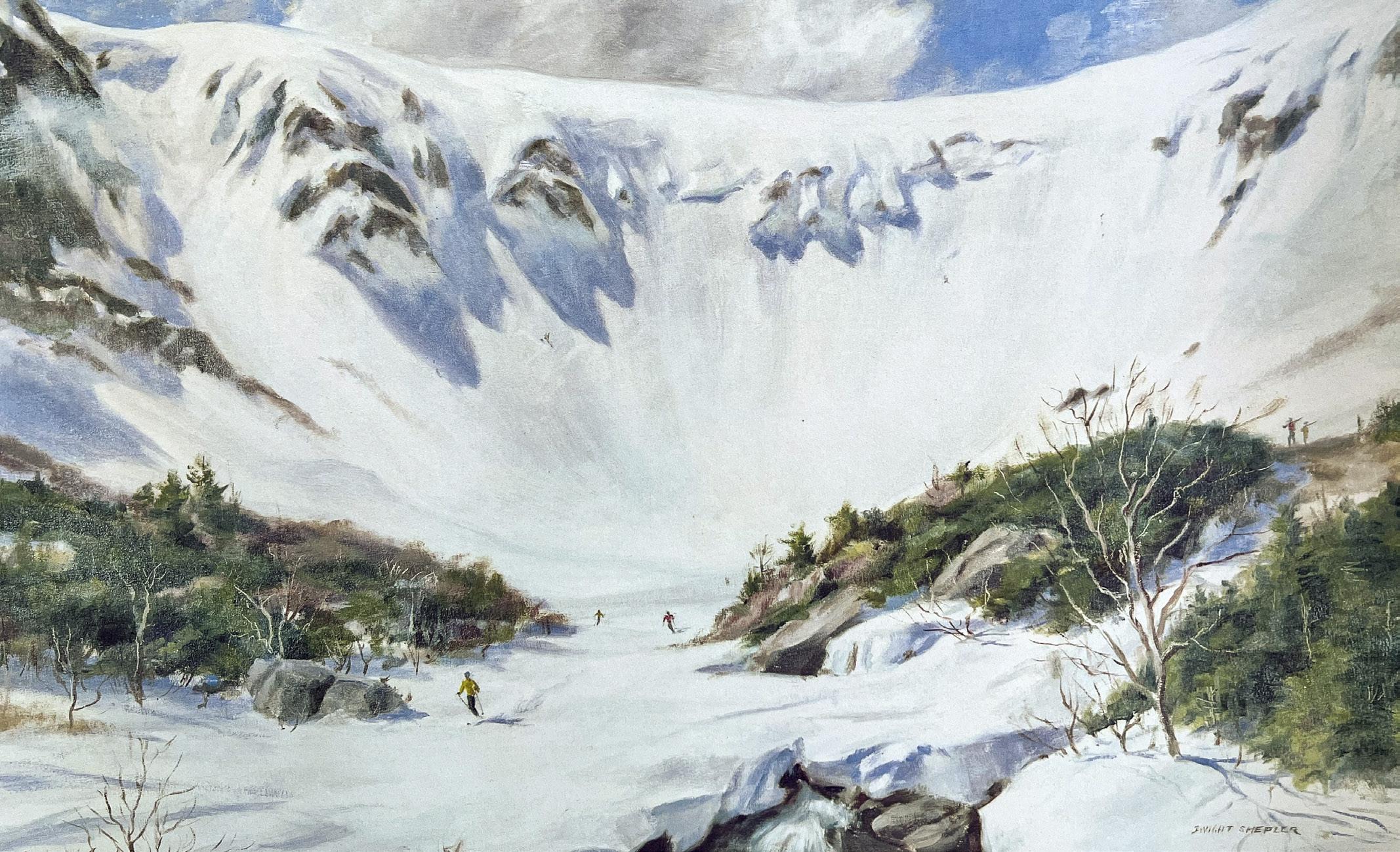
Mountain, and the Wildcat trails, which were just beginning to open up. It also became easier to travel from metro Boston during the 1930s, with the advent of ski trains departing from Boston that made stops in North Conway and then on to Jackson and Barlett. Finally, in 1940, Shepler’s Vermont ski club found what would be their forever home—an old farmhouse in the Jericho area of Bartlett in the White Mountains.
Skiing in northern New Hampshire was, and still is, a seductive, daring challenge to those who love the sport—whether it be downhill or cross-country. And if you’re also an artist, depicting this sport and all that goes with it, is irresistible. You’re driven to capture your vision of the environment and the activities that define it. Shepler’s primary medium was watercolor. It is one of the hardest mediums to master, demanding precision, patience, and discipline.
What’s enchanting about Shepler’s paintings, posters, and murals, is that the viewer can feel his attachment to the land and
his joy for the sport, see the beauty of the White Mountains through his eyes, step back in time, and vicariously become part of the skiing community and the appeal that went with it during that time.
Many living in the region have seen and admired Shepler’s murals, paintings, and posters without knowing they were his, much less anything about him or his significance to the art world.
Connections to anywhere or anyone always evolve from relationships with those who share common ground. Shepler developed some strong friendships and alliances with several local residents and pioneers in skiing and related fields. Joe Dodge, the
honorary “Mayor of Porky Gulch” and Bill McKeenan, president of one of the local ski clubs in this area, were two local allies. While exploring the White Mountains, Shepler “discovered a new painting motif of high snow country and skiing.” The question was, how would he get down the mountain on skis while carrying his painting equipment, including a rucksack? Back then, skis had no metal edges and didn’t have the firm bindings skiers have come
Finally, in 1940, Shepler’s Vermont ski club found what would be their forever home—an old farmhouse in the Jericho area of Bartlett in the White Mountains.
ABOVE LEFT: In the late 1930s Shepler was asked to paint murals in his Bartlett ski club to help make the old farmhouse “more habitable.” The four murals would encompass three walls in the dining area of the club and be a combination of the Tuckerman Ravine area, Woodstock, VT, and a ski scene from the Bear Mountain Trail in Bartlett. UPPER RIGHT: In 1941, as Shepler continued to work on the murals, he learned of the attack on Pearl Harbor and dropped his brushes immediately to enlist in the Navy. Fast-forward to 1986: professional cleaners were hired to remove “decades of ski club smoking, drinking, and carrying on” and discovered “obscured details” showing that the murals were unfinished. Publishers note: the skier in the close-up shown is said to be of a particular ski club member skiing on what were known as “goon skis”—perhaps original versions of snow blades or perhaps even twin tips. LOWER RIGHT: This close-up shows a scene of spectators on the Tuckerman mural, of what is (still known as) “Lunch Rocks” in the Ravine. Shepler was known to be close friends with Joe Dodge, also remembered by some to enjoy smoking a tobacco pipe.
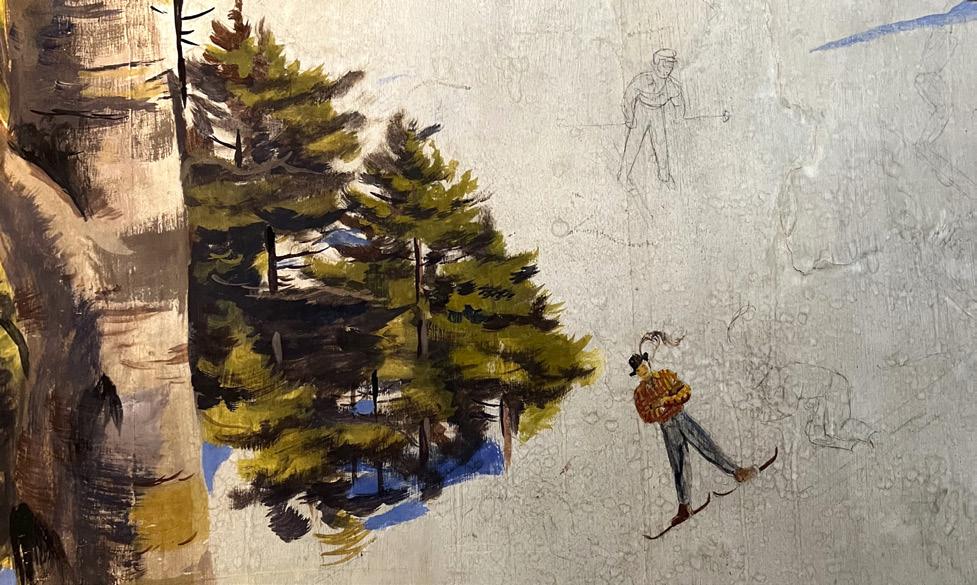
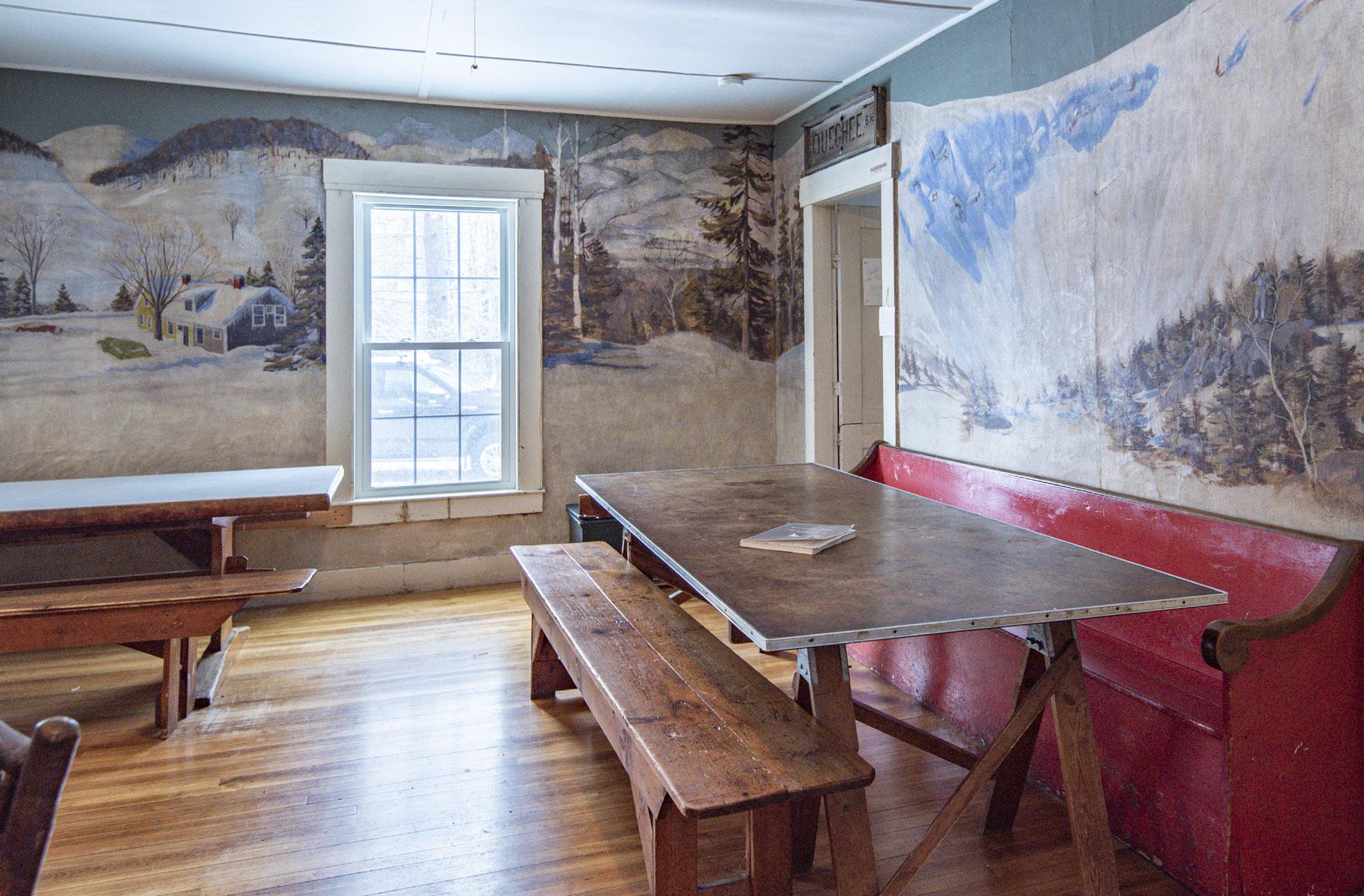
to expect. And at the time, there were few local ski instructors.
Shepler’s partner in crime was Bill McKeenan, described by Shepler as an advocational artist who could have pursued a professional career had circumstances been different. The circumstantial backdrop that impacted the country at this time was the Great Depression. Money was very tight. Shepler and McKeenan had to pinch pennies just for a week’s adventure in Pinkham Notch and surrounding areas. The payoff was worth the wait. It was McKeenan, then president of the new ski club, who convinced Shepler to paint a series of four murals in the dining area of the new club. The murals would encompass three walls in the dining area of the club and be a combination of the Tuckerman Ravine area, two scenes from Woodstock, VT, and a ski scene from the Bear Mountain Trail in Bartlett. The Bear Mountain Trail was significant, as it was the site of the club’s first downhill race. Shepler would work on the ski club murals as opportunities arose, driven by his clubmate’s desire to make the old farmhouse “more habitable.”
At the head of Tuckerman Ravine with sunlight dazzling on the summit, Shepler and McKeenan were overwhelmed by the view of the headwall of Tuckerman. Shepler wrote, “This is as fine a glacial cirque as I have seen on many a mountain … . Tuckerman’s [sic] Ravine became to me like what Mount Sainte-Victoria was to Cezanne, but the parallel stops there. Countless times I have made studies in that great bowl; and about once a decade have produced a watercolor or oil, all of them different. The return to old haunts is evinced in the 1968 watercolor, Massif, from studies of Wildcat Mountain.” Shepler regards this watercolor “as a testament to the cherished alpine land of Mounts Washington, Adams, and Jefferson … .” Most locals know these mountains collectively as the Presidential Range.
This area was also then known as the “undisputed domain
of Joe Dodge, the chief hut-master of the Appalachian Mountain Club.” Joe had a reputation for being “a character.” Described as using profanity to make his point, he led numerous rescue missions to find and save those he must have thought of as clueless climbers who overestimated their ability and underestimated the power of the mountains. Hikers can go through several climate changes as they climb higher and higher. The weather can become fickle, fierce, and dangerous the higher up you go. Your life depends on being prepared.
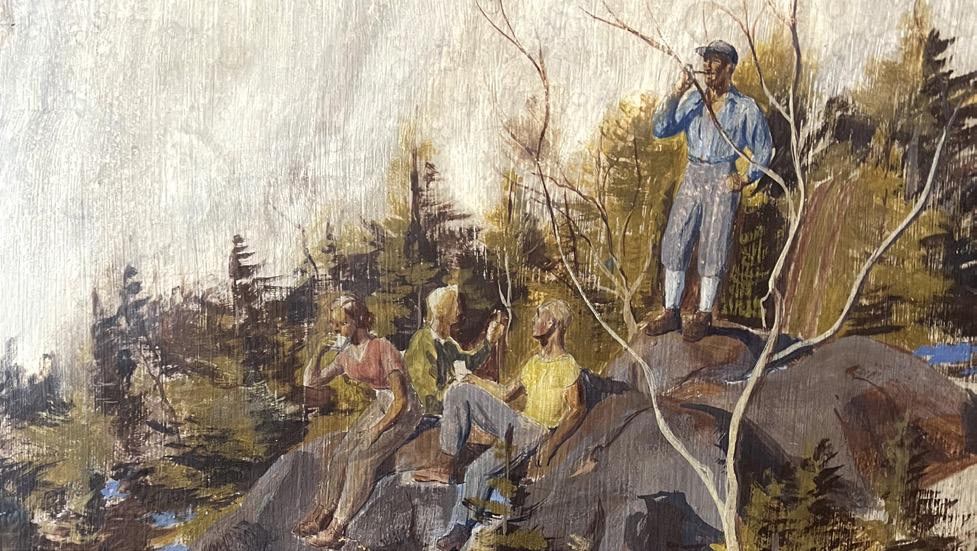
Shepler captured Joe’s ability to maintain a stone face while making ridiculous remarks and never crack a smile. Shepler’s drawing became a part of a series of articles he wrote for the Boston Sunday Herald in 1938. His drawing of Dodge can be viewed in the Joseph B. Dodge Center for Mountain Activities at the AMC Pinkham Center in Pinkham Notch.
Shepler became noted for his portraits. Rendering an expressive, recognizable portrait is something akin to magic. Painting portraits requires patience and precision, the ability to concentrate and focus with the know-how to capture the implicit nuances and expressions that characterize and identify the human face of your subject while honoring their integrity. Dwight Shepler would become a professional artist and illustrator whose artwork would eventually be commissioned by the state of New Hampshire to help promote the winter season and skiing.
One day in 1941, as Shepler continued to work on the murals in Bartlett, his life would change forever. On that day, December 7, Shepler listened on the radio to early stories of the attack on Pearl Harbor. It is said that he dropped his brushes and immediately packed his bags to enlist in the Navy, leaving the ski murals 95 percent complete. (To this day some unfinished work can still be seen.)
Shepler applied for a commission in the Navy. He was commis-
ABOVE: Commissioned in the Navy in May of 1942, Shepler submitted his portfolio to the Navy’s officer-artist program and became the first combat artist sent into a war zone during modern times. This particular watercolor shows the USS South Dakota in action with Japanese planes during the Battle of Santa Cruz, which took place October 11-26, 1942. Credit The U.S. National Archives.

ABOVE LEFT: Shepler captured this illustration of Joe Dodge, retired chief hutmaster of the AMC. Said Shepler, “The drawing of Joe, with the straight face he can keep while making outlandish remarks, was done in his house in the Notch in 1938, as part of my series of articles in the Boston Sunday Herald.” It now hangs in the Joseph B. Dodge Center for mountain activities in his legendary Porky Gulch of Pinkham Notch, the portrait a gift of the Schussverein Ski Club, of which both were members. ABOVE RIGHT: This color print was a poster commissioned by the State of New Hampshire Planning and Development Commission (SNHPDC). From 1935 through 1961, the SNHPDC was the chief sponsor and creator of advertising prints and posters as well as numerous informational books, maps, and reports about the natural and cultural resources in New Hampshire.
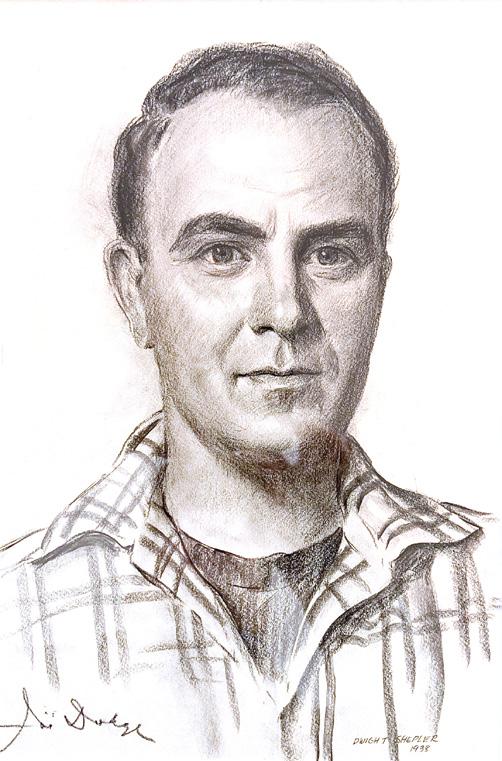

RIGHT: A vintage Ford Times Monthly magazine, issued by Ford Motor Co. in December of 1958, featured a Shepler article and cover of Hillman’s Highway in Tuckerman Ravine.
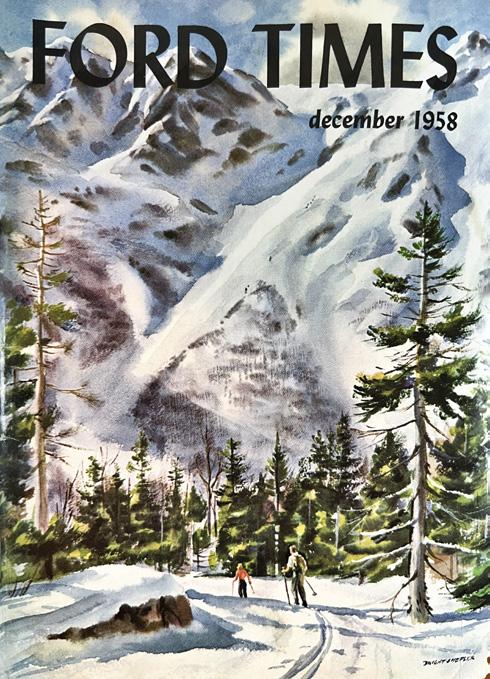
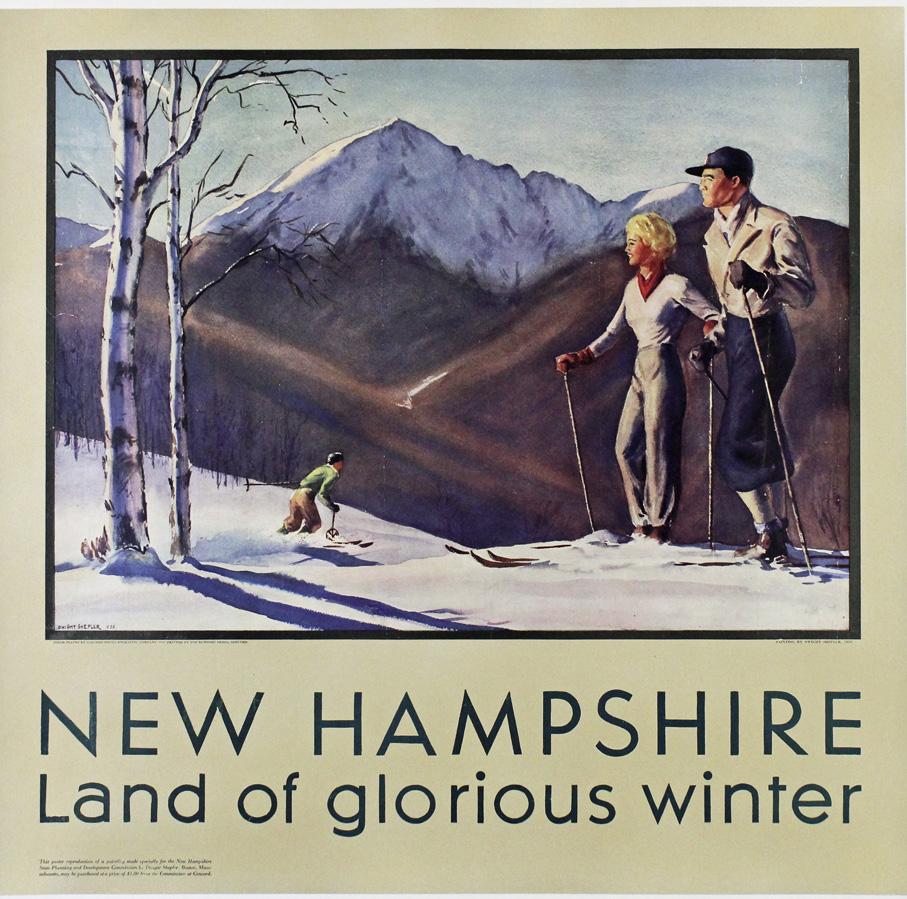
ABOVE: During the summer of 2021, Vibe was working on an article on the Chase Hill Farm in Albany, NH–and their production of hard, dry cider from numerous heritage cider apple trees on the property (MWV Vibe, Volume 5: issue 17). It was there we discovered this original watercolor by Dwight Shepler; and thus began the somewhat obsessive search for additional information about the relatively little known artist. Titled Ski Runner-Carter Notch, the vantage point Shepler chose to paint from overlooked the Carter Notch region, Thorne Mountain on the left, the Conways in the distance, and the southern stretch of the Moat Mountain Range in the distance. Farm owners, Beth (Chase) Thomas and Malcolm Thomas feel certain that the clearings just to the left of South Moat, may quite likely be their 230-acre farm, as it may have appeared in 1930s with its clearings and open pastures.
sioned Lieutenant Junior Grade in the Naval Reserve. He submitted his portfolio to the Navy’s officer-artist program and became the first combat artist sent into a war zone during modern times.
Shepler saw his first action during the Battle of Santa Cruz. He would man his battle station, and afterward, make sketches and notes. They would give birth to powerful renditions of the war. He would complete as many paintings as possible in the field before clearing them with local censors and then sending them to Washington. Shepler completed roughly 250 to 300 drawings and paintings. He also painted two large murals at the U.S. Naval Academy. Given the danger of what he witnessed and served in, Shepler wrote his superiors that he was amazed he was still alive. For his service, Shepler was awarded the Bronze Star. In May 1947, Shepler left active duty. The Navy Art Collection contains 225 original works by Shepler. About 150 of these are watercolors. The rest are works in oil, charcoal, pastel, or pencil.
After the war, Shepler would return to New Hampshire where he was a member of the Concord Art Association. He also completed numerous portraits, did habitat backgrounds for the Boston Museum of Science, and mural decorations for the U.S. Naval Academy and Williams College. It is not clear why the murals at the ski club were never completely finished.
Shelper died in 1974 and maintained his connection to the
Navy and his artwork in the Naval collection. He led a full, but not well-known, life. There are very few books written about him that are still in print. We were lucky to find An Artist’s Horizons, by Dwight Shepler, which contains 91 illustrations of his drawings and paintings. During the last years of his life, from 1969 to 1973, he served as president of the Guild of Boston Artists. He had one-man shows in New York, Boston, and Chicago galleries, and his work has been shown at the National Gallery, London, and the Musée de la Marine, Paris.
It’s not an exaggeration to say art was his life. We are honored that his passion for the outdoors, especially the mountains, and his love for art are powerfully reflected in his paintings of the White Mountains and Eastern Slope regions.
From the publisher: Countless hours of research and discussions were needed to assemble this article. Thank you to Bob Cottrell and David Smolen, Conway Public Library; Jonathan M. Olly, PhD New Hampshire Historical Society; the New England Ski Museum; Harry Dodson, from an anonymous Bartlett Ski Club; writer Janis A. Pryor; and many others. If you have additional information to contribute to this article or wish to provide a correction please email publisher, Dan Houde.
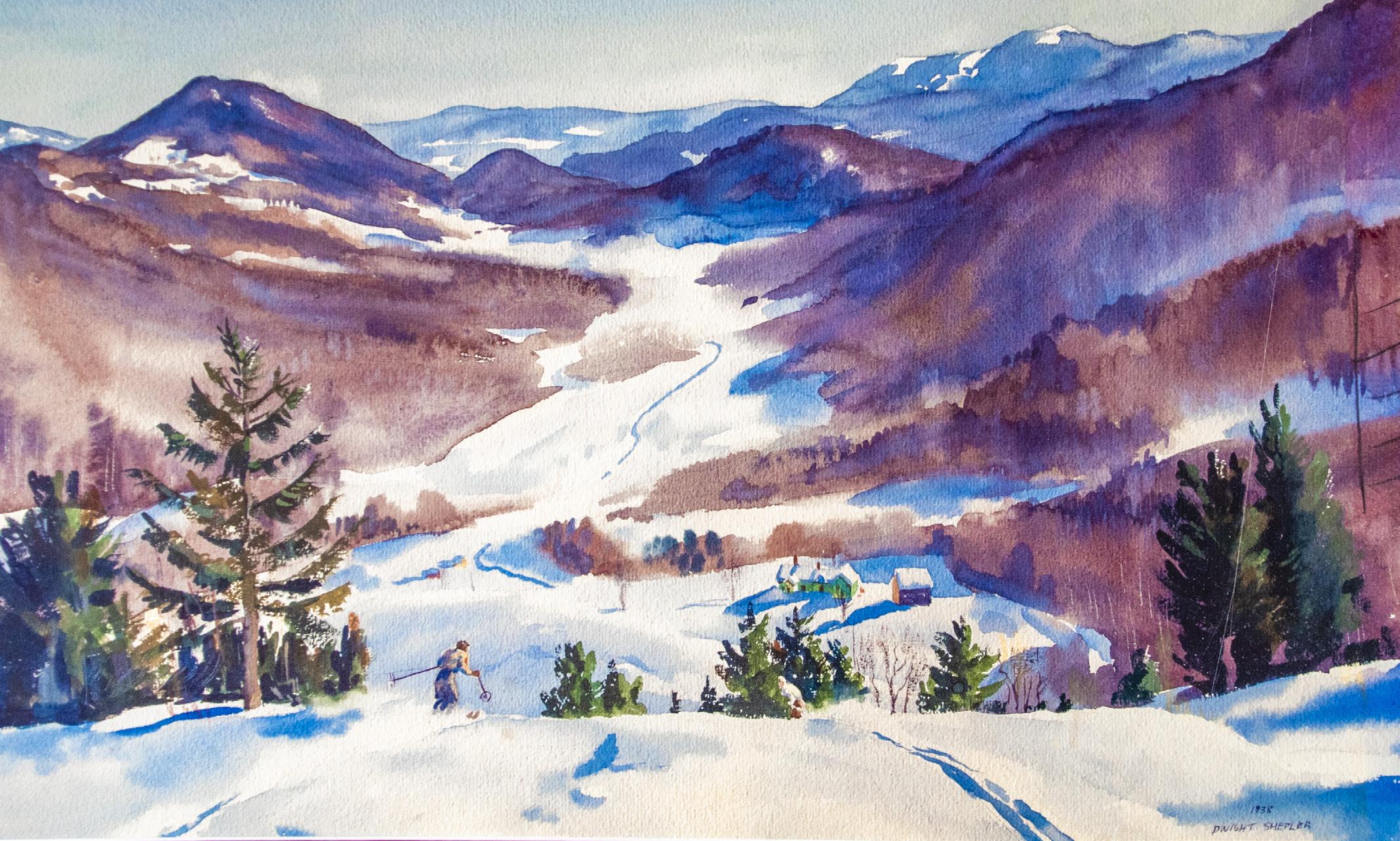

Almost every conversation or interaction I have here in the Valley revolves, at some point, around an outdoor activity combined with a strong emotion. This may be a byproduct of my own joy and love of outdoor recreation or my profession as a physical therapist. It seems to be in our nature to be effusive when describing a hike, a new-found trail to run, fresh snow to be skied, or figuring out a new climbing route.
The access to so many outdoor activities is one of the defining characteristics of this area. Having these activities so accessible is fantastic—unless we are not, quite literally, physically able to do them at all. Or if they cause more pain than enjoyment at the end of the day. As a physical therapist, I spend a considerable amount of time explaining to all ages of outdoor enthusiasts that they need to make time to focus on areas of strength or mobility, which is key to playing without pain. This conversation comes up every day.
In the last decade, there has been a necessary shift in the rehab and sports world. There is a new emphasis on preventing injury through strengthening and movement-based exercises.
• An active core will stabilize the pelvis and allow for decreased strain in the low back or hip muscles—important for all movers.
• The foot and lower leg need to be strong and fit to withstand the stress of running, hiking, or Nordic skiing. This prevents Achilles, peroneal or posterior tibias tendinitis, plantar fasciitis, and more.
• Upper back muscles need to be active during arm movements to stabilize the shoulder. This prevents rotator cuff injuries, shoulder impingement, neck pain, and more.
All the muscle groups I mention above are stabilizing muscles that are not necessarily engaged when doing the fun things, such as walking, hiking, running, biking, etc. The bigger muscle groups that move us need to be strong as well, but the more specific stabilizing ones need their own work too.
So what do you do about it? This can look different from person to person. Each person’s body has a different story—the build, history of sport/activity, history of injury, and what we do for work. All of these factors affect our bodies, so we will all present and respond differently.
Trending concepts are, “pre-hab,” “injury prevention programs,” or as some like to say, “the boring stuff.” From what I have seen clinically and personally over the last eight years here in the Valley, I agree with and promote these concepts.
One of the biggest challenges is to convince lifetime outdoor enthusiasts that they need to find time in their schedules to dedicate to doing the “boring stuff.” A common reason for not committing to this type of work is because, as a population, we don’t know enough about how our bodies work on a muscular or joint level to see the benefit. Sure, people may get it when this type of work helps alleviate pain or it gets them back on the trail, but that is a reactive solution and not a proactive one.
I recommend finding something that you enjoy doing that involves moving in a different way than your typical sports. This could be yoga, Pilates, martial arts, a strength routine, etc. to stimulate some of the other, smaller muscles. It could be seeking out a movement specialist or physical therapist. As a physical therapist, I am a firm believer that doing the work before you have an injury or pain is vital, and know that—for many—seeing the value is hard until you are on the sidelines.
At all ages, this is something to be aware of to help prolong your joy and fierce passion of sports and outdoor pursuits. The sooner you are protecting your joints with strength and stability, the better off you are. Start young or old—you won’t regret it.
Hilary McCloy, PT, DPT, Owner
Hilary McCloy, LLC Physical Therapy and Performance Coaching www.hilarymccloy.com • (802) 238-3976 87 Route 16, Jackson, NH 03846

As a physical therapist, I am a firm believer that doing the work before you have an injury or pain is vital, and know that—for many—seeing the value is hard until you are on the sidelines.
Situated on beautiful Crystal Lake our camp is located in an area of outstanding natural beauty where girls come to switch off their cell phones & screens. We offer a wide range of activities from arts & crafts, lake swimming, boating, ropes, drama & more.
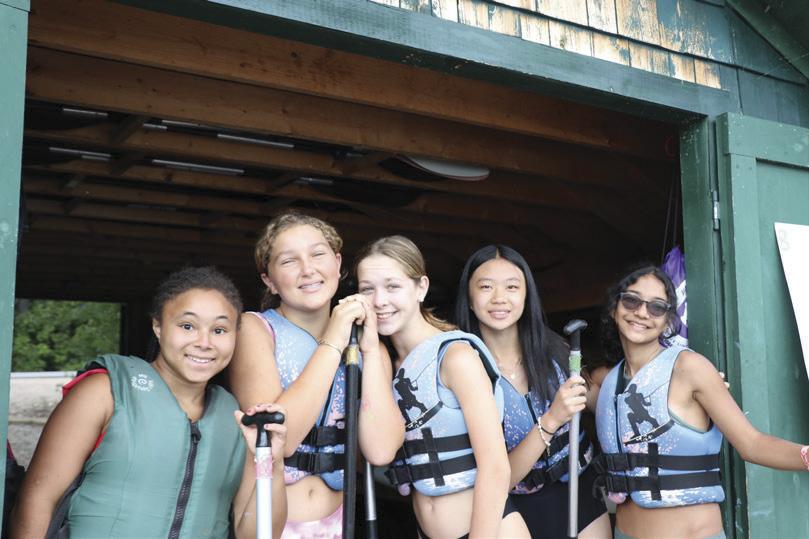

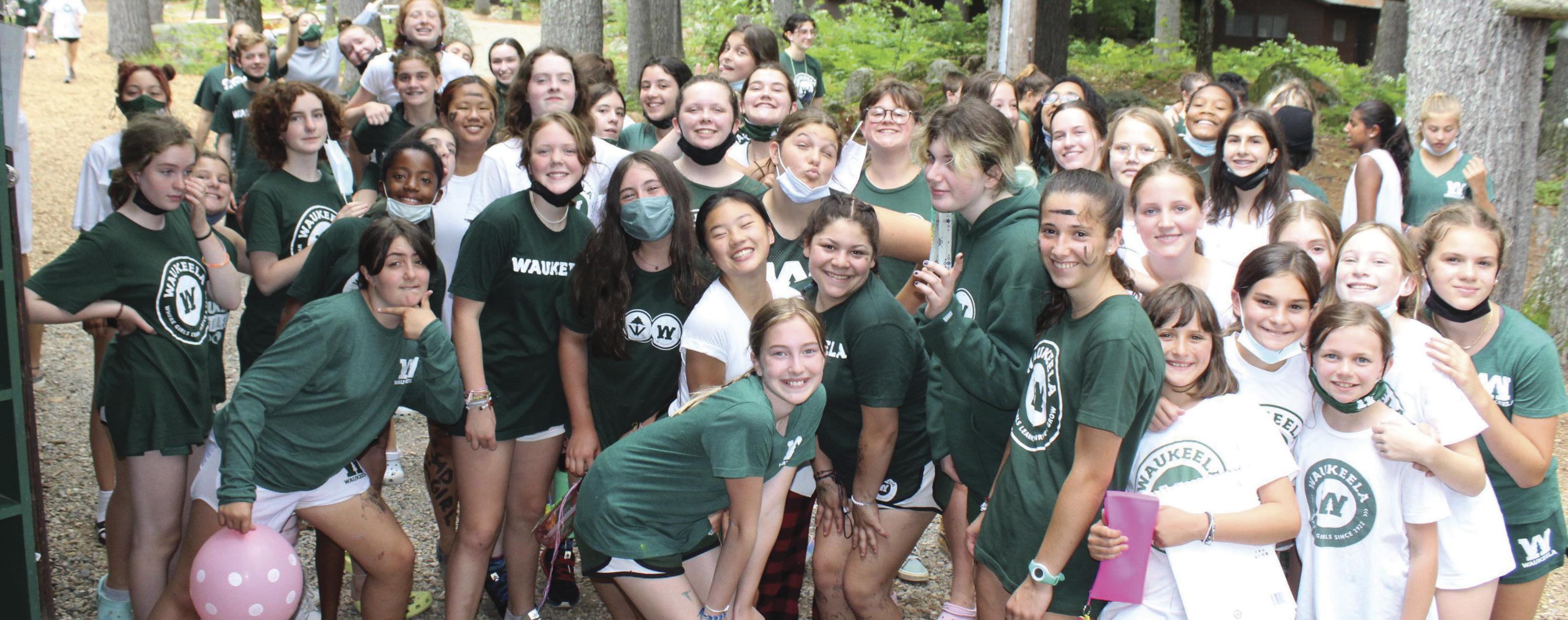
Gill & Graham our camp Directors are parents of 4 children & know every camper personally. We put the mental health & wellbeing of all our campers at the very heart of what we do. Campers are safe and happy at Waukeela.
Waukeela is steeped in tradition with a rich culture and heritage for helping young girls become strong, independent women.
Generations of Waukeela girls now create a world-wide community of alumnae.
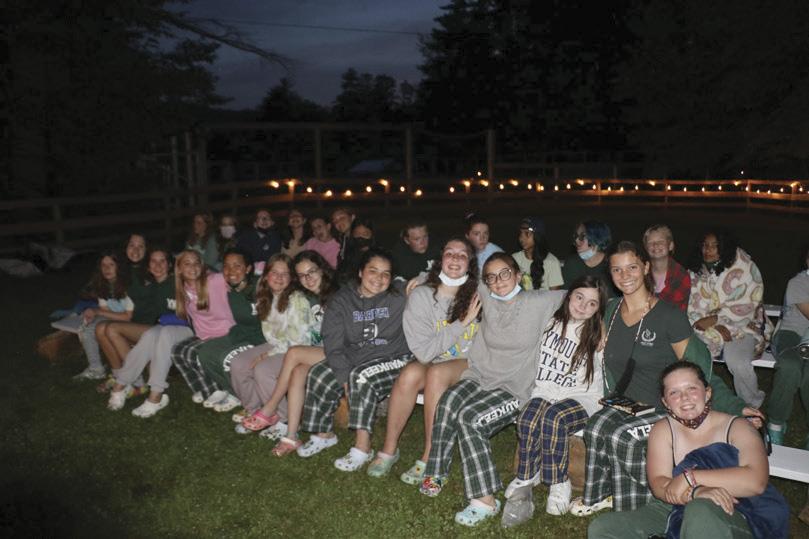
Although we typically relate hypothermia to harsh winter conditions, the outdoor temperature does not have to be below freezing for your core body temperature to drop below 95 degrees. Runners, skiers, and winter recreationalists in general are all susceptible, especially those unaware of the risks.

When you think of hypothermia, what comes to mind? Do you think of someone who’s had an unfortunate incident falling through thin ice? Or maybe some inexperienced and ill-equipped hiker who got lost or injured while climbing Mount Washington? Perhaps you might even imagine hard-core winter sports like ice climbing or backcountry skiing.
How about cross-country skiing or even long-distance running? Did you know that runners during several Boston marathons, including those in 2013 and 2018, were treated for hypothermia? Yes, believe it or not, hypothermia is a legitimate concern for long-distance runners and Nordic skiers alike. It is particularly prevalent when there is a mixture of wet conditions, wind, and outdoor temperatures below 50 degrees. Sound familiar? Welcome to the Mt. Washington Valley.
During these conditions—although you are raising your core temperature and producing heat—the combination of cold and wet conditions will eventually
cool your body down too quickly, increasing your risk of hypothermia.
Although we typically think of harsh winter conditions, the outdoor temperature does not have to be below freezing for your core body temperature to drop below 95 degrees. Changing weather conditions in the mountains can catch outdoor enthusiasts off guard in any season. Exhaustion and dehydration can also contribute to the risk of hypothermia, so long-distance runners, hikers, or cross-country skiers are particularly vulnerable.
While subzero temperatures or freezing rain are obvious concerns, more subtle environmental changes, such as a sunset, a rainstorm, increased cloud cover or change in wind speed, can be enough to shift your body’s thermal balance, even on a pleasant day. It should also be noted that the whole process from mild exposure to severe hypothermia may take only a few hours … or less.
Don’t get me wrong—I’m not suggesting you should hang up your gear
and stay indoors for half the year. By all means, get outside as much as you can and embrace the fun activities this beautiful valley has to offer! Outdoor recreation is a fabulous way to enjoy nature and stay fit. In this article, I’ll
cold environments, people cannot as easily perceive decreases in their core body temperature as when they were not exercising. This research has implications for recreational activities in colder climates, such as hiking and
share some tips on how to do it safely.
One of the most important things to do to reduce your risk of hypothermia is to stay warm and dry. It may seem strange to think of people exercising outdoors suffering from hypothermia since they are actively moving. Shouldn’t this keep them warm? Unfortunately, if the extra heat produces sweat, it makes hypothermia more of a risk. If you’ve ever been running, biking, hiking, or even walking at a brisk pace on a cold day, you know the scenario. You leave the warmth of your house or your vehicle all bundled up for the elements because you know how cold it is outside. Once you get moving for any length of time, your core body temperature begins to rise and you produce heat, so you feel warmer. Your outside skin temperature, however, is still cold. The heat you’ve built up in your core rises to the surface, hits your skin, and begins to dissipate in the form of sweat.
Once you stop moving, you need to retain heat, but your body’s core temperature is still elevated. Your body is attempting to restore balance and continues to lose heat. If you were in a warm environment, your temperature would just go back to normal, but in a cold environment, if you lose too much heat, your body temperature then drops and you end up hypothermic.
Once warmed up, you typically feel warmer than the weather may otherwise indicate, and while exercising, your ability to perceive the cold may be impaired. An exercise physiology research study published in August 2021 in Physiology & Behavior, found that during low-intensity exercise in
skiing, suggesting that the possibility of accidental hypothermia should be taken into consideration.
Winter athletes may be at particular risk for hypothermia for several reasons: runners, bikers, or climbers typically dress for their sport, not for standing around in cold weather. It’s also not practical to be carrying around bulky winter clothing when engaged in these types of sports.
At the end of a long-distance exercise session—whether it be running, skiing, or hiking—athletes will be depleted. Exercise depletes blood sugar and hydration levels, and this can exacerbate symptoms of hypothermia.
Most serious long-distance athletes are relatively lightweight with little body fat. Super lean athletes typically have more difficulty maintaining core temperature due to a lack of insulation provided by fat and muscle mass.
Certain medical conditions, such as diabetes and thyroid disorders, adversely affect the body’s ability to regulate its own temperature and may also increase someone’s risk for hypothermia. In addition, children and the elderly are at greater risk because they are less able to retain body heat in cold conditions.
LMT- NH Lic. # 3358
AMTA, Nationally

www.juliesargentmassage.com Healing Dimensions Massage Therapy “Bridging the Mind and Body through Touch” Optimize Your Health & Performance Today! (603) 447-3112 DiscoverHealthFMC.com
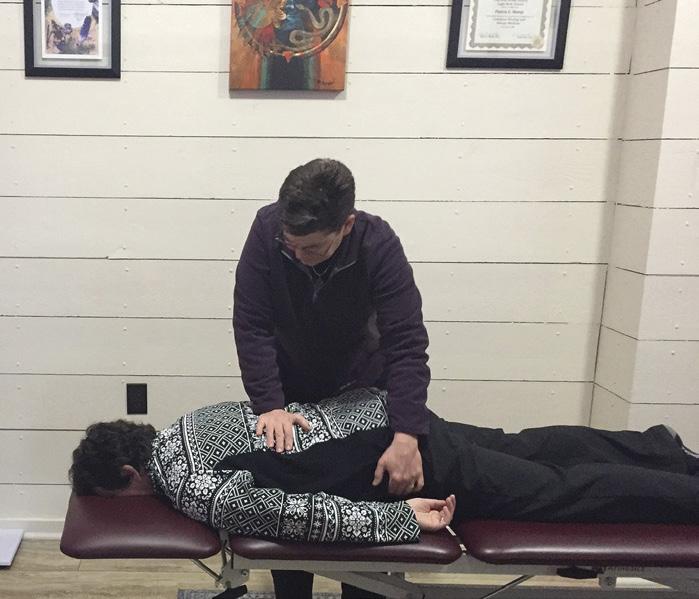

Julie We are all about root cause resolution ... digging deep into what causes pain and disease. TAKE CONTROL OF YOUR HEALTH AND TRANSFORM YOUR LIFE.

extra
At the first sign of hypothermia, the priority is to get warm, dry, and get your temperature back up! Wet clothing should be removed as quickly as possible. Blankets, extra dry clothing, drinking warm liquids and/or direct exposure to a heat source can be used to raise core body temperature. If symptoms worsen, seek emergency medical attention.
• Dress in thin, waterproof layersmoisture-wicking fabric
• Bring a hat and gloves
• Carry a daypack with extra supplies
• Instant hand and foot warmers
• Extra gloves and extra socks
• Warm the air you breathe with a neck gaiter or scarf
• Bring snacks and stay well hydrated with warm fluids

• Avoid alcohol and minimize caffeine
• Eat complex carbs
• Exercise with a buddy
• Tell someone where you’ll be and when you’ll be back
nize and respond to these early symptoms to avoid more severe hypothermia. As core temperature continues to fall, symptoms could include confusion, irrational thinking or behavior, sleepiness, slurred speech, cramping, slow breathing, and a slow or irregular pulse. Severe hypothermia causes cardiac arrhythmia and may even result in cardiac arrest.
Mother Nature plays by her own rules in the mountains. You’re best to expect the unexpected! Whatever your favorite outdoor activities, it is important to stay warm and dry. Checking the weather forecast is helpful; but keep in mind, we
heat loss. Keep in mind, you may not feel as thirsty in cold weather, so make a conscious effort to drink enough water. A hydration pack worn close to the body provides easy access and keeps water warmer than when stored in an external bottle in your backpack. Not to be a total buzz kill, but minimizing caffeine is also helpful, since it is a diuretic.
Eat complex carbohydrates to maintain steady energy levels. This is best done in preparation for exercise a couple of hours ahead of time and replenished during and after exercise. Some examples of complex carbohydrates to fuel up before include hearty soups, chili, baked potato, overnight oats with nut butter, and
live in New England, and as the old saying goes, “If you don’t like the weather, wait a minute, it’ll change.”
One of the best pieces of advice to prevent hypothermia may seem obvious. Dress in layers. Since hypothermia is more common during cold and wet conditions, the best layers are thin and waterproof. It’s also important to be more conscious of sweating in the cold, and select fabrics designed to wick moisture away from your body.
A hat and gloves are essential during cold-weather recreation. If it seems too warm when you first set out, or if you start getting too hot along the way, a small daypack can be helpful to store these items and extra layers of clothing, including an extra set of gloves and dry socks in case your feet get wet. Extra sets of instant-heat toe and hand warmers can also be useful pieces of equipment to have in your pack as a backup heat source.
When exercising in the cold, warm the air you breathe with a neck gaiter or scarf. This is especially helpful if you have any kind of asthma or other respiratory concerns.
Stay hydrated, but avoid cold fluids and alcohol. Both of these will lower your body temperature. Despite the warming sensation you may get from booze, it dilates blood vessels, promoting faster
berries or lean meats. Snacks to throw in your daypack might include energy bars or gels, trail mix, sandwiches, or fruit.
Lastly, warm up your muscles before exercise—and for safety’s sake, buddy up with a friend or at least tell someone where you will be going and when to expect you back if you are heading out on your own. With just a little bit of planning and effort, you’ll be sure to have a safe, warm, and happy winter ahead. Enjoy it, and I’ll see you on the trails!
Dr. Trish Murray is a highly accomplished physician who has been certified in internal medicine, osteopathic manipulative medicine, energy medicine, and functional medicine. She is the founder of Discover Health Functional Medicine Center in Conway, New Hampshire, and a partner in the Discover Health Movement Membership. Dr. Trish takes an individualized, holistic approach to health to help you take control of your health and transform your life. For more information, visit www.discoverhealthfmc.com. Discover Health Functional Medicine Center • (603) 447-3112

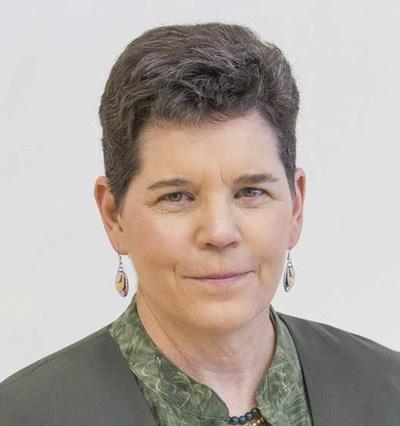
When exercising in the cold, warm the air you breathe with a neck gaiter or scarf. This is especially helpful if you have any kind of asthma or other respiratory concerns.
Hypothermia is the simple process of the body’s core losing heat faster than it can be produced. As warm-blooded humans, our body runs at about 98 degrees, plus or minus just a couple of degrees. We rely on food, water, and our metabolism to produce the energy to allow us to move, think, and always produce heat. In warmer climates, we wear less clothing to allow heat to escape, and in colder weather, we wear more clothing … it seems so simple. Field treatment of hypothermia is vital—intervention as soon as possible, the willingness to stop and treat, and then head to shelter, home, or a medical facility (depending on the severity). Unfortunately, the history of exploring the outdoors in any number of pursuits has too often found fit, smart, motivated outdoors folks who find themselves unaware that they are slowly being injured. The cold is affecting their awareness, reasoning, speech, strength, coordination, and most tragically, the failure of the survival instinct. Usually when a person is “injured,” they know it. Bumps, bruises, cuts, sprains, and fractures, are abrupt and painful, and a person is usually very aware and will respond to the injury. This protective response in our brain is called a medically sympathetic response, but more commonly known as the “fight or flight response.”
This adrenal surge can be triggered prior to injury when the person is about to try something difficult, daring, or threatening. The fight or flight response keeps us aware, focused, and usually compels a person to help themselves or call for help.
Hypothermia, unlike other injuries, quiets the fight or flight response, sometimes with tragic results, as the Mountain Rescue Service of NH found out in the winter of 1994.
Two ice climbers became lost in brutal weather in late February on Mount
Washington. Monroe Cooper, 40, and Erik Lattey, 28, had been to Washington before, but on this climb, they had gotten partway up the trail on Huntington Ravine when they realized they’d forgotten rope. They ran down, got it, and began to push hard to get up into the ravine to complete the climb.
That’s when things went very wrong and MRS was dispatched the following day to start searching. “Unfortunately, with the arctic cold and winds at 125 miles per hour, we couldn’t get to them that day, so we began again early the next morning. When we got to the top of Huntington Ravine, my teammates and I saw something we hadn’t seen in 20 years of mountain rescue. One subject sitting up with his back against the rock looking into a pack. He was frozen solid, still in his climbing harness with the rope still tied in. We couldn’t see anyone else, but we picked up the rope and started pulling in out of the snow till we came to a snow covered lump that we realized was the second climber who likely crawled a short way to find more shelter, he was frozen as well. We loaded the two men into litters and took them down the mountain.”
These two men pushed themselves, probably not eating or drinking much, and climbed the route despite the weather. Though no one knew exactly what happened, it was agreed they had gotten to the top and into the teeth of the wind and cold. They sat down in what little shelter from the weather they could find to “rest” for a little while. This is the insidious nature of hypothermia. These two men were healthy, likely experienced, and committed, with no other injury, and kept climbing. Once they got to the top, their brains were so cold, there was no recognition of the threat.
Treating hypothermia means acting early, before the problem becomes more difficult to fix. The signs and symptoms of cold follow a progression—and you don’t want to let anyone in your party (or yourself) get too cold. When you think your friend is becoming hypothermic, remember not to judge, diagnose, or preach to them about it.
Despite the fact they are showing some signs/symptoms, their brain can still hear what sounds like criticism.
• Quiet, but responsive
• Responds, but won’t carry a conversation
• Less eye contact
• They don’t drink or eat often enough
• Minimal layers
• Shivers, can start as light and intermittent, but progress to steady, maybe severe
• Slowing down
• Speech is slow, even slurred
• After these assessments, this cold person will just continue to get colder without help or intervention.
As you notice the possible signs of hypothermia start this process:
Suggest they eat some of your yummy snacks (sugar-based), then offer some water. If they refuse, beg them to try your awesome snacks with, “Please, please, please eat my chocolate.” It may be annoying to them, but they may take some food and drink just to shut you up. Then suggest you help them put on another layer or two and a hat, gently help them put the extra layers on even if they resist. If you’re in an exposed place, try to find shelter or more layers.
It may take a while to warm them up enough to continue, which means going home. If they are too exhausted and you are without any more resources, then keep them as warm as possible where they are and call for the SAR team to help bring them home.
Bill Kane is the owner and director of The Kane Schools, Wild & Rescue Medicine.
Kane has spent over 46 years with Fryeburg Rescue and in Wilderness SAR in NH and ME. He is licensed in NH and ME to teach wilderness and urban medicine, is a member of the NHOC, and of the NH Region 5 EMS Regional Council.
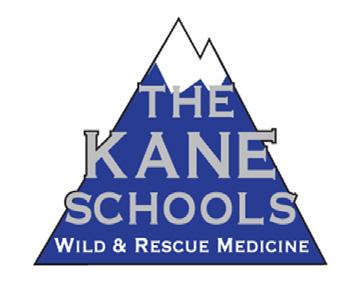
Do you recall when there always seemed to be a week of below-zero weather each January? How about winter blizzards with 24 inches or more of snow? I’m sure that we occasionally received a little freezing rain too, but ice storms and just plain warm rain like we’ve seen in recent years? That’s a significant change.
Joe Dodge, former AMC Hut System manager and founder of the Mount Washington Observatory, moved from Pinkham Notch to his new home on West Side Road, North Conway in 1958. He established a National Weather Service (NWS) COOP Observer station at his house shortly thereafter and started weather observations in January 1959. He continued daily weather observations until passing in September 1973. Briggs
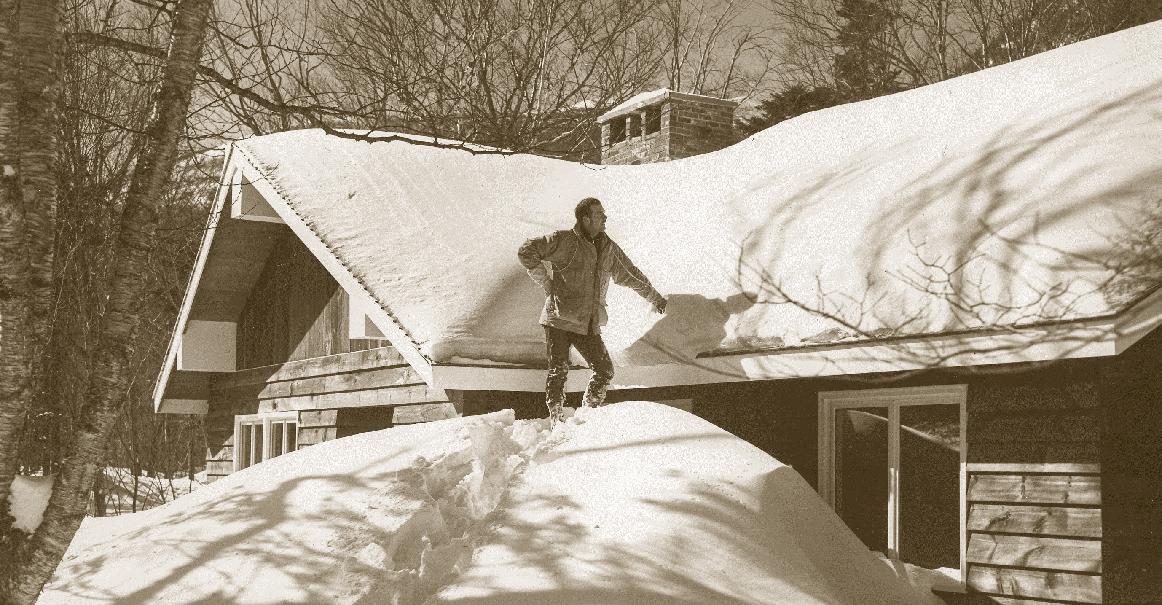 By Ed Bergeron & Brian Fitzgerald
By Ed Bergeron & Brian Fitzgerald
Bunker picked up where Joe left off a few months later in January 1974 (the NWS station was officially designated NCON3) and continued observations at his home on Pine Street in North Conway until September 2006. Following Brigg’s tenure as the local NWS observer, I began taking observations at my home fairly clse to Dodge’s original NWS Coop Observer weather station, and continued until the station was moved to the Mount Washington Observatory site on Pine Street North Conway, not far from the Bunker home, in October 2015. Mount Washington Observatory staff and volunteers continue daily observations at NCON3 today.
In my records, I have an NWS climatological summary of means and extremes from 1959 to 1971. Mean snowfall was
113.4 inches. The maximum month was February 1969 with 67.5 inches. The greatest snowfall day also occurred in February 1969 with 21 inches being officially recorded by Dodge on West Side Road in North Conway. I remember skiing at Wildcat that year, and skiers had to ski down into an excavated hole to load the upper mountain chair lift. Memory recalls skiing lasted well into May that year.
The daily mean monthly temperature for the period was 43.3 degrees. The daily mean December temperature was 22.0, January was 17.0 degrees, February was 18.9 degrees
are somewhat likely to experience above normal temperatures, while the forecast for precipitation has equal chances of aboveor below-normal levels.
Year-to-year variability of snowfall and wintertime temperatures are a given in our climate; however, as we continue to observe and understand long-term trends in our region, the nature of our seasons is changing. Winter is no exception, and a collaborative project between the Mount Washington Observatory, Hubbard Brook Research Foundation, and the Appalachian Mountain Club has focused in on how the White Mountains are
and March was 30.0. Now, compare this with our latest climate averages from the period of 1991-2020 and you’ll note warmer winter temperatures, with December featuring a daily mean temperature of 26.6 degrees, January 19.9 degrees, and February 22.3. Additionally, you’ll note that mean snowfall has fallen from 113.4 inches to 84.0 inches—2 feet less snow in most winters. Keep in mind, this is only an average, with seasonal snowfall totals ranging anywhere from a piddly 41.0 inches in 2015-2016 to a robust 147.0 inches in 2007-2008.
Naturally, you may be curious about where winter 2022/23 will stack up following two less-snowy-than-normal winters (44.8 inches in 2020/21 and 62.0 inches in 2021/22). The National Oceanic and Atmospheric Administration (NOAA) released its outlook for the upcoming winter season and summarized the forecast succinctly as “Warmer, drier South with ongoing La Nina.” With a third consecutive winter of La Nina influencing weather patterns across North America, it’s reasonable to suspect a similar result like the past two winters. According to NOAA and the National Weather Service’s Climate Prediction Center, New Hampshire’s southern and central tiers
responding to our changing climate. Long-term measurement has been ongoing at sites across the White Mountains, thanks to these entities at the summit of Mount Washington, Hubbard Brook Experimental Forest (just north of Plymouth, NH), and at Pinkham Notch (overlapping since at least 1959 for all three sites). These locations provide us with a sense of changes at different elevations, and tell us the following: Air is warming. Spring is arriving earlier. We are losing the cold and snow.
As is evident in North Conway, the air is also warming across the White Mountains, regardless of elevation. In winter, this means we are losing the overall number of cold days, with both Pinkham and Mount Washington losing more than 14 “frost days” since 1935. Losing cold temperatures, in turn, has helped to diminish our typical snowpacks across the region. Many of us can recall a “January thaw” as well during the past, with rain-on-snow events seeming to occur with some frequency in the region in recent winters. Confirming this observation, a study on Mount Washington has noted an overall increase in the frequency and intensity of winter thaw events even on New England’s highest peak (Kelsey & Cinquino 2021).
As is evident in North Conway, the air is also warming across the White Mountains, regardless of elevation. In winter, this means we are losing the overall number of cold days, with both Pinkham and Mount Washington losing more than 14 “frost days” since 1935. Losing cold temperatures, in turn, has helped to diminish our typical snowpacks across the region.


With all that said, you may be ready to put your skis and snowshoes back in the shed—but fear not! Snow will fall this winter, and should you be ready for it, you can take advantage of whatever Mother Nature throws at us this season. If you’ve been skiing at resorts such as Cranmore, Bretton Woods, or elsewhere, you’ll note significant investments and advancements have been made in snow making and snow quality. Resorts have adapted and will continue to adapt to variable conditions, seeking to retain snow and create the highest quality conditions. Other adaptations may still be needed, and certainly mitigating the overall impacts of climate change should be a focus to help us retain the character of our New England winters.
If you’re looking for a way to contribute to the knowledge of our region’s weather and climate, there are two excellent citizen science programs that most anyone can participate in as well. For true snow lovers who like to venture into the hills, the Community Snow Observations (CSO) campaign encourages backcountry travelers to measure snow on the ground using a free, easy, downloadable app. The CSO program aims to help fill in the massive measurement gaps particularly found in the complex, thinly settled mountains. Understanding snowpack characteristics ultimately builds our knowledge of downstream impacts, such as flooding threats, and forest and aquifer health. Visit www.communitysnowobs.org to learn more about this great program, and add your measurement to the map!
Finally, for the weather lovers out there, be sure to check out the Community Collaborative Rain, Hail & Snow Network (CoCoRaHS) to start measuring precipitation right in your own backyard. CoCoRAHS is a low-cost, easy-to-join network of volunteers measuring precipitation for natural resources, education, and research applications. Join the network and become a volunteer at www.cocorahs.org. Oh … and think snow!
Remember when we used to waddle to school or play in waist-deep snow going uphill both ways?
Brian Fitzgerald is the director of science & education for Mount Washington Observatory, a private, nonprofit, member-supported institution with a mission to advance understanding of the natural systems that create the Earth’s weather and climate. For more information, visit www.mountwashington.org.
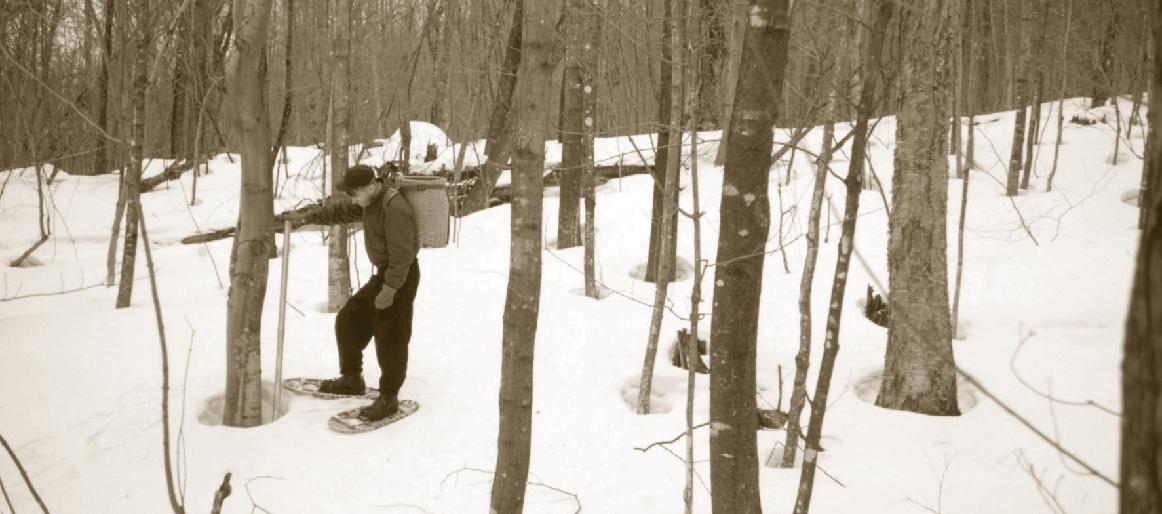









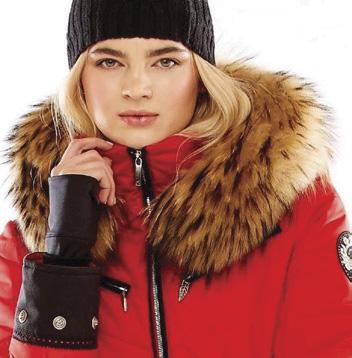
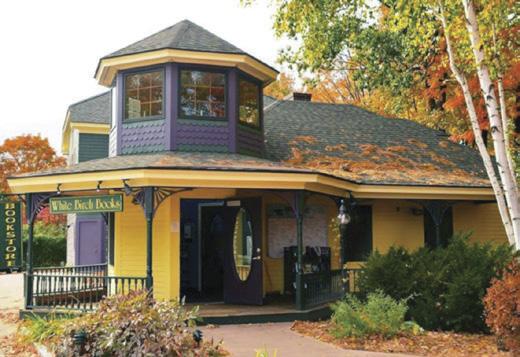

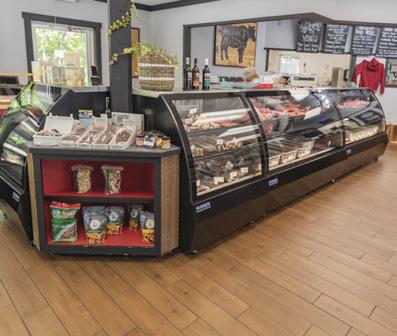



In May, climate scientists and a cadre of highly specialized Sherpas ventured to Mount Everest to install new automated weather stations at the planet’s outer edge. Their packs held tripods and a load of tech. In the mix were two lightweight wind sensors custom-designed by Mount Washington Observatory.
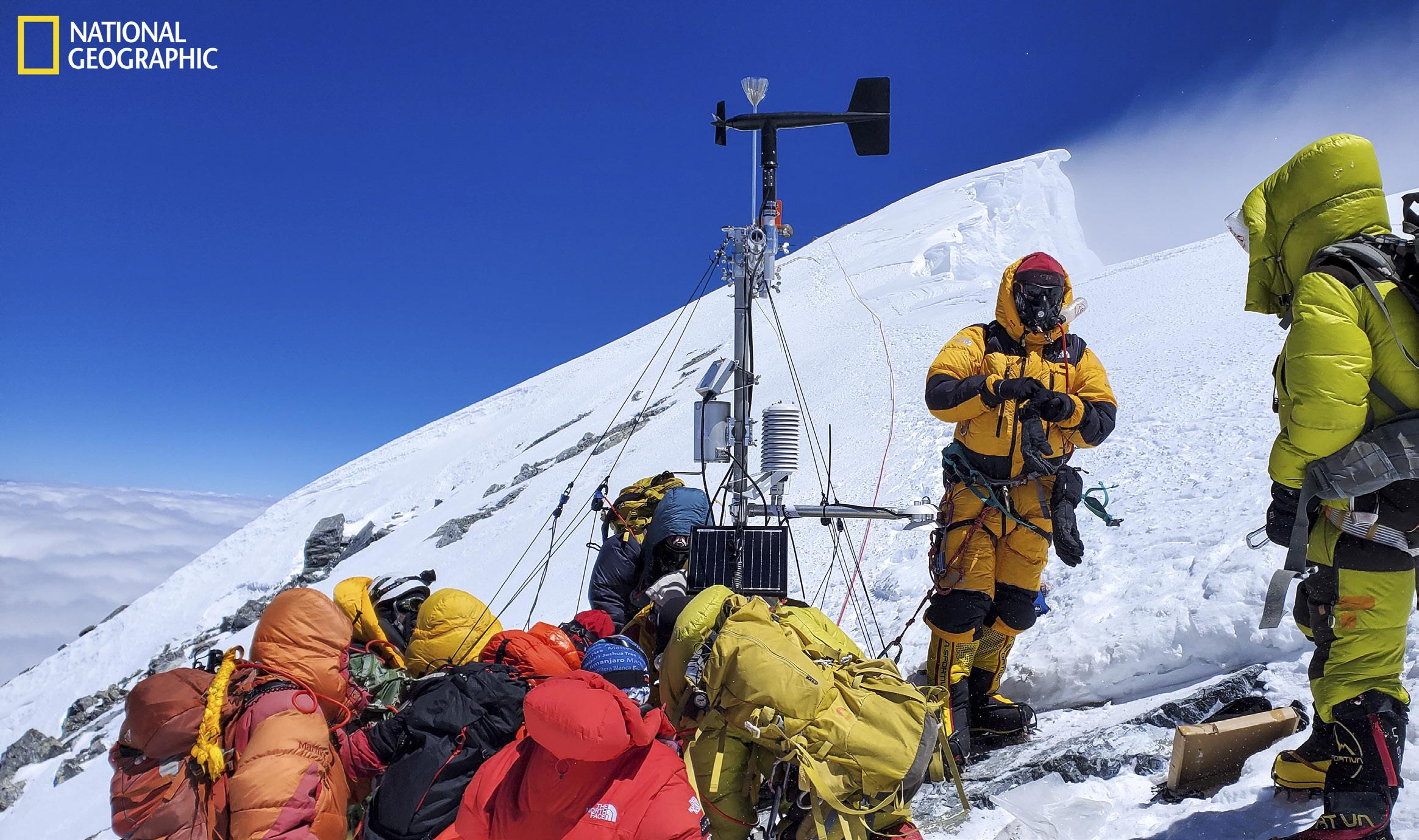
Expedition leaders Baker Perry and Tom Matthews share a fascination with places where weather dictates everything. This climb continued their quest to measure how snow and ice are responding to the behavior of upper-atmosphere winds, including the jet stream as it meets the Himalayas.
“We need reliable measurements of wind speed and direction,” said Perry, a professor of geography at Appalachian State
temperatures adds another level of complexity.
Perry described it plainly: “Once you get above 23-24,000 feet, there’s not a whole lot of fun; there is a lot of suffering.”
With the windchill dipping below -40°F, on May 9, the climbing team led by Tenzing Gyalzen Sherpa overcame the enormous physical and mental challenges of taking fieldwork to such an extreme, successfully installing new sensors at South Col (elevation: 25,938 feet) and an entirely new station at Bishop Rock (elevation: 28,904 feet), just below Everest’s summit.
It wasn’t their first time on Everest. Perry and Matthews co-led a previous Everest expedition in 2019, installing stations in the Khumbu region and collecting samples of snow, ice, and
With the windchill dipping below -40°F, on May 9, the climbing team led by Tenzing Gyalzen Sherpa overcame the enormous physical and mental challenges of taking fieldwork to such an extreme, successfully installing new sensors at South Col (elevation: 25,938 feet) and an entirely new station at Bishop Rock (elevation: 28,904 feet), just below Everest’s summit.
University and National Geographic Explorer. “With the combination of low relative humidity in winter and exceptionally high wind speeds, there is an enormous amount of snow and ice that sublimate directly into water vapor, into the atmosphere.”
The glacierized area of High Mountain Asia holds vast quantities of snow and ice, and the Himalayas act as water towers to over a billion people downstream.
Conditions at such elevated terrain make climbing exceptionally difficult. Installing weather stations in sub-freezing
soil from extreme elevations. Both projects were supported by National Geographic and Rolex through their Perpetual Planet Expeditions, a partnership harnessing scientific expertise and cutting-edge technology to reveal new insights about the impacts of climate change on the systems that are vital to life on Earth.
A key part of preparing for the 2019 and 2022 expeditions involved pre-testing weather station equipment on Mount Washington, NH, against its reliably extreme weather. A subarctic environment on par with Antarctica and the polar regions,
expedition team constructs the weather station at Bishop Rock during the May 2022 expedition of Mount Everest, supported by National Geographic and Rolex through their Perpetual Planet Expeditions.
Credit: Arbindra Khadka/National Geographic.
nowhere else in the contiguous United States is able to offer such readily accessible and consistently extreme conditions.
In January 2020, Perry and Matthews, who is a professor of environmental geography at King’s College London and fellow National Geographic Explorer, presented their first Everest expedition at the American Meteorological Society’s (AMS) annual meeting. Afterward, they met with Observatory director of technology Keith Garrett about the operational challenges of the stations they installed in 2019, which at the time had just stopped transmitting data.
The conversation turned to the future of measuring wind in the Himalayas’ high altitudes. They considered the feasibility of installing an Observatory-built pitot static tube anemometer on Everest.
Pitot anemometers, typically used as air-speed sensing instruments on aircraft, have been custom-developed by the Observatory for measuring wind on Mount Washington for decades. A commercial, off-the-shelf alternative that is robust enough to handle the summit’s extreme cold and icing while producing accurate wind speed measurements does not exist.
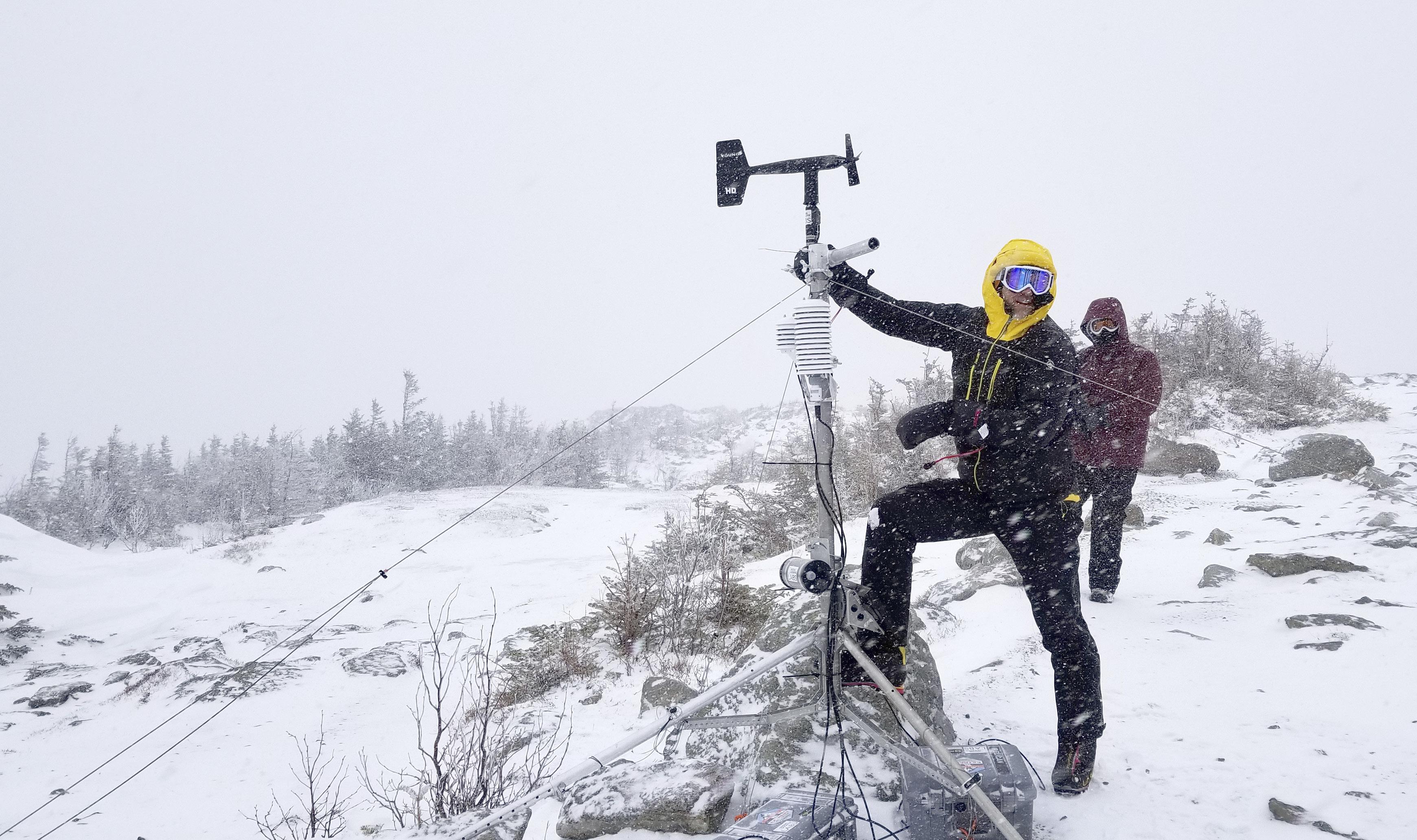
According to Perry, “The Observatory probably has more experience than anybody around the world at measuring the weather in an extreme location, and in particular, measuring the wind and developing innovative sensors and technology to maintain high-quality wind observations.”

(wind
Mass: 2.5kg
Sensor type: Omega 0-30 inches of water column wet/wet differential pressure transducer
Sensor operating temperature range: -45°C to 121°C
After the 2020 conversation at AMS, Garrett was uncertain. “Automated weather stations in extreme conditions are hard. Many of our stations [on Mount Washington] require multiple visits per year for repairs. We have the luxury of relatively easy access and normal oxygen levels in which to work on them,” he said.
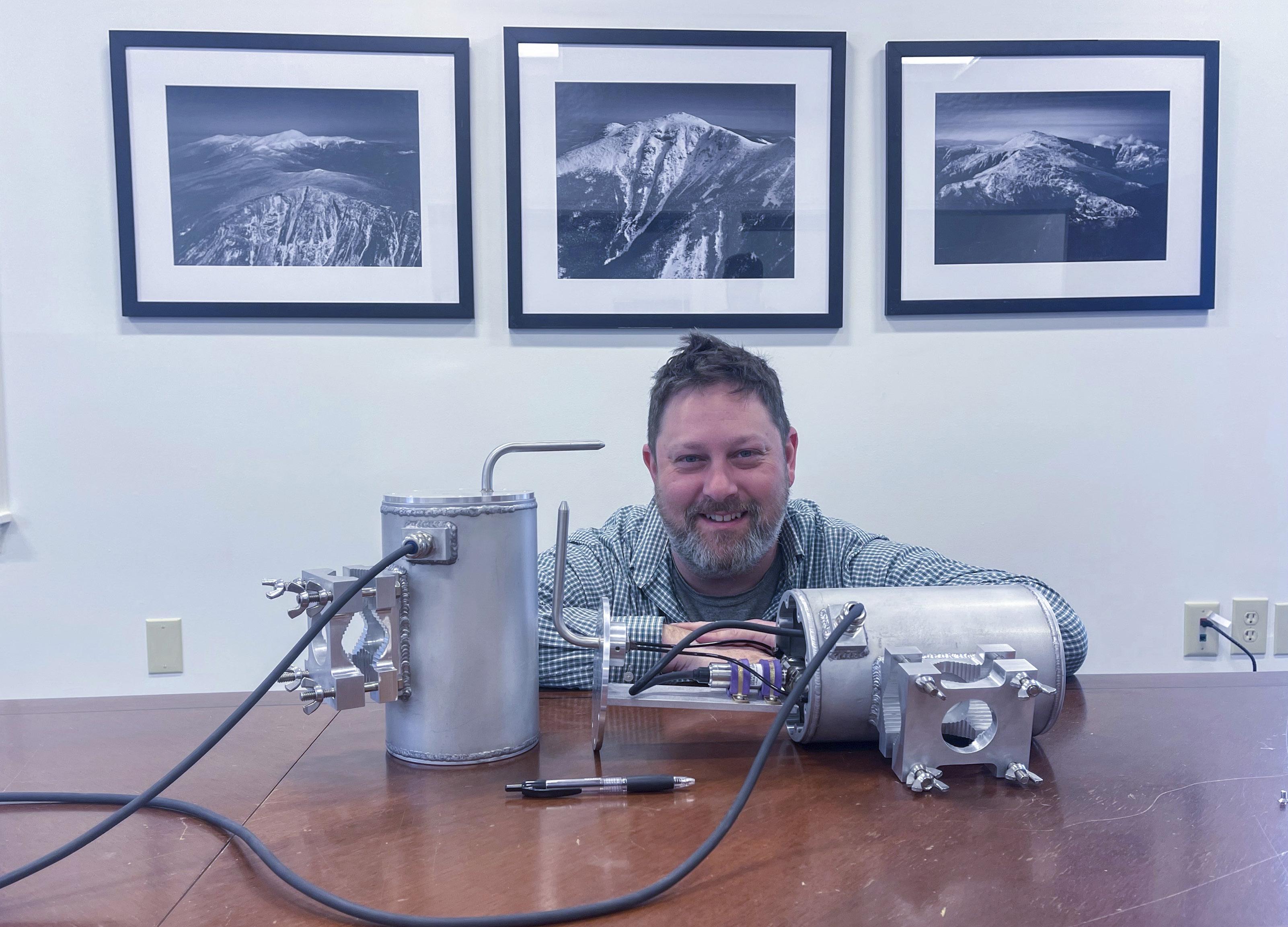
At the Observatory’s summit weather station, staffed and operated 24/7, 365 days a year, instrumentation requires hourly de-icing and maintenance in winter. More extreme events require de-icing the pitot system as frequently as every 15 minutes to keep the data flowing.
By sharp contrast, the automated stations on Everest are at the complete mercy of the weather. Seven months after the Balcony station (elevation: 27,657 feet) was installed in 2019, nearly all of the sensors were destroyed, and it went offline. Both wind sensors at the South Col (elevation: 26,066 feet) were also destroyed about the same time, but not before logging a 150-mile per hour wind gust with temperatures of -40°F, leaving little doubt as to what happened at the Balcony. Remarkably, the remaining sensors and the station at the South Col survived
Rough sensor accuracy: 1% full scale at -17°C to 85°C, ~2% outside of calibrated range Speed capabilities: ~180 m/s - ~400mph dependent upon station pressure, temperature, and relative humidity; lower bound of ~10 m/s Primary materials: Custom stainless steel pitot tube assembly from Aeroprobe Corporation, anodized aluminum enclosure Estimated wind direction angle for optimal readings +/- ~20 degrees
two full years and even partial burial by monsoon snowfall. Valuable data and insights had been collected, showing substantial loss of snow and ice, even at extremely low temperatures. “We have observational records from ice cores showing that the top of the core is nearly 2,000 years old, suggesting that the more recent ice may have ablated [been lost] relatively recently. The weather station data allowed us to hypothesize that this ice is missing because of melt and the increase in sublimation that has occurred as temperatures rise a little bit. And if the wind speed increases, that can raise the sublimation rate,” Perry said. “There is a fascinating combination of extreme sunshine, wind, humidity, and temperature that we now know is making the highest elevation of the planet more susceptible to loss of snow and ice.”
In a May 2021 article in the Bulletin of the American Meteorological Society, first authors Perry and Matthews argue for the importance of measuring wind, relative humidity, and other variables in addition to temperature, since loss of snow and ice occurs on Everest “despite persistently below-freezing
air temperatures.”
To continue collecting data from the highest mountains in the world, which Perry calls “a critical yet under-monitored cog in the Earth’s climate system,” he and Matthews contacted the Observatory in June 2021 with their request for two custom-designed, portable, low-power, lightweight, durable pitot static tube anemometers—needed in a very limited amount of time.
They planned to install the sensors on Everest the following May during the pre-monsoon climbing season, on new weather stations that would also have satellite communication devices, air temperature and relative humidity sensors, solar panels, data loggers, and other equipment.
Garrett got to work. The next few months were spent discussing instrument needs and specifications, considering the pros and cons of different aspects,
important to sustaining communities downstream. Satellites do not necessarily capture what’s going on.”
According to Perry, if the Everest expeditions can improve understanding of the processes driving the change, and ultimately improve projections of water availability and climate trends, that’s a real plus for planning climate adaptions and risk management.
Since completing the installations in May 2022, both the Bishop Rock and South Col stations have provided valuable data, but have gone offline intermittently, presumably due to snow and rime ice buildup on the solar panels and/or satellite antennae (the South Col station was offline for nearly two months previously during the monsoon in 2020, but resumed transmissions in October).
As of this writing, the new Observatory-built pitot anemometer at the South Col is online and being tested with wind
According to Perry, “The Observatory probably has more experience than anybody around the world at measuring the weather in an extreme location, and in particular, measuring the wind and developing innovative sensors and technology to maintain high-quality wind observations.”
and building a proof of concept. Decisions needed to be made in several important areas, including instrument heating and wind direction capabilities.
Based on the Observatory’s experience with measuring wind in extreme conditions—and the need to reduce instrument complexity, weight, and points of failure for the Everest expedition—wind direction and instrument heating were removed from the pitot design. A separate wind vane on the new Everest station tripods would suffice.
The nature of this frontier science involves many unknowns. After installing the new weather stations on Everest, Perry and Matthews have no eyes on the instruments to know what’s happening, and the time horizons for going back are long.
But the data being collected help fill big gaps in what is understood about the outer margins of the planet, where the land surface meets the upper atmosphere.
“Mountains totally perturb the atmosphere. What we think we understand, we don’t necessarily. That’s what we’re learning from Everest,” Perry said. “There are a lot more higher elevations around the planet where snow and ice are so
speeds in recent weeks nearing 100 miles per hour. The team is cautiously optimistic that transmissions from Bishop Rock will stabilize as winds pick up and relative humidity drops.
With 90 years of experience measuring extreme weather, the Observatory specializes in instrumentation that can withstand the world’s harshest weather conditions, with Mount Washington serving as an ideal testing ground.
“Mountains make their own weather,” said Perry, who has climbed Mount Washington many times. “What happens at 6,000 feet in the free atmosphere is a lot different from what is happening on Mount Washington. That’s why it’s so important that we have the technology and tools to observe the weather in these places.”
Mount Washington Observatory is a private, nonprofit, member-supported institution with a mission to advance understanding of the natural systems that create the Earth’s weather and climate. For more information, visit www.mountwashington.org.

There’s a reason your doctor asks you to limit your intake of salt. Yes, you need some salt to live, but too much is bad for you.
An excess of salt is harmful to all forms of life. An imbalance of salt in the cells of living things, be they plants or animals, launches a process of osmosis that causes cells to shrink. When cells shrink, they
hundreds of thousands of tons of salt applied to our roads, parking lots, sidewalks, and driveways every winter, salt has permeated our natural environment. Our precious fresh waters are becoming saltier each year.
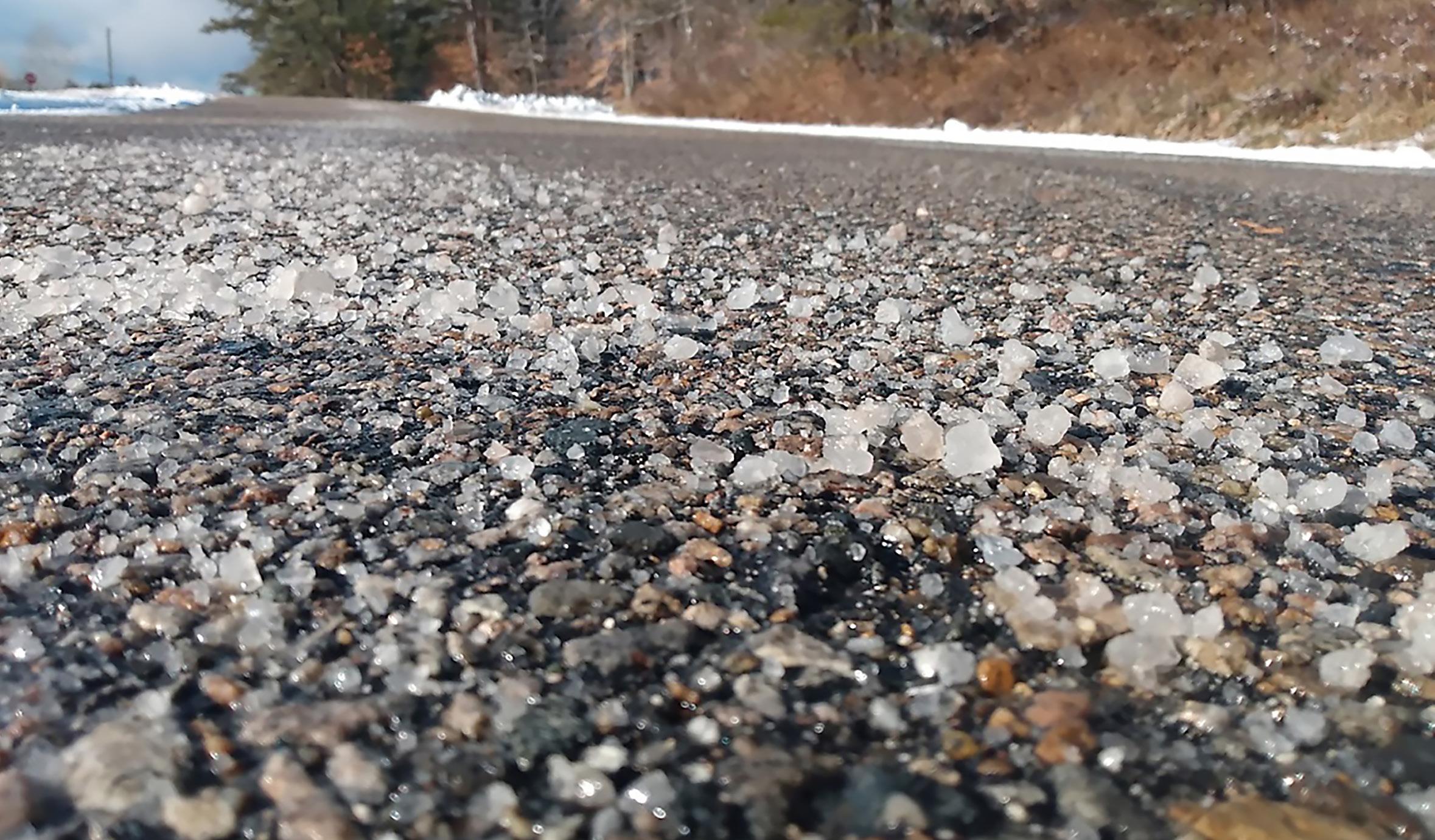
Based in Effingham, Green Mountain Conservation Group (GMCG) conducts research, education, advocacy, and land
and all those who come here to hike, kayak, swim, and fish: the Bearcamp River; the Swift River; the Pine River; the Ossipee River, and all of the vast Ossipee Lake system, including Leavitt Bay, Broad Bay, Berry Bay, and the Danforth Ponds.
Research has identified a variety of specific concerns at specific water bodies, but there is one trend we have documented at over 85 percent of all the sites we sample: salinity levels are rising, and at many sites, salinity readings have exceeded levels deemed by the U.S. Environmental Protection Agency to be unsuitable for aquatic life.
become damaged—and that damage causes all kinds of havoc for your body, for a fish in a freshwater stream, for insects, for flowers, and for trees.
Too much salt is also bad for our cars and the bridges we cross each day. The chemistry is different from the way salt harms living things, but anything made of iron or steel is at risk of corrosion or structural failure if routinely exposed to salt.
Salt is not a mineral native to New Hampshire, but due in large part to the
conservation to protect the waters we enjoy, the groundwater we drink, and all of the natural resources that make the greater Saco River Watershed and Carroll County such a special place to live and recreate.
One of our core programs is water quality monitoring. For the last 20 years, we have collected and tested samples from lakes and streams from the Sandwich Range of New Hampshire to the Sacopee Valley of Maine. We monitor waters familiar to all those who live here
GMCG has amassed a comprehensive multi-year database tracking a variety of parameters such as pH, turbidity, temperature, dissolved oxygen, phosphorous, and salinity.
Our research has identified a variety of specific concerns at specific water bodies, but there is one trend we have documented at over 85 percent of all the sites we sample: salinity levels are rising, and at many sites, salinity readings have exceeded levels deemed by the U.S. Environmental Protection Agency to be unsuitable for aquatic life.
GMCG’s data mirror findings of the New Hampshire Department of
Environmental Services (NHDES), which currently rates 50 NH water bodies as “chloride-impaired” based upon federal Clean Water Act (CWA) standards. In 2008, only 18 New Hampshire water bodies failed to meet CWA standards. These upward trends will persist as long as we persist in salting winter roads the way they have been salted for decades. The good news is that winter travel can remain safe with a lot less salt. From small changes at home to large changes that can be made by municipalities and private contractors, there is a path to saving New Hampshire’s lakes and streams from this annual onslaught of toxic salt.
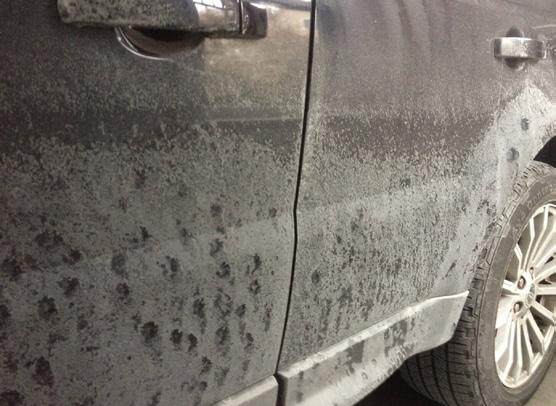
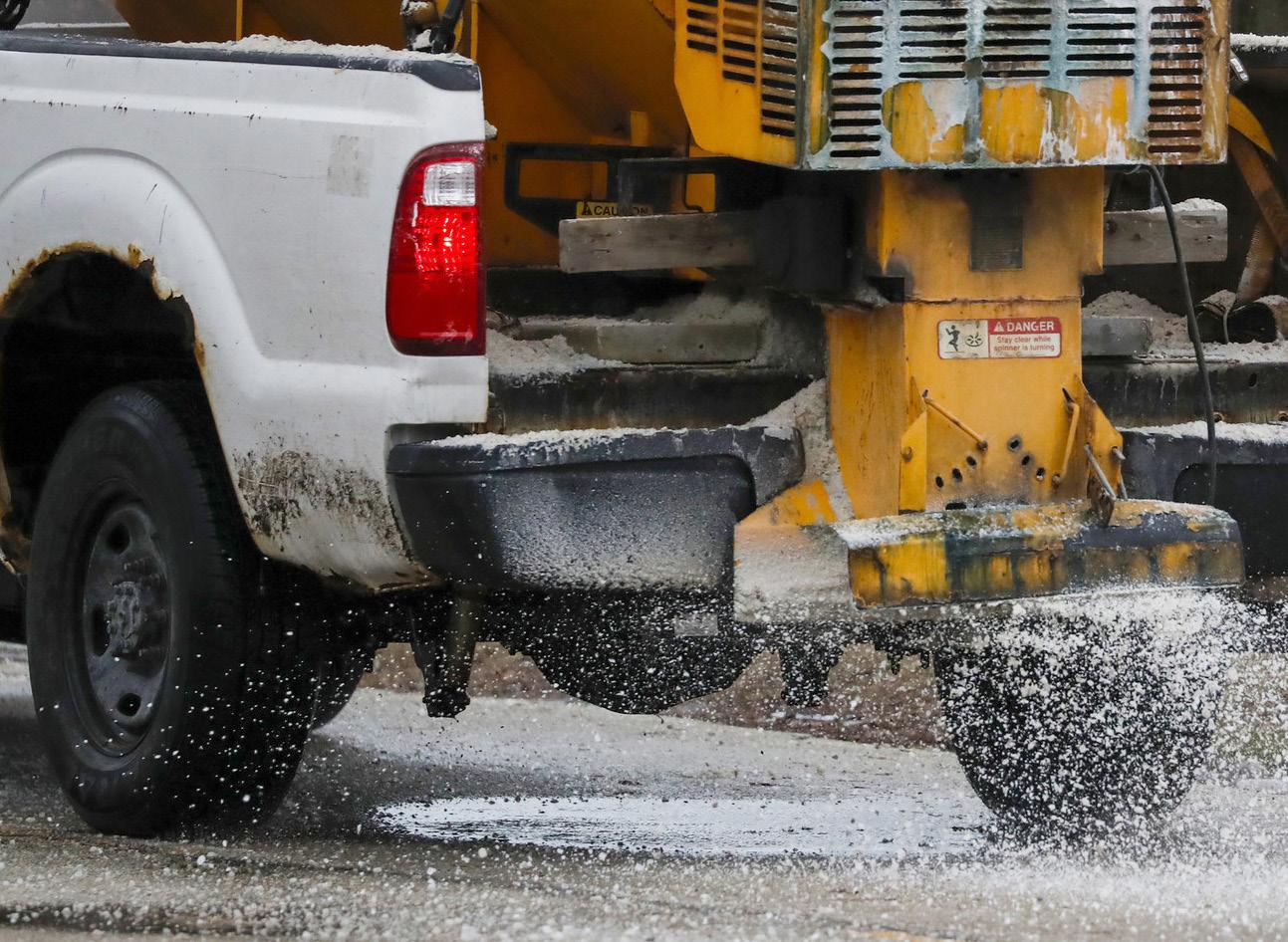
There are some emerging alternatives to salt, such as beet juice and various organic compounds that provide traction
on snow and ice. However, until such alternatives are more widely available, the first, achievable step is simply to use less salt. Research indicates that everyone from municipalities to private contractors to homeowners typically spread 50 to 75 percent more rock salt than necessary.


– the best solution so far Modernized salt spreading equipment with calibration systems is helping to reduce such waste, but the best way to dramatically reduce the salting of New Hampshire’s waters over the next few years will be for every town and every private contractor to incorporate brining into their winter road maintenance routines. Brining is a process through which road salts are dissolved in water before they are applied to roads, parking lots, and driveways.
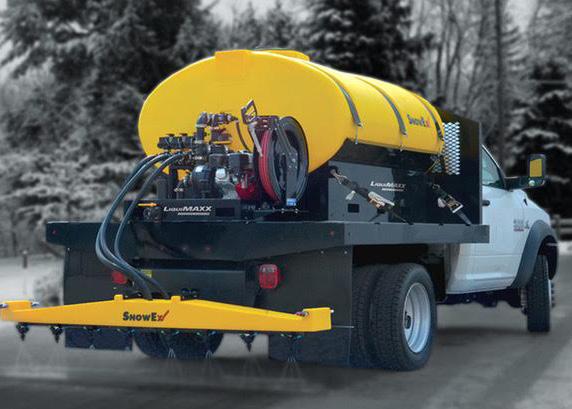

Road maintenance brine, a solution with a ratio of 23 percent salt-to-water, lowers the freezing temperature of water to approximately 18°F. Applied to dry surfaces prior to a storm, brine has been found to be more effective in melting ice and snow than regular rock salt, while reducing salt applications by more than 50 percent. In the face of rising costs— commercial salt prices have increased at 25 percent for most NH towns since 2020—brining offers a significant financial benefit in addition to protecting our natural resources.
In 2021, the town of Madison became the first in the Mt. Washington Valley region to acquire brining equipment. Much was learned, and in the spring of 2022, the town’s public works department invited officials from towns across the region for a presentation on their experience and an exhibition of their new
The graph above shows chloride levels for surface waters in six towns monitored by Green Mountain Conservation group over the last two decades. The graph on the right shows sodium levels. Sodium and chloride are the components of rock salt (NaCl), which is the most commonly used salt by NH road crews. For surface waters to be rated “pristine", sodium and chloride levels must be below 10mg/liter (noted by horizontal red line). Visit www.gmcg.org/research/water-quality-program-data for additional information.

equipment. As the town prepares for the coming winter, it is working with officials from the University of New Hampshire to troubleshoot and acquire best practices for applying the liquid brine to town roads.
Marilee Emus, the director of the UNH Technology Transfer Center, which oversees the Green SnowPro training program, works with towns across New Hampshire to support their adoption of new, salt-reducing winter maintenance strategies. She observes, “There are a variety of materials in use for fighting snow and ice, and the decision around what and when to apply depends upon variables such as the weather condition, road surface condition, pavement temperatures, precipitation forecast, dew point, amount of sunlight, and many other variables. Liquids, treated salts, and processes such as pre-wetting and pre-treating—and using salt brine—can all have a role in effective winter operations, including maintaining safe, effective roadways, while minimizing the impact of chlorides (salt) and silica (sand) on the environment.”
In 2012 the New Hampshire House and Senate passed legislation that led to the establishment of the Green SnowPro Program, one of the first such initiatives in the country. Administered by the NH Department of Environmental Services and UNH, the program offers training and certification in the best practices for winter road maintenance, with an emphasis on maintaining safe roadways while using less salt.
The law further provides that Green SnowPro-certified pro-
fessionals (and the property owners who hire them) are granted liability protection against damages arising from snow and ice conditions. For additional information, visit www.des.nh.gov/ land/roads/road-salt-reduction/green-snowpro-certification
Get involved! If you live in a town that has not acquired brining equipment, you can make a difference by contacting your town administrator or board of selectmen and urge them to research the benefits of brining. You can also check to see if your town’s road maintenance personnel are Green SnowPro-certified.
You and your family can brine your own driveway. It is easy. Just mix rock salt and warm water at a ratio of one part salt to three parts water (that’s about two pounds of salt for every gallon of water). Use a garden sprayer or watering can to apply sparingly—a light coating is all that is needed.
For traction, use sand instead of rock salt. Sand has its downsides as well—as it releases unwanted contaminants such as phosphorous—but overall, it is not as harmful to the environment as salt. Other materials to treat your walkways include coffee grounds, kitty litter, and sawdust.
Green Mountain Conservation Group strives to promote and inspire environmental action founded on science. Road salts are a serious problem. We know they are a serious problem because we have the hard data to prove it. Unlike some environmental threats, this is a problem that everyone can help solve by
The salt on sidewalks, parking lots, and roads can help keep us safe from icy patches in the winter time, but
For more information, visit www.saltsmart.org/ how-winter-salt-affects-our-pets.
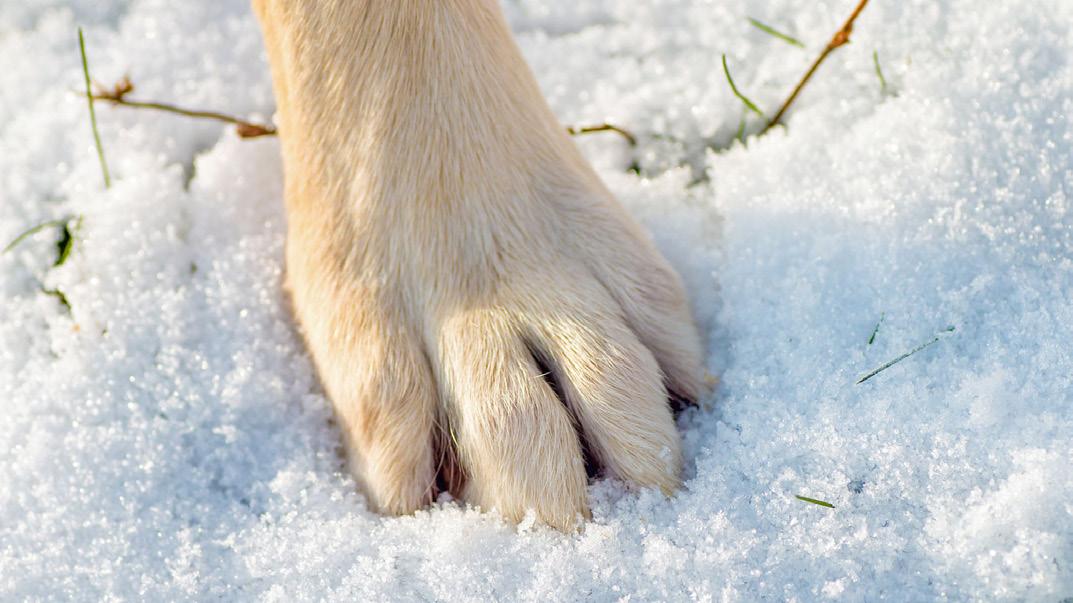
spreading the word and by changing their ways. The next time you see a neighbor casting a heavy swath of rock salt across their driveway or sidewalk, start a conversation. Talk about how that salt is going to dissolve into someone’s water. It might be the nearby stream where people fish and children play. It might be a wetland, home to an abundance of life that relies on fresh water. Or it might be their very own well water.
For additional information about the science and solutions, visit www.saltresponsibly.org. Let’s all do our part to keep New Hampshire’s winters safe—and our waters pure—for the next generation.
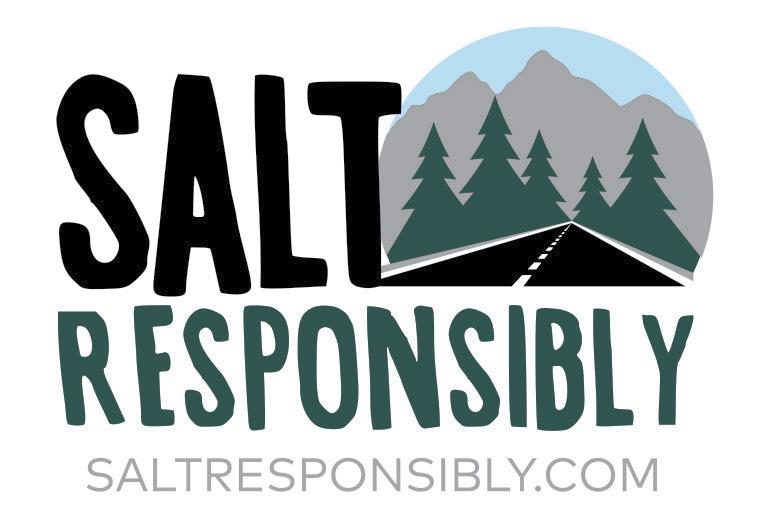
The mission of Green Mountain Conservation Group (GMCG), a 501(c)(3) charitable organization established in 1997, is “to promote an awareness of and appreciation for clean water and the wise use of shared natural resources across the Ossipee Watershed and advocate strategies to protect them.”




Welcome to the whimsical winter edition of White Mountain Brews & News. Our local brewers have given me a sneak peek into this season’s greetings, and I shall now pass the sacred scrolls onto you.
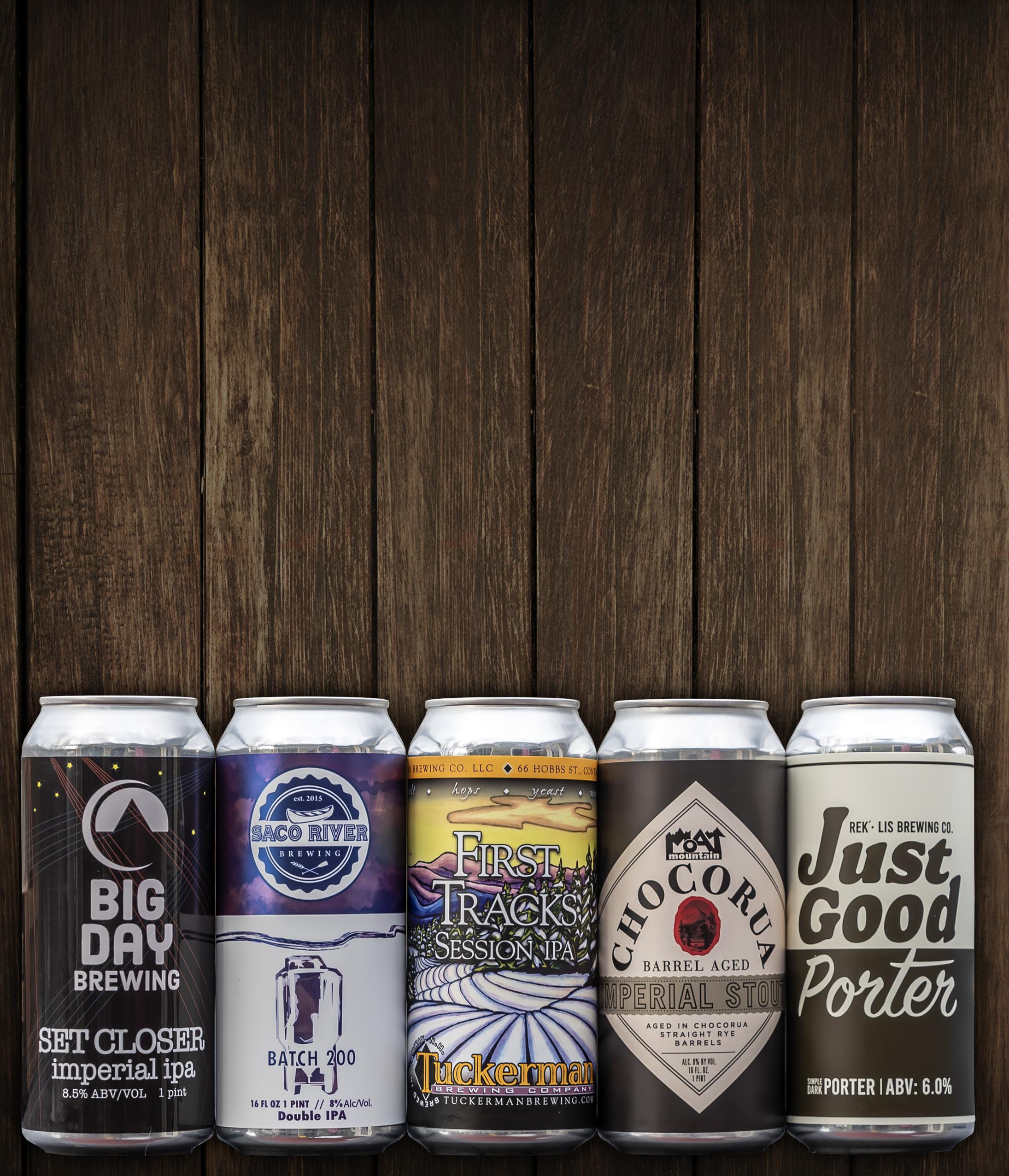
Much ado at the Moat Mountain Smokehouse and Brewery these coming months. Starting with a freshly squeezed supply of Jimosa Brut IPA. The juicy 6% hazy glass of goodness is limited to draft only, so get it when you see it, cause you can’t take it with you. Still supporting the Mad Food Genius Fund in honor of Jim Davis, Jimosa blends the orange hints of a mimosa with the flavor of a dry IPA. Made
for brunch but works any time or any day, just like Jim.
Something else that’s working is the collaboration Moat has with Tamworth Distilling. This is the third batch of the Chocorua Rye Barrel Aged Imperial Stout. The roasted cocoa 9% stout smooths out the rye whiskey notes drawn from those precious barrels and blends them perfectly for you, the people. Such togetherness brings a tear to my eye, and also brings me to our next brew: Gnomaste. This 8.8% Belgian IPA brings the fresh hoppy flavors of an IPA with the boozy smoothness of a Belgian Strong Ale. The “G” is silent in Gnomaste, which is more than I can say for
myself after a couple of those!
Making their way back is Flavah of the Day, a 7% tropical IPA, and Clockwork Mandarina, a 5.6% hazy pale ale. Later in the season, the 9.5% Slow Chair Tripel will be back. Slow Chair is an easy-drinking, but deceptively strong, Belgian-style ale. The bitterness from both the hops and yeast balances out the large malt bill, offering a smooth, medium body with tastes of pear, nutty yeast, bread, and butterscotch. The substantial carbonation lends to a warming alcohol dry finish.
Hobbs has all their bed knobs and broomsticks marching in formation, so let’s get a movin’ before I get swept away.
Back Road Brown is a 6.3% robust and hoppy American brown ale with notes of caramel, coffee, and chocolate. A unique blend of malts gives this beer its rich smooth base, and a carefully selected variety of American hops make it shine. Granite State Cranberry Sour is also 6.3%, but this Christmas cutie uses Maine-grown Pilsner and wheat malt. Then, fermented with a mixed culture of yeast and wild
flavors of bourbon and vanilla—thanks to the long stay in their barrel cellar. A balanced bitterness and lingering oak finish round out this beautifully complex stout.
Happy 40th anniversary to the Woodstock Inn Brewery in Lincoln, NH. What an accomplishment!! A great place any time of year, Woodstock has some wonderful winter brews. Winter Whirl, the new 4.5% seasonal light golden ale has
Tuckerman Brewery, near the heart of the bustling downtown Conway, will be celebrating its 25th year of providing the populace with its pinnacle Pale Ale.
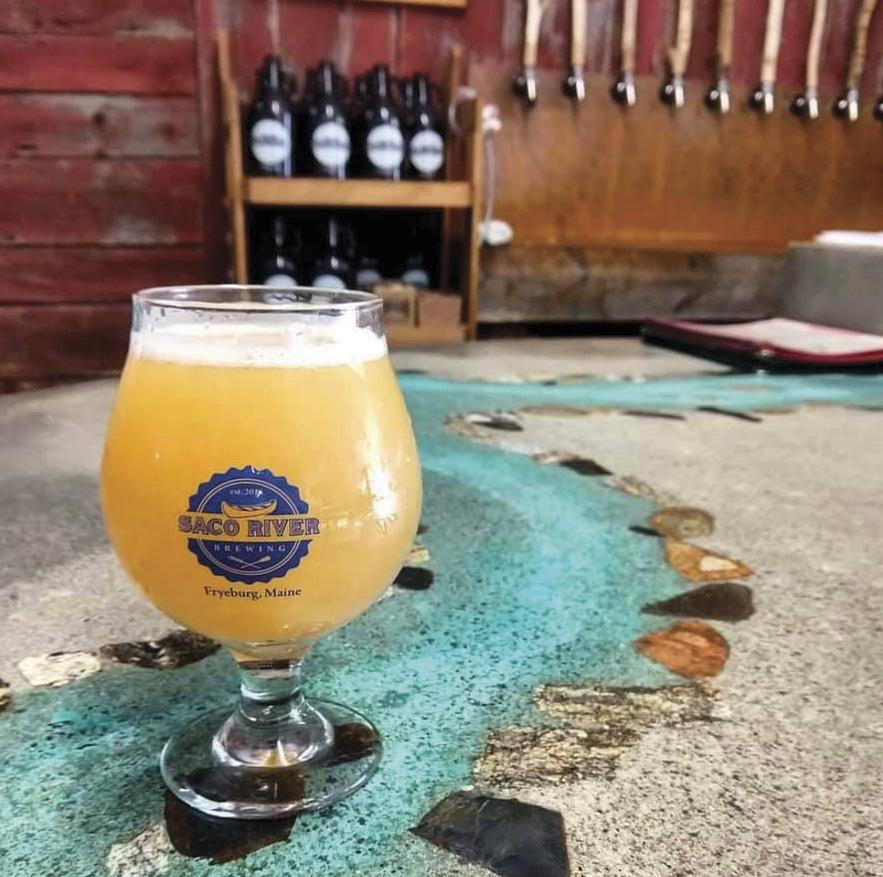
bacteria whilst aged on cranberries. Refreshingly dry with a prominent Brett Funk (better than Terry Funk!) and delicate tartness. Haze Bale, the Hobbs rotating hop series, is on my to-do list this year. Showcasing Nectaron, a New Zealand hop with aromas of passion fruit, peach, grapefruit, and pineapple—this 6.5% NEIPA has me waiting in anticipation as if it were a new transformer, Nectaron! The robot that transforms into a beer! Lastly, their 11% bourbon-barrel-aged imperial stout Wizard of Hobbs returns. They sent this big burly and wicked brew into a bourbon barrel, and six months later, out comes a silky smooth, decadent, and chocolatey stout that perfectly pairs with a classic movie. Full-bodied, roasty, and rich with
epic amounts of Galaxy Hops, providing an amazing aroma and no bitterness. The perfect mountainside essential companion for all your après-ski plans. Life is better on the slopes! Wassail Ale is back for the winter season with a new label. This spiced ruby red, sweet, and balanced winter warmer pairs well with an open fire and not going to work. Cannon Ale is their NEIPA with low bitterness, enlightening aromatics, and easy to drink at a reasonable 5% ABV.
Offering a variety of styles focused on high-quality, local brew!



citrusy, clean feel and assertive bitterness. Enjoy a pint or a flight, and be sure to take some beer to go in growlers or cans!
Keep your eyes peeled because this 6.5% fave has a new label. Last but not least is Woodstock Kanc VISIT OUR FRYEBURG TASTING ROOM!
Maple VISIT OUR FRYEBURG TASTING ROOM! (207) 256-3028 www.SacoRiverBrewing.com 10 Jockey Cap Lane, Fryeburg, ME

7% deliciously smooth, dark winter brew, is a malt beverage with natural flavors added. Made with Fadden’s Sugar Shack Maple Syrup, Kanc compliments any meal, including a super-sized stack of banana flap jacks.

Another brewery birthday is coming up on January 15th. Tuckerman Brewery, near the heart of the bustling downtown Conway, will be celebrating its 25th year of providing the populace with its pinnacle Pale Ale. The party will be packed like peanuts with superstars like their brick-oven pizza, the magnificent Mallet Brothers, and the release of their Doublehead DIPA. This 8% full-bodied hazy brew has MHP (maximum hop profile). Loaded with Lotus hops leads a tropical citrus pop coupled with a flexible malt backbone keeps Doublehead squared while shooshing. On the other side of the ravine is a commanding imperial stout, She Who Controls the Spice. This sultry stout has notes of roasted malt, coffee, and chocolate, and a spicy surprise. Aged with fire-roasted Hatch green chilis, Spicegirl (my nickname for this beauty) teasingly tickles your tongue and leaves you all warm and cozy. For lighter fare, their Granite State Cider is a clean bubbly dry hard cider made from apples from Poverty Lane Orchards in Lebanon, NH.

Looking for a crafty Secret Santa present? Well, look no more! Take a small trip to Big Day Brewing in Gorham, NH for their flagship IPA, Secret 7. Generously hopped with Vic Secret and Idaho 7, this 7.3% lovely libation greets you with enticing aromas of tropical fruit and then embraces you in a hoppy hug of citrus and pith. Compared to Secret 7, their NEIPA Gravity Quest is a curious contradiction. Being both a lit-

tle heavier with a 7.5% ABV, but drinking a little lighter. I’m sure NASA is looking into this as we speak. For those snooping scientists, Big Day offers a kettle sour to sweeten their studies. Day Breeze is blowing in at 5% ABV with patches of pineapple and cherry purée giving way to an inviting tart and quenchable quaff. Lastly, just as the name implies, is the imperial IPA, Set Closer. This 8.5% dank draught drips with ripe fruit and resin, perfect for putting the last bow on the last box.
From my first visit to my most recent, Saco River Brewing in Fryeburg, Maine, always has something special brewing. This season is no different. Starting with the sweet and silky 7.8% milk stout, Nighttime Frozen Parking Lot. This dark malty mouth-watering wonder will steady your nerves after the frantic leg-flailing that keeps you on your feet and off the icy pavement. A more mellow mid-winter malt friend is the Munich
Dunkel. This German-style middleweight makes me long for more nights by a hot fire with a cold pint. I’m always happy to see my favorite Batch 200 DIPA return. This 8% Mosaic-hopped glass of goodness is a wish come true for NEIPA lovers here in the Valley—or as far as a sleigh can travel. Buzzing about the barn at Saco River is their 9% dank and aromatic Murder Hornets Nest, Imperial IPA. By no means is this beer as deadly as its namesake, but it can sneak up and sting you if you’re not careful.
There is so much more going on at all our beloved local breweries. Be sure to check their social media pages for the latest special events and gatherings. Alone or with friends, visit them and you are sure to find your happy and hoppy place. When the wind is whipping, and the drifts are piled over our heads, it’s comforting to know we’re all together keeping each other warm. Peace and love to all.
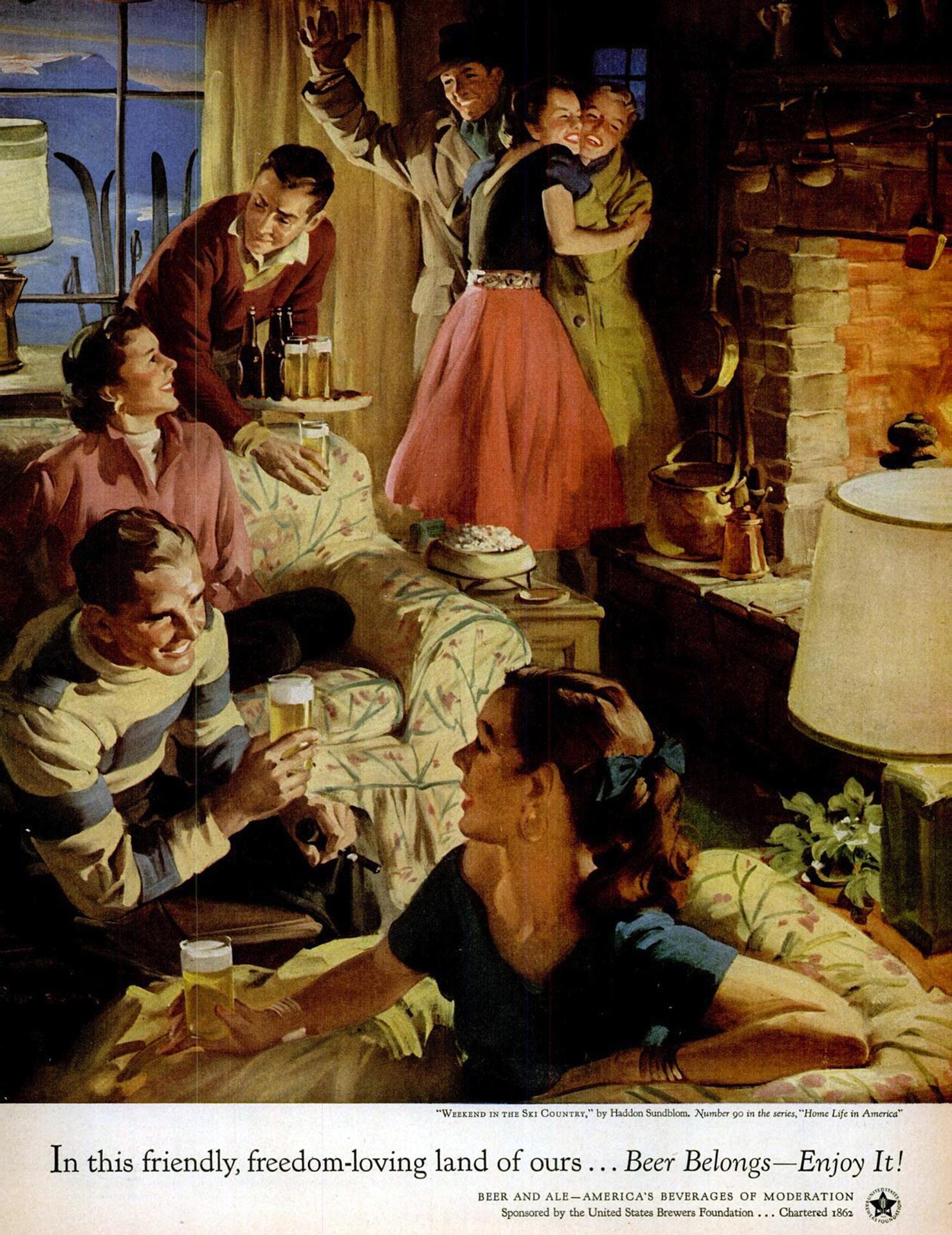

Clem McAuliffe, owner of Vista Bev & Market, loves beer. He loves talking about beer, reading about beer, writing about beer and, of course, drinking beer. All who enter the store quickly understand the benefit of asking, “Clem, what am I drinking today?”
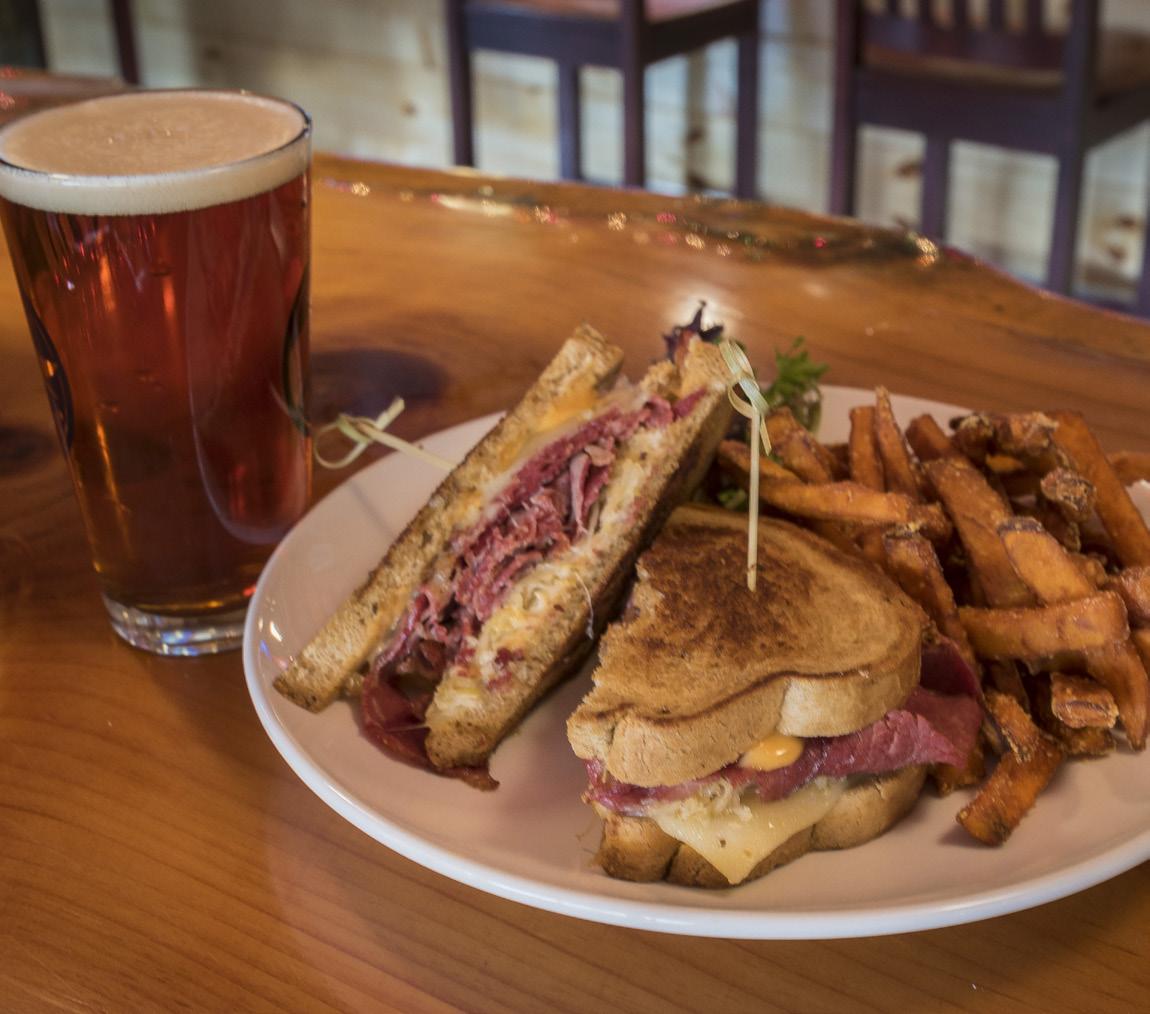

(603) 356-5084 • Intervale



Under the cover of darkness, they often work in brutal cold. The job can be lonely but opens up a world of splendid isolation in the forests where deer, moose, and more do roam.
These smooth operators pull long hours at an often-thankless task and pilot a warm roving man cave atop a multi-ton machine with a blade out front, a tiller at the rear, and tank-like treads. With a joystick and their favorite tunes playing if they choose, they navigate up and down steep mountain terrain, deep into the woods, and along winding maze-like pathways.
While downhill skiers, snowboarders,
cross-country skiers, snowmobilers, and other snow lovers are dreaming corduroy visions in their Valley beds, groomers are out from sunset to sunrise, when conditions permit, to craft those satiny pathways to adventure.
“It’s a bit of art and science,” said Cranmore’s grooming supervisor Kevin Hickey, a man with 23 years of experience, starting with the second shift as a Kennett High School senior so he could go to class in the morning. He now oversees a staff of about 15 with two Pisten Bully 600 (one diesel-electric, one winch) and two Prinoth Bisons. “You can go anywhere in one of
those machines,” he said.
Talk to a groomer about their métier, and patterns appear. Experience is the key to efficiency. Have a plan so you don’t go over the same ground twice. Be sure to sample your finished product.
They groom when temps drop below freezing. Part of basic alpine grooming is putting back uphill the snow that skiers and gravity push downhill.
Sunsets and sunrises are pristine and chance wildlife encounters memorable. “One of the coolest things is sunrise, the silent sparkle of winter,” said “Nordic” Nate Harvey, a Great Glen Trails (GGT) staple since 1997,
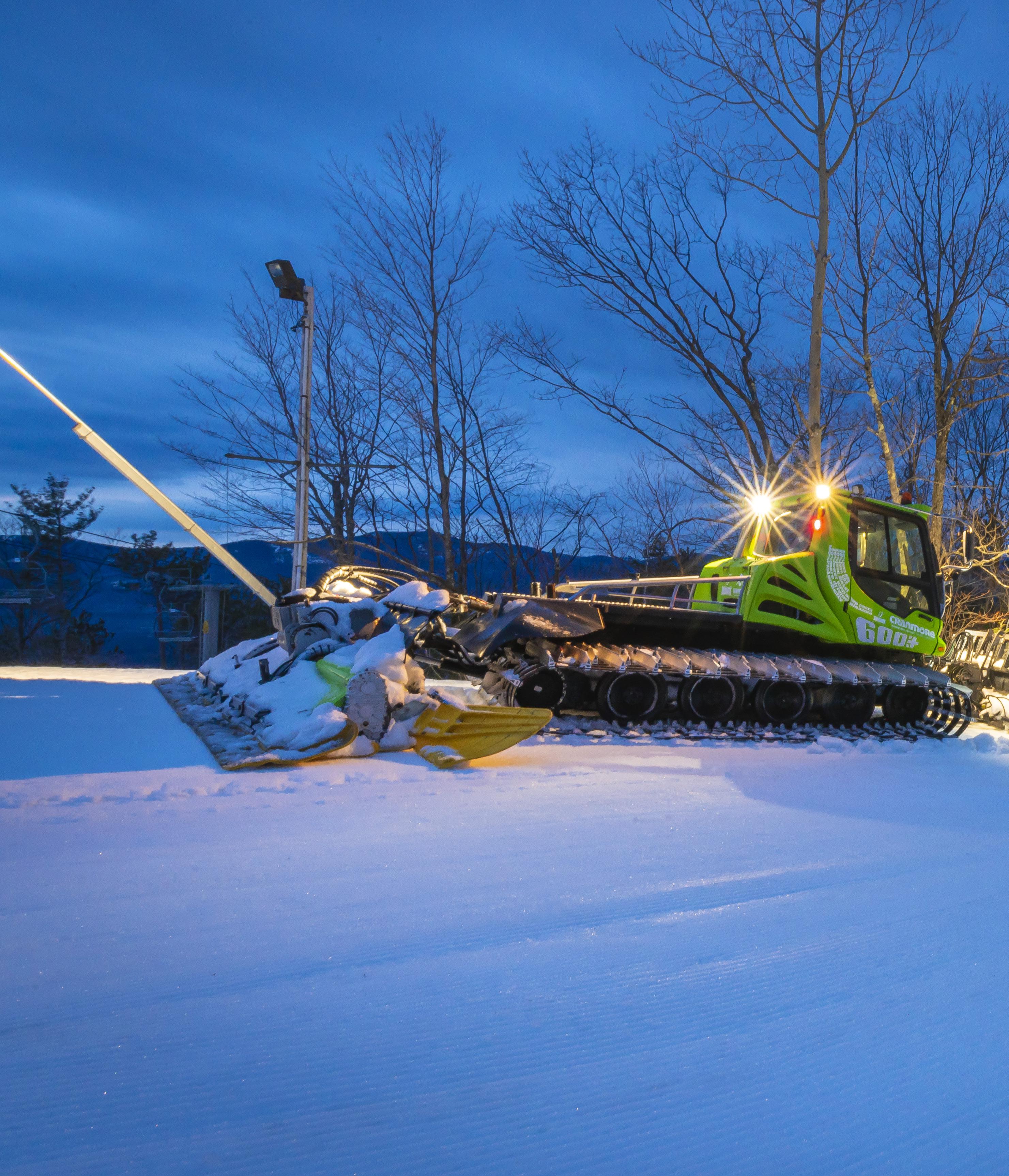
with some 20 years of grooming management and 10 of hands-on experience.
Getting stuck at zero dark thirty, removing downed trees, wind, frigid temps, and covering bare spots are some of the challenges. Safety is paramount. “You never really know what you’ll run into,” says Tim Kiesman, president of the Mountain Meadows Riders snowmobile club with about 12 years of grooming experience. “You should expect the worst and hope for the best.”
There are also pet peeves, such as people unknowingly walking on freshly groomed snow and leaving holes. But there’s really a big one. Don’t poach! “Poachers can come down, go around a corner and be right on us,” said King Pine’s Jake Jenkins, who along with Russ Ellis, have a combined 60 years of experience and are the heart of the ski area’s three-person grooming team with a Prinoth Bison and back-up for the ski area’s 17 trails. “We don’t expect anyone
out there,” added Ellis. “We really don’t.”
Every operation has its nuances. The groomers know every rock and root. At Cranmore, they work two, eight-hour shifts with a midnight shift change. Cranmore has 172 acres of skiing when wide open, with each groomer doing some 25 to 35 acres in eight hours. The upper mountain is done first—with the beginner slopes, South Slope, tubing, and terrain parks completed after midnight.

Talk to a groomer about their métier, and patterns appear. Experience is the key to efficiency.
“This really is a video game of Nordic Tetris,” Says Harvey. Plus, a role-playing game where Great Glen’s groomers not only groom, but provide the snow report or even teach a lesson.
Hickey’s craft has improved under the guidance of the late, legendary Olympic groomer Jim Mersereau, and his sons Josh and Johnny. “Jim instilled that nothing else matters. This is one of those places that gets in your blood,” says Hickey. He’s always ready to work and has missed Thanksgiving, Christmas, and New Year holidays, as well as birthday parties with family and friends. “I learn stuff every day. Every night is different from Thanksgiving to MLK weekend. Everything is changing. February vacation is the big show. You’ve got to get everything right, from snow depth to making sure the beginner trails are flat, to not too much pitch in the woods. Make sure it is safe. After February, it is like you mowing the lawn every night,” he says. Poachers? All the time. “I understand people want to get out, but it creates an unsafe situation,” he said. “At night, we can only see what our headlights give us. We have a winch cat, and that cable can snap.”
When the lifts close, the grooming begins at King Pine, from the hill’s dark backside to the front with its lights, the terrain park, and tubing lanes. “The weather is always a challenge,” said Ellis. “If it’s raining, you have to wait until it’s over, let it drain, and then groom. When there’s a snowstorm, you have to groom with the storm.”
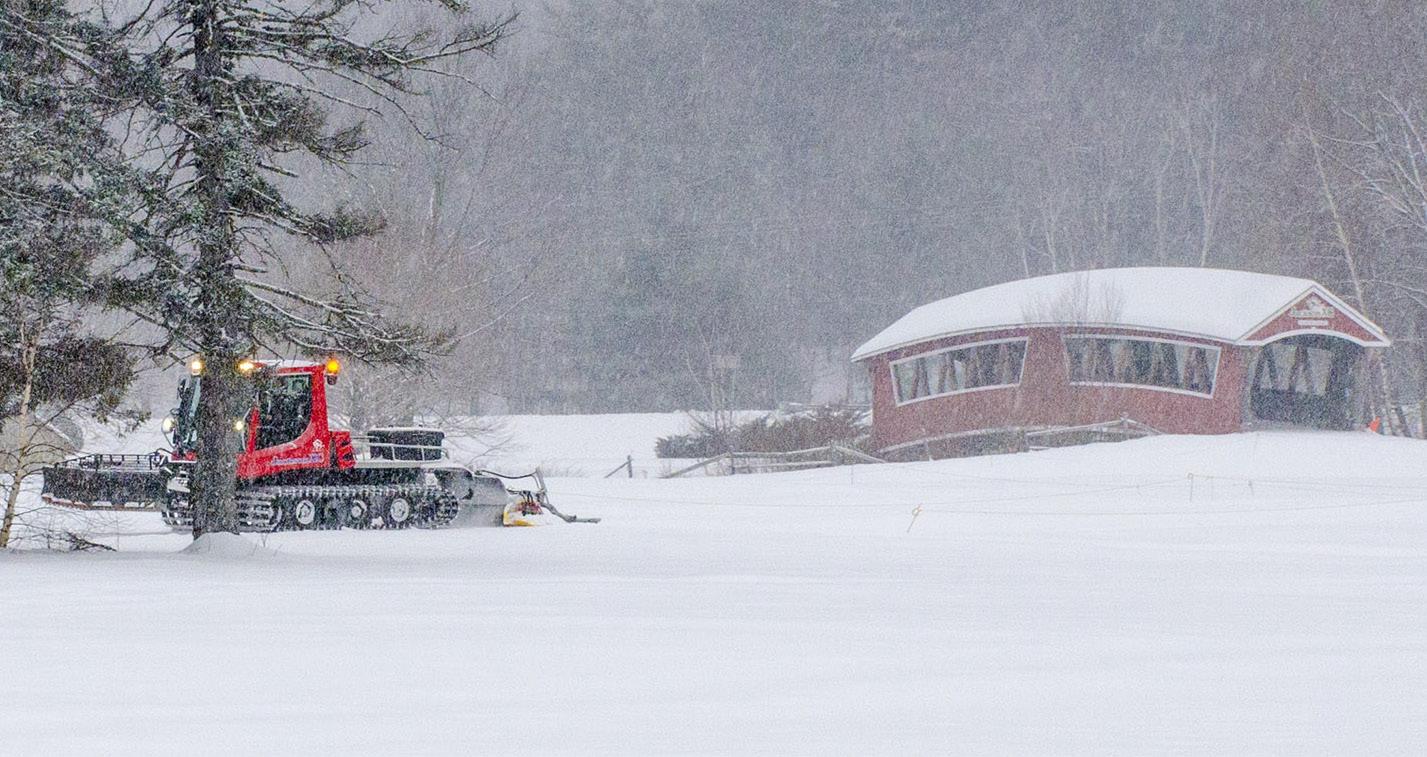
Added Jenkins: “You are just packing, not blading. Also, you have to know where you are on the trail or on the whole mountain because you don’t have a lot of visibility.” The job can be thankless, but the pair get well-deserved kudos, along with a few knocks, at times.
“We don’t often see them because we’re working on the other side of the clock, but dedicated skiers know what you do, and they let you know,” said Jenkins.
Those wide wavy skate lanes and firm classical tracks for cross-country skiers are also the results of dedicated groomers. Using a Pisten Bully 400 and snowmobile with a Ginzugroomer attachment, the small GGT crew smooths some 25 kilometers of trails at the base of Mount Washington.

Typically, the Auto Road is groomed first at day’s end so that the



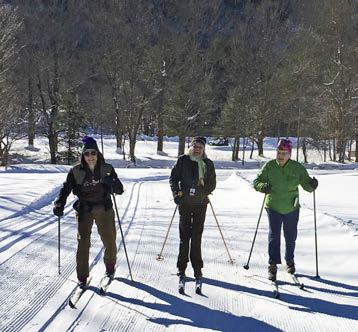

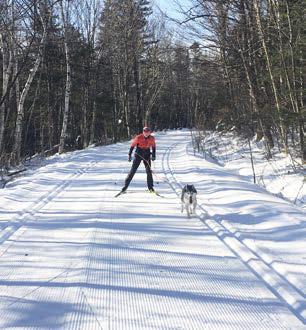



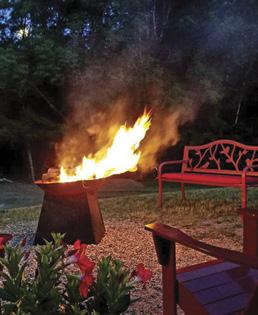

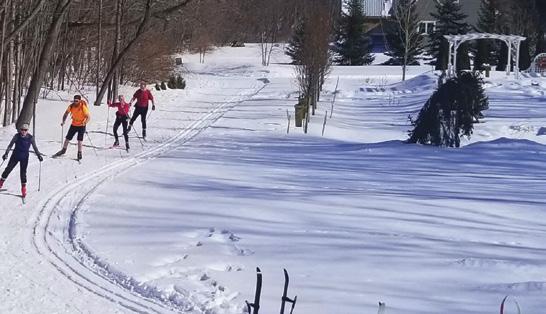
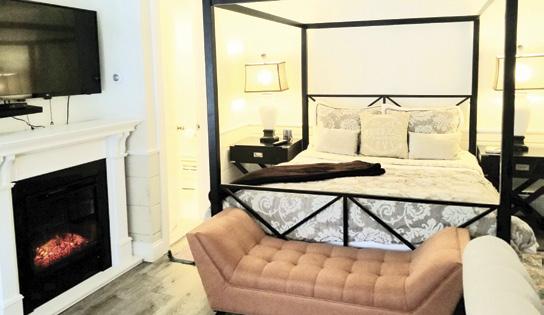


surface can set up overnight for SnowCoach rides to 4,000 feet. Then tubing is shown some love; around 4 a.m., the groomer sets tracks and polishes the skate lanes.
Temperature inversions and bare spots prove frustrating. Sometimes trees are cut so the snow falls on the trails, but that up-high openness means the sun’s intense at intersections of high use. To defend it, Great Glen blows snow on some sections, or trucks it in. Wind’s another hurdle. Snow fencing helps, but so
from Madison to Conway, including pathways up to Cathedral Ledge, the popular Corridor 19, and Bypass Trail.
The club’s five-person volunteer crew works with a new Tucker 1100 trail groomer every day but Sunday, doing half the network one shift, and the remainder the next—usually from sunset to having them home by midnight, weather permitting.
“We try and split it up so that one guy has one shift a week. It makes it easy for everyone, especially with volunteers,” said
Snowmobile trails attract other users such as snowshoers, dog walkers, mushers, and fat-bikers. Courtesy and safety rule. “As far as the club is concerned, they are all welcome on the trails,” says Kiesman. “We try to encourage multi-use trails where everyone can enjoy it.”
does stockpiling it and then blading it out or moving it by hand.
“Everyone has a blue snow scoop to help,” said Harvey. Snow is frequently shoveled for events, races, and daily operations.
The groomers are making lanes about 14 to 18 feet wide, with classic tracks on both edges and a skate lane in the middle. Those tracks can’t be too close to the edge. They want to be efficient and not re-tracking themselves. “This really is a video game of Nordic Tetris,” he said. Plus, a role-playing game where Great Glen’s groomers not only groom, but provide the snow report or even teach a lesson.
Skiers aren’t the only winter lovers appreciative of those who only come out at night. Grooming makes snowmobile trails less rough and rutted and more enjoyable. The Mountain Meadows Riders snowmobile club, fueled by donations and volunteers, has about 350 to 450 members. It maintains about 70 miles of tracks
Kiesman. Many snowmobile enthusiasts ride at night, and even though the tall machine with a 16-foot drag has bright lights, it can still startle unaware sledders around blind corners.
The club goes so far as to remind members on its trail map to keep their eyes open for groomers on the trails, reminding them the machines have right of way. “For me, it’s been incident-free, but there have been some close calls—as it is with anything,” said Kiesman.
Snowmobile trails attract other users such as snowshoers, dog walkers, mushers, and fat-bikers. Courtesy and safety rule. “As far as the club is concerned, they are all welcome on the trails,” he said. “We try to encourage multi-use trails where everyone can enjoy it.”
So thank a groomer, enjoy, and don’t poach.
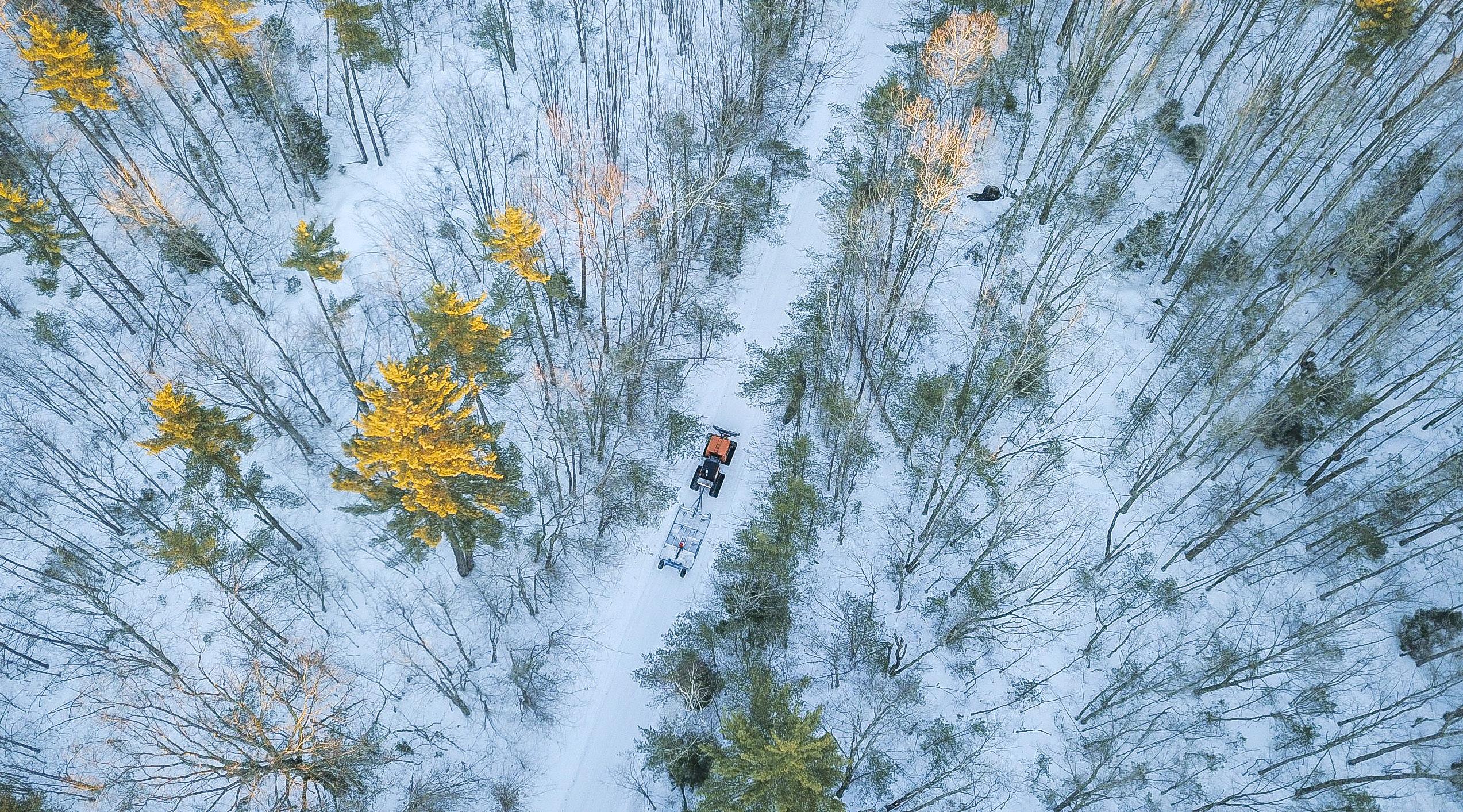
The White Mountain Trail Club, www.whitemountaintrailclub.org, is a small club that spend over 400 hours per year clearing, grooming, and maintaining the trail system in the Bartlett, NH region. While they are primarily a snowmobile club they also support mountain bikers, mushers, skiers, and snowshoers.

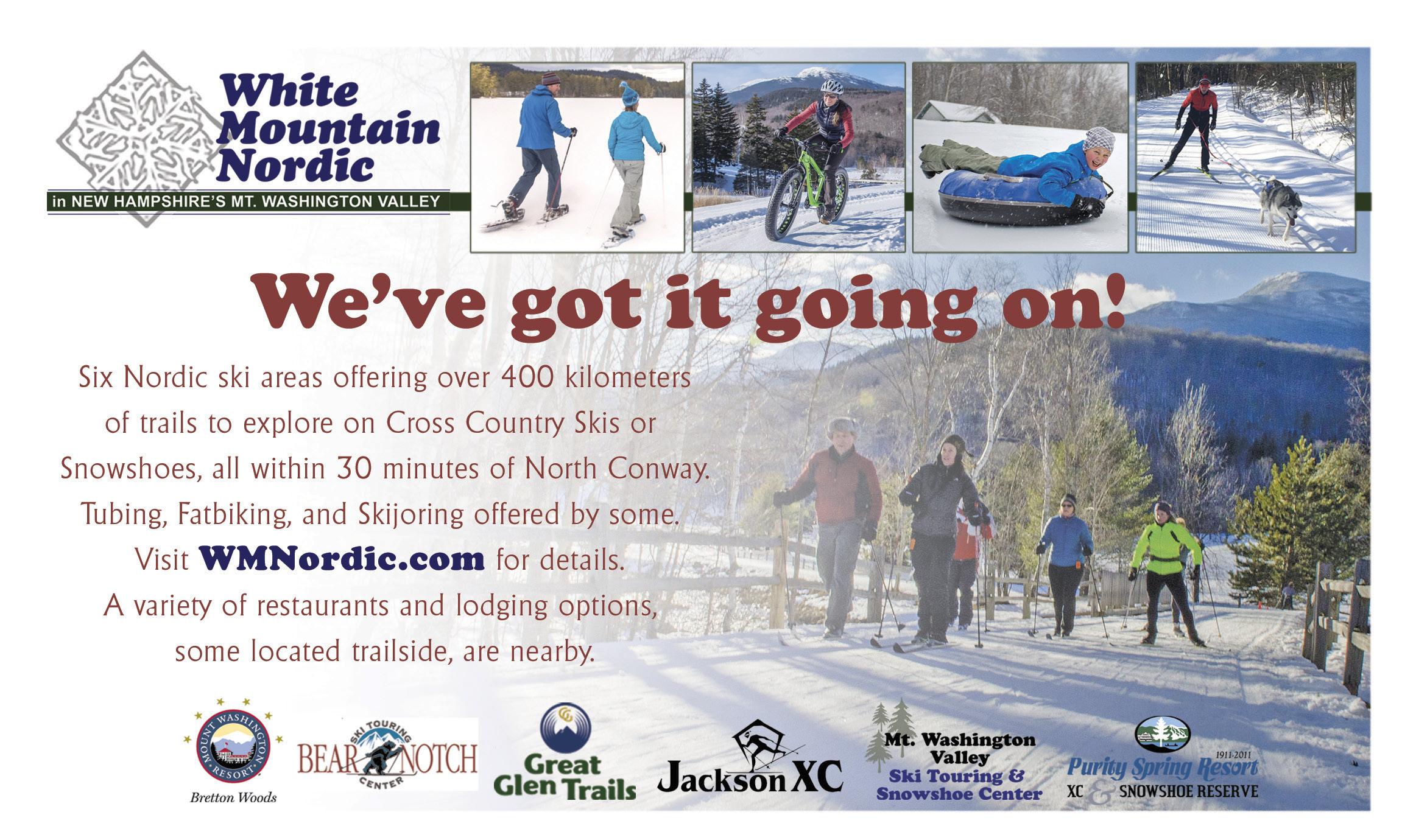
Sometimes the path well-traveled is the best path to follow. With an influx of new riders, the New Hampshire Snowmobile Association (NHSA) wants to remind everyone to stay on the trail.
The goal of the Trail Preservation Initiative is to keep snowmobilers on the trails and discourage illegal off-trail excursions, protecting the land and habitats, and respecting the landowners. With more than 70 percent of New Hampshire’s snowmobile trails on private property, the key to maintaining our trail access is to respect landowners and their property.
“The local clubs have cultivated a trail network of over 7,000 miles,” said NHSA president, Chris Runnals. “It’s taken 50 years to get to this point; we ask riders to protect, respect, and preserve our snowmobile trails.”

Off-trail riding damages property. A small ride through a clear-cut can destroy new tree growth for years to come. Damaging the tops of saplings will negatively affect future timber values of those trees. A short foray through a freshly planted hayfield can set a farmer into a financial tailspin.
Designated trails are the safest places to ride. According
to NH Fish and Game, “Off-trail riding can be dangerous. When you venture off-trail, you don’t know what is under that powder. You are likely to encounter anything from blowdowns to large protruding rocks and tree stumps, even stone walls.”
Trespassing is the number one complaint from landowners and is the leading cause of lost snowmobile access. Land adjacent to snowmobile trails is off limits. Just because there are tracks off the trail does not mean that an area is open or legal. The trail map, at nhsa.com, steers riders in the right direction.
Through a grant from the TC Energy Foundation, NH snowmobile clubs will be posting new “Don’t Take NH for Granite” signs across the state. “Stay on Trail” decals will be in circulation soon. The NHSA encourages snowmobilers to affix them to their snowmobiles and trucks in support of preserving the trail network.
“Riding these incredible trails is a privilege afforded to all snowmobilers by generous private landowners. Our hope is that riders will pay heed to the signs, stay on the marked trail, and continue on their best behavior to preserve the permission to use the land,” said Roger Wright, chairman of the NHSA campaign.
The NHSA recognizes the Bureau of Trails, Fish and Game, and the Division of Travel and Tourism for their continued efforts to promote safe and responsible trail use in New Hampshire.
Dan Gould, NHSA Executive Director


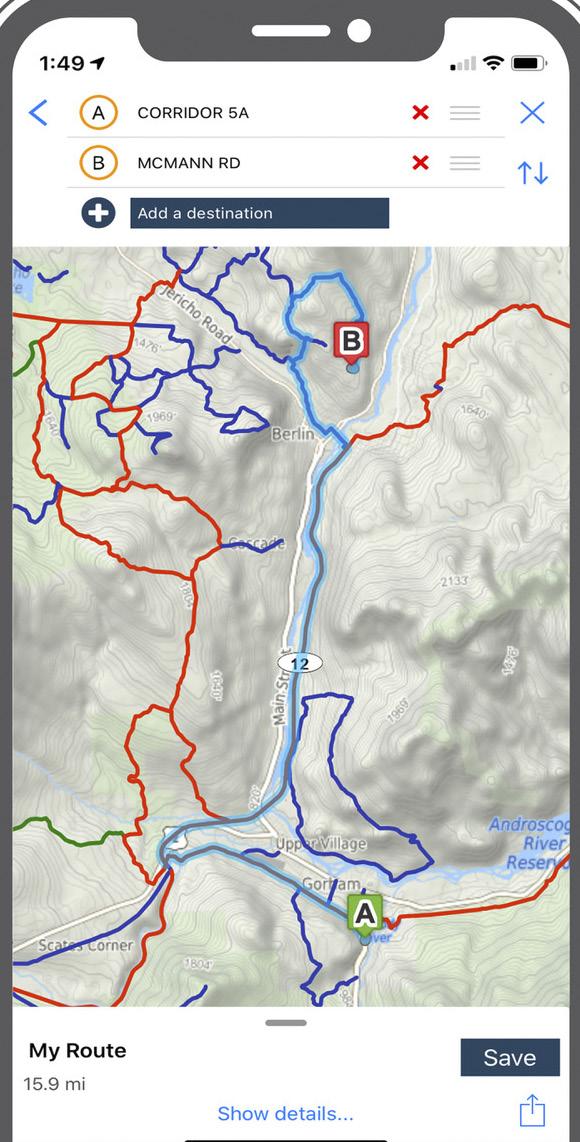

NH Snowmobile Trails 2022/23 season (iOS/Android, $4.99) • www.nhsa.com
The New Hampshire Snowmobile Association (NHSA) brings an enhanced version of its web application to your pockets, making for a better riding experience than ever. Working both with and WITHOUT mobile data coverage, you will be able to enjoy the app’s functionalities no matter where you are on the trails. This app gives you access to the following *OFFLINE* features, anywhere, anytime, even in areas without cell coverage:
• See your location on the map through your phone’s GPS signal
• View nearby restaurants, gas stations, hotels, parking, and other services

• Access the trails conditions as per the last data connection available
• See the distance between you and a specific point
• Quickly save and load itineraries
Check www.nhsa.com for additional information. Interactive Trail map: www.nhsa.evtrails.com
• New Hampshire uses successful public/private partnerships to provide 7,000 miles of snowmobile trails
• Last winter (2021-2022), there were 45,326 registered snowmobiles in NH.
• The majority of grooming and trail infrastructure (bridges, culverts, etc.) is undertaken by volunteers of NHSA clubs.
• Approximately 28,000 hours of club trail grooming takes place annually.
• Revenue derived from snowmobile registrations is used for trail maintenance, a user supported program.
• A 2011 Plymouth State Economic Impact Study indicated that snowmobiling contributes $586 million to the state economy. That equals $774 million in today’s dollars.
• The New Hampshire Snowmobile Association holds the annual “Race Into Winter” Grass.
• Drags and Water Cross is on Columbus Day Weekend in Fremont, NH. This is the one of the largest snowmobile events in the world and draws more than 47,000 spectators from the U.S. and Canada.
• Clubs from around the state have raised over $3.6 million for Easterseals. The NHSA Ride-In was initiated in 1972 and continues to fund Camp Sno-Mo to create life-changing experiences for campers, ages 11 to 21, with disabilities and special needs.
• The NHSA was founded in 1969.

Snowmobilers, just like skiers, are eager to get back on the trails this winter, especially after a lackluster spring season was cut short by less snow and milder temps. Extra planning has never been more important, as even a stop for lunch or a snack at a local eatery along the trail may not be available in the regular locations. Depending on where you choose to ride, things may be a bit more limited when you arrive, so be sure to plan ahead and choose your trails wisely.
As far as stickers go, all you need to snowmobile in NH is a state registration. They are available at over 200 locations throughout the state. NH snowmobile club members receive a $30 discount on each registration. A voucher can be obtained from a local club or the New Hampshire Snowmobile Association Club membership website, www.nhsa.com.
Join where you ride, support the clubs that maintain the snowmobile trails, and save a few bucks while you’re at it. It’s important to note that registration fees fund a significant portion of trail maintenance, covering grooming costs, signing, and bridge construction.
Over 200 trail groomers maintain the trail system in New Hampshire. Quality snowmobile trail grooming provides smooth trails that are suitable for all levels of rider experience. This accomplishes many goals: establish a trail base at the beginning of the season, reestablish a trail after heavy snowfall and/or winds have obliterated it, rework a heavily moguled trail back into a smooth surface, and general trail restoration.
Be aware that grooming takes place at all hours. A groomer travels at an average of only 5-8 miles per hour. Riders must use extreme caution at all times when on the trails and be on the lookout for groomers and other obstacles. Many of the grooming machines are exceptionally wide and long, so you need to give it the right-of-way. Always slow down when approaching a groomer and be prepared to stop.
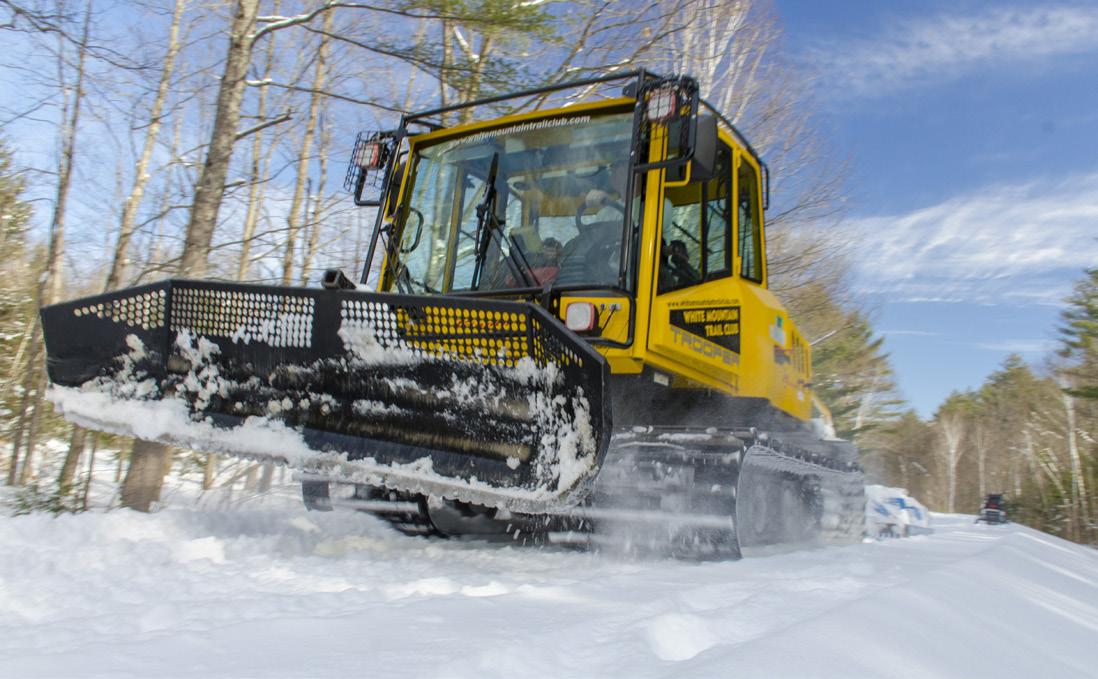
If you don’t already own a snowmobile, renting can be a good way to experience the adventure. There are a number of businesses in the Valley that offer guided tours by snowmobile or allow you to rent your own. Being prepared is key, and these outfitters will make sure you have all the information you need to experience snowmobiling safely. Remember to ride responsibly, dress for the elements, and plan for the ride ahead with a mapped route. Never ride off-trail unless an area is designated, or you have written landowner permission.
Northern Extremes/Mt. Washington Snowmobile Rentals, Bear Notch, Bartlett/Bretton Woods, NH www.nxtsnow.com • (603) 374-6000
Northeast Snowmobile & ATV Rentals, Gorham, NH/Fryeburg, ME www.northeastsnowmobile.com (800) 458-1348
Ossipee Valley Snowmobile Club West Ossipee, NH • www.ovsc.net
Scrub Oak Scramblers Madison, NH • www.sossc.com
Snoward Bound Snowmobile Club East Conway, NH • www.snowardbound.com
Mountain Meadow Riders North Conway, NH • www.mountainmeadowriders.com
Burnt Meadow Snowmobile Club Brownfield, ME • www.burntmeadowsc.org
White Mountain Trail Club Bartlett, NH • www.whitemountaintrailclub.com
Presidential Range Riders Gorham, NH • www.presidentialrangeriders.org
White Mountain Ridge Runners Berlin, NH • www.whitemtridgerunners.com
Twin Mountain Snowmobile Club Twin Mountain, NH • www.twinmtnsnowmobile.org
White Mountain Snowmobile Club Lincoln, NH • www.whitemtsnowmobileclub.org
State of New Hampshire Snowmobile Clubs www.nhstateparks.org/activities/snowmobiling/club-information
Weekly trail conditions report www.nhstateparks.org/activities/snowmobiling/ trail-information.aspx
The New Hampshire Snowmobile Association www.nhsa.com
The Maine Snowmobile Association www.mesnow.com
New England snow depth map www.weather.gov/nerfc/snow_depth_im
NH Snowmobile Interactive Map and Phone App www.nhsa.com/nh-snowmobile-trail-map
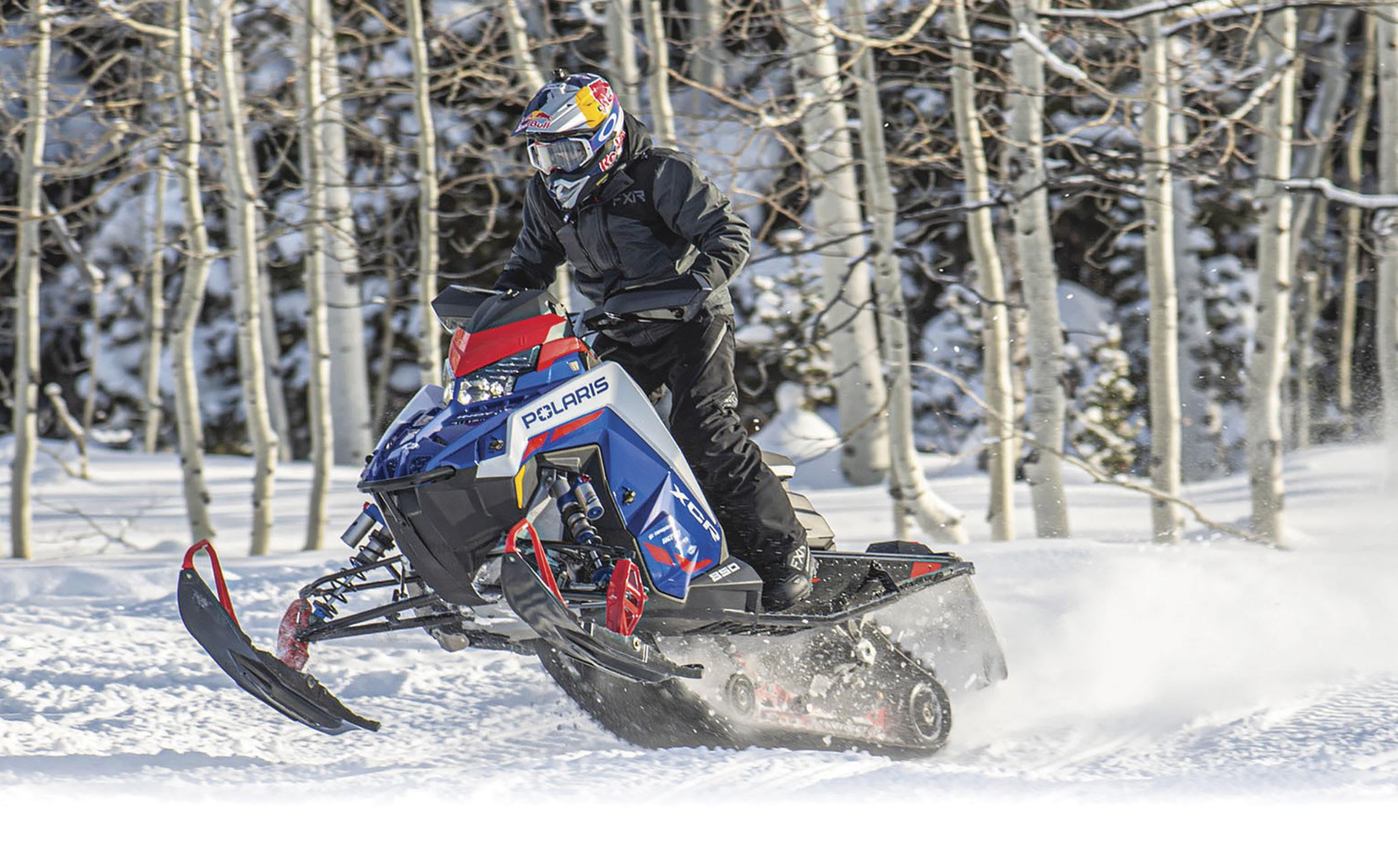





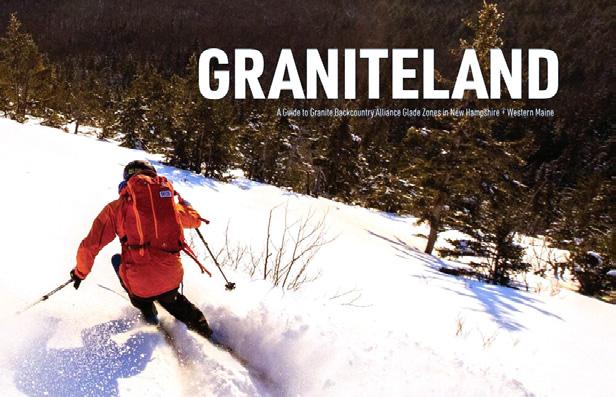

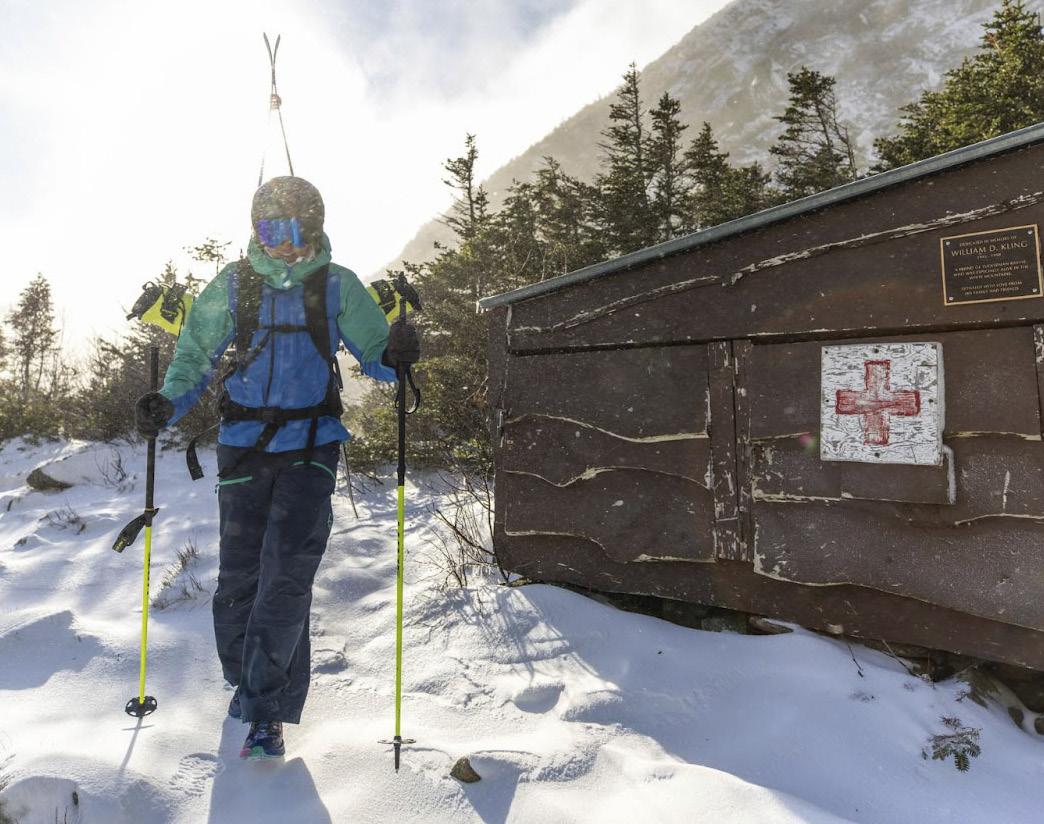
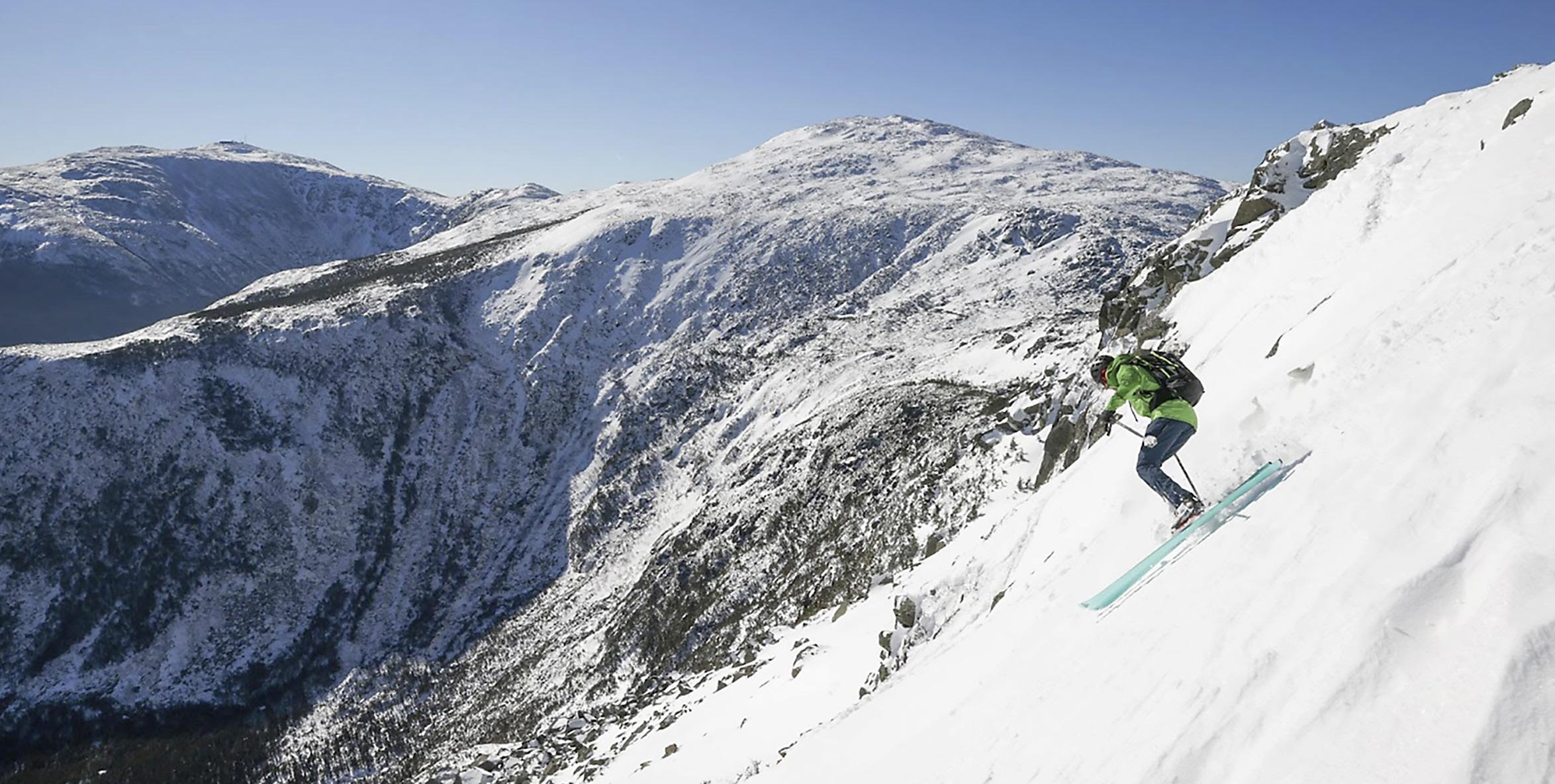
 By Andrew Drummond
By Andrew Drummond
Every year we look for the best gear to improve our experience in the backcountry. This could be a new piece of gear that was missing from our pack list or a replacement for our current gear. Since our climate is so dynamic, our pack list must also cover a wide range of needs. Here are some items to consider for your next trip into the mountains.
Base Layer T-Shirt: It all starts here–the layer that isn’t going to leave your body until that evening or the next day. Don’t skimp on the base layer. We love a t-shirt because it’s minimal, and long sleeve shirts can run hot. Merino is high performing, wicks away moisture, and doesn’t stink. This is an item that often needs to be replaced every other season.
First Aid Kit: Safety should always be at the top of the list on planning any trip into the mountains. We always carry small medical kits that include the essentials, such as bandages, splinting materials, and a clotting gauze. There are some pre-made kits, which can be a nice starting point, but we like to build out our own.
Coffee (Hot Beverage) Thermos: A sip of hot coffee, broth, or sports drink can make those sub-zero mornings a bit more tolerable. We are slightly biased to our own coffee roasted here in the shop.
Physical Map/Guidebook: Maps and guidebooks are a great way to get inspired and plan for your next trip. There are now a handful of excellent backcountry skiing guidebooks for the White Mountains, along with waterproof trail maps highlighting popular ski lines. It may seem old-school to have a physical map in your pack, but is much easier for you and your ski partners to all view and get on the same page.


Chris Wilke, top to bottom, with all the down clothing he could find (-20ºF this day).


Goggles: We are huge fans of goggles with magnetic lenses that are easy to swap out when conditions change. We’ve tried the color change lenses, but nothing is as good as grabbing the right lens for the moment, especially if you fog up a pair. We went out and had our own goggles made, and have lens options for every condition.
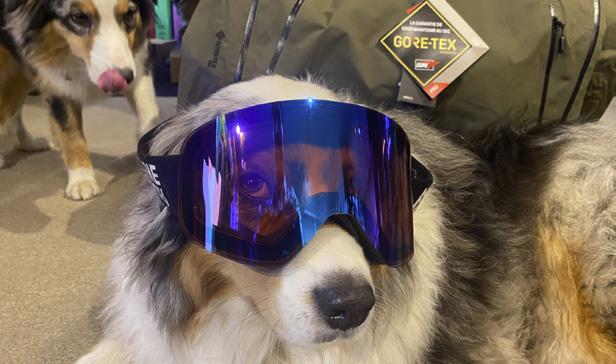
Down Jacket: Every time we go into the backcountry, even on hot spring days, we always bring a warm layer. There really isn’t a substitute for a down jacket—and they are light and more packable than ever. Look for something in the 800-fill range that will work for the coldest days and something that will compress nicely into a small stuff sack.

Garmin Inreach Messenger: Our new favorite personal locator beacon was just released, and we’ve been testing it this fall. Having an open line of communication while in the backcountry is now commonplace, and could be essential for activating an emergency response plan. The messenger has an improved antenna and has a battery life that will last for multi-day trips without a problem.
Ski The Whites is a backcountry ski shop located in Jackson, NH. They offer rentals and season-long leases for all the gear sold in the shop. Learn more at www.skithewhites.com and be sure to check out the and be sure to check out their fresh roasted coffee.
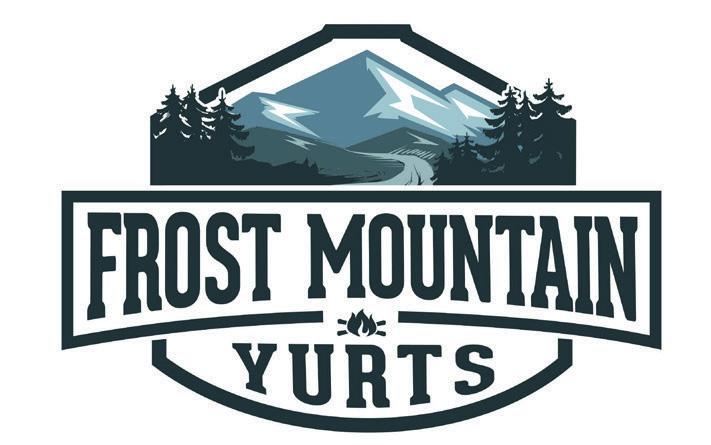
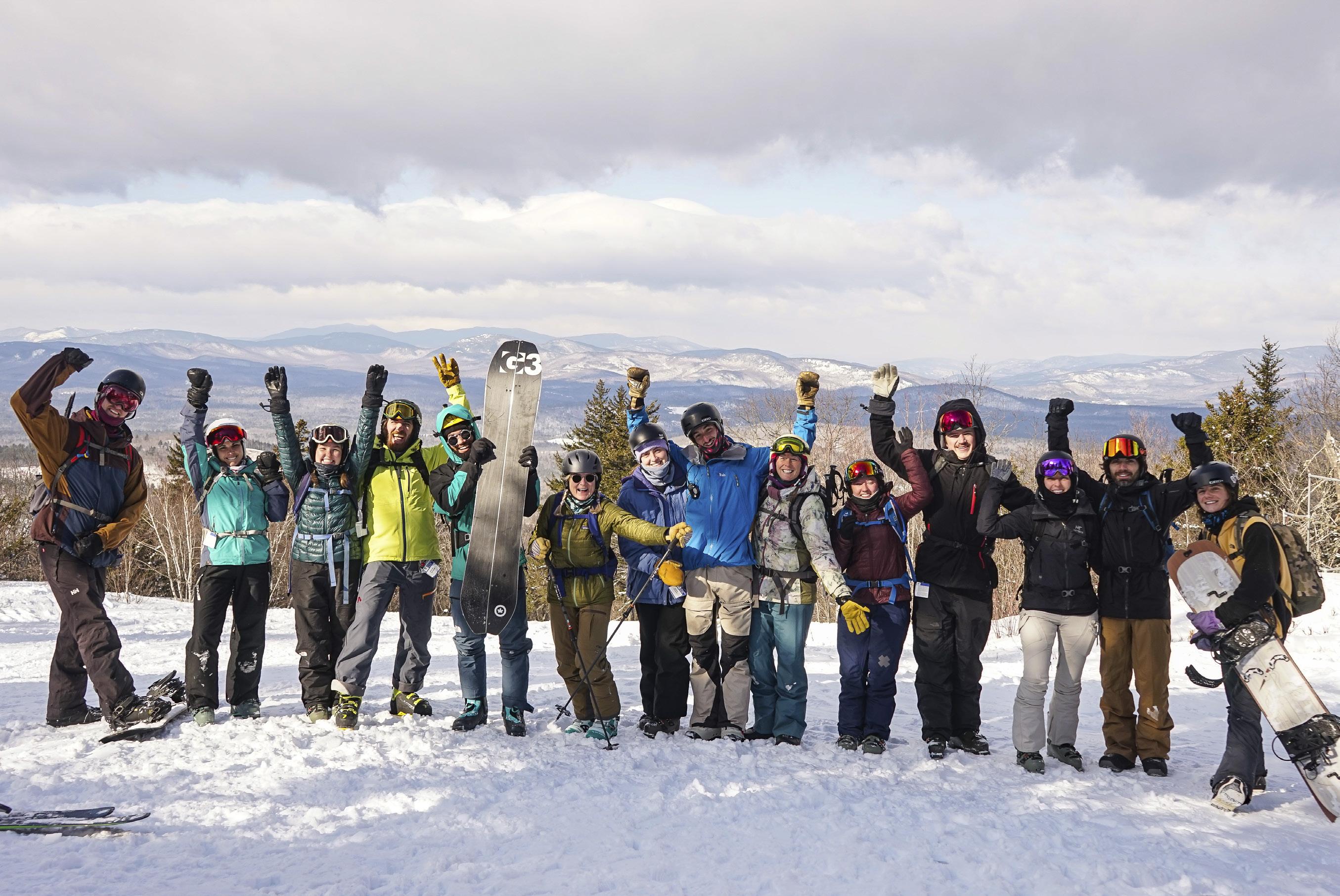
As the popularity of ski touring in the Mt. Washington Valley, and throughout the region, continues to gain popularity, opportunities to learn the fundamentals have also gained momentum.
Often referred to as “skinning,” “alpine touring,” or “backcountry skiing,” ski touring is a type of skiing where people hike uphill with their skis before skiing down, a challenging and fun activity that is deserving of the phrase “earn your turns.”
The snowboarding equivalent is called split-boarding, aptly named for how the snowboard is split lengthwise turning it into two ski-like boards for the ascent. Uphill travel is accomplished using special bindings and “skins.” The touring-specific bindings allow the heel of the boot to detach for uphill walking
and then lock down for the descent. Skins have a sticky adhesive side that allows them to temporarily adhere to the ski. The flipside is covered in short, directional hairs that allow the ski to be propelled forward while gripping the snow to prevent the ski from slipping backward.
Inclusive Ski Touring, a newly founded 501(c)(3) non-profit, is taking strides towards making ski touring and split-boarding more accessible. The organization’s mission is to “develop an inclusive uphill community through organized group programs.” Inclusive Ski Touring is breaking down the misconceptions about the ability needed to ski tour, providing a place for people to ski tour at little to no cost to the individual, and creating a welcoming, learning environment. According to Zach McCarthy, founder of Inclusive Ski Touring, “Touring is something achievable for anyone of any ability level. It can be as simple

as taking a walk up the powerline hill in your town and skiing back down, or as intense as going up Mount Washington to ski avalanche terrain, mid-winter. You don’t need to be an expert at the downhill; all you need is a desire to get out and adventure.”
During the winter of 2021, McCarthy had just transferred from Suffolk University to the University of Southern Maine (USM). Working fulltime in a ski shop and taking classes at USM, he saw a need for community touring programs and began organizing group tours through social media, offering for anyone to join. The gatherings provided opportunities for people to meet others in the ski touring community, try ski touring, ask gear questions, and for McCarthy to share his passion with others.
The community rallied for participants who did not have access to skis or boots, and found equipment to lend out
for the day. Word of the get-togethers spread, and soon McCarthy organized more formally by setting up a website and an email list. This is when the organization of “Inclusive Ski Touring” was truly born, and they partnered with Mount Abram for a consistent and supportive venue. The total group tours during the first unofficial season added up to over 200 participants. Recognizing the success of the program and seeing the true potential of the concept, McCarthy worked over the summer to register Inclusive Ski Touring an official non-profit organization, successfully achieving the 501(c)(3) status by the IRS in July of 2022, backdated to June of 2021.
Newly established as a non-profit, Inclusive Ski Touring enjoyed a successful first season and hosted several programs, including a Women’s Program, a Diversity, Equity and Inclusion-Focused Program, Future Generations Program, and Intro
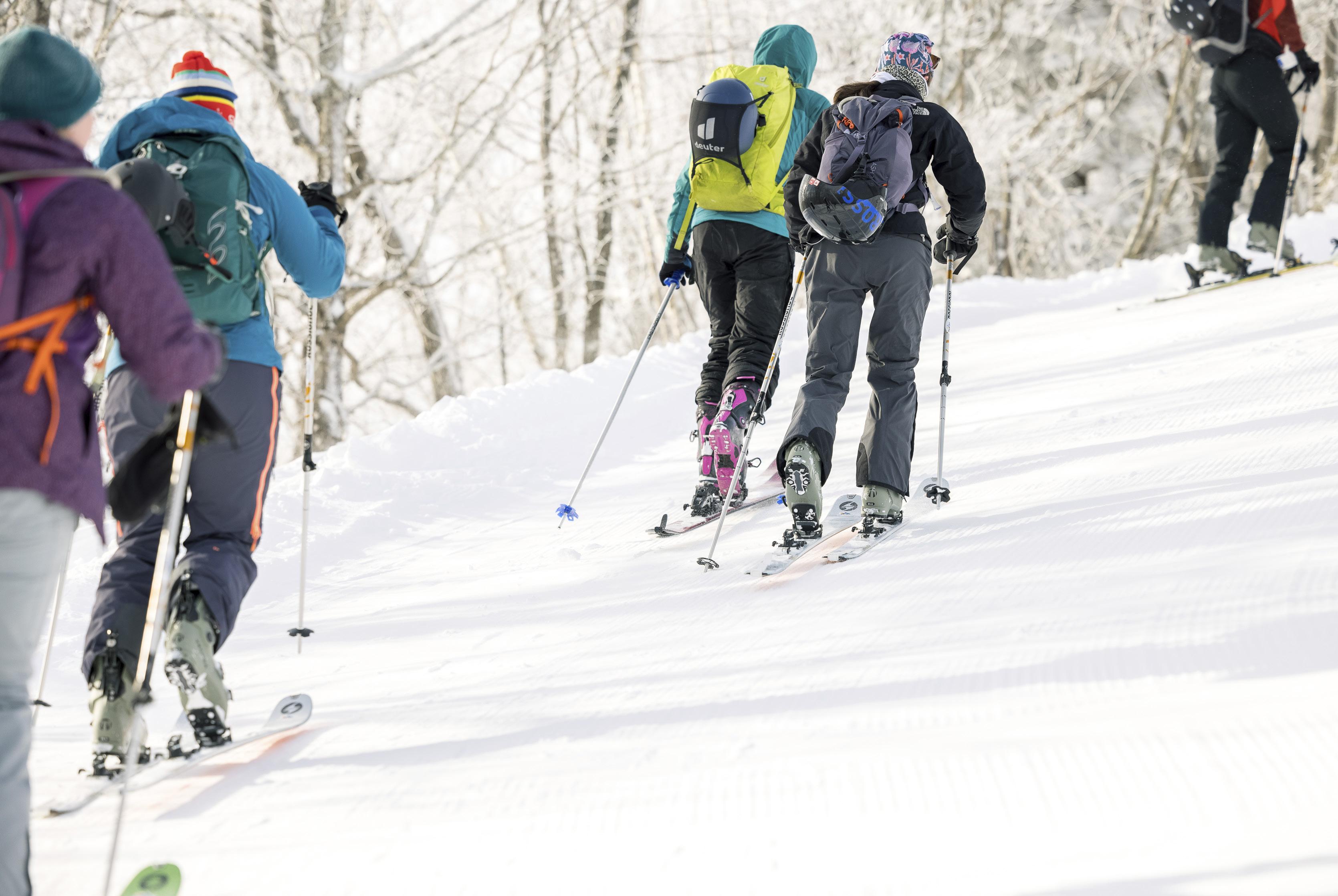
to Backcountry Touring Program. Recognizing the lack of diversity throughout the outdoor industry and striving to help work towards a better future, Inclusive Ski Touring has been engaging with partner organizations such as Outdoor Afro and The Kindling Collective as part of their Diversity, Equity, and Inclusion (DEI) efforts [SP1] to work to provide underrepresented individuals the chance to get out ski touring and/or split boarding at little to no cost for the individual. The vibrant, friendly atmosphere paired with their supportive, encouraging leaders transforms the slightly nervous but excited participants into confident, empowered skiers.
Connecting like-minded individuals at the group tour level also fosters genuine friendships amongst participants. In total, the 2021/22 season attracted over 500 participants, and with its strong momentum, they are hoping this coming
winter brings even more growth and participation.
Equipped with its own rental fleet for 2023, Inclusive Ski Touring will be able to expand access with traveling tour dates, including several in the Mt. Washington Valley. The first Inclusive Ski Touring Intro to Backcountry Program was held in late February 2022 as a part of the Mt. Washington Backcountry Ski Festival. The goal was to create a program where participants could learn the core backcountry knowledge needed to get out and recreate in non-avalanche terrain safely and know their next educational steps based on their backcountry journey.
A group of 13 people participated in a group tour on the John Sherburne Ski Trail to learn about reviewing the weather forecast, ski touring trip planning, skinning techniques, and best practices in the backcountry. The program was a success and allowed people to safely and
To maximize success of upcoming tours, IST has partnered with Northeast Mountaineering, Synott Mountain Guides, and Acadia Mountain Guides.Photo by Katherine Jorndo
comfortably leave the confines of resort skiing to explore the backcountry.
This coming winter, the Intro to Backcountry program will be back for six days in the Mt. Washington Valley. The locations will be weather dependent, but are likely to be held at places such as the Sherburne Trail, Doublehead Ski
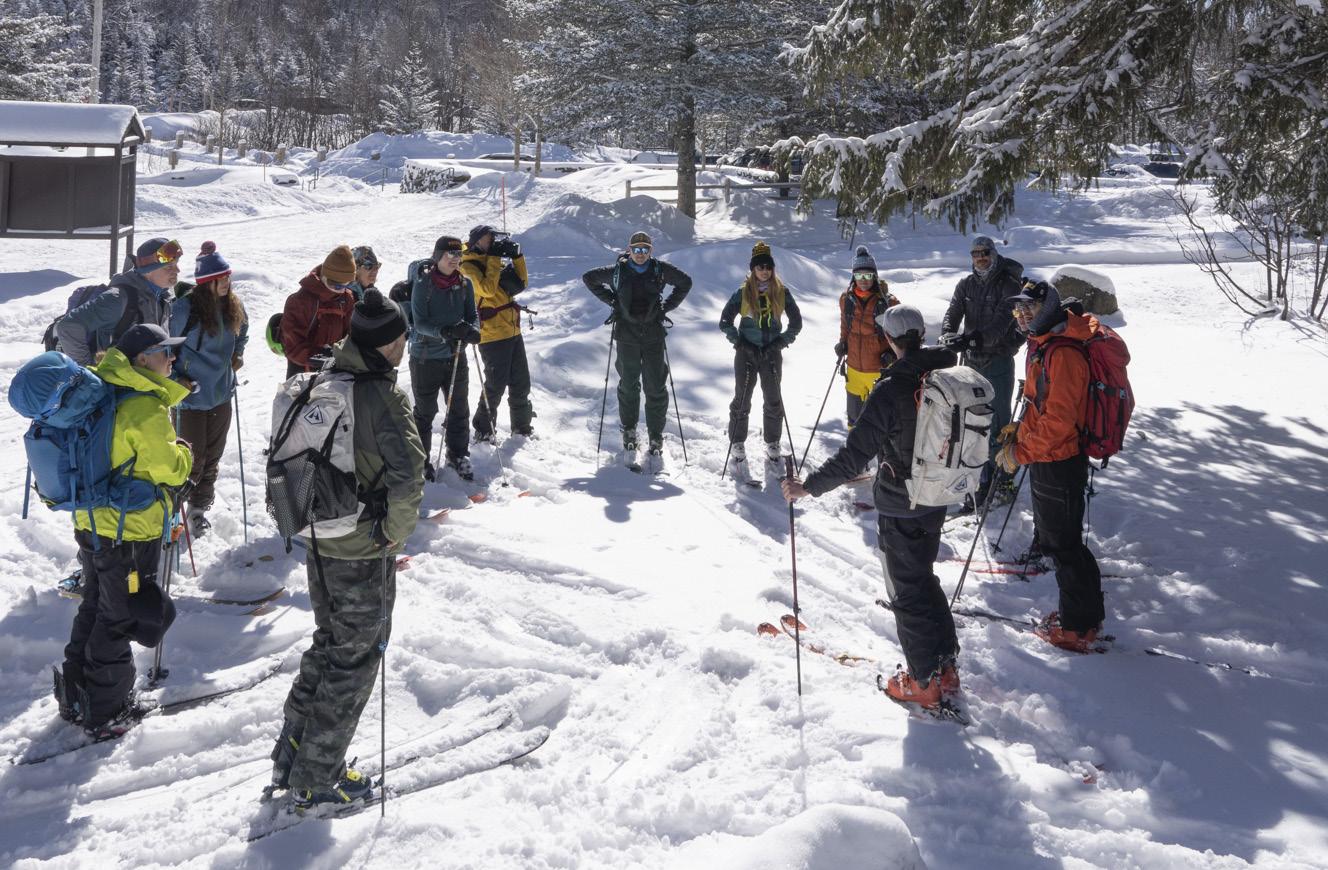
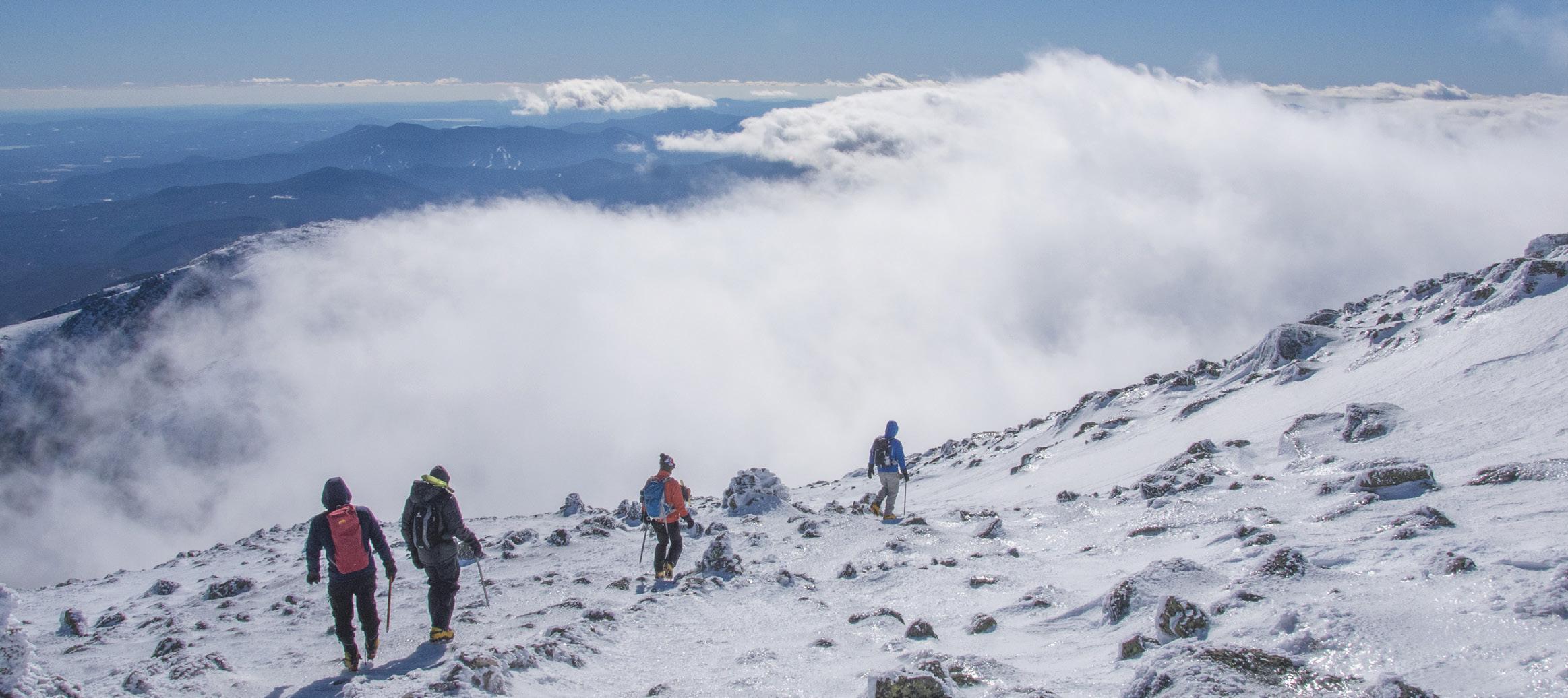
Trail, Maple Villa Glade, and lower-angle areas. To maximize the impact and ensure overall success, each of these tours will be hosted in partnership with a local guide organization. At this time, IST has partnered with Northeast Mountaineering, Synott Mountain Guides, and Acadia Mountain Guides to make these possible.
Saturday, January 14
Saturday, January 28
Saturday, February 11
Saturday, February 25
Saturday, March 11
Saturday, March 25
The location is subject to weather, but will include the John Sherburne Trail, the Gulf of Slides Ski Trail, Double Head Ski Trail, and local GBA Glades. Check www.inclusiveskitouring for updated information.

As an organization, Inclusive Ski Touring strives to create opportunity and help build the path toward a more diverse and inclusive ski industry.
For information about tours this season or to find out how to help support their mission, visit www.inclusiveskitouring.com.
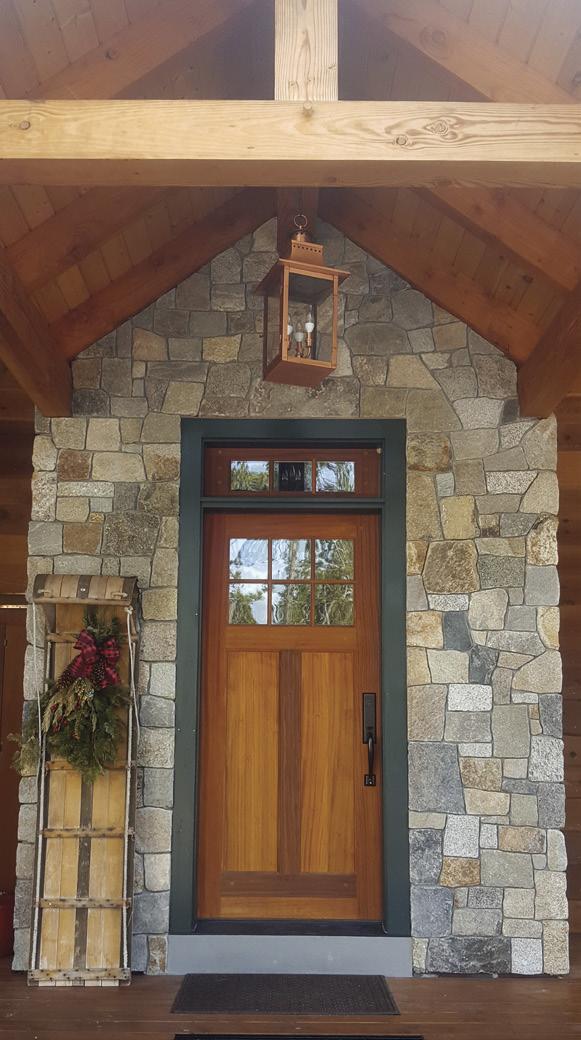
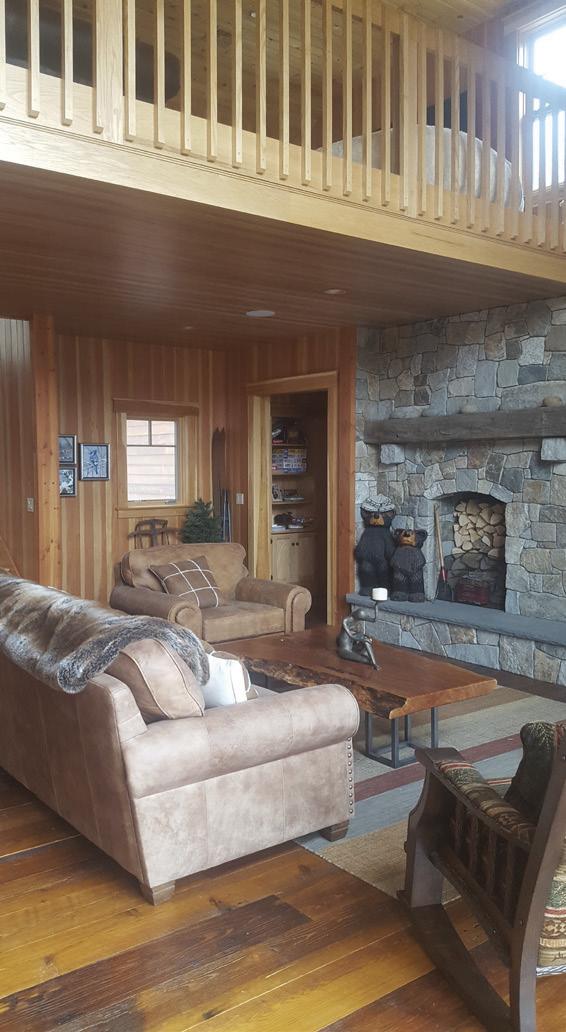


These local nonprofits support gathering and broadcasting critical weather and safety information, develop and maintain the backcountry zones, and support search and rescue efforts in the region.


Mount Washington Avalanche Center www.mountwashingtonavalanchecenter.org
Granite Backcountry Alliance www.granitebc.org
White Mountain Avalanche Education Foundation www.wmaef.org
Mount Washington Volunteer Ski Patrol www.tuckerman.org
Mountain Rescue Service www.nhmrs.org
Androscoggin Valley Search and Rescue www.avsarnh.org
Appalachian Mountain Club NH Chapter Ski Committee www.amc-nh.org/committee/ski
Mount Washington Observatory www.mountwashington.org
In the U.S., avalanches kill 25 to 30 people, and injure many more, each winter. Sixteen people have been killed in the White Mountain National Forest (WMNF) by avalanches in the last 70 years, with many more injured from long sliding falls initiated by small avalanches. Anyone skiing, hiking, or climbing in the winter should be aware of avalanches: what they are, how they form, where they occur, and how to avoid them.
An avalanche is a mass of snow moving down a slope. Some days are dangerous, and some days are not; learning about avalanches will help you decide when, where, and how to safely visit the backcountry in winter.
Where do avalanches occur in the WMNF?
Anywhere with steep slopes covered with snow and few or no trees. The east-facing ravines in the Presidential Range generally produce the largest avalanches and with the greatest frequency, but avalanches can and do occur in other areas as well.
When do avalanches occur in the WMNF?
Most, but not all, avalanches occur during or within days after snowfall weather events. Even a few inches of snow can be collected by the wind and form large snow drifts capable of producing an avalanche.
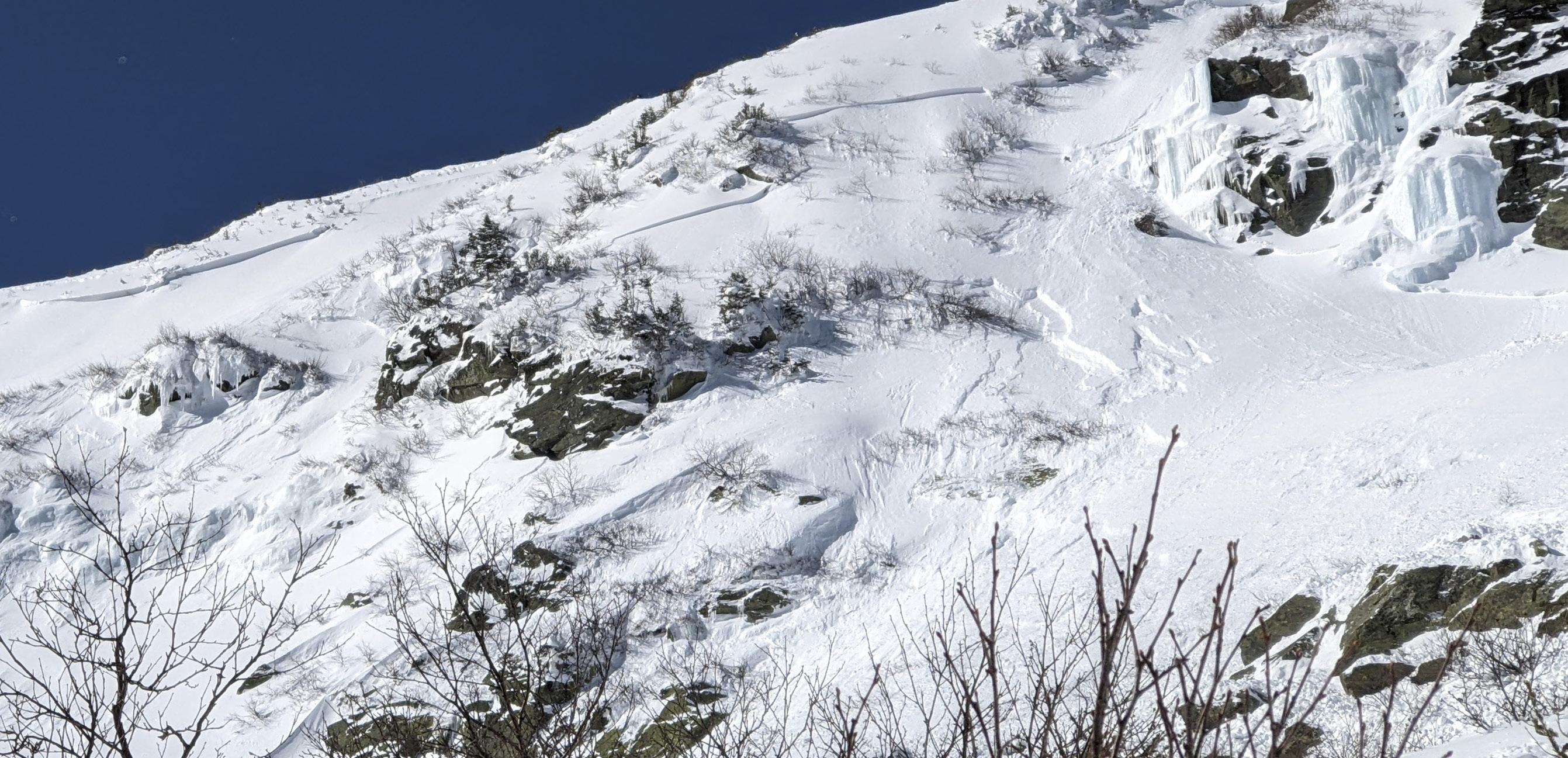
Get the Avalanche Forecast: Avalanche forecasts provide an assessment of the avalanche danger and associated snowpack conditions, including some general travel advice you can use to help plan your day. Remember, the avalanche forecast is only a starting point; you control your own risk by choosing when, where, and how you travel.
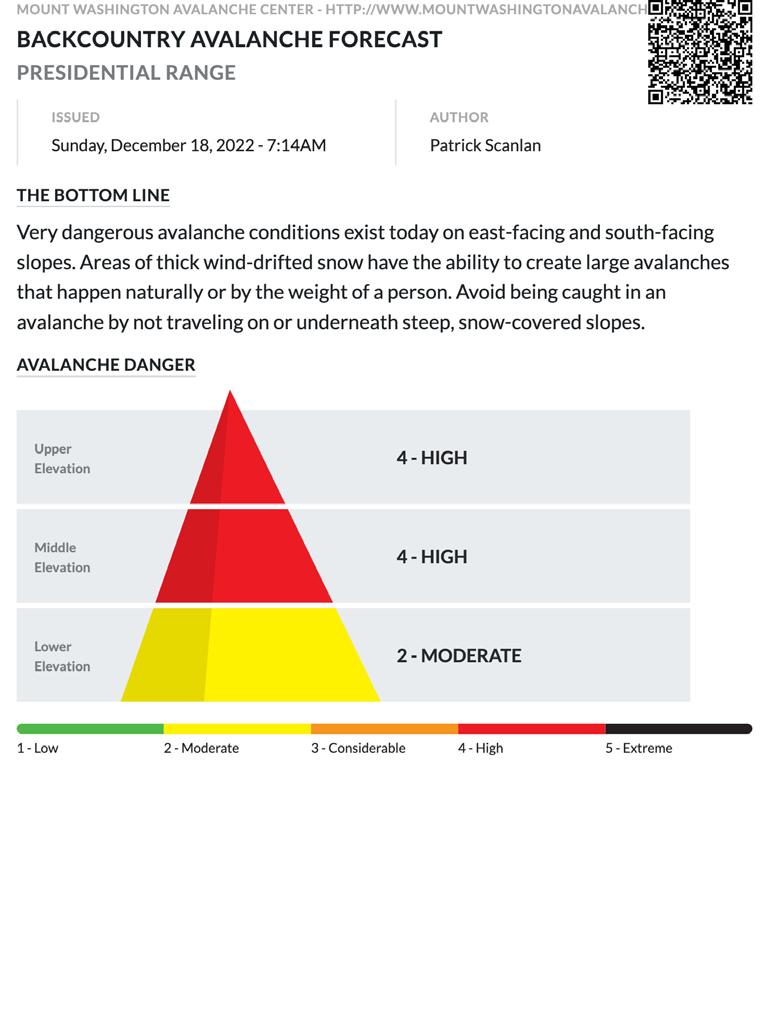
You can find the daily avalanche forecast for the Presidential Range and Crawford’s Notch from the Mount Washington Avalanche Center at www.mountwashingtonavalanchecenter.org.
Once snow begins to pile up, the daily avalanche forecast is published every day by 7a.m.
Additionally, if you see a USFS Snow Ranger in the field, stop and say hello. We love to talk about the forecast and answer any questions about the snowpack. Look for us wearing green Forest Service jackets on and around Mount Washington.
I DON’T WANT TO BE HURT IN AN
WHAT CAN I DO TO PROTECT MYSELF?
PHOTO LEFT: March 4, 2022. Skier-triggered avalanche in Tuckerman Ravine. Several consecutive days of localized snow showers and light wind speeds created a new snow layer that was poorly adhered to the underlying snow. The added weight of a skier was enough to trigger the slide. With luck on his side, the skier was pushed out of the sliding snow, avoiding injury.
Avalanche Courses in MWV Enrolling in an avalanche course and hiring guides for a day in the mountains is the best way to improve your skills, knowledge, and safety. Below is a list of guide services that operate in the Mt. Washington Valley and offer avalanche education courses and guided instruction.
International Mountain Climbing School www.ime-usa.com/imcs
Synnott Mountain Guides www.newhampshireclimbing.com
Northeast Mountaineering www.nemountaineering.com
Mooney Mountain Guides www.mooneymountainguides.com
Eastern Mountain Sports Schools www.emsoutdoors.com
East Coast Avalanche Education www.eastcoastavalancheeducation.com
The Eastern Snow and Avalanche Workshop www.esaw.org
Mount Washington Avalanche Center www.mountwashingtonavalanchecenter.org
Acadia Mountain Guides Climbing School www.acadiamountainguides.com
Mountain Shadow Adventures www.mtnshadowadventures.com
Chauvin Guides International www.chauvinguides.com/avalanche-programs
Get the Gear:
Avalanche rescue gear won’t prevent you from becoming caught in an avalanche, but can help save your life, or the life of your partner, if caught and buried in an avalanche. If you make the choice to enter avalanche terrain, everyone in your party should carry an avalanche transceiver, avalanche probe, and a shovel—and have the skills needed to use them.
Get the Training: Hiking, skiing, or climbing in avalanche terrain is more fun when you know how to recognize the danger, how to travel safely, and perform a quick rescue if needed. Enrolling in an avalanche course and hiring guides for a day out in the mountains is the best way to improve your skills, knowledge, and safety.
For additional information, visit www.mountwashingtonavalanchecenter.org

Acommunity is not held together by one place but by the shared values, goals, and interests of its members. Here in Mt. Washington Valley, there’s a vibrant community built around a shared passion for backcountry skiing. The reward of putting in the work to get to incredible terrain, and the connection felt with the land you travel on, isn’t something you get at a resort. There’s so much more to the culture and lifestyle of backcountry skiing after you take off your gear. From stewardship to youth development and career opportunities, the backcountry culture has become part of the Valley’s DNA.
Mt. Washington Valley is blessed with a rich ski history; Hannes Schneider, dubbed the father of modern-day skiing, came to North Conway with his family in 1939 to escape Nazi Germany and made the town an important center of the international ski world. There is also a deep heritage of skiing, from the first descent of Mount Washington’s Tuckerman Ravine in 1914, to the ski trails developed by the Civilian Conservation Corps (CCC) in the 1930s. With the introduction of mechanical lifts, many of these beautiful, secluded trails became abandoned, and

New Hampshire’s human-powered backcountry skiing options became largely relegated to either expert terrain in the steep peaks of the Whites, or glades that skiers would cut for themselves on their own property, or at times, someone else’s (often without permission).
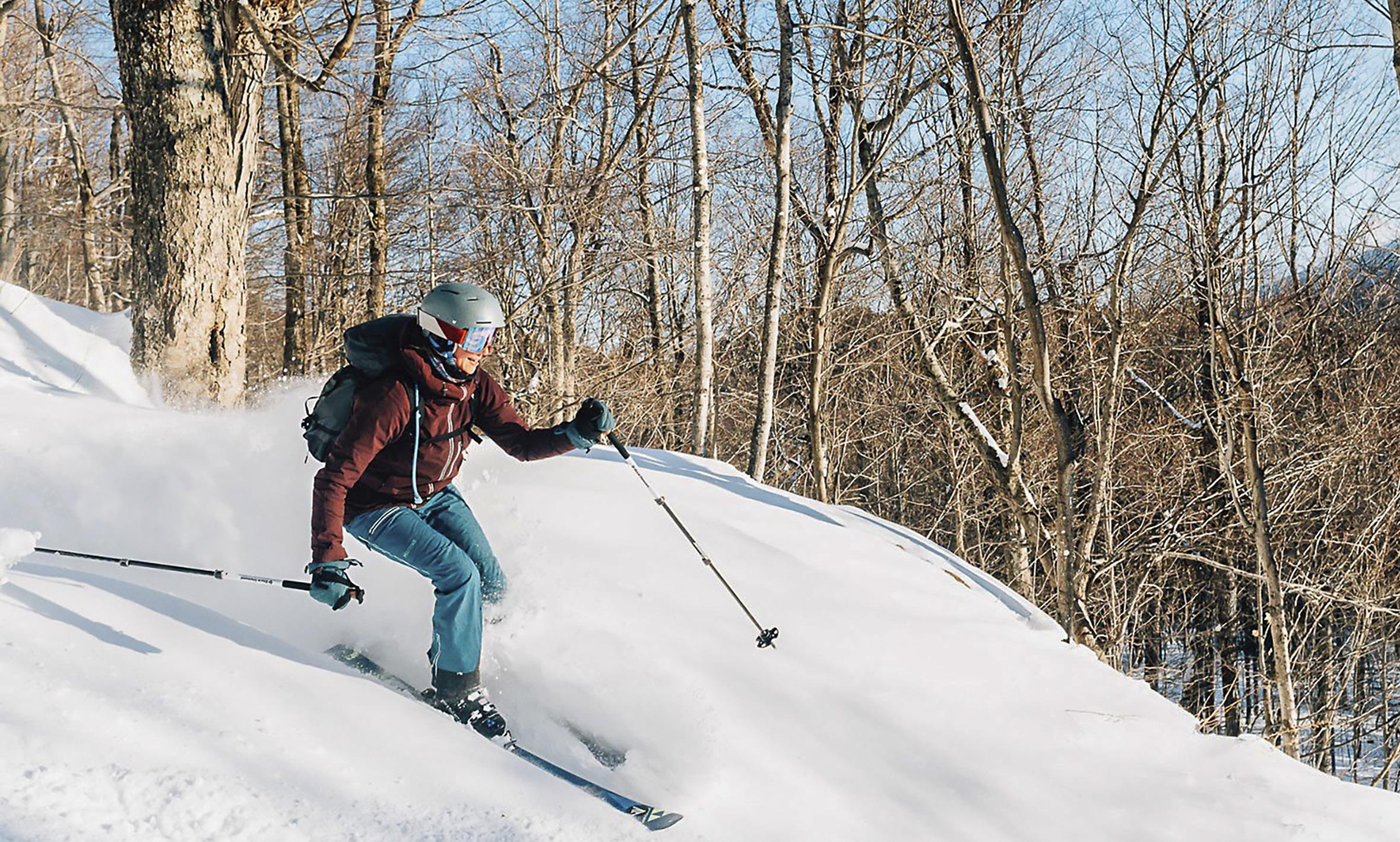
As ticket prices grew at modernized alpine resorts—and with the emergence of lighter backcountry gear and more interest in exploration out of bounds—backcountry skiing has resurged, and is now the fastest-growing segment of the ski and snowboard industry. To make backcountry skiing more accessible, and to broaden its impact on local communities beyond solely recreational purposes, several organizations in and around Mt. Washington Valley have developed programs, events, and resources catered to the backcountry movement and the emerging outdoor economy.
Seeing a need for a community-oriented backcountry ski group
with more accessible terrain, Granite Backcountry Alliance (GBA) was formed in 2016 as a connector and convenor for those who want more than just to ski—they want to be part of the movement that instills stewardship and personal responsibility in the backcountry for generations to come. GBA aims to support a local community around backcountry skiing in New Hampshire and Western Maine by providing low-impact, human-powered backcountry skiing opportunities to the public through the creation, improvement, and maintenance of ski glades. With over 1,200 members, GBA created “Graniteland,” a network of 11 below-treeline glade ranches (the Graniteland term for a glade zone) and four historic CCC trails. In the fall, hundreds of volunteers head to glade ranches to take care of the spaces they will be recreating on come winter—and the network is growing every season.
Glade creation is not the only goal of GBA. It improves the foundation of the sport through partnerships with public and private landowners, safety education, and creating a unified
culture of respect for the environment and other skiers on and off the trail. That’s why GBA developed Ski Kind with Winter Wildlands Alliance. This backcountry responsibility code promotes a commitment to lead with your best self in the skin track, around the parking lot, up on your local mountain, and in the greater community to keep the backcountry open, inclusive, and protected.

GBA has implemented specific initiatives as part of the Ski Kind program to address the needs of our backcountry community in northern New England. The Ski Kind Trailhead Ambassador Program offers volunteers the opportunity to foster positive experiences at the glade ranches and enhance the backcountry responsibility code. Volunteers set up at the base of glade ranches on Saturday and Sunday mornings in the winter, ensur-
ing folks park appropriately, offering information on the terrain, and promoting leave-no-trace principles. Program perks include a GBA membership, free products from GBA, and an annual volunteer grand prize raffle. If you’re interested in joining the Ski Kind Trailhead Ambassador Program, visit www.granitebackcountryalliance.org/ski-kind-parking-ambassadors.
Introducing young skiers and riders to the backcountry is key to continuing our community’s longstanding commitment to human-powered, low-impact recreation. The New England Ski Museum brings the living history of skiing to 4th graders in Carroll County. Every year, students participate in the reenactment of Hannes Schneider and his family at the North Conway station and
spend the day learning about the past, present, and future of skiing in the area. In 2022, GBA was invited to incorporate a backcountry component, introducing students to the sport, as well as highlighting the jobs that are available in the ski industry and the broader outdoor economy. Each student takes what they learned from the experience to create a specialized project related to the history and innovations of skiing and their personal interests, which are presented in December at a community showcase.
The Mt. Washington Backcountry Ski Festival, the largest backcountry ski expo in the Northeast, offers a four-day backcountry experience with courses for all abilities and ages led by top guides around the region. This includes a two-day backcountry course designed specifically for teens with training in off-piste ski skills, avalanche education, and ski mountaineering. Experiencing the backcountry with their peers, middle and high school students develop skills in leadership, problem-solving, communication, risk management, and teamwork. The course is developed and led by CVA Backcountry, the first ski-academy-level program in the United States where young athletes can be immersed in the backcountry environment, learn skills that enhance personal development, and refine technique for a lifetime of achievement and love in the mountains.
A crucial part of youth development in the backcountry is making the sport accessible and welcoming to families. GBA offers a value-driven family membership to enhance the backcountry experience that includes discounts to partner brands, weekly newsletters, and events with activities tailored to young athletes. The glade ranches are designed to have varied terrain for all levels of skiers, and GBA’s Graniteland guidebook is an excellent resource for families to learn about backcountry skiing and the glade ranches together. And what better family experience than cutting glades in the fall and skiing them in the winter? GBA encourages families to join fall glade days, which instill a sense of ownership and empowerment to share in the wealth of outdoor assets and the responsibility of protecting those assets for generations to come.
The backcountry community is a great avenue for those looking to explore a career in the outdoors. This is exemplified through the OUTDOOR OFFICE program, developed by Granite Outdoor Alliance, a statewide business alliance with over 100 member organizations, plus passionate outdoor enthusiasts who support the growth of the outdoor economy. The goal of OUTDOOR OFFICE is to provide a snapshot experience of the adventure profession, whether a participant is interested in changing their profession to fit their passion, or just learning new skills
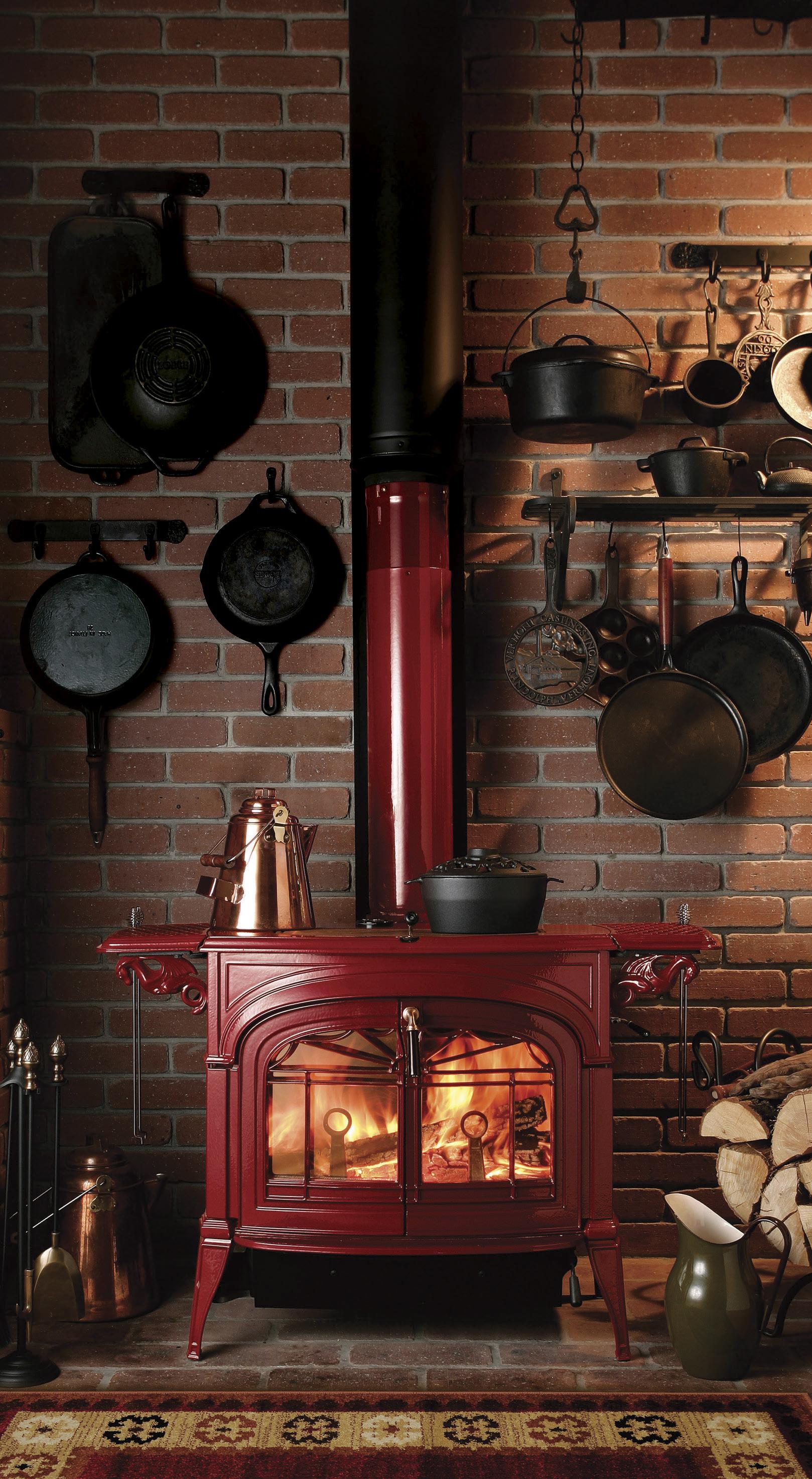
as an outdoor hobbyist. Hosted at the Mt. Washington Backcountry Festival, OUTDOOR OFFICE seeks to provide exposure to adventure professions, including journalism, videography, mountain guiding, photography, and more.


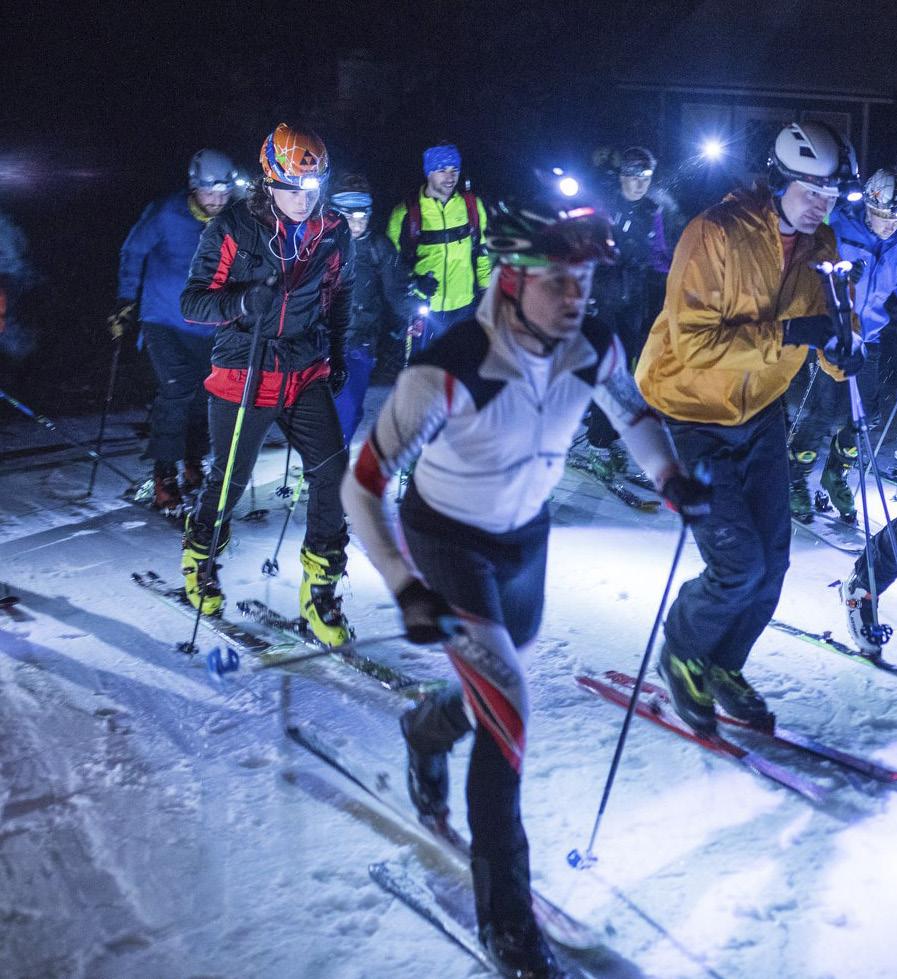
Participants have the opportunity to learn from the industry’s most prominent instructors, such as Backcountry Festival and Synnott Mountain Guides founder Mark Synott—who also happens to be a New York Times bestselling author and veteran of the North Face athlete team. Synnott, together with the other OUTDOOR OFFICE instructors led by Joe Klementovich (photography) and Thom Pollard (videography), lead the Pitch to Publication program, starting with a class assignment that requires elements of all three mediums. Aspiring journalists, videographers, and photographers form teams to develop and pitch a multimedia story, based on a topic of their choosing related to the festival, to a professional publication. By tapping into creative storytelling and business skills, participants give
M.W. Otto Rhode Memorial Skin & Ski
January 28, 2023 | Mt. Washington Auto Road
The Mt. Washington Auto Road has a long history of racing to the summit of Mount Washington in every season. The M.W. Otto Rhode event is a day dedicated to the first ascent of the mountain and is the only day of the year that skiing is allowed on the Auto Road with alpine or snowboard equipment. The race, led by Ski the Whites, proceeds as far up the road as weather allows, offering a 4,618-vertical-foot climb that can be taken at a competitive or leisurely pace. This event is a fundraiser for the 501c(3) nonprofit Granite Backcountry Alliance. Tickets go on sale at midnight on December 31 and typically sell out within 24 hours. Visit www.granitebackcountryalliance.org/otto.
Mt. Washington Backcountry Ski Festival
February 9-12, 2023 | Pinkham Notch
The main event of the backcountry skiing community in the Northeast is the Mt. Washington Backcountry Ski Festival, which offers guided tours, skill-building clinics, yoga sessions, gear and equipment demos, friendly competition, live music, and vibrant après parties. Entering its sixth year, the festival is hosted by Synnott Mountain Guides and Backyard Concept. Visit www.skimtwashington.com.
depth and meaning to their projects while working under the pressure of a deadline—simulating the experience of working for a top outdoor industry publication. Last year, participants successfully pitched and landed two articles in the Conway Daily Sun focused on diversifying the outdoor industry and inclusiveness in the ski community.
Aspiring adventure professionals can also put their skills to the test by entering the Diamond 48, a 48-hour film competition to hone in on camera, storytelling, decision-making, and stress-management skills to prepare for a unique debut at the backcountry ski festival. The winner takes home a $1,000 cash prize, and all competitors take with them a new addition to their portfolio and a fast-paced, adrenaline-fueled experience that will stand out on a resume and for future job opportunities. Last year, the winning film was created by CVA backcountry team member Kai Glidden and featured a short documentary of women in the backcountry.
Last Skier Standing | February 10
Black Mountain of Maine | Rumford, ME
One of the most unique uphill ski events in the country, racers compete to see just how long they can go. Organized by the Ski the Whites crew, competitors take off each hour for a lap on Black Mountain’s 1.1-mile, 1,000-foot vertical uphill route. The race concludes when the “Last Skier Standing” shows up at the start line. In 2022, Brody Levin from Salt Lake City took the prize by skinning and skiing for 65 consecutive hours. Visit www.skiblackmountain.org/list-of-events/last-skier-standing.
The season finale of the backcountry season is the Wild Corn Shindig. The crew from Granite Backcountry Alliance leads a three-day mountain takeover at King Pine Ski Area, shutting down all lifts and creating a backcountry resort for the weekend. Celebrate the transition from winter to spring with sweet corn bumps, demos, gear sales, funky costumes, live music, activities, and more. Lodging deals are available all weekend. Wild Corn is a great introduction for anyone interested in getting into human-powered skiing and riding—the perfect mix of hot laps and the best basecamp party of the year!
Visit www.granitebackcountryalliance.org/wildcorn.
The goal of OUTDOOR OFFICE is to provide a snapshot experience of the adventure profession, whether a participant is interested in changing their profession to fit their passion, or just learning new skills as an outdoor hobbyist.Granite Backcountry Alliance photo Granite Backcountry Alliance photo Mike Bresnan photo

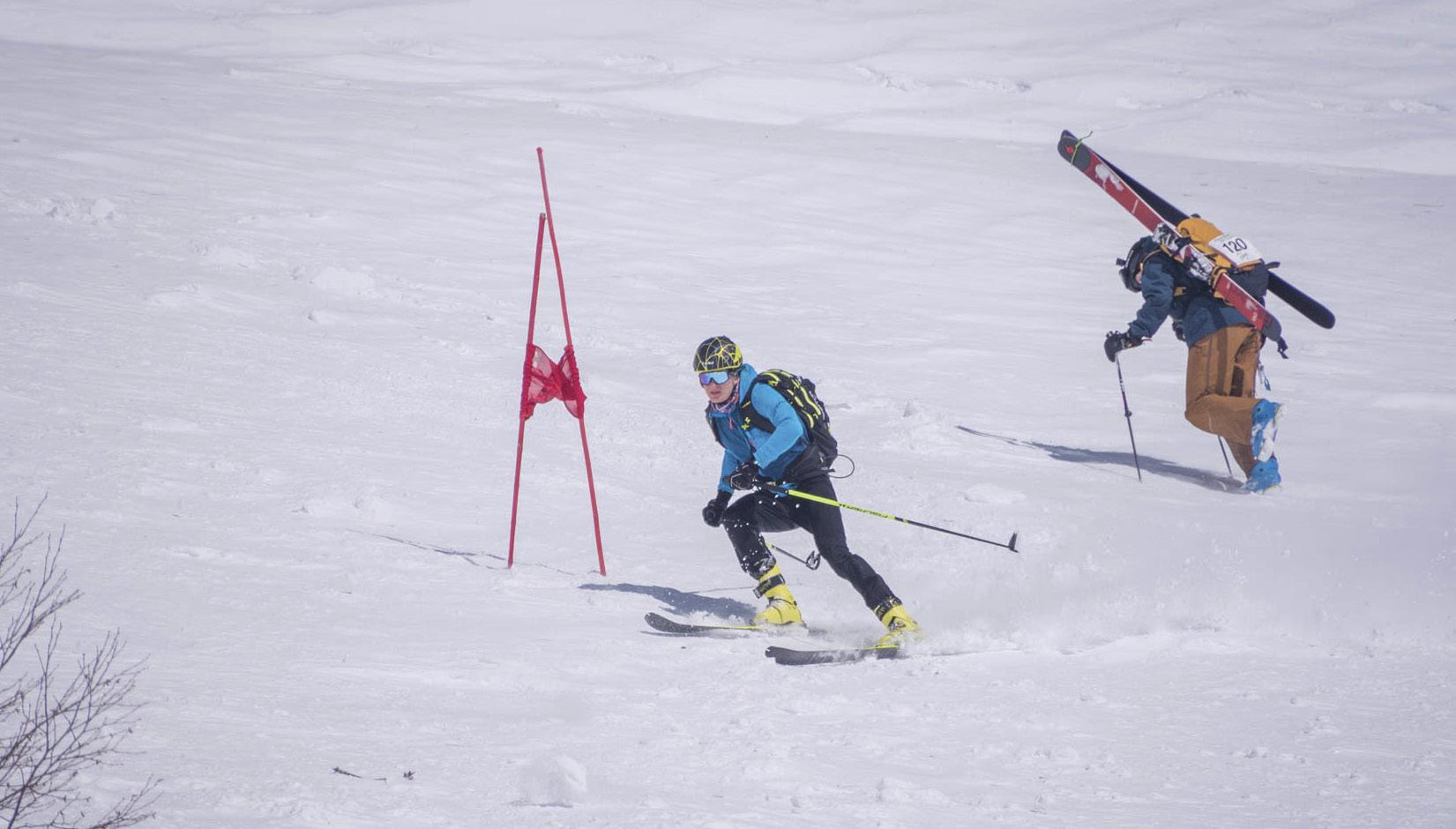
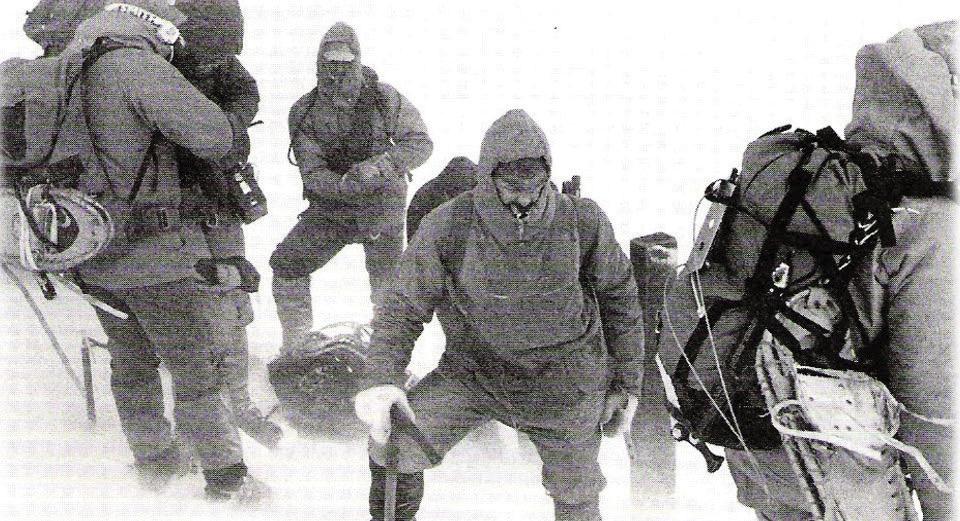
Entering its third decade, the Tuckerman Inferno Pentathlon is the Northeast’s premier single-day adventure race. It now consists of fat bike, XC ski, snowshoe, mountain run/skin, and skimo legs. Racers compete as individuals or relay teams to complete the course that starts at Great Glen Trails and finishes on the western flank of Tuckerman Ravine. Paying homage to the original American Infernos of the 1930s, the skimo leg of the race includes a section of giant slalom ski racing set in the alpine zone above treeline on Mount Washington. Proceeds from the
event support the Mount Washington Avalanche Center, promote avalanche education and outreach across the white mountains, along with the promotion of responsible sustainable use of the high Presidentials to protect the “Tuckerman experience” for generations to come.


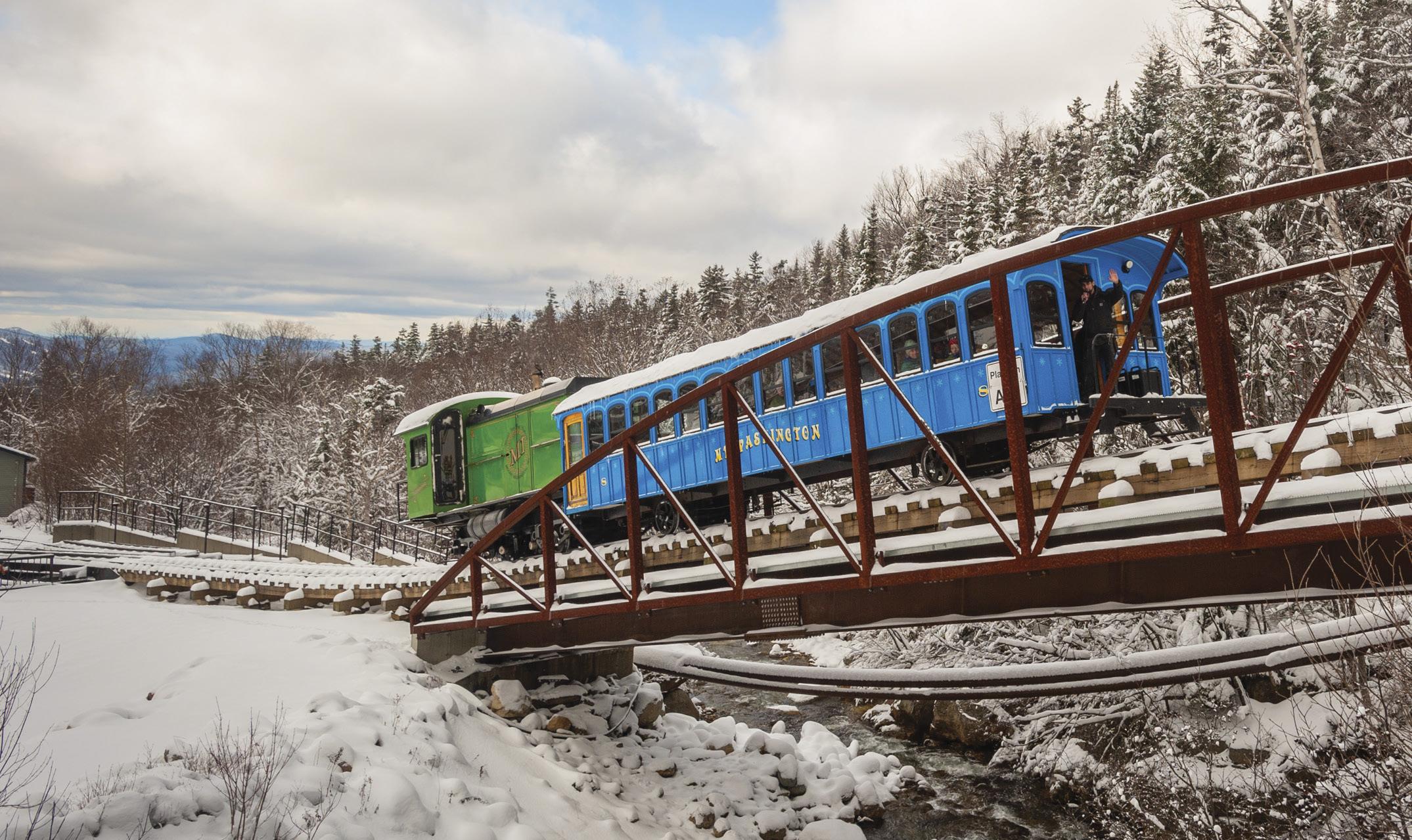
Granite Backcountry Alliance is a non-profit organization that advances the sport of backcountry skiing in New Hampshire and Western Maine by providing a network of low-impact, human-powered backcountry skiing opportunities to the public through the creation, improvement, and maintenance of ski glades.
From people who have done what they teach
Courses include Wilderness First Responder, EMT, Wilderness EMT, Advanced EMT, Wilderness Medicine Bridge Course, Wilderness First Aid, and more. thekaneschools@gmail.com THEKANESCHOOLS.COM

The Presidential traverse attracts hikers and climbers alike for its highly technical and rewarding terrain, wide open views, and dreamy ridges. The traverse stretches about 18 miles over nine classified 4,000 footers: Mount Madison, Adams, Jefferson, Clay, Washington, Monroe, Franklin, Eisenhower, and Pierce; while the extended version adds two more miles with Jackson and Webster. On this traverse, hikers are exposed above treeline for 11 miles, gain anywhere between 9,000 to 10,000 feet of elevation, and are exposed to potentially high winds and extreme weather conditions at any time of year.
“The greatest high adventure in the East is crossing the Presidential Range in the winter,” says Bill Aughton, a co-found-

er of International Mountain Equipment (IME) in North Conway, who has been teaching SOLO Wilderness Medicine on and off for 40 years.
Corey Fitzgerald, a co-founder of Northeast Mountaineering (NME) and mountain guide, set out on a winter traverse early in his hiking career, where he and other hikers present lost the trail toward the end, right by Mount Eisenhower and Pierce, since it wasn’t broken in yet with snowshoes. For two hours, they floundered through the snow and were sinking up to their chest. “It was kind of desperate,” he says. “We were crawling across the top of the snow on our bellies [to keep from sinking].”
During the winter months, hikers should expect deep snow, temperatures
below zero degrees Fahrenheit, unexpected low visibility, and extremely high winds. In fact, wind speeds in this range during the winter reach 100 miles per hour once every four days on average, according to The Wild Outsiders™, a company run by two outdoor adventurers who provide helpful information on all things outdoors.
At 60 miles per hour, “for most people, you can put your arms out to your sides, lean into it, and the wind will pretty much hold you up,” says Brian Fitzgerald, the director of education at Mount Washington Observatory (MWOBS). “That’s a lot of force.”
Brian Fitzgerald explains why the weather can change so suddenly from ideal conditions to rapid winds and frigid
On
temperatures in the Presidential Range, especially on Mount Washington, which is known for having the worst weather in the world. According to MWOBS, the highest recorded wind speed on this summit was 231 miles per hour in 1934, which is the second fastest wind speed ever recorded.
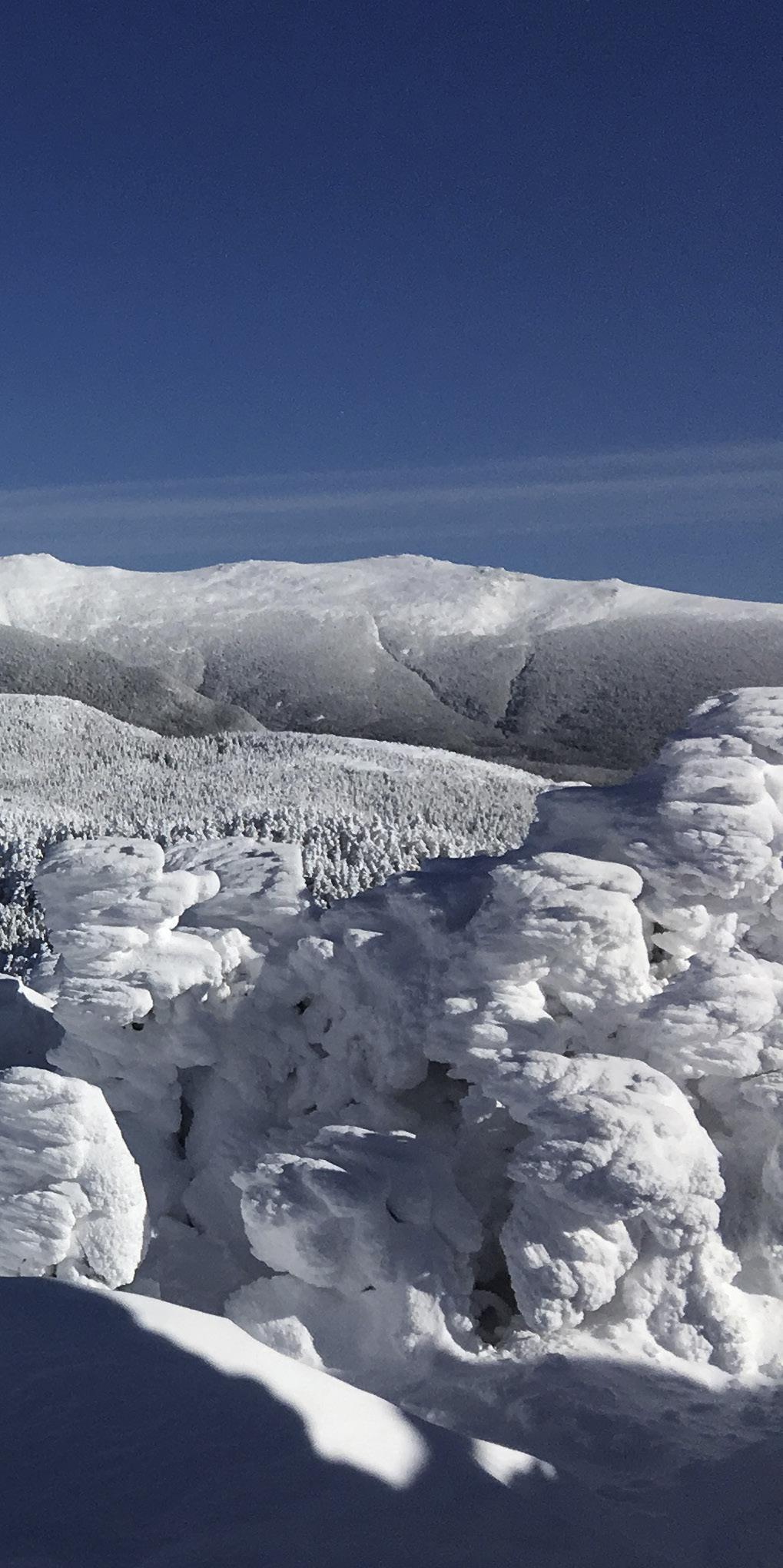
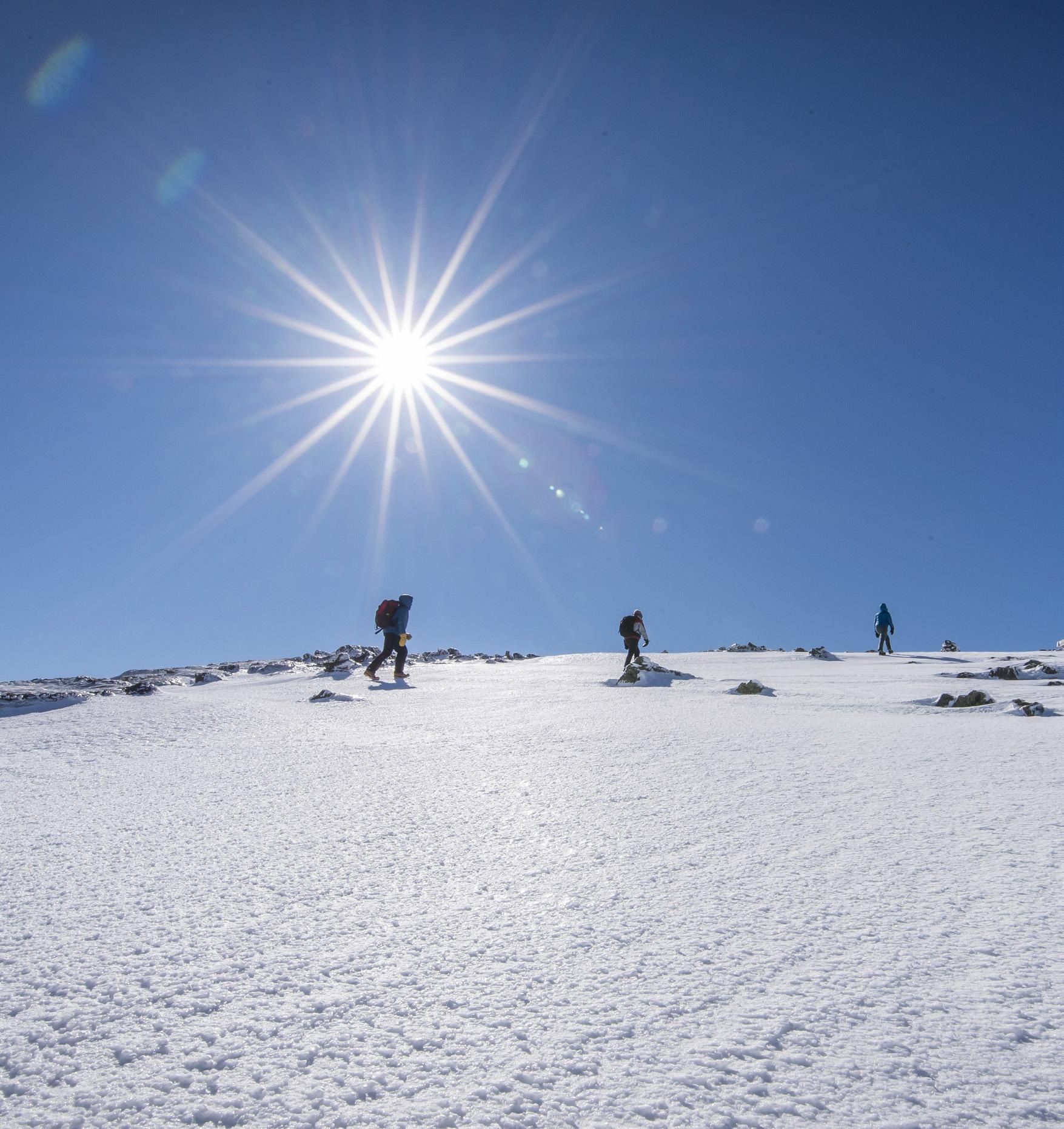
These aggressive conditions have to do with where we are on earth. With New England already being so cold, it
is expected to get colder on the tallest peaks in New Hampshire from the layers of air that sit between sea level and the tropopause. Plus, there is not much blocking the wind above treeline, so naturally, it is going to be windier.
In addition, wind can strengthen over mountain peaks due to the Venturi effect, which is when mountains squeeze the air and accelerate it. Jet streams at lower levels (around 5,000 feet) can also

produce greater wind, which is caused by the tropopause meeting the stratosphere above Mount Washington.
When the wind speed doubles, Brian Fitzgerald says that it does not feel twice
as strong. Instead, the force quadruples. At “50 [miles per hour], you can kind of struggle through; 100 [miles per hour], hardly anyone is standing a chance in conditions like that.”
For the most accurate weather
this traverse, hikers are exposed above treeline for 11 miles, gain anywhere between 9,000 to 10,000 feet of elevation, and are exposed to potentially high winds and extreme weather conditions at any time of year.Photo by Max DesMarais | www.hikingandfishing.com Photo by WiseguyCreative.com
reading at higher elevations, hikers should check the Higher Summits Forecast online at MWOBS. The forecast goes out 48 hours prior and should be checked all the way up to
warmth. Once they finished making a litter out of a tent and a few hiking poles, they carried her back down to the hut to radio the IME Climbing School for help.
when the hike begins. According to Brian Fitzgerald, looking more than 48 hours out decreases the probability of those conditions occurring.
For lower elevation readings, the National Weather Service is a great resource for getting a sense of the weather in that realm. Checking multiple sources will help you form an accurate prediction. “The less that [the weather] changes, the higher the confidence everybody has,” says Brian Fitzgerald.
On one guided group hike with IME across the traverse in the winter, Aughton says, “… [the wind] was blowing like you would not believe.” The group slept at Crag Camp near Mount Madison the night prior and were continuing onward the next morning. One female participant was carrying a 40-pound pack and got blown over by the wind, fell over a couple of rocks, and broke her leg.
Aughton and other hikers immediately straightened out her leg, removed her boots and crampons, and splintered her leg, as well as wrapped a dry sleeping bag around her for
“People don’t reckon that these mountains are as severe as they are,” says Aughton.
Before attempting this traverse in the winter, hikers would benefit from taking a winter skills course. This could be a one-day mountaineering skills course or winter skills course with organizations such as NME or Redline Guiding, where hikers will learn the basics of winter hiking all the way to how to use an ice axe, crampons, and self-arrest.
Such mountaineering skills would be especially beneficial for when hikers approach the Jefferson snowfields, which they will cross right before summiting Mount Jefferson on a northbound Presidential traverse. The snowfields are known for being the last to melt away come the summer months, and can be daunting to cross during the winter due to their slopes.
Many winter hiking courses will also cover avalanche risks and safety, which can occur on slopes “when there’s enough snow and the conditions are right,” says Aughton. The

In addition, wind can strengthen over mountain peaks due to the Venturi effect, which is when mountains squeeze the air and accelerate it.Photo by WiseguyCreative.com
risk of avalanches increases when it rains, the rain freezes, and a fresh layer of snow falls right on top—creating a weak layer that makes it easy for the snow to slide off.
“Look at the signs of the mountains,” says Aughton. “If you see slides; if you see any cracks across open areas, then it’s avalanche time.”
In addition, Mike Cherim, the owner of Redline Guiding, says that hikers would benefit from a wilderness navigation course, especially for being above treeline, where conditions can change abruptly. One time, on his way up to Mount Adams, Cherim had to turn around due to rime ice, which is a weather condition that creates a complete white out.
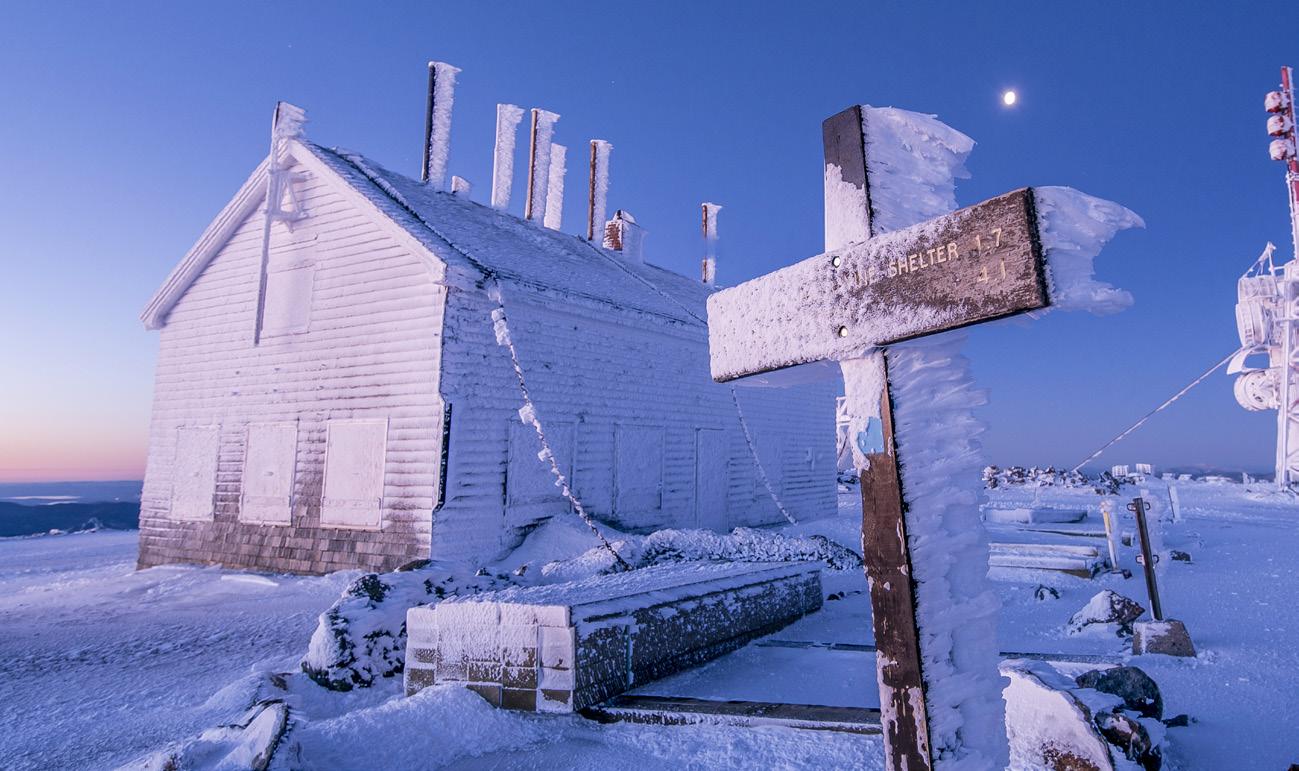
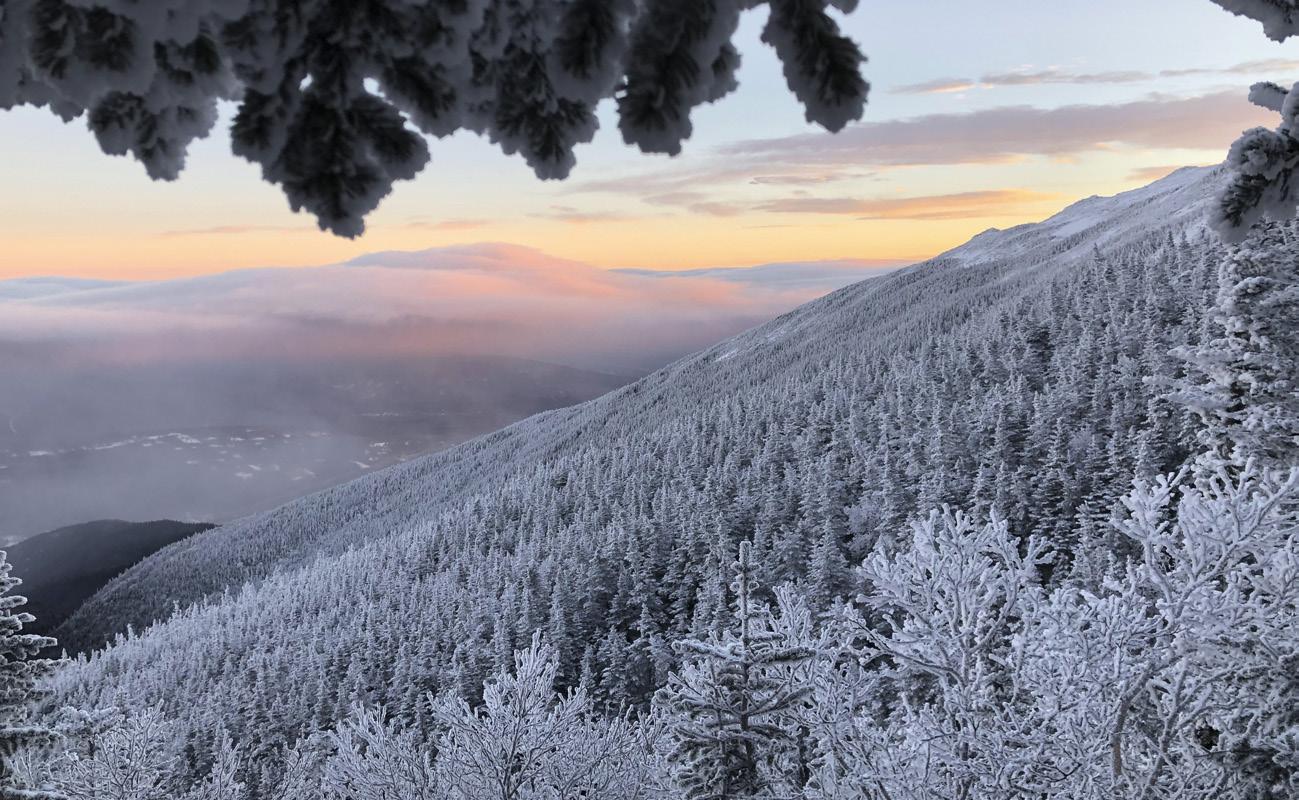

“You could be operating by electronics and the only thing you would be able to see is the GPS right in front of your
eyes,” says Cherim, which is why he emphasizes the importance of learning how to navigate without electronics, such as by reading the cairns, as well as a map and compass.
Regardless of the time of year, hikers should be carrying the “Ten Essentials,” which comprise navigation, sun pro-
Before attempting this traverse in the winter, hikers would benefit from taking a winter skills course.Photo by WiseguyCreative.com Photo by Jordan Cargill
All mileage is approximate, data is derived from www.caltopo.com, and measurements taken from U.S. Forestry Maps. Many sources list the mileage of the traverse as much greater.
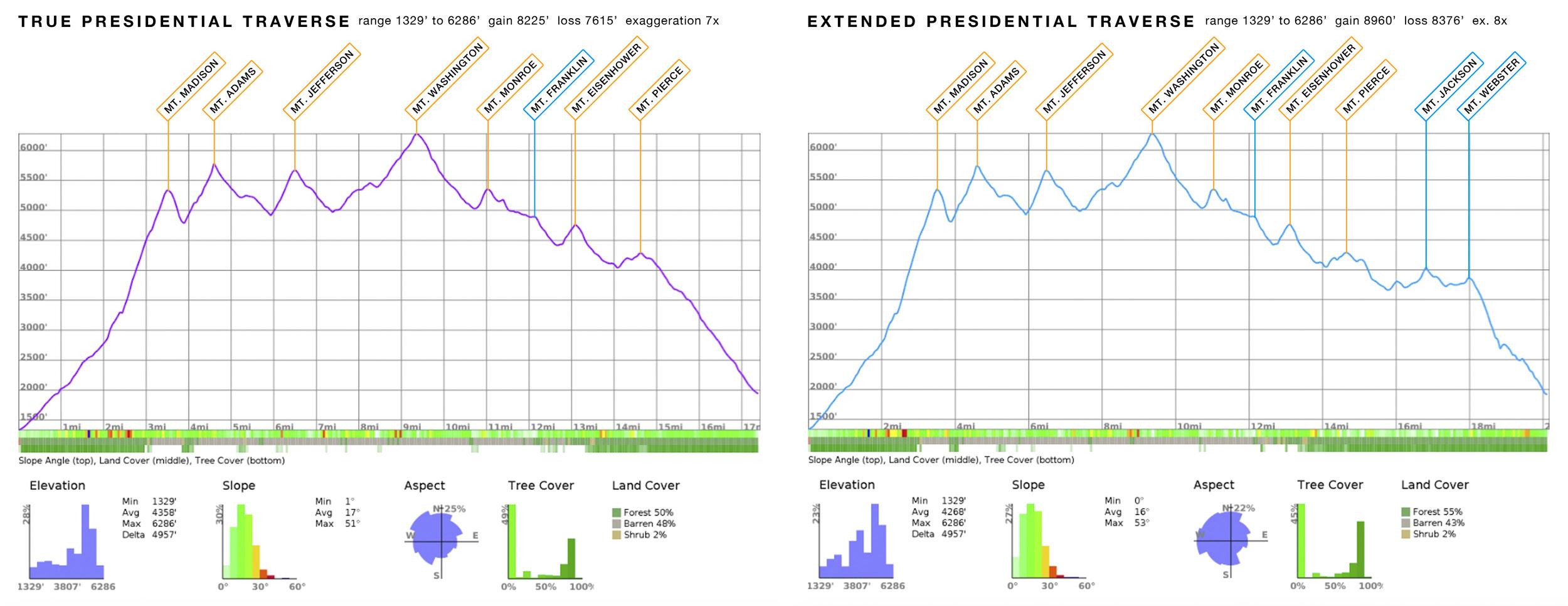
tection, headlamp or flashlight, knife or multitool, first aid kit, shelter, fire starter, and extra food, water, and clothes. During the winter, hikers should carry snowshoes and have insulated water bottles and food that will not freeze or have a way to keep their food from freezing, such as by keeping it close to their body. Cherim recommends that hikers should also have some sort of pad to keep immobile hikers off the ground, in case of emergency, in order to prevent them from developing hypothermia. In the next article, “Running Hot in the Cold,” Dr. Trish Murray discusses hypothermia in greater detail.
Preventing hypothermia has a lot to do with layering your clothing properly. Base layers should be made of some sort of
time. Hikers should make someone they trust aware of their itinerary, with very specific details.
If hikers are stuck in an emergency situation and need help, Brian Fitzgerald says that the best thing to do is call 911 to reach Fish and Game, the point of action in most emergency cases. Mount Washington Observatory gets roughly six to 12 calls per winter from organizations seeking information on current weather conditions to determine if it is safe enough to head out for a rescue.
“Hikers need to keep in mind that the SAR [search and rescue] won’t necessarily go out if they’re going to die in the process,” says Cherim. “There’s no guarantee that you’re going
sweat-wicking material, such as Merino wool and polyester, so they can absorb moisture and prevent hikers from getting cold when they stop on the trail or summit. Hikers should avoid wearing cotton at all costs because it doesn’t wick moisture and could potentially lead to hyperthermia. In addition, insulated soft-shell pants and jacket are crucial, as well as a hard-shell, lightweight jacket that provides a shield from wind and rain.
Hikers will also want to wear insulated hiking boots, carry extra socks, hats, and gloves, goggles to shield their eyes from ice blowing around, and something to cover their face. Essentially, all skin should be completely covered in harsh conditions.
Regardless of how prepared hikers are, conditions can turn, and often hikers will have to bail on the traverse. Cherim emphasizes the importance of having multiple bail-out points and to have someone on the ground ready to pick you up at any
to get rescued right away.” Oftentimes, SAR will have to wait for a safe weather window to head out for a rescue or they’ll first need to assess where exactly hikers are before creating an action plan.
Corey Fitzgerald emphasizes the importance of self-care during a traverse, from eating and hydrating consistently to knowing your own limits. In addition, hikers can ensure their safety a bit more by purchasing a “Hike Safe” card through the NH Fish and Game Department. The card is $25 per person, which protects hikers from being responsible for any rescue-related costs unless the actions during an emergency rescue meet a specific criteria set out by legislation. The cards are valid for 12 months from the day of purchase.
To prepare for a safe traverse in the winter, Corey Fitzgerald recommends that hikers improve their cardiovascular endur-
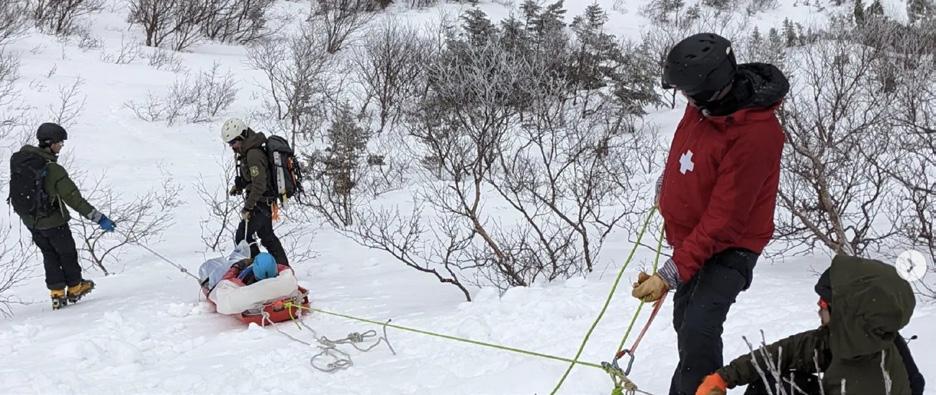

Visibility and weather conditions can change drastically when traveling in the White Mountains making it very easy to go off trail. Make sure to check the Higher Summits Forecast and MWAC avalanche forecast before heading
www.mountwashington.org/experience-the-weather/ higher-summit-forecast.aspx

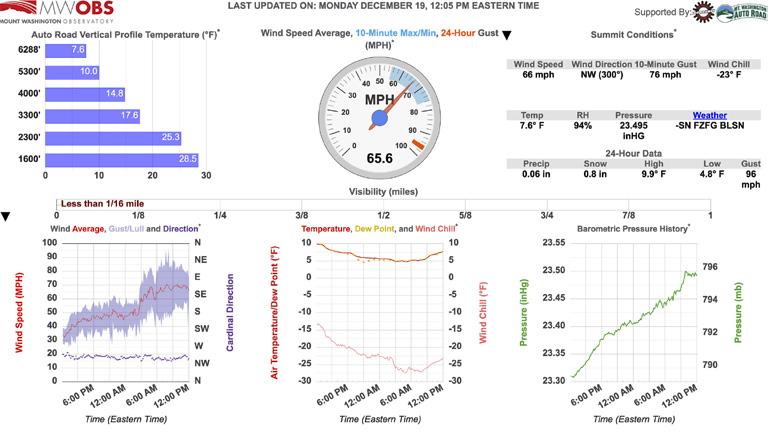
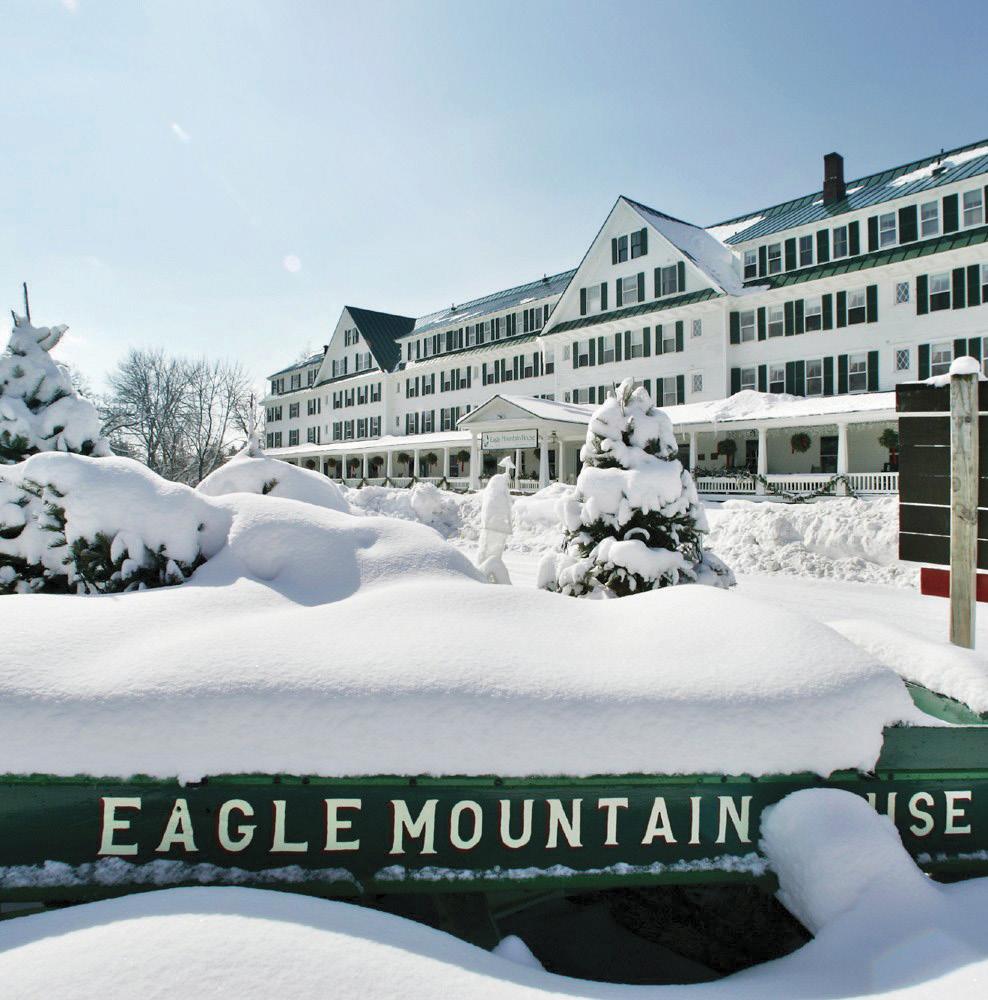
There are multiple rescue groups operating in the White Mountains, many of which are volunteer based. It may take hours for rescuers to reach you in decent weather, and possibly days, if the weather is at its worse. There is no sense risking the lives of many for one. Rescue is an intensive operation requiring multiple healthy bodies—it can take 12 or more to carry out just one litter.
Rescues also tend to be extremely costly and the bill generally ends up in the hands of the rescued. To protect yourself from these sorts of incidents, the New Hampshire Fish and Game department offers hikers the option to purchase a Hike Safe card. The card is valuable for anyone hiking, paddling, cross-country skiing, or engaging in other outdoor recreation. People who obtain the cards are not liable to repay rescue costs if they need to be rescued. An individual may still be liable for response expenses if the actions that created the need for the emergency response meet criteria set forth by legislation.
Visit www.nhfishandgame.com for information.


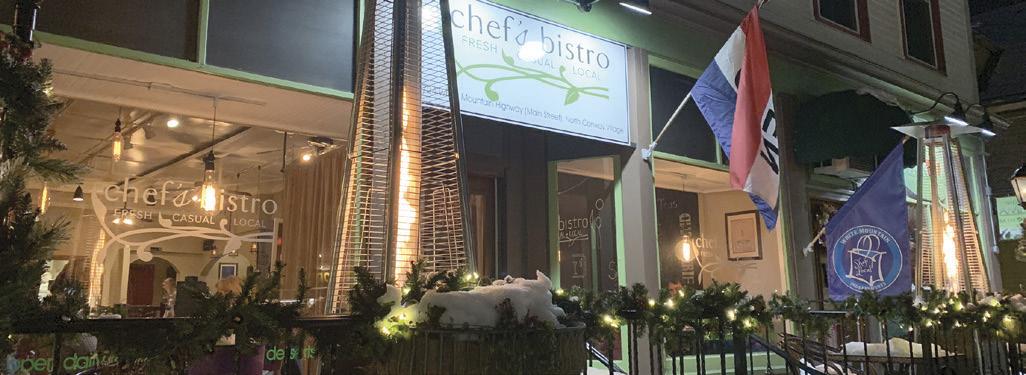

Preparing a checklist such as the one above (provided by www.theoutsiders.com) is one of the many aspects of planning a winter traverse. Without proper mountaineering equipment, winter hiking experience, and knowledge of safety and preparation, hikers may find themselves in very dangerous situations.

ance at a comfortable pace. Hikers can do so by completing eight- to 10-hour day hikes with heavy packs, such as sections of the Pemi Loop or the Franconia Ridge. Or, if hikers do not have easy access to mountains, they can climb hills in their local area or use a StairMaster while wearing a heavy pack to prepare their body for the difficult trek and excessive elevation gain.
Since this hike can be mentally daunting, Cherim says that hikers could also start with something a bit smaller above treeline, such as taking the Ammonoosuc Ravine Trail to Mount Monroe and Washington in the winter; then working their way up from there. When the weather is ideal, and hikers are ready to attempt a traverse, Cherim says that being up there is like a dream.
One beautiful night up in the Presidential Range, Corey Fitzgerald and his brother camped up on rocks and snow on their two-day winter Presidential traverse. Their trip included sunlight moving in and out of the clouds, a stunning sunset,
heavenly undercast, and minimal wind.
“Just knowing that you’re doing one of the most brutal things you can do in New Hampshire is special,” says Corey Fitzgerald. “Especially if you get good weather and it’s enjoyable.”
For hikers planning a winter traverse, Fitzgerald recommends waiting until you get really nice days in the imminent forecast instead of scheduling a traverse too far in advance, since the weather won’t always be ideal. In fact, MWOBS reports that during the months of December through March on Mount Washington, the average temperature is 9.1 degrees Fahrenheit, the average wind speed is 43.5 mph, and the typical amount of snow, hail, and ice pellets it receives is 45 inches.
Without proper mountaineering equipment, winter hiking experience, and knowledge of safety and preparation, hikers may find themselves in very dangerous situations. And well, Mount Washington didn’t earn the name “Home of the World’s Worst Weather” for nothing.


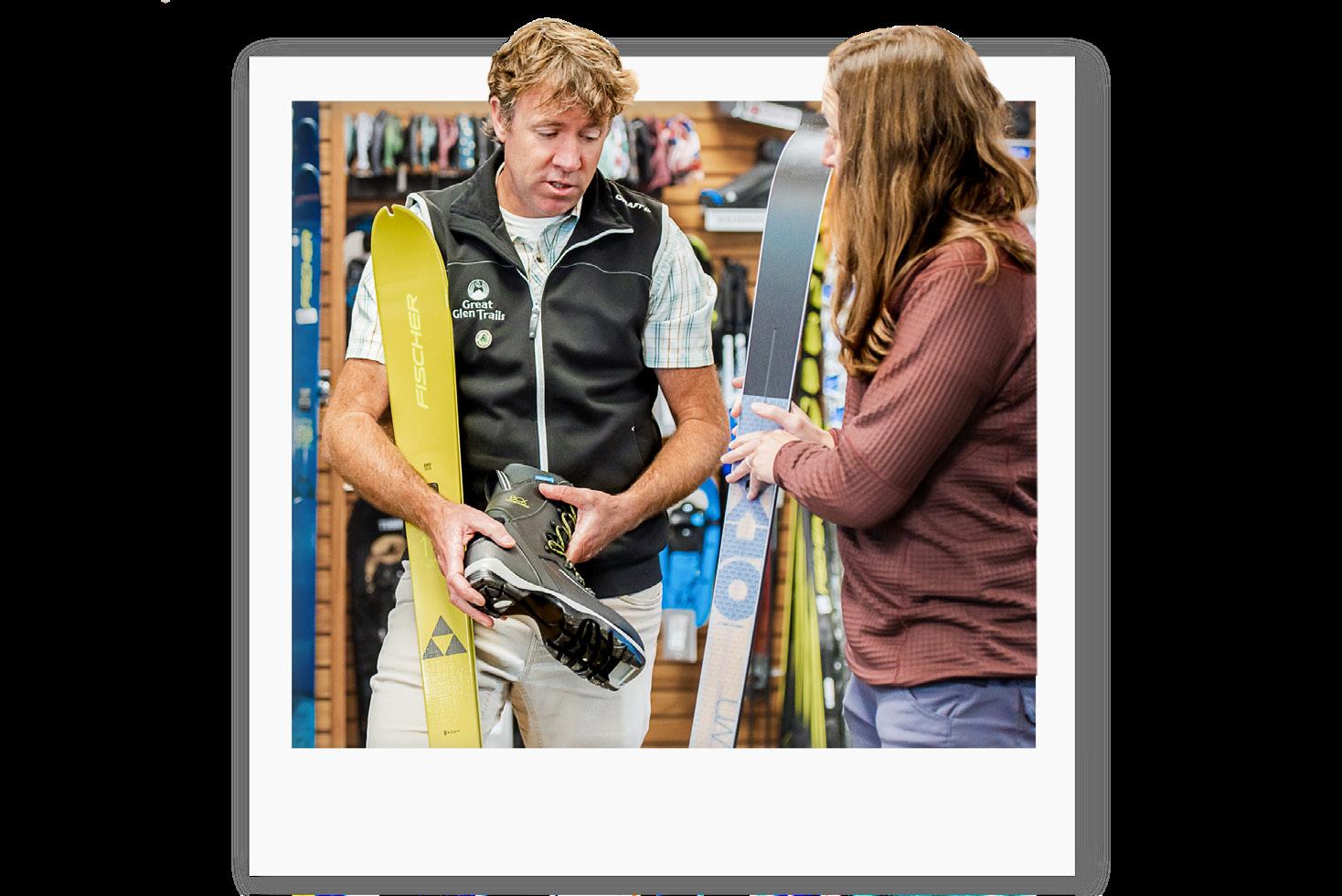


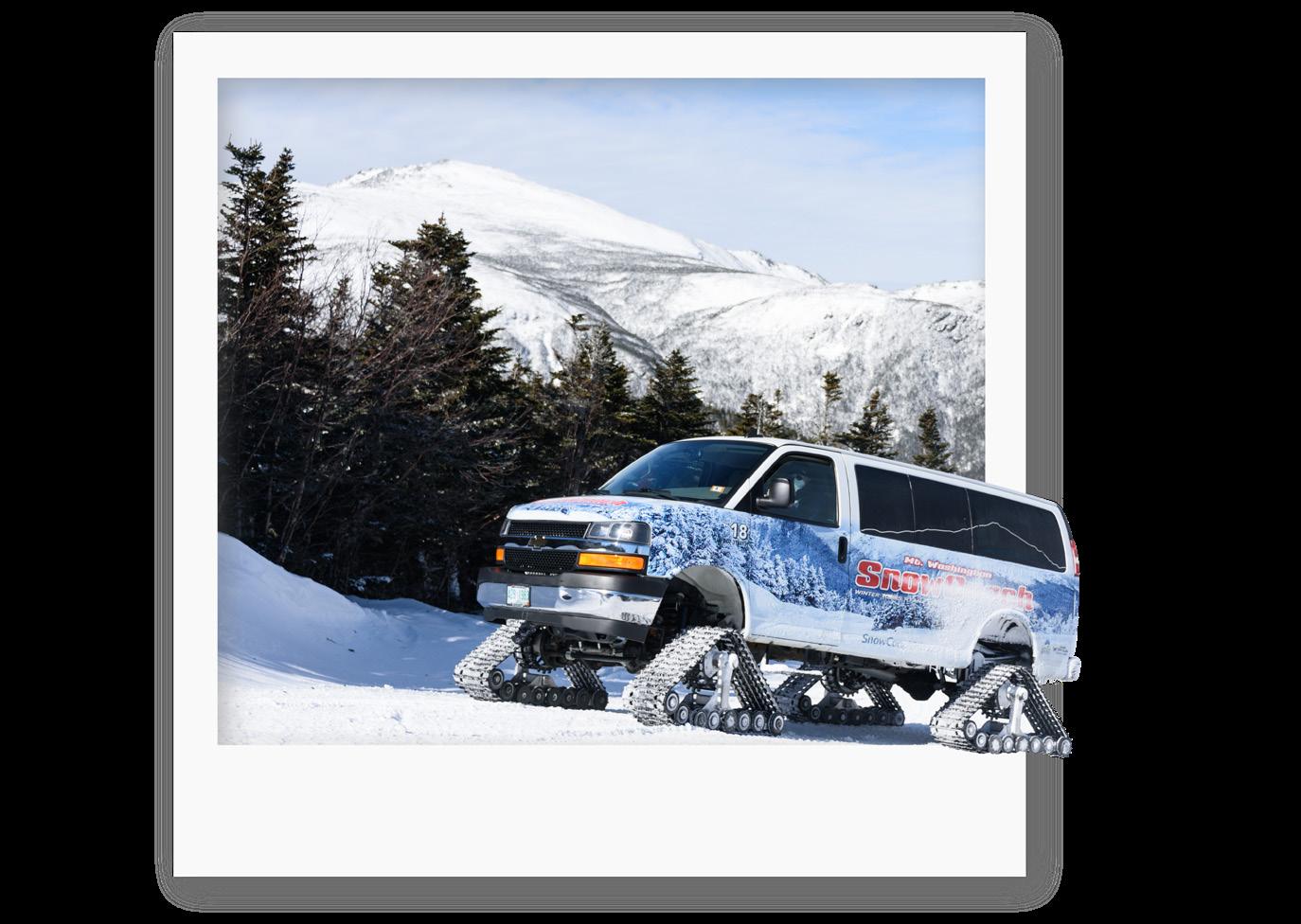



On a frigid February night, cars line the frozen lot outside a house on Kearsarge Road. In the distance, the twinkling lights of Cranmore are visible from the front porch, marking the start of school vacation week in the Valley.
Inside, members of the Ski-Bees Ski Club are relaxing after a day on the slopes, swapping stories over drinks in the main room. Seventy years’ worth of ski history line the walls, providing ample fodder for tales of renowned racers and legendary ski parties from long ago. Suddenly, a rush of members pours through the front door. Fresh from an event at a neighboring ski club, they bustle inside, prepping dinner and making plans to head back out into the snow the following morning.
The Ski-Bees is just one of the many groups around the Valley that continues the tradition of the ski club. For years, these clubs were a haven for visitors from southern New England looking for cheap lodging and the companionship of other skiers, both on the slopes and after. Today, changes in the ski industry have forced the clubs to adapt and change, but they remain a central point in the Valley’s skiing and social life, as they have for the past 90 years.
The rise of ski clubs in the Mt. Washington Valley coincides with the start of skiing in New England a century ago.
According to Jeff Leich, the former New England Ski Museum executive director who retired from his post last summer, the sport grew quickly in the 1930s as new ski areas and marketing efforts brought snow enthusiasts from other parts of New England. Beginning in 1931, ski trains carried weekend skiers from
Boston to the Mt. Washington Valley and other regions.
“Skiing as a recreational sport was really nowhere in, say, up to the mid-1920s or a little bit later,” he says. “Then it got very, very popular in the U.S., particularly New England, from about 1930 into World War II. It was a really quirky, dorky kind of thing for people to do in 1927, and by 1940, every metropolitan daily had a ski writer and carried a Sunday winter sports section.”
As the number of people traveling north on the weekends began to increase, skiers banded together, many of them looking for a place to stay. Organizations such as the Appalachian Mountain Club and Dartmouth Outing Club had already helped popularize the sport through the 1920s, but the new model that began to emerge followed a different pattern, whereby ski clubs would lease or purchase a house near existing ski areas for member use. The first ski clubs in the Valley included the White Mountain Ski Runners (1933) in North Conway and the Innitou Ski Runners (1938) in Glen.
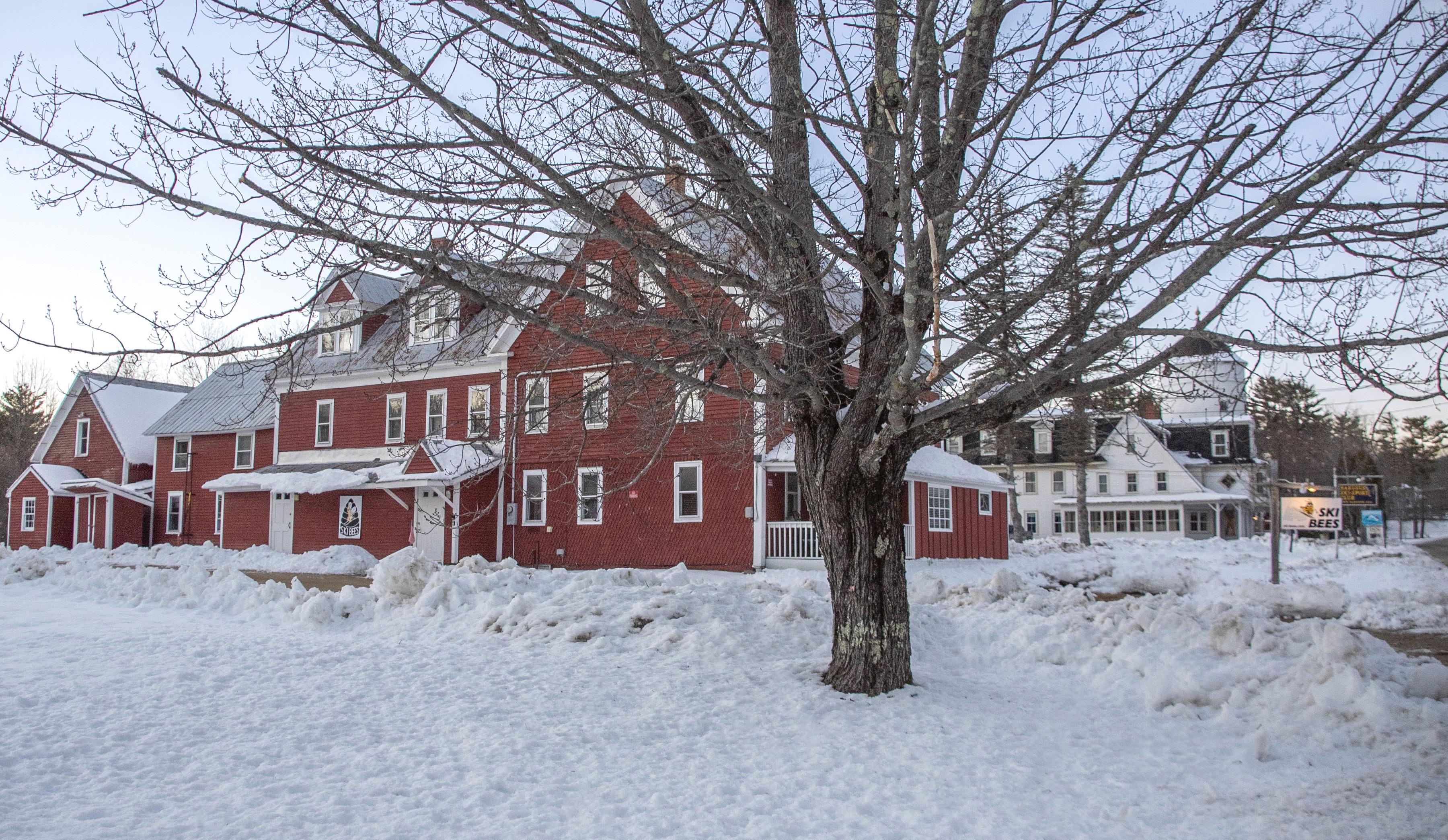
“I think they were similar in that their interests were the same,” Leich says of those early ski club members. “They wanted to meet people that skied, they wanted to learn how to ski better, and not inconsiderably, they wanted to come up with a place to stay on winter weekends. Buying a clubhouse became something of a big deal.”
Other clubs soon followed, and names such as the Schussverein, Ski-Bees, Drifters, and Massa-Schussers became commonplace around the Valley. Some clubs took their names from traditional German ski words, while others, like the Prospectors—founded by skiers of Waltham’s Prospect Hill— named themselves after their hometown or a point of interest
close to home.
While not all ski clubs owned houses, those that existed became important gathering points for social events. One common tactic was to purchase a former inn and stock its rooms with bunk beds. The Innitous rented space from the Oak Lee Lodge, now the Shannon Door Pub, in Jackson before buying their own house in Glen. The Prospectors, where Leich’s wife grew up as a member, purchased the former Dearborn Inn on Hurricane Mountain Road, eventually adding an addition to the four-story house. One property in Kearsarge, formerly Russell’s Inn, is now home to three separate ski clubs. After it went up for sale in 1960, the Ski-Bees and the Ski-Wheelers purchased two of the inn buildings, while the Makusues moved into the former employee lodging house.
Many of the ski clubs took up residence in North Conway and Intervale, where former inns clustered near the base of Cranmore Mountain, though Leich notes that Bartlett was also a popular choice due to the presence of old boarding houses for logging workers. One club, the Melrose Hickory Hawks, took over the old train depot in Glen, using the station as a club room and gathering space while members slept in a purpose-built bunkhouse next door.
Though the skiing took place up north, most of the clubs held regular business meetings in the greater Boston area or wherever their members lived. In the 1980s, the Chateau
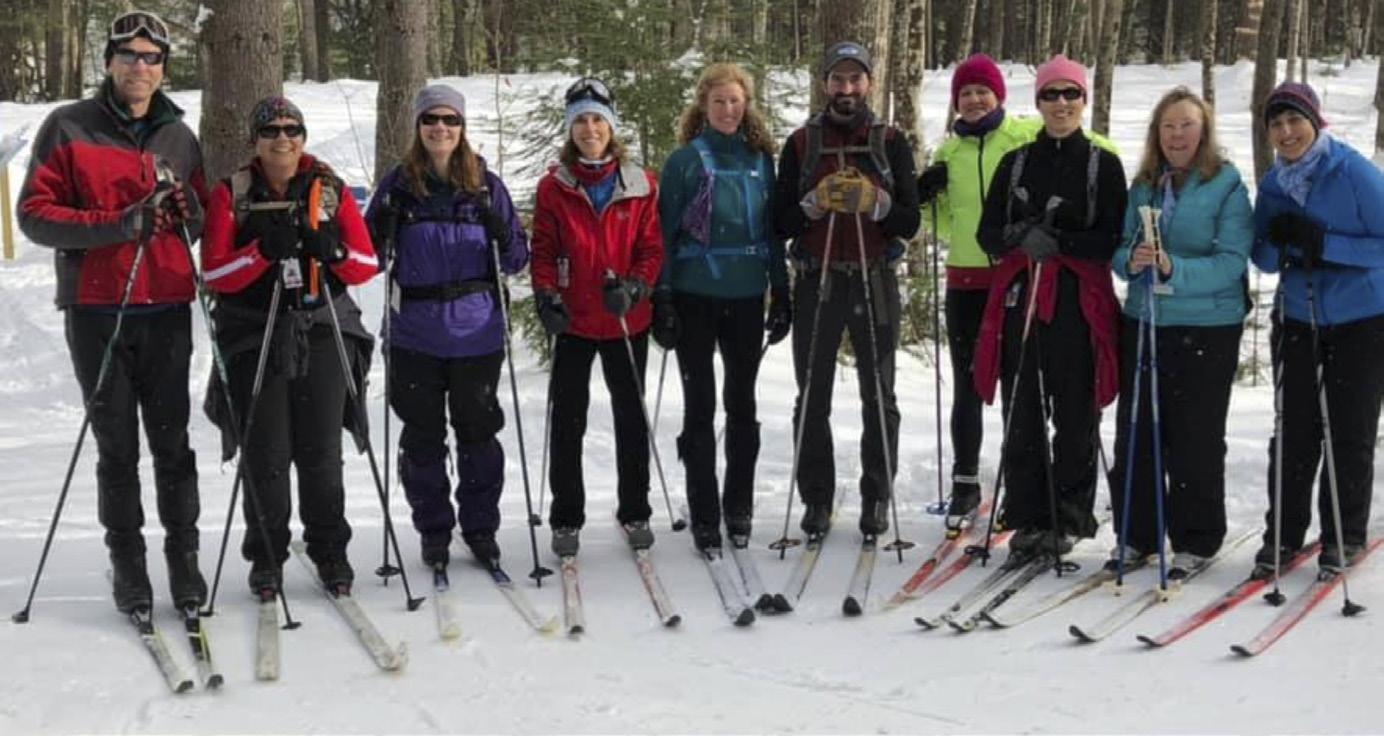
Restaurant in Waltham served as the meeting location for at least nine different clubs, as described in a 1984/85 directory of ski clubs on file at the New England Ski Museum. Today, clubs still hold regular meetings, but the presence of new technology and the pandemic mean many clubs now meet over Zoom and save their in-person time for skiing.

The first decision any ski clubber encounters is which club to join. Much like rushing a fraternity or sorority, the clubs have different personalities and reputations, and most clubs encourage members to test out a few before they commit.


“Each of the clubs definitely has their own individual personality,” says Margie Pleau, a Ski-Bee from Millville, Mass. “You see someone and you’re like, ‘You’re a Makasue.’ You can just tell.”
Diana Lu, a Wedeln Ski and Outdoors Club member from Boston, says she tried several clubs before visiting the Wedeln house off Hurricane Mountain Road. In her 30s at the time, she had recently broken up with her fiancé and was looking to find a new group of friends with whom she could enjoy the outdoors. She later met her current boyfriend in the club and has been a member for 14 years.
“I walked into the living room, and everyone was just so welcoming,” she recalls. “You know when you just walk into a
party and you feel a connection with people? That’s how it was. I’m a very extroverted person, so that club was just right for me.”
With between 60 and 80 members, the Wedelns is one of the larger clubs in the Valley, attracting around 30 members on a typical winter weekend. Members sleep in single-sex dormitories on the upper levels of the former inn. Many of the clubs were originally singles clubs, though few enforce the requirement today. In the case of the Wedelns, Lu says, about half the members have a significant other in the club, but they still maintain the dorm-style sleeping arrangements.
felt like an ashtray in here.”
Today’s club culture is a bit more subdued (and less smoky), but socializing is still a big draw for members. On Saturdays, clubs take turns hosting après ski gatherings and evening events.
“Even though they’re married to each other, at the end of the night, they’re like, ‘Goodnight, honey!’ and they walk off to their bedrooms,” she says.
Other clubs have added family rooms or gender-neutral bunk rooms. A handful were founded as family clubs and have continued the tradition with multi-generation families. Paul Harrop, a longtime Ski-Bee from West Yarmouth, joined in his 40s after meeting a group of skiers in a bar in Hyannis. Almost four decades later, he’s the only one from that original group who still skis. Like Lu, he met his partner Sandy in the club, bonding over the long drives up from Massachusetts.
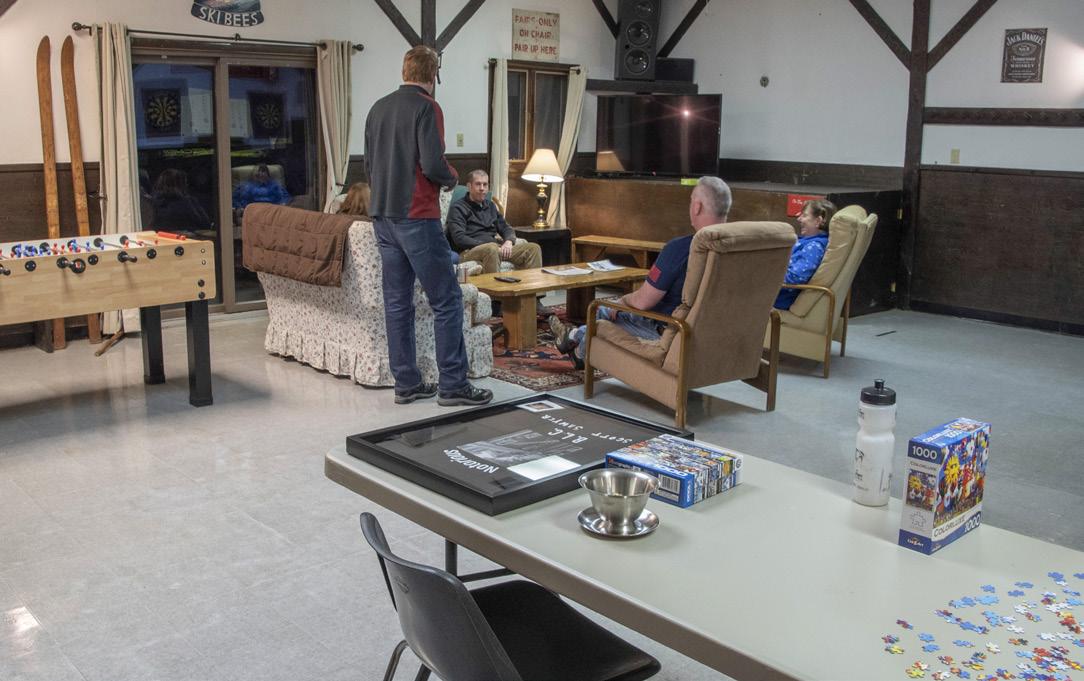
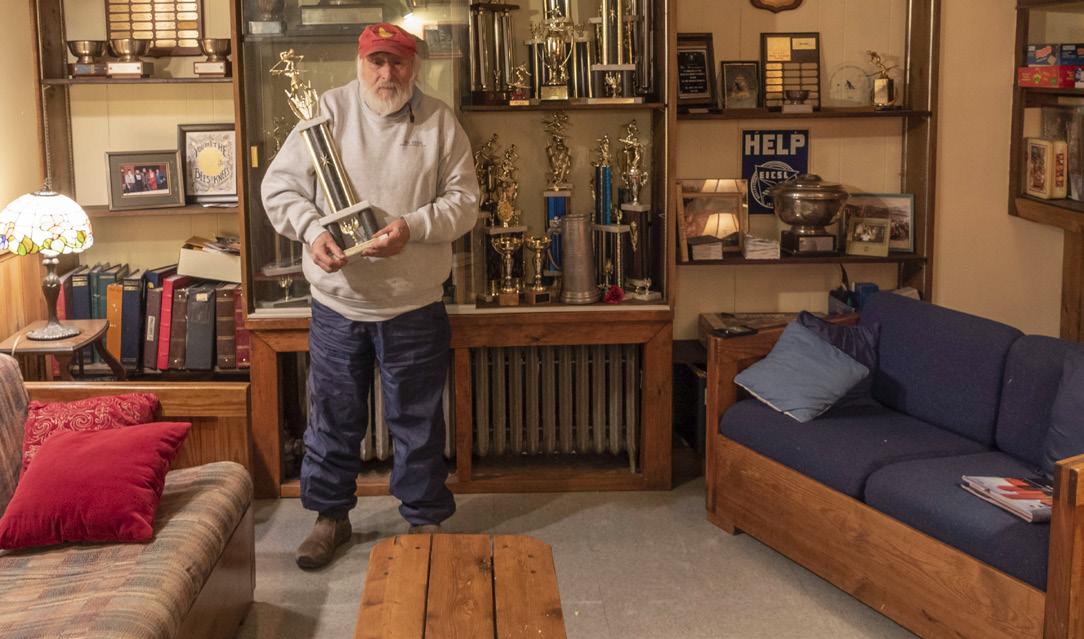

Harrop joined in the late 80s, a time when ski clubs were synonymous with party life in the Valley. A typical ski weekend began on Friday nights, and the party got going as soon as members walked in the front door.
“If you came up here on a Friday night, you couldn’t talk in the front room it was so full,” he recalls. “Everybody smoked. It
Today’s club culture is a bit more subdued (and less smoky), but socializing is still a big draw for members. On Saturdays, clubs take turns hosting après ski gatherings and evening events. Many clubs in the Eastern Inter-Club Ski League (EICSL), an association of clubs in the Valley, host signature events open only to EICSL members. Perhaps none is more popular than the ice bar, a Polecats tradition held annually in March. Marcia Minahan, a member of the Polecats and EICSL president, describes the event: “We have a band, we get Porta-Pottys, and we build an actual bar made out of snow and ice,” she says. “Sometimes we have to transport the snow. We take the plywood away and there it is. It’s probably about six inches thick and five feet tall, so it’s pretty hardy. And eventually, it melts away and we have a nice big mud puddle in the spring.”
At one time, she says, locals were found in attendance; though in recent years, they’ve limited it to EICSL members to control the crowd. The event hasn’t happened since 2019 due to COVID-19. Barring another global pandemic, she says, they plan to bring it back this spring.
Along with an outlet after a day of skiing, social events offer a chance for skiers to meet members of other clubs. Over the years, many couples have met during such parties, including the parents of Jeff Gately, a second-generation member and current president of the Prospectors. His mother, he says, was looking to find a husband when she joined the Prospectors in the 60s. She met his father, a Snowbounder, during an EICSL event.


In 1950, a small group of ski clubs banded together to form the Eastern Inter-Club Ski League, better known today as EICSL. The league offered racing for members and would go on to be a major force in East Coast skiing, at one point hosting races for the NCAA and World Cup. In the 1970s, the organization included dozens of clubs with houses across the White Mountains region.
Today, EICSL consists of 24 active ski clubs, most of them with houses in the Mt. Washington Valley. Though not all the ski clubs in the Valley belong to EICSL, those that do can participate in racing and social events. The group also negotiates discounts with ski areas and local businesses on behalf of members and organizes trips to Jay Peak and other locations.



Founded in 1935, the Eastern Slope Ski Club (ESSC) is a non-profit organization dedicated to the promotion of skiing for kids. The primary program of the ESSC is the Junior Ski Program, with over 400 volunteers and the support of countless businesses, provides skiing and snowboarding opportunities for over 1500 elementary school children in the Mt. Washington Valley.
Clubs also engage in charitable activities around the Valley. The Ski-Bees have typically held a Christmas party for seniors from the Gibson Center (the tradition was replaced with gift bags in recent years due to COVID-19), and other clubs raise money for various organizations. Depending on size, some clubs hire a cook to prepare breakfast on Saturday and Sunday mornings (and, occasionally, Saturday night dinners). Others rely on individuals or families to “host” a weekend, cooking meals and coordinating room assignments. Club members share in the responsibility of the house and are expected to complete chores before they leave on Sunday.
“It’s people who want to ski and want to have fun and want to hang out and don’t need to stay at the Ritz-Carlton,” Minahan says. “You make your own bed, you bring your own sheets, and you have to participate in cleaning the house.”


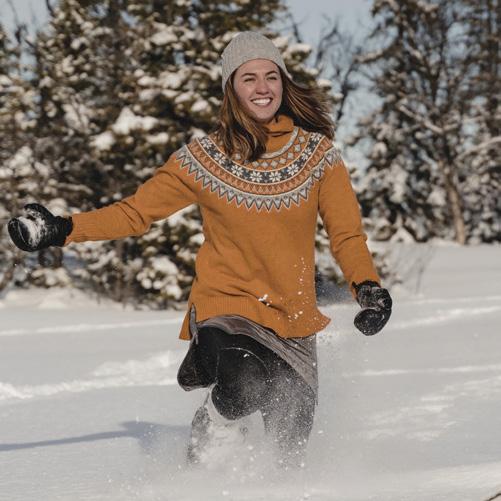
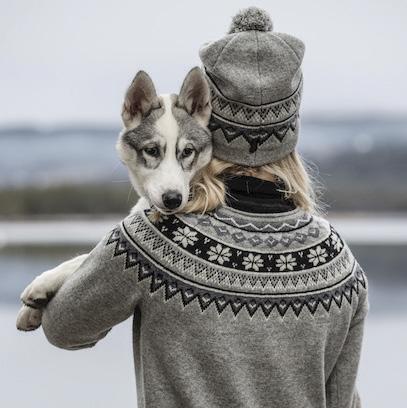

While most of the ski clubs have strict 21-plus house rules, a few orient themselves to families. One of the best-known family clubs is the Prospectors, who are celebrating their 75th anniversary this year. From the outside, the house on Hurricane Mountain Road looks the same as any other ski club: a former inn with a wide farmer’s porch, a dirt lot that can fit a dozen or more cars on holiday weekends, and an old Wildcat gondola sitting in the backyard. Inside, however,
TOP LEFT: Since 1958, members of the Prospectors Ski Club have enjoyed family-friendly meals in a communal kitchen at their four-season lodge on Hurricane Mountain Road in Bartlett. BOTTOM LEFT: Themed parties were quite common at local clubs, and still are! At the Prospectors Ski Club, the weekend host often chooses a theme. Pictured here is a group gathered at the bar in the adults-only Fireplace Room during a snowy “Hawaiian Weekend.” RIGHT: In the late 1960s, the Lawrencian Ski Club of Bartlett would hire Warren Miller productions to help offset the costs of running a ski club. Miller would be hired for a night of speaking, ski films, and even fashion shows, usually in the North Shore area, where many of the club members were from. The 72-page publication shown above would be used to sell advertising space to ski-related businesses. Though most of the advertising businesses were from Massachusetts, the Jack Frost Ski Shops were full-page advertisers at the time.
touches in almost every room point to the fact that in this club, kids are not only welcome, but encouraged. In the boot room (which doubles as a hangout space), a sign on the wall lists the prescribed bedtimes for different age groups.
“Most people love this because they don’t have to fight with their kids,” says Jeanie Zabroski, a former Hickory Hawk who joined the Prospectors after her daughter was born. “They point to the sign and say, ‘Do you want to come to the ski club? You have to follow the rules.’”
Further into the house, a kids’ room mixes colorful children’s toys on the shelves with ski memorabilia decorating the walls. Downstairs, a teen room offers foosball, pool, ping pong, and a private space where teens can bond away from their parents (no little kids allowed after 7:30 p.m.). Only the fireplace room, a more typical ski club setup complete with a stone fireplace and bar, is a kid-free space. Gately, who grew up driving up to the club from Waltham with his parents, recalls the excitement of being allowed into the fireplace room to watch the 1980 Winter Olympics.
“They brought a small black-andwhite TV to see the 1980 U.S. vs. Russia hockey games,” he says. “Whenever
I smell a fire, I definitely think of our fireplace room. And it’s a good memory. In the fall, when you can smell that fire starting up, it gets me thinking of skiing at the lodge.”
Dana Schuh is a lifetime member whose children and grandchildren now belong to the club. Like many ski club members, he prefers skiing at Wildcat for the close proximity and advanced terrain, but his kids usually take their children to Cranmore. He recalled the party-heavy days of the 80s and 90s when members would recruit their teenagers to drive them to events.
“My parents’ generation probably partied better than our generation,” he says. “When we were all younger, we’d get some of the young-uns, the 16- and 17-year-olds, to be the designated driver and drive us to the ice bar.”
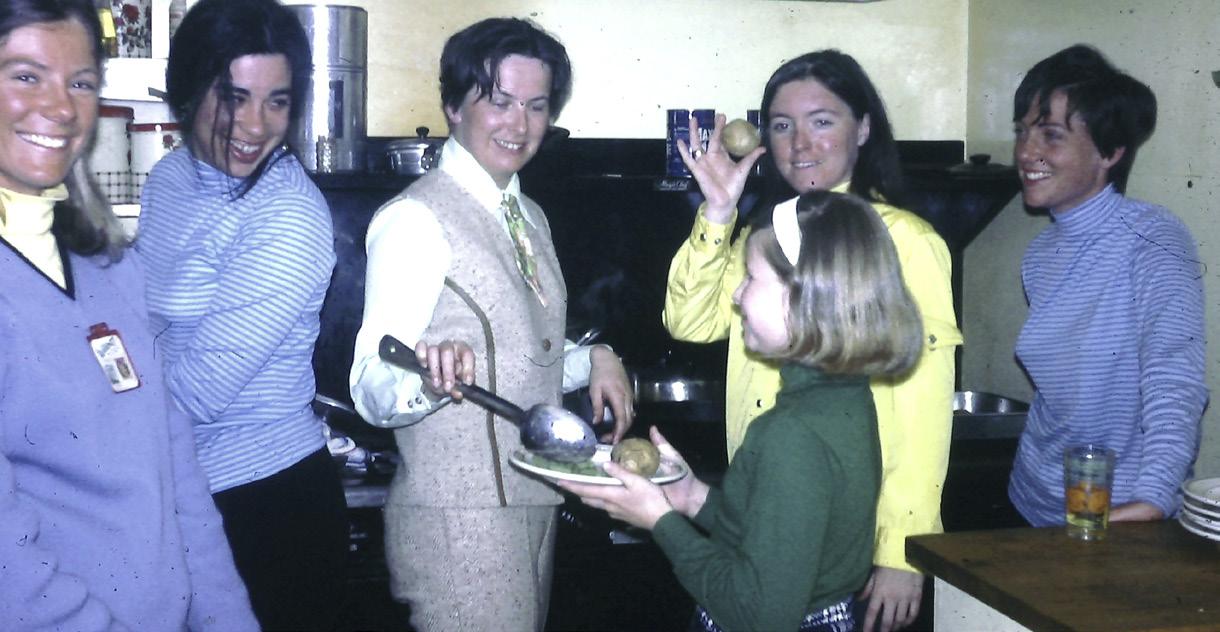
The club also attracts single members looking for a more laid-back pace. For lifetime members such as Liz Gill, it’s a family tradition they plan to continue for years to come.
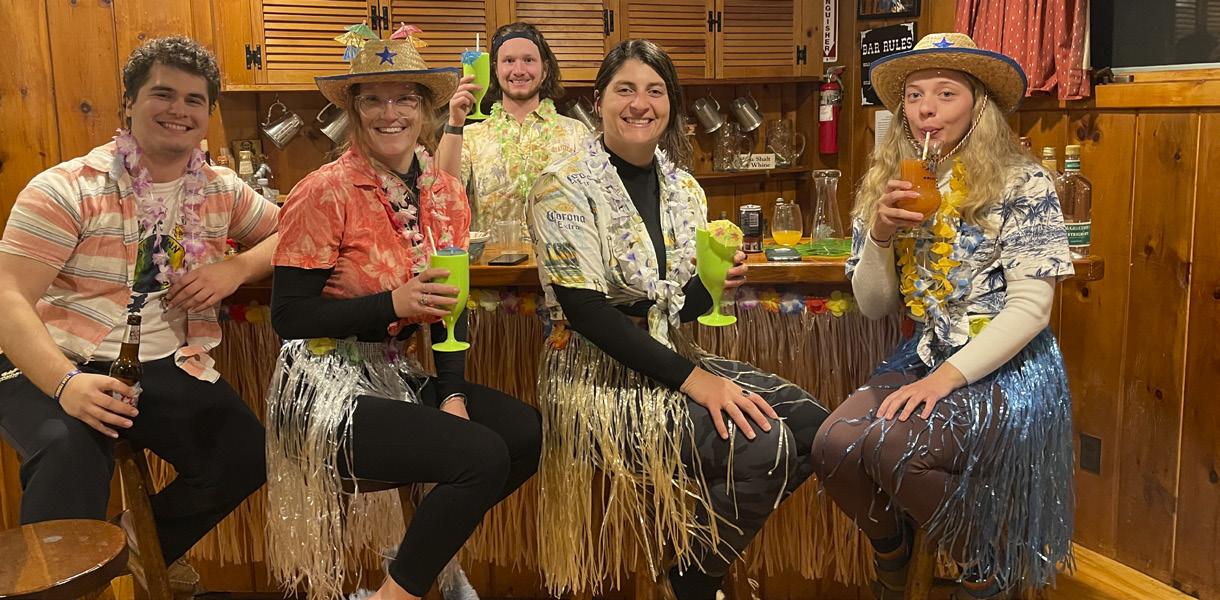
“We’re changing and adapting because we don’t want to lose this. This is our 75th year, and it’s been a big part of a lot of people’s life for a lot of years,” she says.
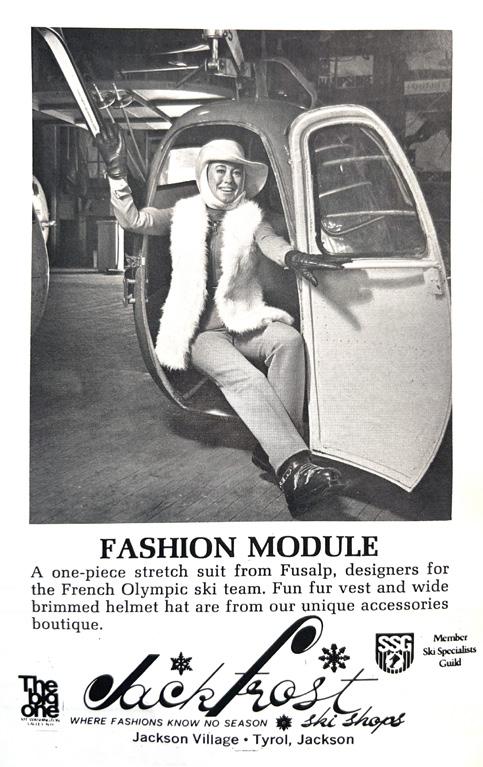

As the culture around skiing changes, many clubs have struggled to maintain their numbers with new members aging out and new ones are slow to arrive. Others have comfortable membership numbers but have still had to contend with a changing industry and aging houses, most of them decades-old former inns.
According to Minahan, back in the days when many clubs had waiting lists, EICSL included about 3,500 individuals from all of its member clubs. Today, that number is around 1,200 individuals from 24 member clubs.
“It’s a struggle I think a lot of clubs are having right now, especially with COVID,” she says.
The pandemic affected clubs, forcing them to create new policies to protect members and driving some members to purchase condos in the Valley. House policies have largely returned to normal, but clubs are getting creative in their effort to win back members. Many now host prospective members’ weekends and summer recruitment events. Others have ramped up social media efforts, using sites such as Meetup to attract prospective members from the Boston area.
To some extent, these efforts have
worked. Dan Shults, president of the Brettl-Hupfers, describes how he discovered the club after moving to Boston in 2015. He and his now-wife, both new to the area, decided to join a summer volleyball league they found online. It wasn’t until they went out for drinks after the first match that they discovered the league was run by Brettl-Hupfers.
By the end of the summer, members had convinced them to give ski clubs a try.


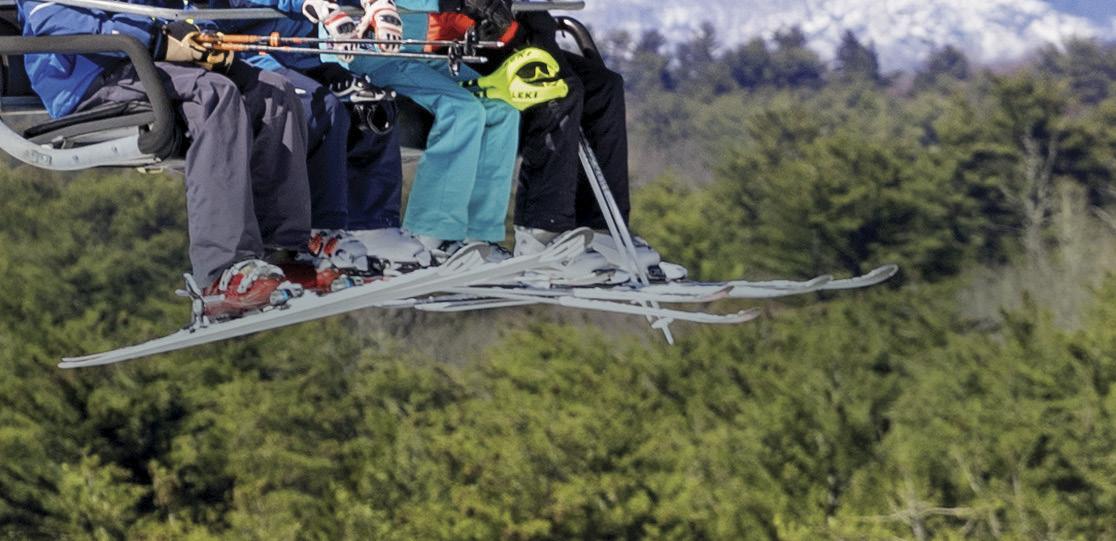



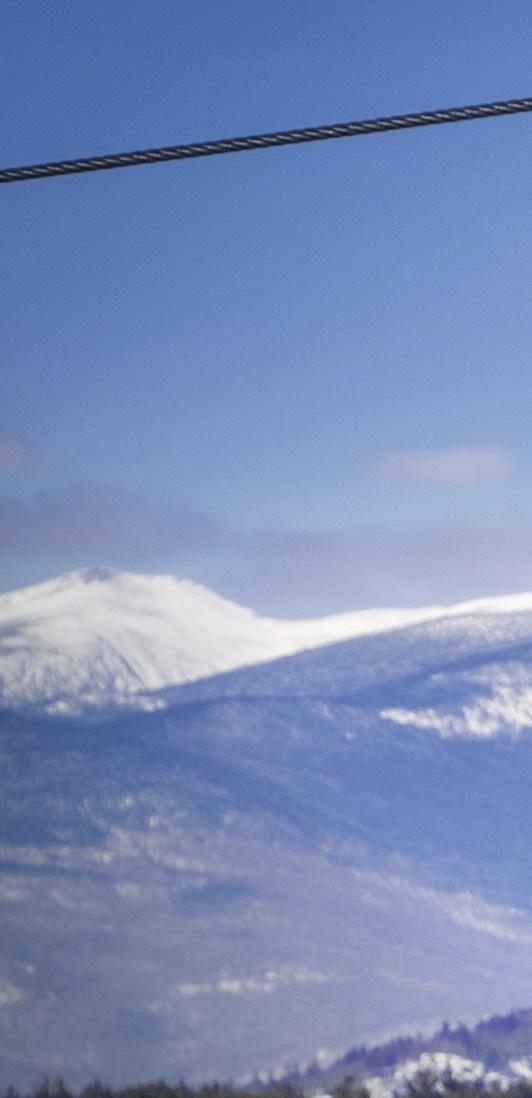
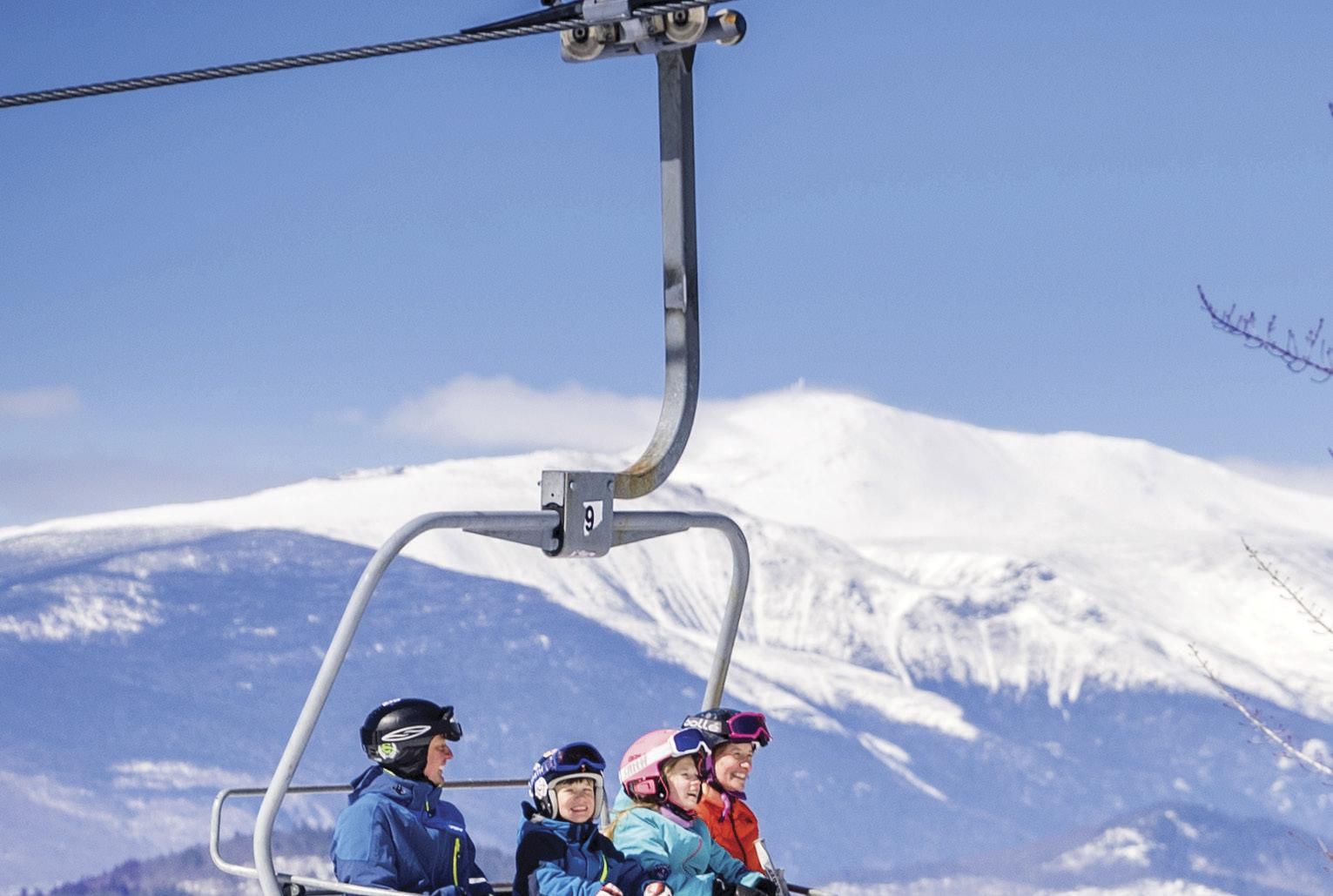
“We’re both looking at each other like, ‘We don’t ski, we’ve never skied. This isn’t happening,’” he recalls. “But at the end of the volleyball season, they do a tournament weekend up at the club. I’m saying they, but it’s really we now, because guess who runs the volleyball league now. My wife and I.”



Despite owning a timeshare in the area and taking day trips from Wilmington, Mass., Minahan says she had never heard of the clubs before a friend mentioned them in 2015. Frustrated with their timeshare rules, she and her husband decided to join the Polecats, the only one at the time that allowed dogs.
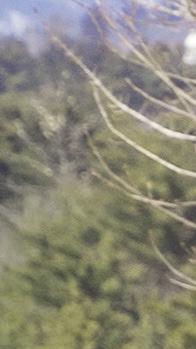


“It was like a dream come true for us. We were like, ‘Wow, we wish we’d known about this sooner,’” she says.


Brenda and Marty Killourie met through the Lawrencian Ski Club in 1966. The club was founded in 1949 by individuals from Lawrence, Mass., with a lodge in Bartlett. He, a seasoned skier from Lawrence, and she, a new member from Methuen, met when she started visiting the lodge with a friend and attending club events around the greater Lawrence area. Here, the couple recalls how they got engaged during a ski club event at Mt. Whittier a few months after they started dating. Today, the Killouries live in the Mt. Washington Valley and remain associate members of the Lawrencian Ski Club.

Marty: My buddy was a helicopter pilot in Vietnam, so he was coming up on an R&R in Hong Kong. Back and forth, he says, ‘Hey, why don’t you meet me in Hong Kong?’ ‘Man, that’s crazy. Yeah, I will.’ That was in February of ‘67, which was shortly after we had met. Just before I was leaving, there was an EICSL race at Mt. Whittier, and my grand plan was to propose before I left. This was a short-term romance. I was approaching 30, and she was quite a bit younger, so it was like, I better put in a bid here. The plan was, at the top of the mountain, make the proposal, the whole deal. It actually turned out that my buddies and everybody I knew was there [at the top]. Nobody knew at the time. I tried my best, but it didn’t work. So we get back down into the muddy parking lot after the day, and that’s where I did the deed.
Brenda: And then the next day he left for Hong Kong for two weeks.
Marty: The strange part was when I would leave a hotel or wherever I was at, my phone bill was bigger than my hotel bill. But hey, it was worth it.
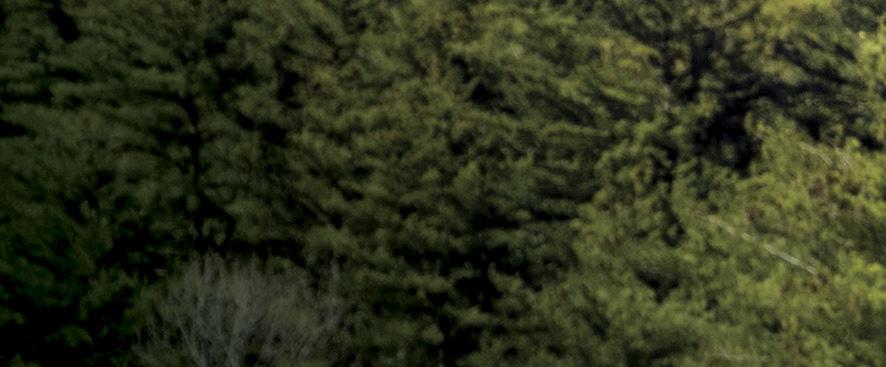
ABOVE: The Nansen Ski Club is the oldest continuously operating skiing club in North America. Founded in Berlin, New Hampshire in 1872, the club took on its current name in the 1920s in honor of Norwegian explorer and humanitarian Fridtjof Nansen. In 2011, the Nansen Ski Jump was named as an historical landmark and the club registered as a 501c3 organization. The club is dedicated to providing healthy winter outdoor experiences for locals and visitors, and also maintains a cross-country ski center with over 300 km of groomed trails, including a Garland Mill Warming Hut. RIGHT: The Markusic and Lewenberg families relax in front of the massive fieldstone fireplace during a recent quiet weekend at the Prospector’s Ski Club of Bartlett.
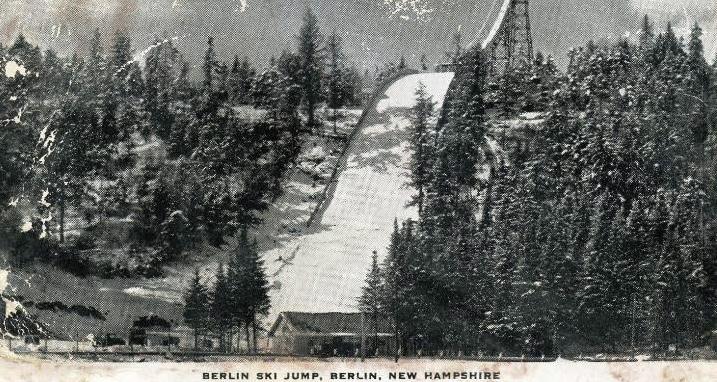
Tim Whiton, current executive director of the New England Ski Museum, says the challenges facing ski clubs reflect larger changes in the ski industry. As skiing has moved toward large, commercially owned operations and smaller ski areas have closed, many skiers, he says, lack a sense of local community. “People are marketed to less from a community standpoint and
individuals visiting the area for the weekend. These short-term rentals have been partly responsible for the Valley’s housing shortage, which in turn, has created a new opportunity for the clubs. Several of the clubs interviewed for this story were recently approached by local ski areas looking to house employees in their extra rooms. While some clubs turned down the
Many local ski clubs host prospective members’ weekends and summer recruitment events. Others have ramped up social media efforts, using sites such as Meetup to attract prospective members from the Boston area.
more as an individual. It’s pretty classic American commercialization. That small community model of the ski club is not how the industry thinks of itself,” Whiton says.
Better vehicle transportation has also made it easier for skiers to access mountains on day trips or in different areas. Passes such as the Epic and the Ikon allow them to ski resorts around the country, reducing their loyalty to a particular mountain or ski town.
Despite the trend toward individualism in the outdoors, Whiton says many skiers still crave community. He points to nonprofit organizations such as the Jackson Ski Touring Foundation and the Eastern Slope Ski Club—a nonresidential club that promotes youth skiing among residents of the Valley—as examples of groups that have successfully harnessed community support to promote outdoor recreation.

In the same way the original ski clubbers were driven by a need for cheap lodging, housing has continued to shape the ski clubs today. In addition to members purchasing condos due to health concerns, AirBnB has proven a viable alternative for
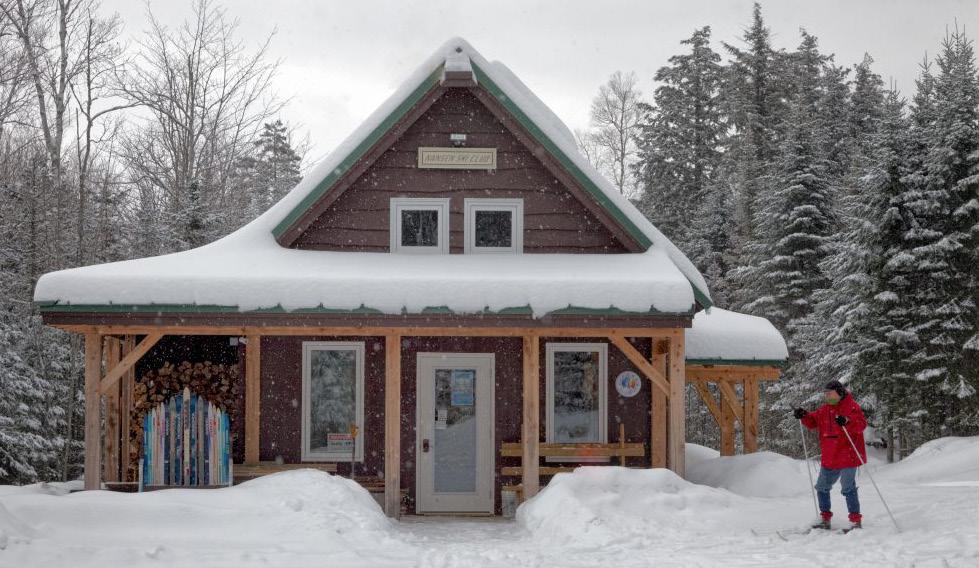
offer immediately, Minahan suspects those that are struggling financially or have empty beds might be more open to the idea.
“Each individual club would have to make the decision for themselves, because each club is responsible for their own rules and their own house maintenance,” she says “We’ll have to see what happens with that. That’ll be interesting.”
Like the rest of the ski industry, Whiton thinks ski clubs will eventually have to attract a wider demographic than they’ve traditionally relied on if they want to continue growing their memberships. Despite the setbacks, he says, the ski clubs are an example of how the industry has continued to move forward.
“They’re emblematic of skiing. I don’t think their story can be overrated because they very much mirror a lot of the changes that have been happening,” he says.
“I think ski clubs are a good avenue for getting into how the ski industry has changed, but also how resilient it is, particularly on a community level. They’re still super resilient, they’re still fighting super hard for whatever it is they really stand for—and if they can put it out there, they might keep it alive.”
Ski Clubs of the White Mountains

This list includes ski clubs, past and present, around the White Mountains region. If you have a story to share, corrections to share, or know of a club we forgot, please email Vibe at info@mwvvibe.com.


Ace Ski and Board Club*
Ala-Bye Ski Club*
Abenaki Ski Club*
Blitzschnell Ski Club*
Brettl-Hupfers Ski Club*
Brockton “Skimeisters” Ski Club*
Bumps and Bruises Ski Club
Cannonball Ski Club
Clipped Wings Ski Club*
Diamond Hill Sitzmarkers
Digital Equipment Ski Club
Drifters Ski Club

Fall River Ski Club*
Flopenaufin Ski Club
The Getaway
Greater Boston Ski Club*
Innitou Ski Runners *
Hochflieger Ski Club Ski Club Hochgebirge
Kettle Ski Club
Lawrencian Ski Club*
Lexington Ski Club
Makusue Ski and Sport Club*
Massa-Schussers Ski Club*
Melrose Hickory Hawks Ski Club*
Nansen Ski Club
Nashua Ski Club
Old Colony Ski Club*
Otter Ski Club
Penguins Ski Club*
Polecat Ski Club*
Prospectors Ski Club*
Randolph Ski Club*
Rhode Island Ski Runners
Schussverein Ski Club
Sitzmarks Ski Club
Ski-Bees Ski Club*
S-Kimos Ski Club*
Ski Wheelers Ski Club*
Snowbounders
Snowchasers Ski Club
Snow Rovers Ski Club of Boston
Steinmeisters Ski Club
Stoneham Ski Daddlers Ski and Sports Club*
Sub Sig Outing Club
Victor Luv Ski Club
Wamesit Ski Club
Waterville Valley Black and Blue Trail
Smashers
Wedeln Ski Club*
Weymouth Skiers and She-rs Ski Club
Wildcat Ski Club
Whis-Skiers of Albany
White Mountain Ski Runners
*Denotes current EICSL member

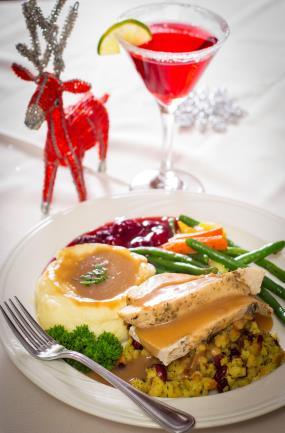
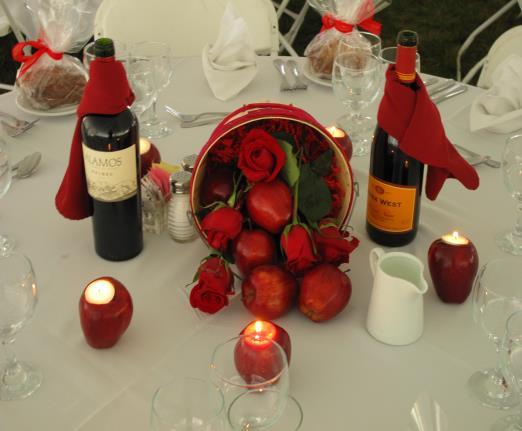
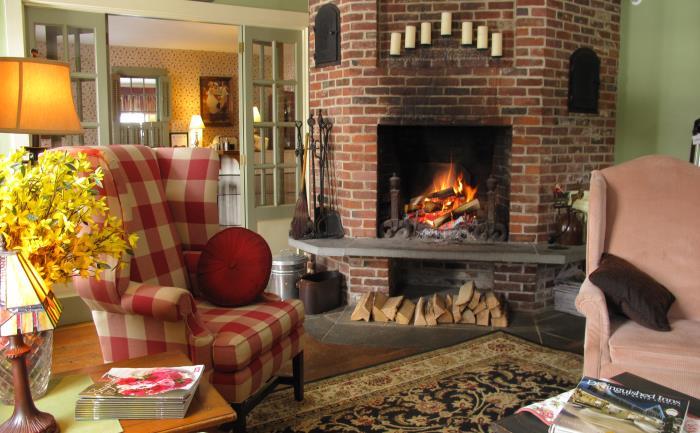
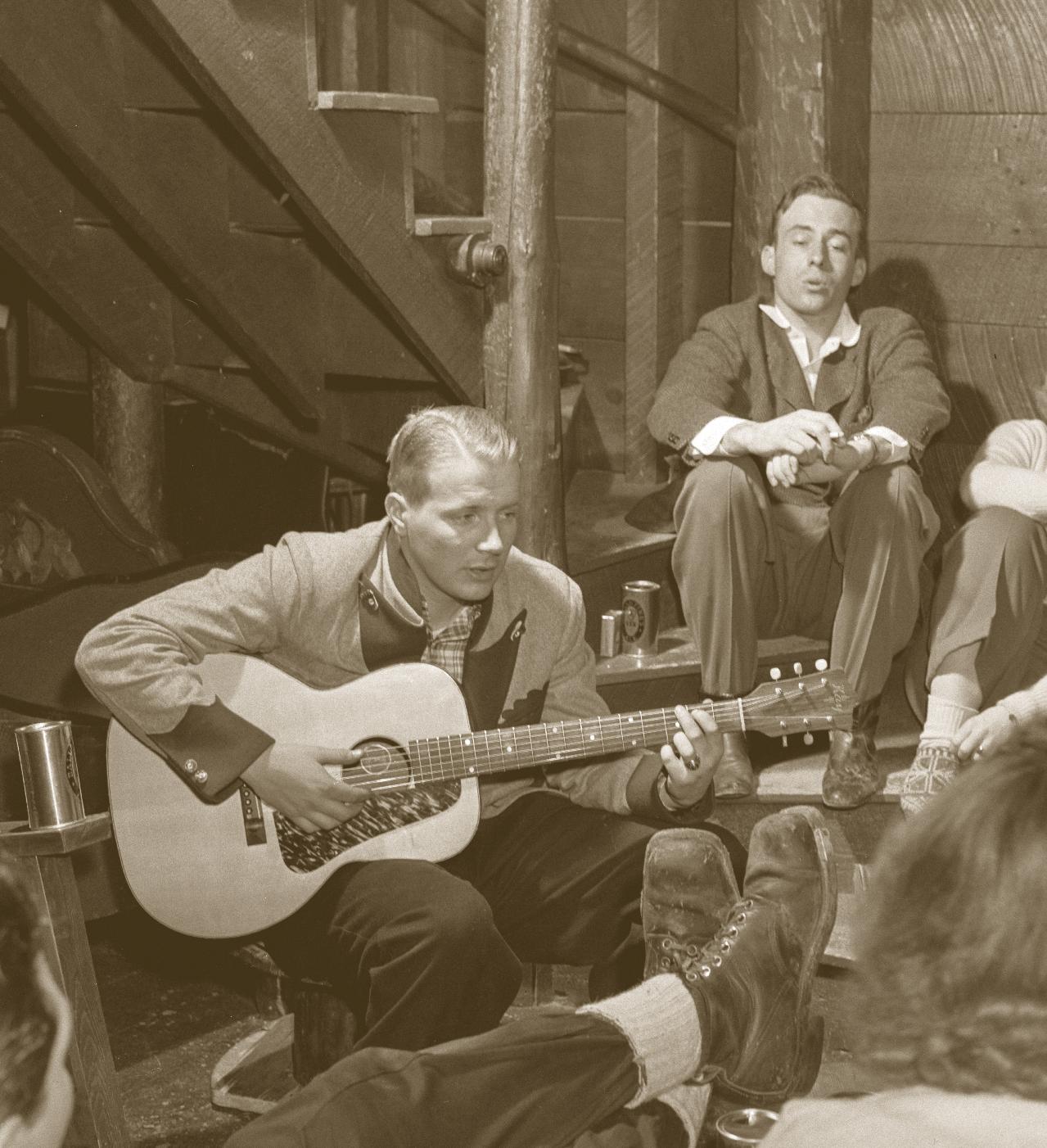
Whether you’re new in town or a seasoned local, getting out in the snow around the Mt. Washington Valley is simply a part of our winter nature. And with more than a dozen alpine and cross-country ski areas within a cup of coffee’s drive from North Conway, it’s no surprise there’s just as much going on after a day on the slopes. Live music, good food, friends and family, and some favorite libations seem to all be common factors for most après ski scenes. But what brought on this popular past time, and just what were things like after a day on the slopes in the 40s, 50s, and 60s?
The concept of après ski was introduced in the mid-1800s in Telemark, Norway, shortly after controlled downhill skiing was first invented, although it was not named as such. It began quietly in people’s homes and then moved on to the ski clubs. When popular skiing came around, it began to grow to new heights. By 1877, in the Christiana Ski Clubs (in modern-day Oslo, Norway) après ski featured large dinners with courses of potatoes to help soak up the aquavit that was passed around the table. Towards the end of 1800, après had made its way to the Alps, where the European style of après was moving to “grand” levels, to the grand hotels with all the modern amenities.
With skiing growing in popularity, hotels and inns were beginning to stay open during
Skiers from Boston enjoy some live music and libations at an unidentified ski lodge in North Conway in the early 1940s. Après ski scenes like this were quite common around the Eastern Slopes Region during the cold, snowy months. Photo courtesy of the Library of Congress, FSA/OWI Collection, [reproduction number, e.g., LC-USF34-9058-C]
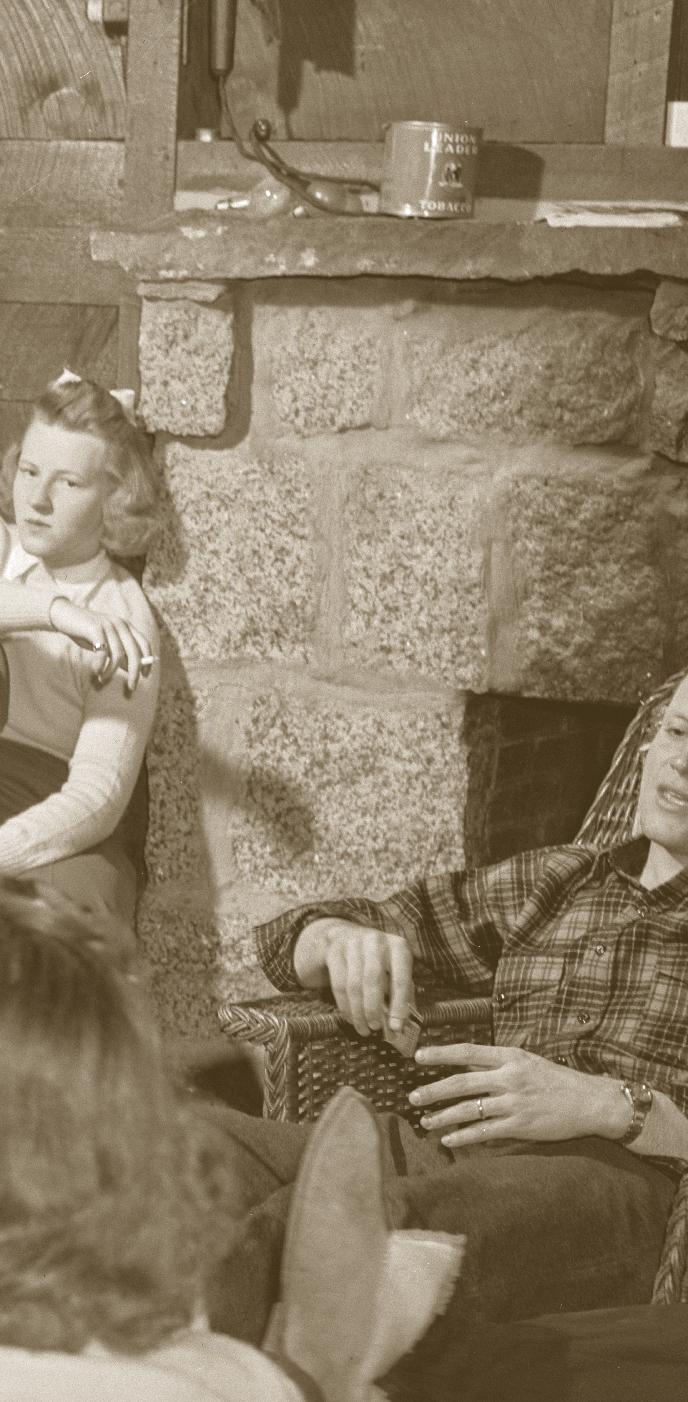
the winter months, a concept they had never been able to afford in the past. The crowds and demand kept their doors open all year, which ushered in the idea of the year-round resort towns. Now, their profits were just as good in the winter as they were in the summer. This trend made its way over to the Alps, notably St. Anton am Arlberg, Austria after World War I, where an advanced stage of après began. Ski towns with small inns and hotels catered to skiers who were looking for a place to stay after a day on the slopes. These accommodations carried with them a sense of luxury, and a touch of class to even the most tired of skiers.
By 1924, hotels in Charmonix, France were staying open all winter to house all the skiers, and this allowed the town to hold the very first Winter Olympics. It was around this time that the French coined the term “après ski” to “describe celebrating with fine food, and drink, the daily escape from hypothermia on vaulting terrain above the resort.” In America, après ski was in its infancy and looked a little different
from the luxurious hotels, food, and drink of Europe. Prohibition in the 1930s dampened a lot of the imbibing that was so popular in Europe. Skiers were more concerned with finding good places to ski and having a bed to collapse in at the end of the day, over where to find a good drink. Around this time, ski clubs were beginning to pop up around Boston and in northern New England.
The Schussverein Ski Club, formerly of Woodstock, VT. converted a farmhouse in Bartlett, NH into a bunkhouse with a kitchen and dining room to accommodate skiers. Alec
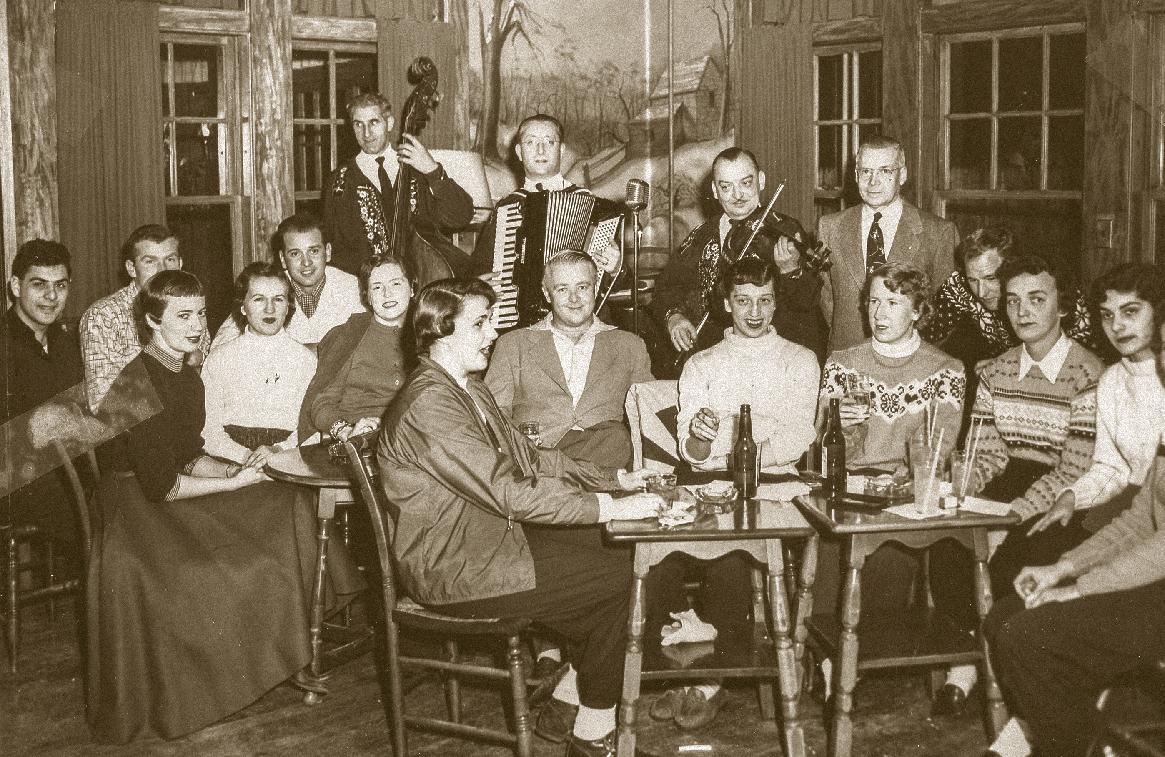
Emerson, a member of the ski club, fondly remembers après featuring spaghetti and wine for dinner, followed by group singing, and then early to bed for a good night’s rest. Before the introduction of the rope tow, in order to ski down the mountain, you had to first walk up it.
In the years before World War II, everything in the ski world was about to change. The “puritan” version of après ski fell by the wayside with the
of
Austrian skimeister Hannes Schneider brought his best instructors to teach alongside him, and with them came their love of food and drink after a day on the slopes.
”In the early 1940s, Gibson brought in the Swiss Orchestra to become the house band of the Eastern Slope Inn, to play for guests and après ski participants. Both images are courtesy of Mark Butterfield and the Gibson/Woodbury Collection
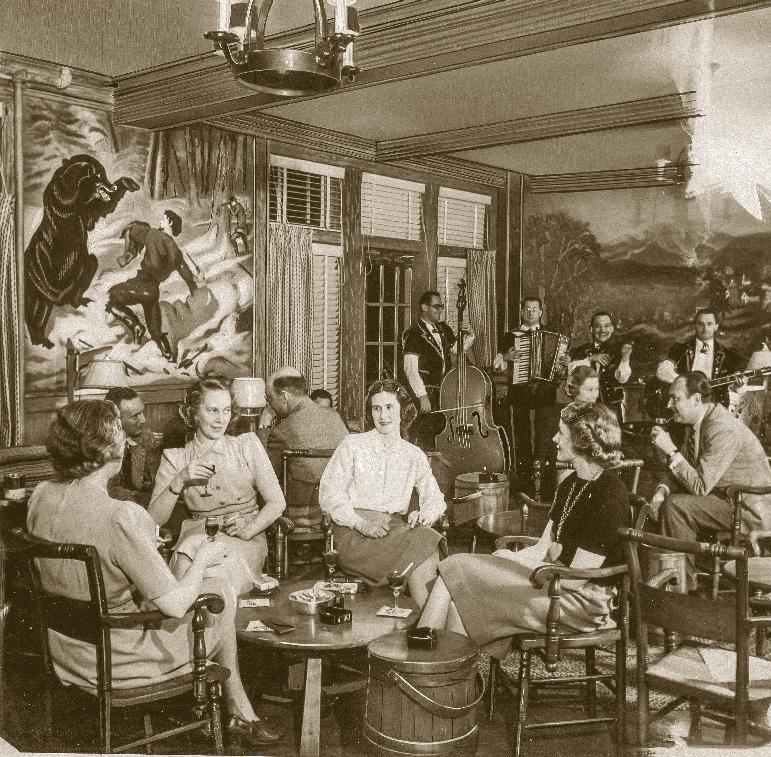
coming to America. One of the first to arrive was Benno Rybizka, who became one of Hannes Schneider’s famed ski instructors at Cranmore Mountain. He was first at the Wildcat Tavern in Jackson, NH, running the American chapter of Schneider’s Ski School alongside local legend Carroll Reed.
Rybizka helped to produce a concentrated ski scene in the Eastern Slope Region, with the help of railways coming from Boston. The area was riddled with small lodges, rooming houses, and hotels from North Conway to Mount Washington. Skiers had a choice of many different accommodations, from the Glen House (open year round); Whitney’s Inn (next to the modern-day Black Mountain) with its shovel handle rope tow, good food, beds and books; and the Eagle Mountain House, a grand hotel from the golden era in Jackson, NH, with modern amenities and luxury of the
après scene in Europe.
With the arrival of Hannes Schneider in February 1939, North Conway was close to becoming a destination on the ski map of America, as well as the après map.
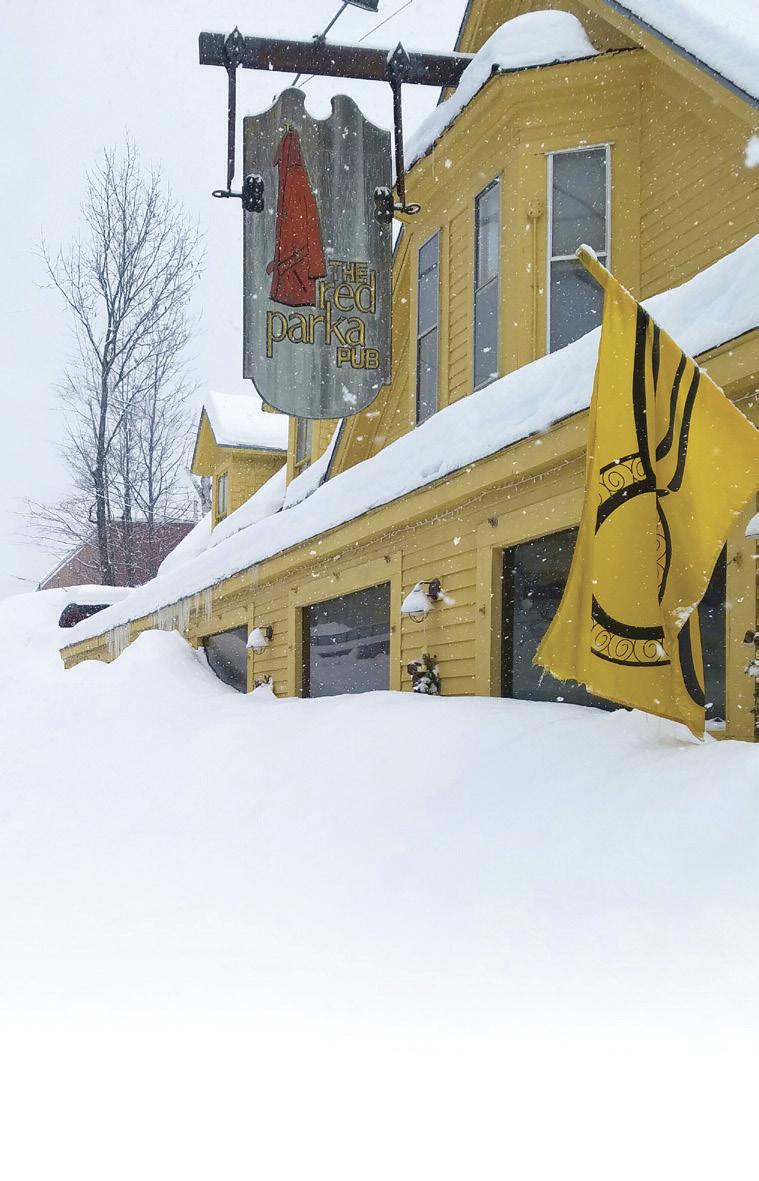


When Harvey Dow Gibson, North Conway local and New York Trust Company president, purchased the Randall House in 1937, the hotel had fallen on hard times due to the Great Depression. The stock market crash of 1929 put a damper on lavish vacations and stays in “modern” hotels. Gibson was in need of a hotel to complete his plan of putting North Conway on the map for skiing, and its location to Lookout Mountain (now Cranmore Mountain Resort) was too perfect. He renamed the hotel the Eastern Slope Inn, to pay homage to the Eastern Slope Region they were located

in, and began an extensive renovation of the first floor. Gibson brought the ski culture of Austria to North Conway and surrounding towns when he invited Austrian skimeister Hannes Schneider to head up the ski school at his new Mount Cranmore.
Schneider brought his best instructors to teach alongside him, and with them came their love of food and drink after a day on the slopes. The Eastern Slope Inn re-opened in December 1937, in time for Cranmore’s first lift-serviced season, and soon became the après ski hot spot in North Conway, with its aptly named après ski room. The room was decorated in the “Currier & Ives type,” (Currier & Ives, 1834-1907, produced lithographs of American scenes) and featured wallpaper depicting “gaily colored elephants in ski scenes.” The room became known as both the “elephant room” and the “Currier & Ives room.”
After Schneider’s arrival in 1939, the Austrian ski instructors would gather in the après ski room after a day on the slopes, relaxing and enjoying a cocktail. In the early 1940s, Gibson brought in the Swiss Orchestra to become the house band of the Eastern Slope Inn, to play for guests and après ski participants. At times, Gibson would sit in on the mandolin with the orchestra. Herbert Schneider, son of Hannes, fondly remembers life revolving around the inn and eating breakfast, lunch, and dinner there each day. He recalls that “… father would always go into the lounge and enjoy a martini. Then, he would go back to teach afternoon lessons at the ski school.” The après ski room was the perfect place for skiers to gather, as the inn allowed them to wear their ski outfits, rather than the required jacket and tie of the adjacent dining room.
TOP: The Oak Lee Lodge (pictured here in the 1950s) hosted some of the first après ski gatherings in the area. Around the inn was a small network of trails and even a “cobbled together” rope tow, which helped clientele when the Innitou Ski Club made the lodge their home. MIDDLE: Kay Mulkern, Mrs. Whitman, and Rita Clemons Mulkern behind the bar at Oak Lee Lodge. BOTTOM: The snow trains would bring skiers up from Boston on Fridays for the weekend and would make their way to the lodge for the night. Guests would entertain themsleves in many ways on the trains ... a form of pre-ski entertainment perhaps.

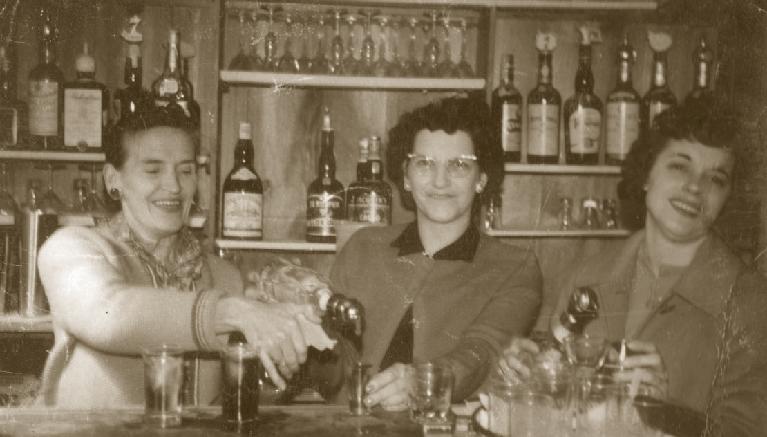
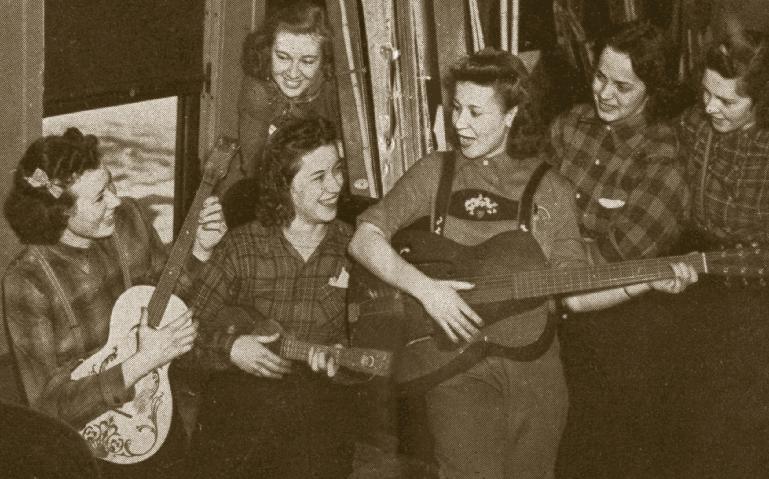
The Irish Pub on Spancil Hill, known for its pizza and Irish charm, was first known as the Maplehurst Cottage, owned by George and Della Meserve. It was then sold to Robert and Marilyn Goodman in 1938. The Goodmans winterized the property and are believed to have changed the name to the Oak Lee Lodge, most likely after the large oak tree on the property. Skiing was just coming to the area in the late 1930s, and with the addition of the Shovel Handle tow lift, Robert looked for ways to entice skiers to the lodge for their stay. There were not many establishments in the area, since skiing was still

seatings for dinner (always roast beef) and a fireplace where guests would gather on cold winter nights.
Around the inn was a small network of trails and even a “cobbled together” rope tow, which helped clientele when the Innitou Ski Club made the lodge their home. Young Tommy Mulkern met Thersa (Tess) Murphy at the Oak Lee Lodge in the 1960s, when she came up for the weekend with some girlfriends to ski. Tommy was the charming bartender at the time and she recalls sharing a small room upstairs with four friends. Tommy and Tess would later marry and took over running the lodge. By the 1960s, the region was beginning
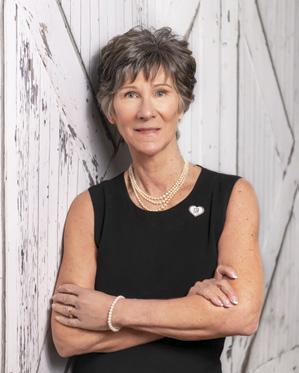
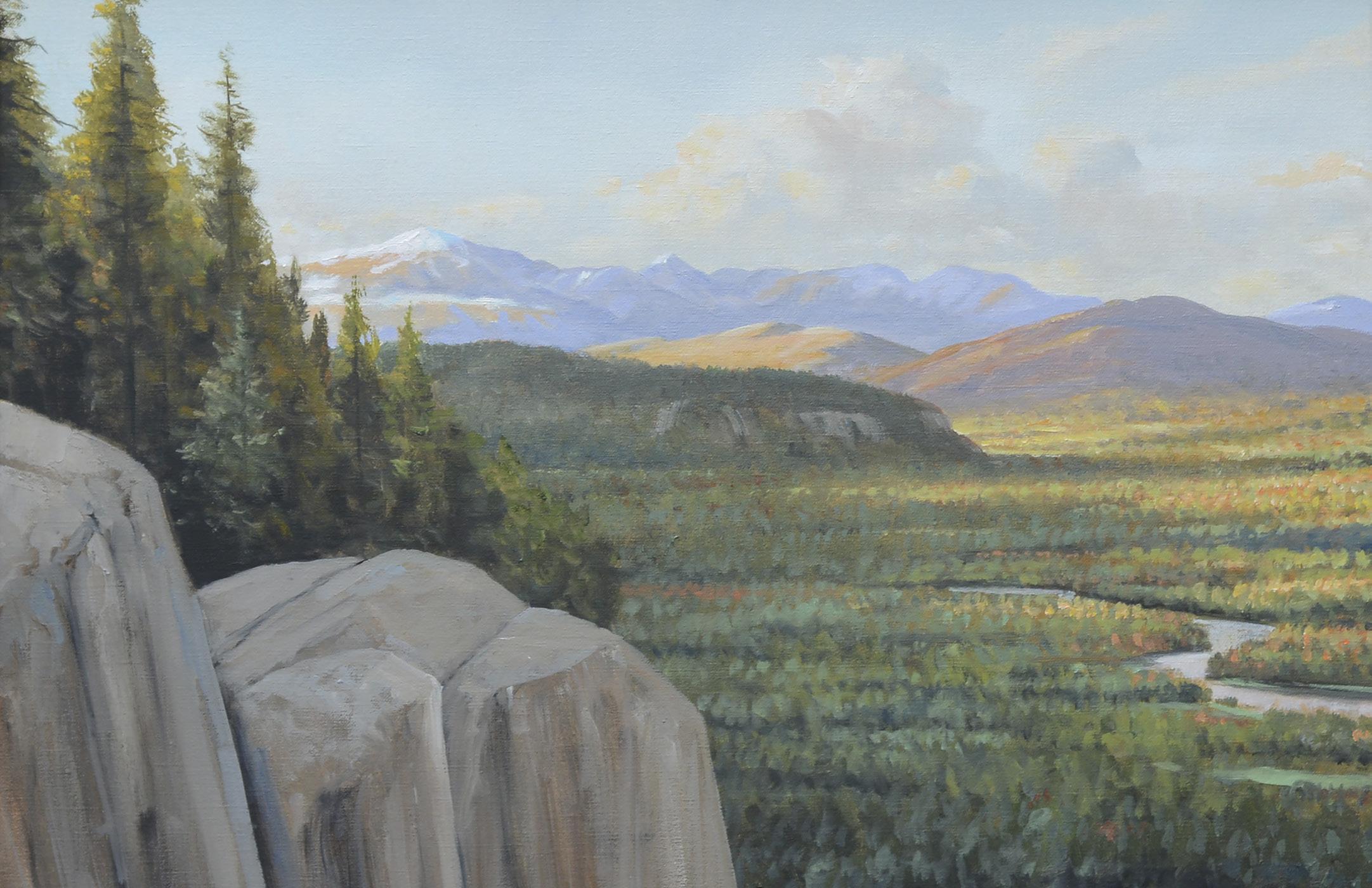
Oak Lee Lodge hosted some of the first après ski gatherings in the area. Joe Mulkern bought the lodge at first sight in 1953, based on his gut feeling that this was going to be “something special.”

in its infancy. The snow trains would bring skiers up from Boston on Fridays for the weekend and would make their way to the lodge for the night. Dinner and light drinks were consumed and then off to bed, ready to hit the slopes in the morning. The lodge would give their guests a boxed lunch, two breakfasts, and dinner—all for $11.
Oak Lee Lodge hosted some of the first après ski gatherings in the area. Joe Mulkern bought the lodge at first sight in 1953, based on his gut feeling that this was going to be “something special.” Joe and his wife Kay moved their family up from South Boston to run the ski lodge. When they discovered that the closest pizza place was in Berlin, they made a trip up there to try it. The result: they decided to put pizza on their menu and share some of the culture of South Boston with skiers in New Hampshire. At first, Joe would travel down to Boston to stock up on ingredients for the pizzas and haul them back in his station wagon. They made the pizzas from scratch, using his sauce, special ingredients in the dough, and special cheese.
The lodge featured a barracks with bunk beds, small rooms upstairs for overnight guests, and a dining room and small bar downstairs. There were two

to be known for its ski mountains and terrain, but it was not always the boom they had hoped for at the lodge. Tom and Tess began to get creative on how to entice skiers into the lodge after a day of skiing. They started advertising they were serving free hot soup to anyone coming off the slopes and began a Saturday night buffet. People would gather around the newly installed wood fire, with the pot of soup warming on top. Drinks were consumed, and sometimes an impromptu music sing-a-long would occur, a carry-over from their trip to town on the snow trains. The guests did not always stay up late, singing and imbibing, but when they did, Tom recalls that he knew how to handle any rowdy patrons, having grown up in South Boston.

In the 1970s and 80s, the lodge was still finding ways to bring in patrons. Skiing was much more established in the area, but the skiers were finding different places to lay their heads after a day on the slopes. Most patrons would come in for a beer and a pizza, and call it a night. In the early 80s, Marty Quirk graced the halls of the Oak Lee Lodge. Quirk was a well-established musician in Manchester, NH, playing traditional Irish songs. Tess and Tom knew they had to have him perform at the lodge,

LEFT: Skiers from Boston enjoy some quiet après ski at an unidentified ski lodge in North Conway, 1940. Library of Congress, LC-USF34- 053419-D [P&P] LOT 1227 BELOW: February 25, 1944. Skiers resting on the sun deck at Cranmore Mountain after a day of skiing. Courtesy of Anne and Steve Frost, Jackson, NH. BOTTOM: Rosanne Levesque and Al Wainwright (in red) enjoy some warm springtime après ski at the Intervale Ski Area in late March of 1969. Courtesy of Brenda and Marty Killourie.
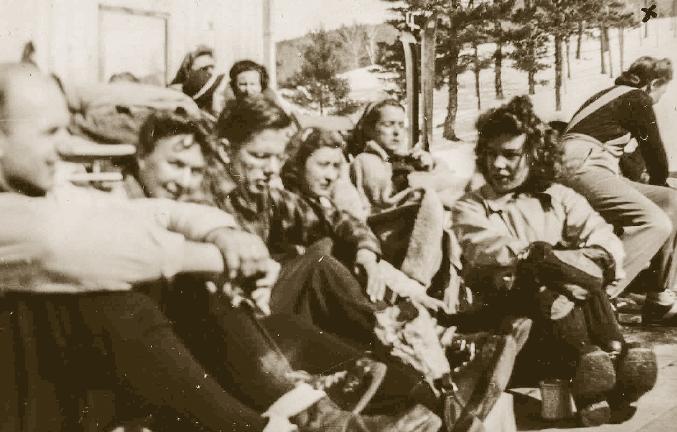
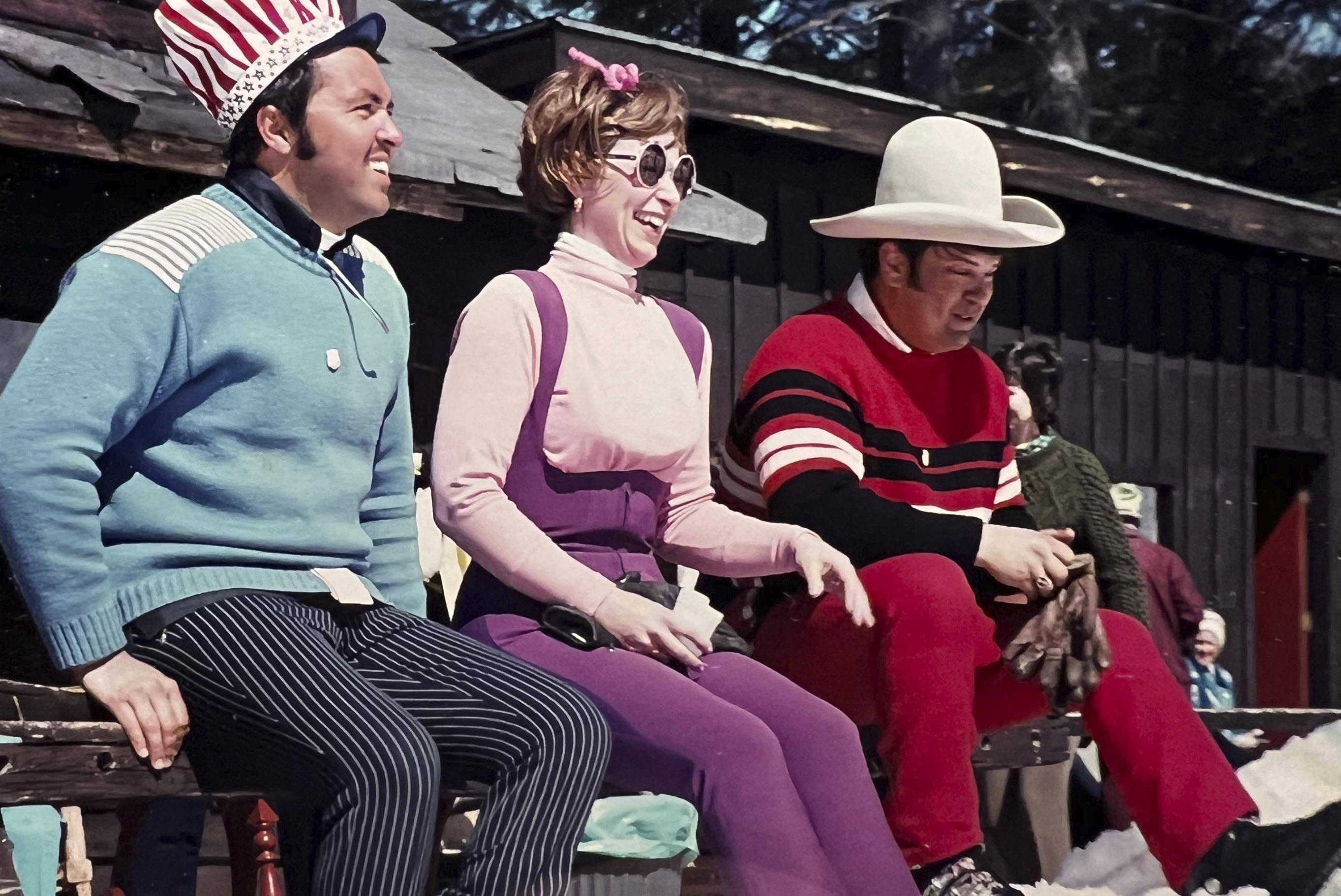
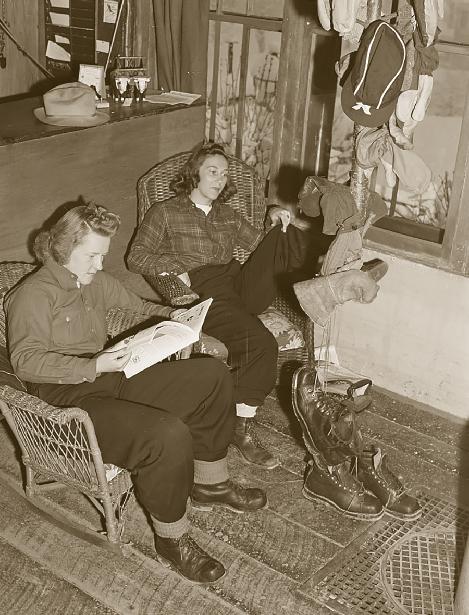
and offered him $50 and a place to stay for the night. Tess and Tom fondly recall Marty laughing and saying he could make much more down in Manchester, but accepted their offer to play. The joke of paying him $50 still stands today, as they joke they haven’t been able to get rid of him yet. With the addition of Marty Quirk, the Oak Lee Lodge soon became
There are many stories of establishments long since gone with “if these walls could talk” stories about the après scenes they saw and how some of these places have transformed into a place for skiers to stay for the weekend. When the pandemic hit in 2020, the après scene shifted, with many bars remaining closed, restricting capacities, and some canceling live music



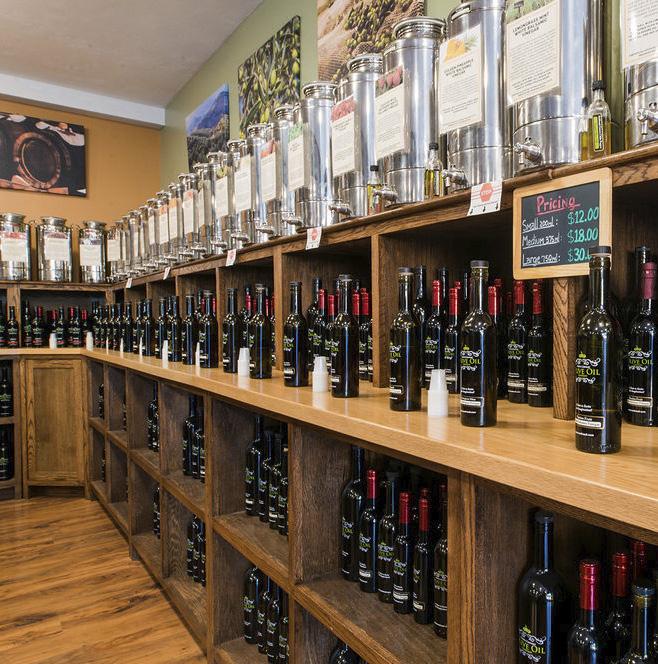

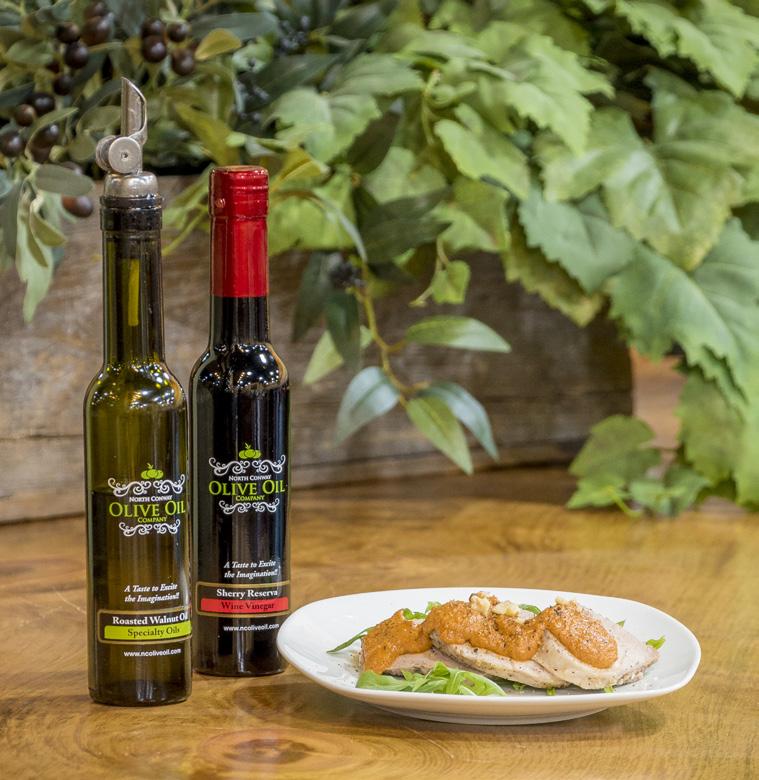
the Shannon Door Irish Pub, and once they began to bring in live music, the patrons began to stay and order more than just one beer. In the years since, the après scene in the area has, for the most part, revolved around music at everyone’s favorite watering hole. Everyone would gather after skiing to share stories of the day, relax, and listen to local music. Many bars in town would schedule their music based on what race league or popular ski day would bring in the most patrons.
altogether. But the après spirit did not die, it simply moved outside to the parking lots, where skiers would barbeque and hang out between runs. Nowadays, most ski resorts have seen a return to normal welcoming back live music and indoor après. The après scene is very much alive, forever resilient, and stays true to its beginnings as a celebration with good food, company, and drink.
In the years since, the après scene in the area has, for the most part, revolved around music at everyone’s favorite watering hole.

 By Matt Maloney, Tin Mountain Conservation Center Photography by John Rondeau Images captured in the northern White Mountains
By Matt Maloney, Tin Mountain Conservation Center Photography by John Rondeau Images captured in the northern White Mountains
The ermine belongs to a group of small weasels that are often overlooked by locals and visitors in our area. Also known as the stoat, or short-tailed weasel, the ermine is a mammal of the genus Mustela of the family Mustelidae native to Eurasia and North America. When seen, though, they often invoke curiosity and questions of, “What was that small creature I just saw?” What, at first glance, might seem like a squirrel, on second look, appears to be a smallish, weasely looking critter. If you suspect the creature is a small weasel, you may well have seen an ermine. Ermines are a relatively common creature, but overlooked, and far more secretive than chipmunks and squirrels, the most commonly seen small mammals. Ermines are predators like all weasels and can be seen at any time of year. They turn all white in the winter months, making them particularly beautiful when seen in the winter sunlight. The black tip of their tail can confirm it’s a weasel to the eye. More later about the ermine’s look-alike cousin, the long-tailed weasel, which also has a black-tipped tail. If you see one of these fascinating creatures, you have probably run
into it as it prowls for prey. Ermines are out and about in the daytime when they are on a scent, often tunneling through the snow tunnels of rodents beneath the snowpack, looking to make a kill. I have often run into their little bounding patterned tracks dead-ending in a tunnel presumably made by a mouse, vole, or shrew.
If you have a woodpile or just mice around your house, there is a good chance an ermine will pay a visit. Those small rodents that can so often become pesky around our homes are kept in check, in large part, by efficient predators such as ermine.
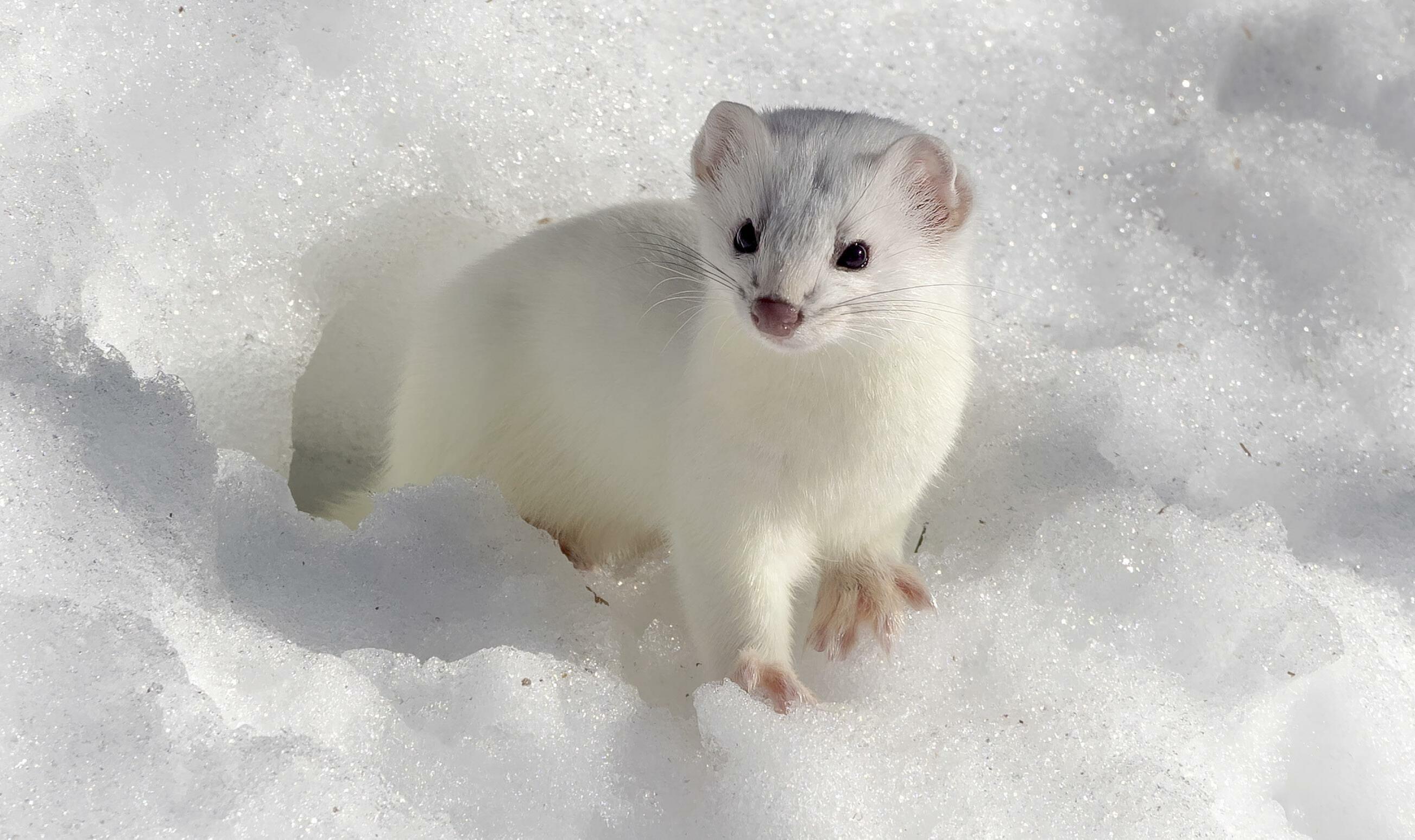
 Photography by John Rondeau
Photography by John Rondeau
If you have a woodpile or just mice around your house, there is a good chance an ermine will pay a visit. Those small rodents that can so often become pesky around our homes are kept in check, in large part, by efficient predators such as ermine. Ermine can even catch prey up to five times their size! They can catch and eat water-
from owls, hawks, and other predators. However, ermines can fit inside these holes perfectly, especially the smaller female ermines. Whatever you may find, tracking an ermine is a fascinating experience.
Seeing an ermine is the greatest joy, of course. I’ve come across them darting across ski trails in winter
A wonderful time to look for signs of ermine is when there is fresh snow on the ground in winter. Being an active predator, ermine tracks can lead the curious tracker into and through all kinds of out-of-the-way areas full of downed logs, brambles, and assorted deadfalls, as they seek out the homes of small mammals, and perhaps even a hibernating chipmunk.
fowl, muskrats, and even cottontail rabbits (Tracking & the Art of Seeing; Rezendes).



A wonderful time to look for signs of ermine is when there is fresh snow on the ground in winter. Being an active predator, ermine tracks can lead the curious tracker into and through all kinds of out-of-the-way areas full of downed logs, brambles, and assorted deadfalls, as they seek out the homes of small mammals, and perhaps even a hibernating chipmunk. The next time you’re on snowshoes or skis, take some time to look for the small, bounding tracks of the ermine. The footprints leave only a 1- to 2-inch-wide corridor and there can be anywhere from 9 to 35 inches between their strides. Bring a tape measure if you’re dedicated, but either way, they will be tiny tracks that appear with the footprints, side by side or slightly staggered, a sign of the bounding manner in which all weasels move.
Their prints can sometimes lead you to a tiny hole where an ermine has cached some prey, an exciting find. They sometimes cache prey in their own dens, as well. I’ve found blood drips in the snow from fresh ermine kills before, outside of tunnels where they’ve tracked down the occupants within. These under-snow or subnivean tunnels, as they’re often referred to, provide a warm pocket of air for rodents as well as safe haven
and darting over snowy roads while driving. When someone wonders what that little creature near their woodpile or barn is, I suggest it’s probably an ermine. If it’s white and looks like a weasel, it’s almost sure to be an ermine or long-tailed weasel.
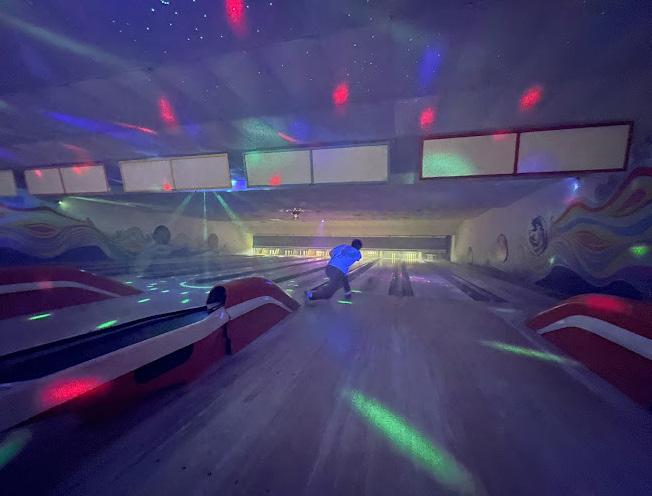
The ermine is one of three species of weasels in New Hampshire that includes long-tailed weasels, and pine marten. Weasels are part of the Mustelidae family, which includes otters, fishers, skunks, and minks in New Hampshire. Ermines are very difficult to tell apart from their close relative, the long-tailed weasel. To make things more confusing, ermines are also known as short-tailed weasels. As the name implies, short-tailed weasels (ermines) have shorter tails. Ermines are typically 7 to 8 inches in length, while long-tailed weasels are 11 to 12 inches long. Both weasels are sexually dimorphic, with female ermines about 50 percent smaller than males. This makes telling the two species apart even harder!
Another confusing similarity between ermines and long-tailed weasels is that both have brown fur with white bellies and black-tipped tails—and turn all white in the winter! Size is the only real discernible aid to the eye, and that can be difficult to distinguish at a glance. For the purposes of this article, we’ll focus on ermines, but you can encounter either of these two weasels when you’re out and about.
highest quality of fur there was, and many ermine were trapped and killed for the production of just one fur coat. When we bring ermine pelts into schools at Tin Mountain, students are enthralled at how soft the ermine fur is to the touch.
The number of weasels, such as ermine and marten, and the closely related mink trapped in North America, has not always been sustainable; many of New Hampshire’s desired fur
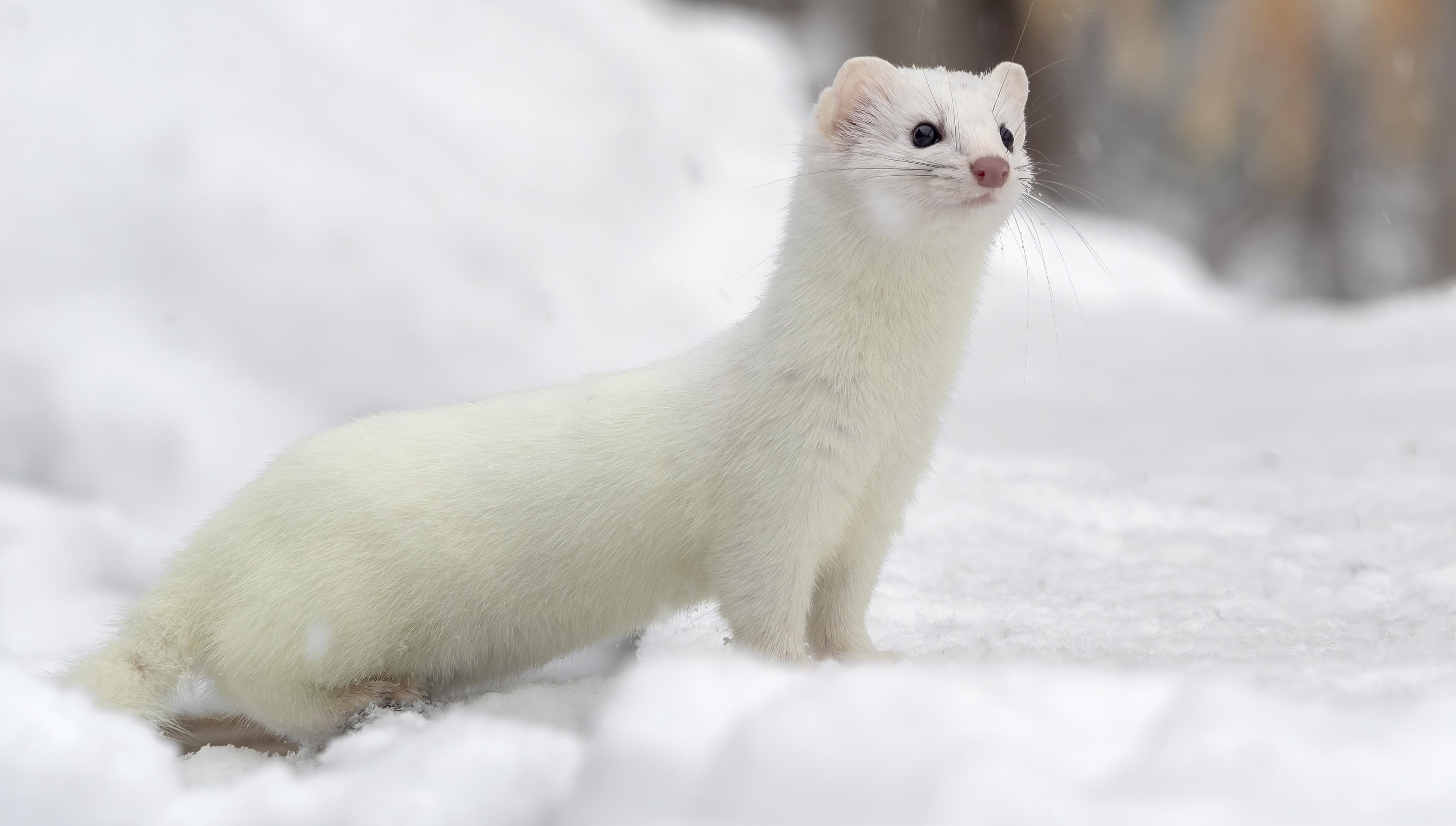
Here in the Mt. Washington Valley, the nearby vast forested areas of the White Mountains provide plenty of habitat, as do the rural forest edge meadows that can be found along many of the back roads in the areas, such as West Side Road. If you have a house, barn, or woodshed, there is a chance you will have an ermine on your property.
The ermine, like any predator, needs habitat where it can find potential prey. For an ermine, that means brushy areas in the forest or overgrown fields and meadows where they can find prey under the cover. Their prey items consist primarily of mice, voles, and shrews, which consist of about 80 percent of their diet in New Hampshire (www.nhfishandwildlife.com, NH’s Weasels, Eric P. Orff). Ermines will, however, eat any prey they can track down and kill, including snakes, frogs, and the aforementioned larger prey, such as cottontail rabbits. Ermines, in turn, are preyed upon by coyote, bobcat, fox, owls, hawks, and even mink.
Ermines will kill their prey by biting the back of the neck. They have been known to raid chicken coops occasionally and even take out all of the chickens. The upside of an ermine around human habitats is that they will control those mice and chipmunks!
Ermines used to be highly valued for their pelts, and still are in some areas, though trapping has greatly declined—to the benefit of ermine populations. Ermine fur was considered the
bearers (including beaver) suffered drastic declines in populations as a result. The monetary value of the furs has declined greatly, and trapping has a low impact on ermine population numbers today. Due to the highly forested and rural landscape that still covers much of New Hampshire, there still is abundant habitat for ermine. As long as the habitat that can support small prey remains, hopefully we can all have a chance at catching a glimpse of an ermine. Here in the Mt. Washington Valley, the nearby vast forested areas of the White Mountains provide plenty of habitat, as do the rural forest edge meadows that can be found along many of the back roads in the areas, such as West Side Road. If you have a house, barn, or woodshed, there
Ermines live in the northern half of North America. Their range includes most of Canada and most of the northern half of the United States, except for the Great Plains. Originally from Eurasia, ermines crossed into North America some 500,000 years ago, where they naturalized and joined the notably larger, closely related native long-tailed weasel.
is a chance you will have an ermine on your property. They will even get into the walls of old structures sometimes, as they root out and look to capture mice and flying squirrels that take cover. Consider an ermine your friend if this occurs.



Like all wild animals, the reproductive success of ermines depends on food availability. Good wildlife habitat will allow for abundant small mammals, which in turn, will allow a high reproductive success for ermines. Another factor is prey competition. Those small mammals that ermine depend on are also being chased by fox, coyote, fisher, hawks, and owls, to name a few. Changes in wildlife composition in a forest can affect ermine populations because of too much competition at times. Right now, ermine populations in our areas seem healthy and stable.
Ermine have a litter of four to 13 young that are born after a four-week gestation period. Six is the most typical liter size (“The Color-Changing Weasel”—www. akwildlife.org). Ermine typically mate between late spring and early summer, but the female’s egg undergoes delayed implementation. This means embryo development stops for eight to nine months, after which the egg is implanted in the uterus wall for the gestation period. The young are born in April or May and cared for by the female ermine. She will nurse the babies for seven to 12 weeks. They will live in a nest, usually fashioned from a small rodent burrow and lined with the hairs of rodents and other prey. The young ermine will leave the nest after six to eight weeks.
An adult ermine is mostly a solitary creature outside
Many of the photos used in this article are of an ermine named, Twist. Twist was born on the property owned by wildlife photographer, John Rondeau. John tells us that one summer the ermine became trapped in a rain barrel and his grandson noticed it and saved it’s life. He named her Twist and she has continued to visit since.
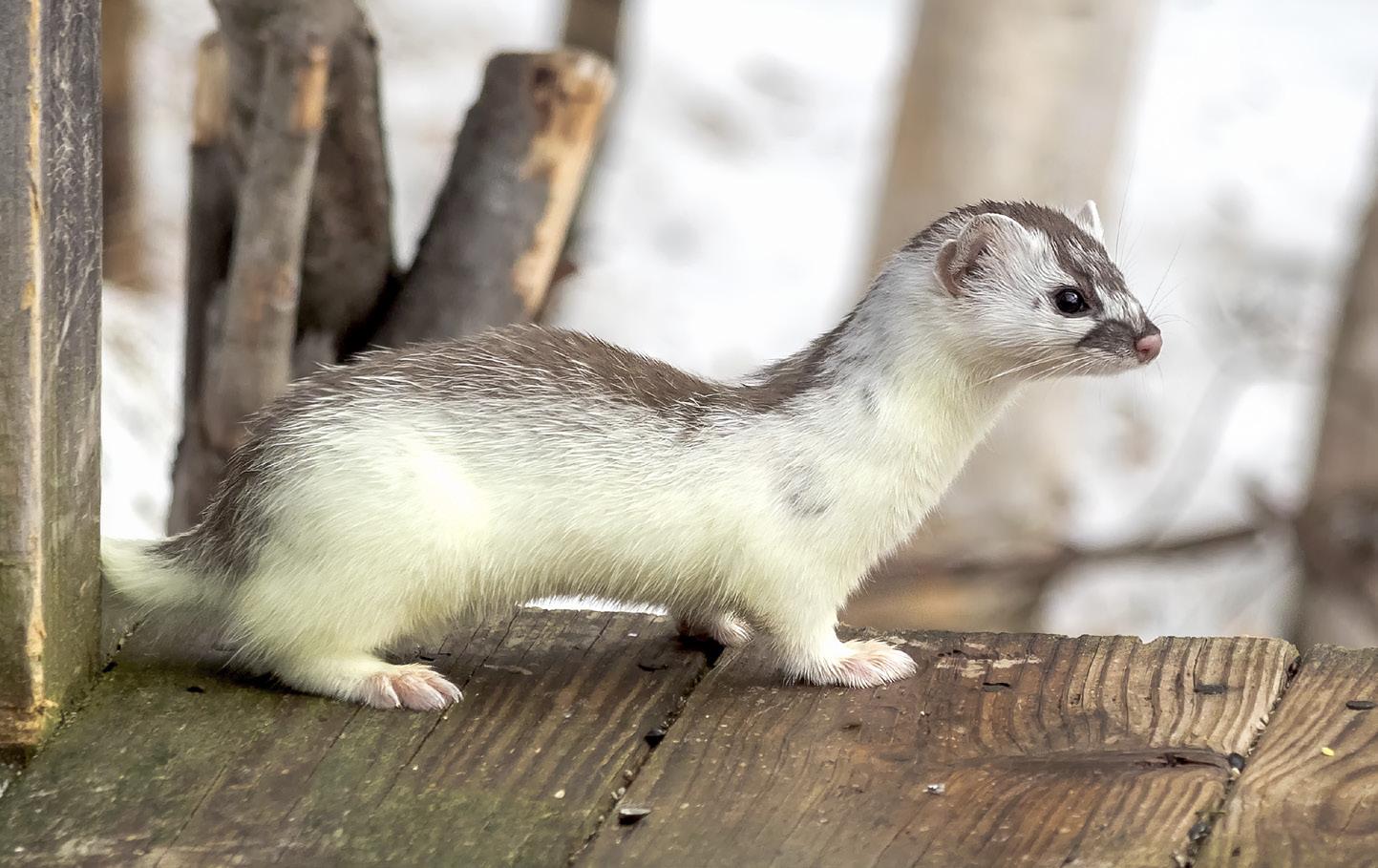
of the mating season. Females are sexually mature after only three to four months, while males are sexually mature around 12 months. Females typically survive two breeding seasons, while males only breed once (AKwildlife.org). An ermine’s life is not one of longevity; reproductive success is the key to their survival as a species.
Ermine are tough and adaptable creatures. They can live at most elevations below treeline in the White Mountains, and their range extends throughout much of Canada and Alaska to the north, and south to Colorado and Pennsylvania. The closely related long-tailed weasel has a range that extends from just north of the border to the tropic.
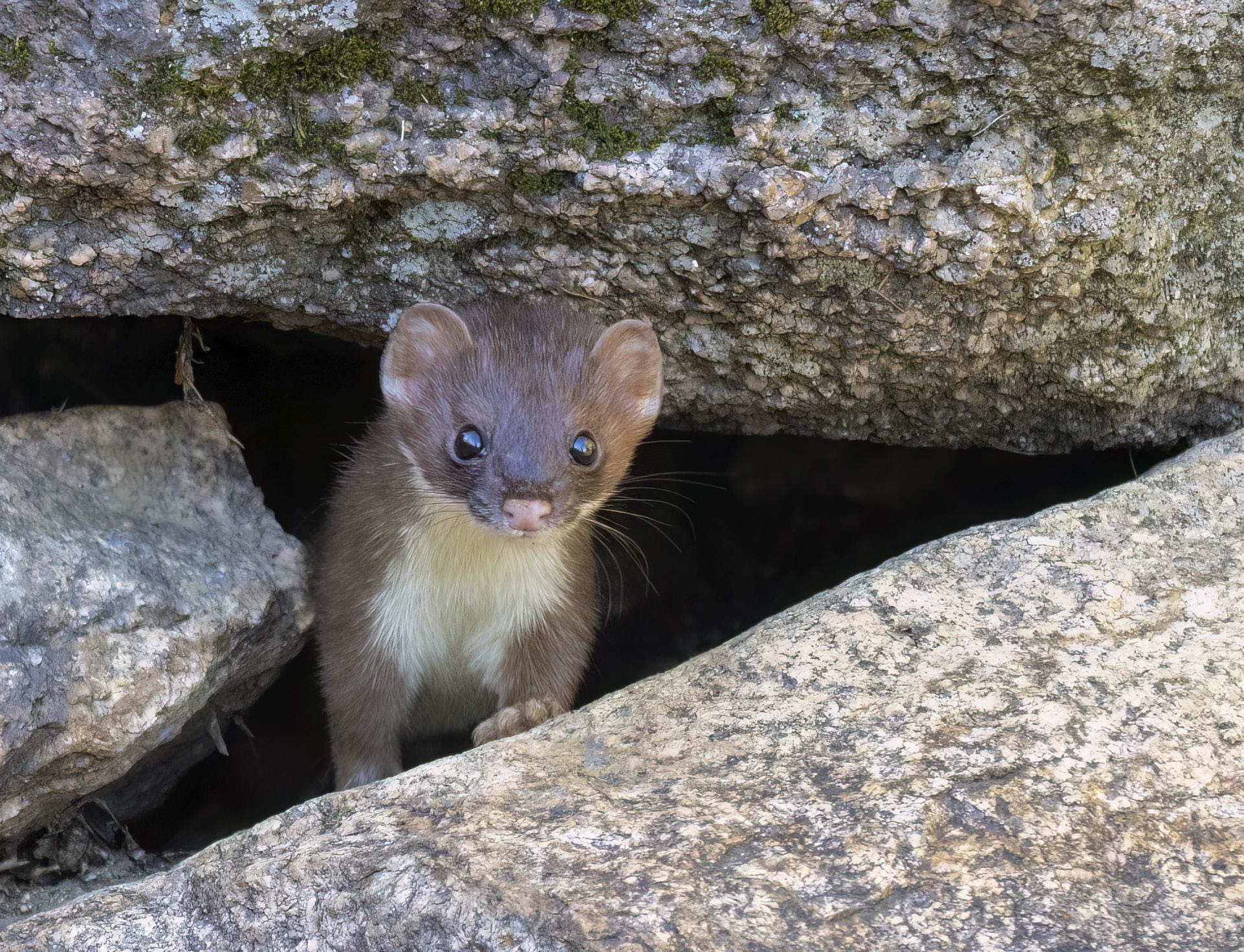
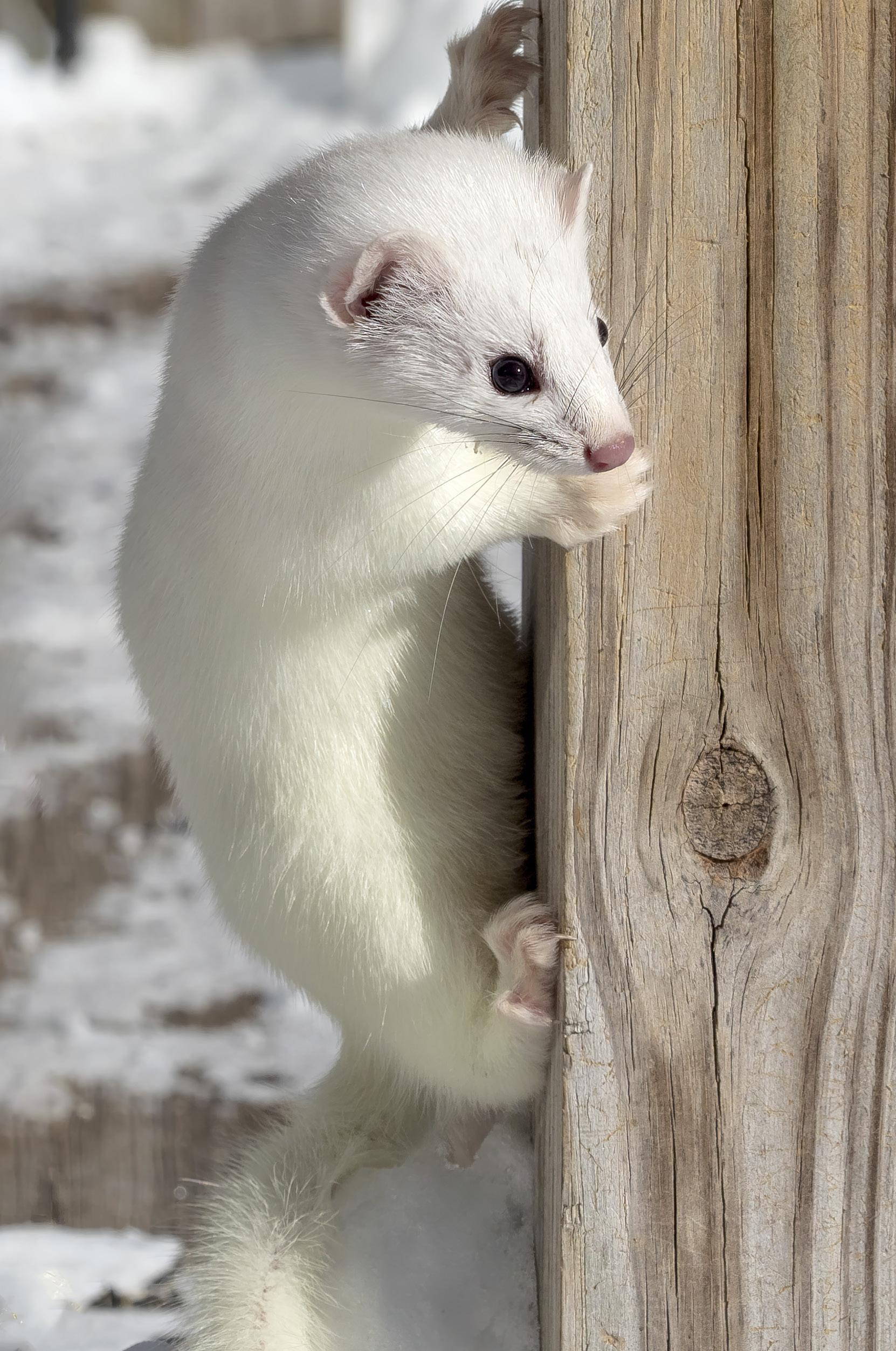
The best way to consistently detect the presence of ermine is in wintertime, when you can find their tracks in the snow. When you’re in the outdoors this winter, the trails and woods of the White Mountains and Mt. Washington Valley are great places to gain experience with tracking wildlife, and one will come to
appreciate all the wildlife hidden within that escapes our sight. Remember to keep an eye out for the tracks of ermine, often betrayed by their occasional tendency to spiral and circle in all kinds of directions, as these beautiful creature dart and dash in search of prey. A good field guide to tracks helps, and if you’re lucky, you may spot an ermine in its pure winter coat of white.
Tin Mountain Conservation Center, a non-profit environmental education and conservation organization, provides programs for children, families, adults, and communities that create a greater awareness and understanding of the natural environment. Since 1980, the center has offered hands-on programs in the schools, at summer camps, and within communities throughout northern New Hampshire and western Maine. Tin Mountain fosters future generations of environmental stewards and responsible outdoor enthusiasts.
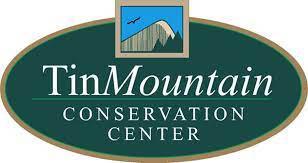
Coast Birding Field Trip: Biddeford Pool Saturday January 7, 8 a.m. - 4 p.m.
Bill McKibben: environmental activist, educator, and author of The Flag, the Cross, and the Station Wagon Friday, January 20, 7 p.m.
North Country Astronomy: Moose Brook State Park Saturday, January 21, 5:30 p.m.
Community Science: NABA Butterfly Count Information Session Thursday, January 26, 7 p.m.
Snowshoe Wanderings in Jackson Thursday, February 2, 10 a.m. -12 p.m.
Full-Moon Snowshoe in Jackson Saturday, February 4, 7 p.m.
Woof Woof Meow! Wild Canines and Felines of New Hampshire Thursday, February 9, 7 p.m.
Tracking Field Exploration Saturday, February 11, 9 a.m. -12 p.m.
Winter Waterfowl February 15 or 16, 8 a.m. -12 p.m.
Author Series: WAR PIGEONS: Winged Couriers in the U.S. Military Thursday, March 2, 7 p.m.
North Country Snowshoe Exploration: Boy Mountain Saturday, March 4
Pine Martens and Fishers with Jillian Kilborn Thursday, March 9, 7 p.m.
Ground Water Program Thursday, March 16, 7 p.m.


37th Annual First Season Benefit Dinner & Live Auction Old Saco Inn, N. Fryeburg Saturday, March 18, 5 p.m.

First Season Online Auction Saturday, March 18, 9 p.m. - Sunday, March 26, 9 p.m.
To register and learn more about these programs, visit www.tinmountain.org or call (603) 447-6991.
Carol Chaffee, REALTOR® www.carolchaffee.com (207) 240-1641 • (800) 450-7784


The Whitney’s Hill Learning Center at Black Mountain in Jackson, NH has lived a long and storied life. Over the last 88 years, that side of the resort has gone from cutting-edge technology as a first-of-its-kind destination ski resort, to a state of obsolescence; and now back into relevance as a living memory of a bygone era. Whitney’s Hill is one of the few remaining relics of the golden age of American skiing, one of the few pieces of living history that hasn’t been bulldozed over in the name of progress.
Whitney’s Hill was home to one of the first American ski schools (1935), it had some of the first snowmaking (1957), and it is still home to, arguably, the oldest overhead cable lift in the United States, the J-Bar at Black Mountain, NH.
This 88-year-old workhorse was originally built by George Morten in 1935, before he turned his attention to the once-famous Skimobile in North Conway, which spun from 1939-1989.
In 1935, at Moody’s Inn in Jackson, NH, with Morten’s help, the modern ski resort was born. Guests would stay at Moody’s Inn and ski in the backyard at the Moody Farm Ski Tramway. When the Moody Farm Ski Tramway was first installed, it was an overhead cable, with strands of rope that hung down. The guests would grab onto these lengths of rope and get dragged up the mountain.
It was plain, it was simple, and it worked. What more does someone need to ski, than a cable to pull them up and something on their feet to slide back down?
The next season in 1936, Bill and Betty Whitney purchased Moody’s Inn and renamed it Whitney’s. The Moody Farm Ski Tramway was modified by replacing the dangling ropes with Sears & Roebuck shovel handles for easier riding. With those changes, the Moody Farm Ski Tramway became the Shovel Handle Lift at Whitney’s Hill.

1948 – Whitney’s Hill expanded to become Black Mountain with the installation of a 3,500-foot-long Constam T-Bar (the triple chair replaced this T-Bar in 1984).
1954 – After 18 years of use as the Shovel Handle, the Moody Farm Ski Tramway became the J-Bar. This change made it easier for the guests to get up the hill.
1957 – Black Mountain installs its first snowmaking system on Whitney’s Hill.
1959-1960 – Night skiing lights are added on Whitney’s Hill, as well as a skating rink, and the base lodge is built.
1960 – A 1,150-foot-long Mueller T-Bar is added to service novice terrain. (This was replaced by the Platter Pull in 1994.)
1965 – The Double Chair was added, increasing vertical to 1,100 feet; marking the next big step in the evolution of the resort. (This double chair was struck by lightning in March of 1995, and burnt to the ground.)
1969 – After 33-years, Betty and Bill Whitney retired and handed over the reins to former ski patrol director Don Murray and his wife Kathy.
1982 – A group of local businessmen take over Black Mountain and begin a five-year investment plan. The base lodge was expanded by 10,000 feet; and in 1984, they added the East Bowl Triple to replace the Constam T-Bar, as well as top-tobottom snowmaking. But the resort still fell on hard times.
LEFT: The winter of 1936/37 was the first in which the Eastern Slope Ski School operated, featuring the instruction of Benno Rybizka of the Hannes Schneider ski school of St. Anton, Austria. The ski school taught lessons on Whitney’s Hill, seen here behind what was Moody’s Inn. With its cable tow located behind the farmhouse, Whitney’s offered lodging steps away from its ski tow when it was owned by Edwin Moody. ABOVE: In 1959, lights were added on Whitney’s Hill, as well as a skating rink and new base lodge.
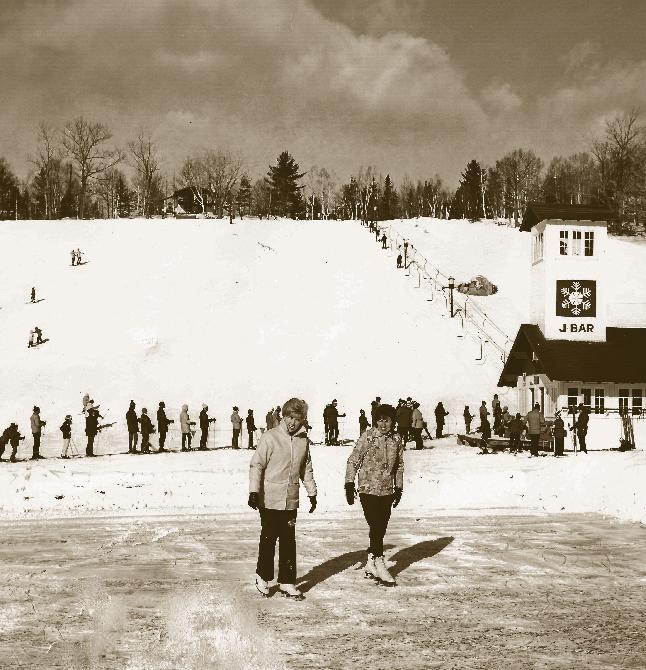
In October 1995, the Fichera family leased the mountain before buying the resort out of bankruptcy in March of 1996, a decision that John Fichera admits was driven by emotions more than numbers because he wanted to save his childhood ski area. With no prior experience in ski area management but a lot of heart, the Fichera family jumped into the fire, both figuratively and literally.
In what could have been an omen of the trials ahead, a lightning strike lit fire to, and destroyed, the summit double in March 1995, just before Fichera purchased the mountain— and it never got easier from there. Since their acquisition of Black Mountain, they have faced recessions, global warming, inflation, decreased skier visits, the rise of the mega resorts and disappearance of the Mom & Pop’s, rising fuel and electric costs, and even a global pandemic.
But, through passion, persistence, or just stubbornness, 28-years later, John still wakes up each morning, cinches his belt, and goes to work at Black Mountain. Making him and his family, the second longest operators of the Black Mountain Resort.
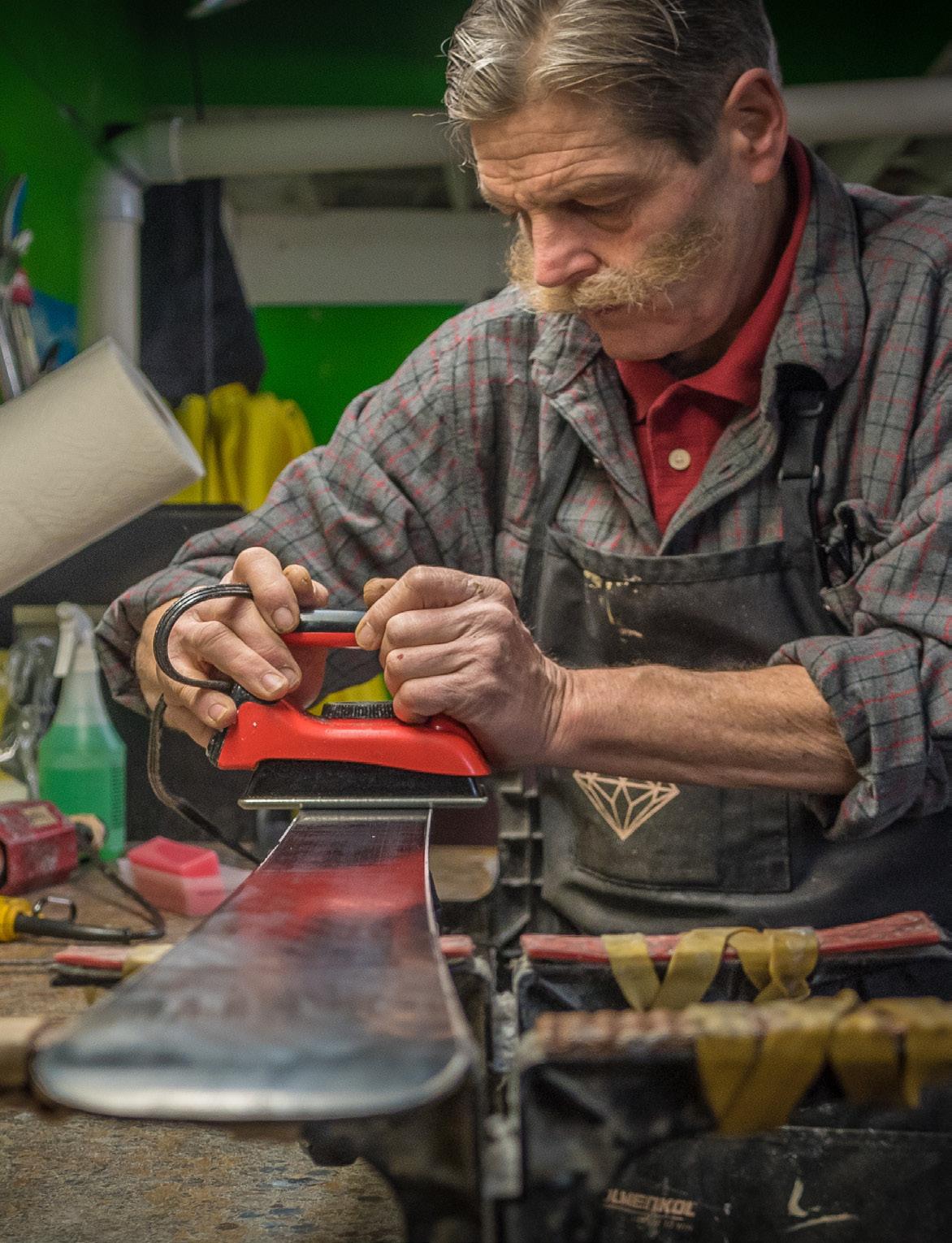
1935 - 1936—The Moody Family: 1 year
1936 - 1969—Bill & Betty Whitney: 33 years
1969 - 1982—Don & Kathy Murray: 13 years
1982 - 1995—Management Group: 13 years 1995 - present—Fichera Family: 28 Years
During the Fichera’s ownership, they’ve expanded terrain by adding the Lostbo Trail, White Knuckle, Lostbo Glades, Hi
The overhead cable ski tow at the Moody Farm in Jackson was one of the first two in the U.S. when it opened in 1936. The other cable tow, which began operation at the same time, was at Oak Hill in Hanover, constructed by the Dartmouth Outing Club. Edwin Moody sold his inn, farm, and ski tow to Bill and Betty Whitney the next year.
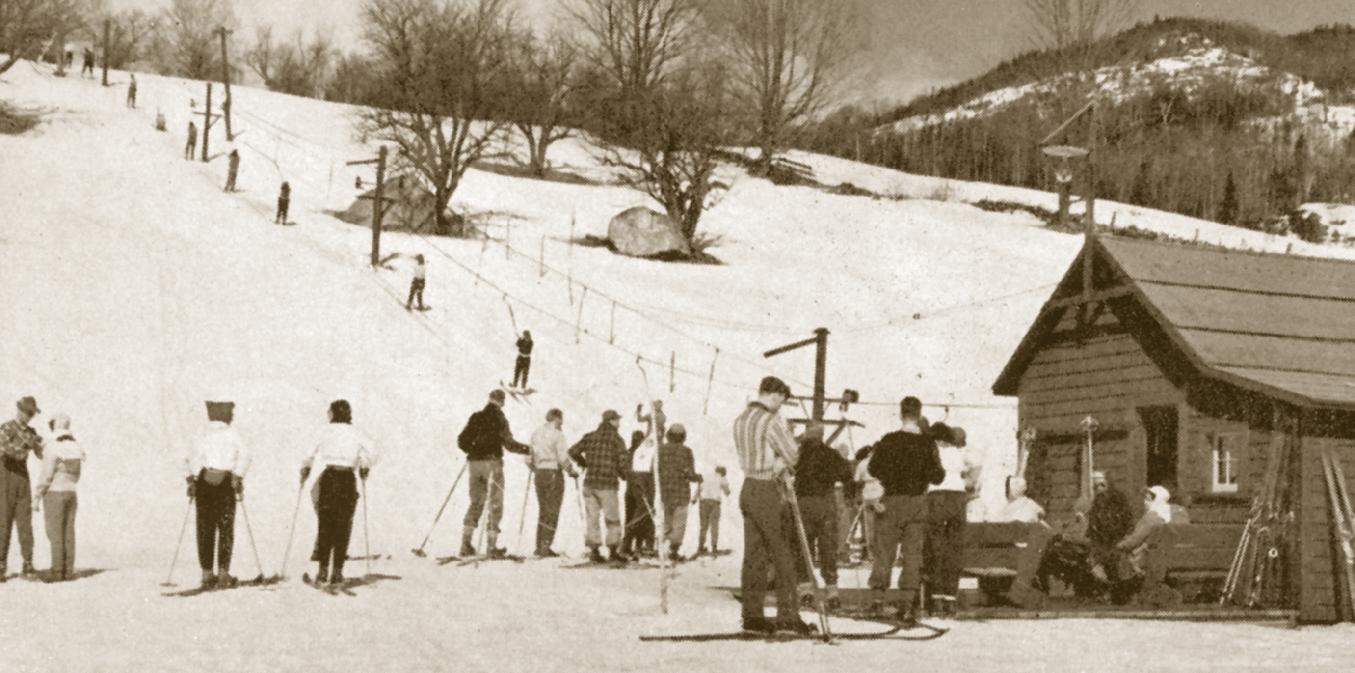
Road, Sugar Glades, Rabbit Run, Black Forest, Maple Glades, T2, Sweet Dreams, Mr. Rew, and Black ‘n Blue trails. In 2004, they transformed the resort into a year-round attraction by adding horseback riding in the summer and fall seasons. Like the other resorts, they installed cell towers to offset snowmaking costs. From 2011 through 2016, the Fichera’s upgraded the compressors, replacing all of the guns on the upper mountain, and worked to find ways to make the snowmaking systems more efficient. And that was when Whitney’s Hill fell into limited use.
From 1995 to 2010, the J-Bar ran sporadically every season. The mountain was never busy enough to run it both days every weekend, but there were lots of Saturdays, vacation weeks, and MLK weekends where the J-Bar provided much-needed terrain to spread out the hordes of visitors. But, by 2010, fewer guests wanted to ride an antique surface lift. It was the age of “magic carpets,” and guests were more impatient with the long traverse to and from the J-Bar than they were excited to ride a piece of history. It had become more of a detractor to the resort’s reputation than a prized possession. So, when the snow-making lines to Whitney’s Hill blew during testing in 2011, the decision to cap the lines was easy, and to focus efforts on the upper, more advanced terrain.
Luckily, after 88 years, some things still remain the same. Black Mountain is still an owner-operated ski area, one of the few remaining in the country. And by remaining independent, they can offer some of the lowest-priced tickets in the region; keeping skiing and riding affordable to as many as possible.
In the fall of 2021, over a glass of scotch, after watching In Pursuit of Soul, John and a local 10th Mountain Division veteran, discussed the trials and tribulations of owning and operating a Mom & Pop ski area in modern America. They discussed the his-
tory of Black Mountain, Whitney’s Hill, and the Eastern Slopes Region, the legacy left by the 10th Mountain Division, and what it was like to learn to ski in the days of yore with those veterans as instructors. By the end of that discussion, John had a new ski school director and had made a commitment to rehabilitate the J-Bar the following summer, to turn Whitney’s Hill back into a teaching area.
We have all heard stories about clunkers found in old barns; under tarps, and stuck in back corners among piles of scrap metal. Clunkers turn out to be treasures beneath the dust and rust, and that is what the J-Bar is.
In the 1990s, when the Fichera family purchased Black Mountain, the J-Bar was just an “old lift”—it was something that the instructors and employees had grown up skiing on, but it wasn’t historic (yet). Sixty years didn’t feel like a long time, but compared to detachable quads and magic carpets, it was obsolete.
But, just like a 1963 split back, hiding in the corner over time, the J-Bar had become a classic. A piece of history, a significant part of ski heritage and culture because it was the last survivor of a bygone era; and for that reason, it had to be saved. The Skimobile, the homestead, base lodges and buildings, historic hotels, and homes, all demolished in the name of progress. So be it nostalgia, the quest for a legacy, or sheer insanity, John Fichera’s commitment to saving the J-Bar was significant for him, as well as the Jackson community.
It was a significant risk to invest in hundreds of feet of snow-making pipe on Whitney’s Hill. It was a significant commitment of time, more than money, to have the mountain operations team pull apart and repair every wheel and plate on every tower; for a lift that received more scorn than praise when it
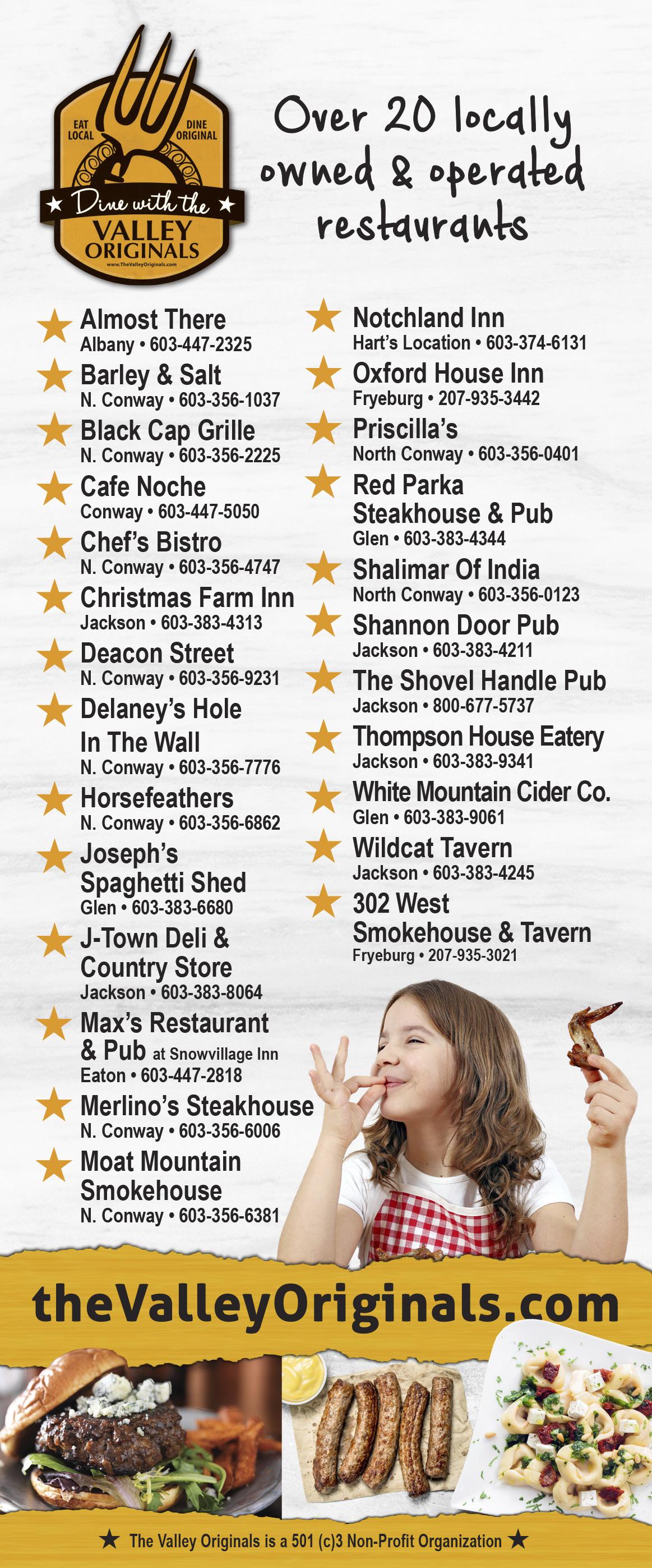
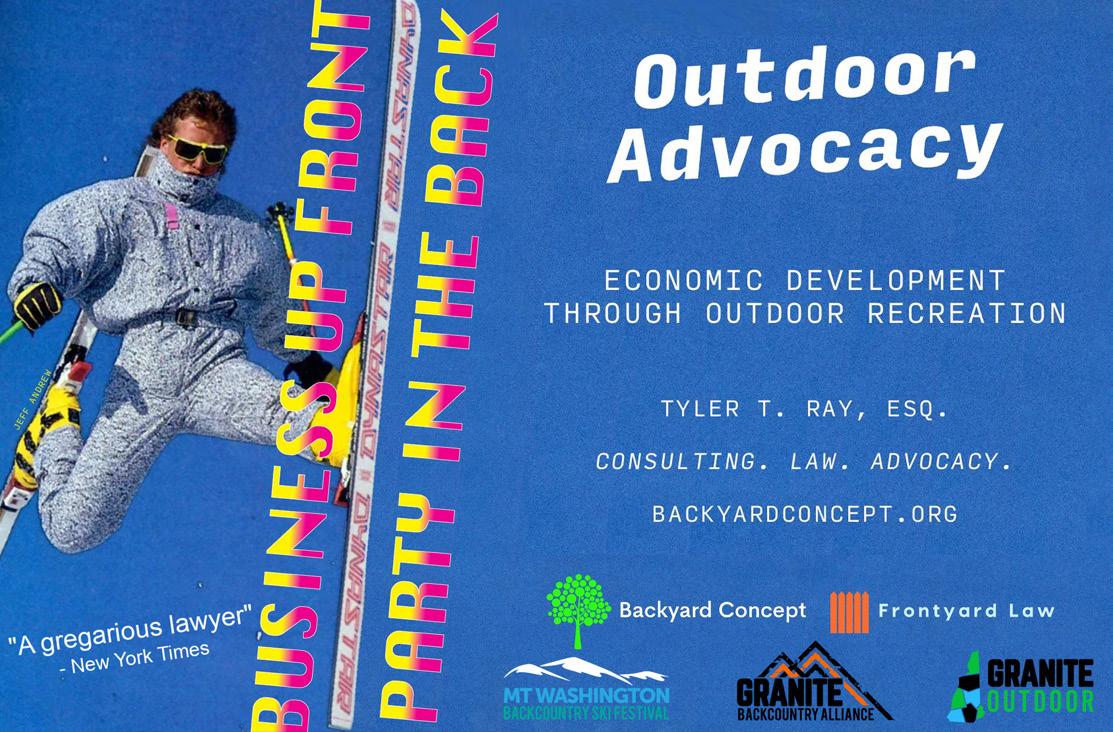


last operated. At every turn this summer, the reconstruction project grew and grew, and became more complicated; from a new foundation for the top counterweight to new paint on the tower, every step was just a little more complicated than planned. But, getting it done right, will help to ensure that the J-Bar is here for another 100 years.
Starting in April and concluding in November of 2022, phase 1 was completed, in preparation for the reopening of Whitney’s Hill for the 2022/23 season.
- 250 feet of airlines and 250 feet of water lines were excavated and replaced
- 1,000 feet of air and water lines cleared and repaired
- All wheels removed, rebuilt, and replaced
- Counterweight station repaired
- Towers cleaned, primed, and painted
- Base building restored to 1950s paint scheme
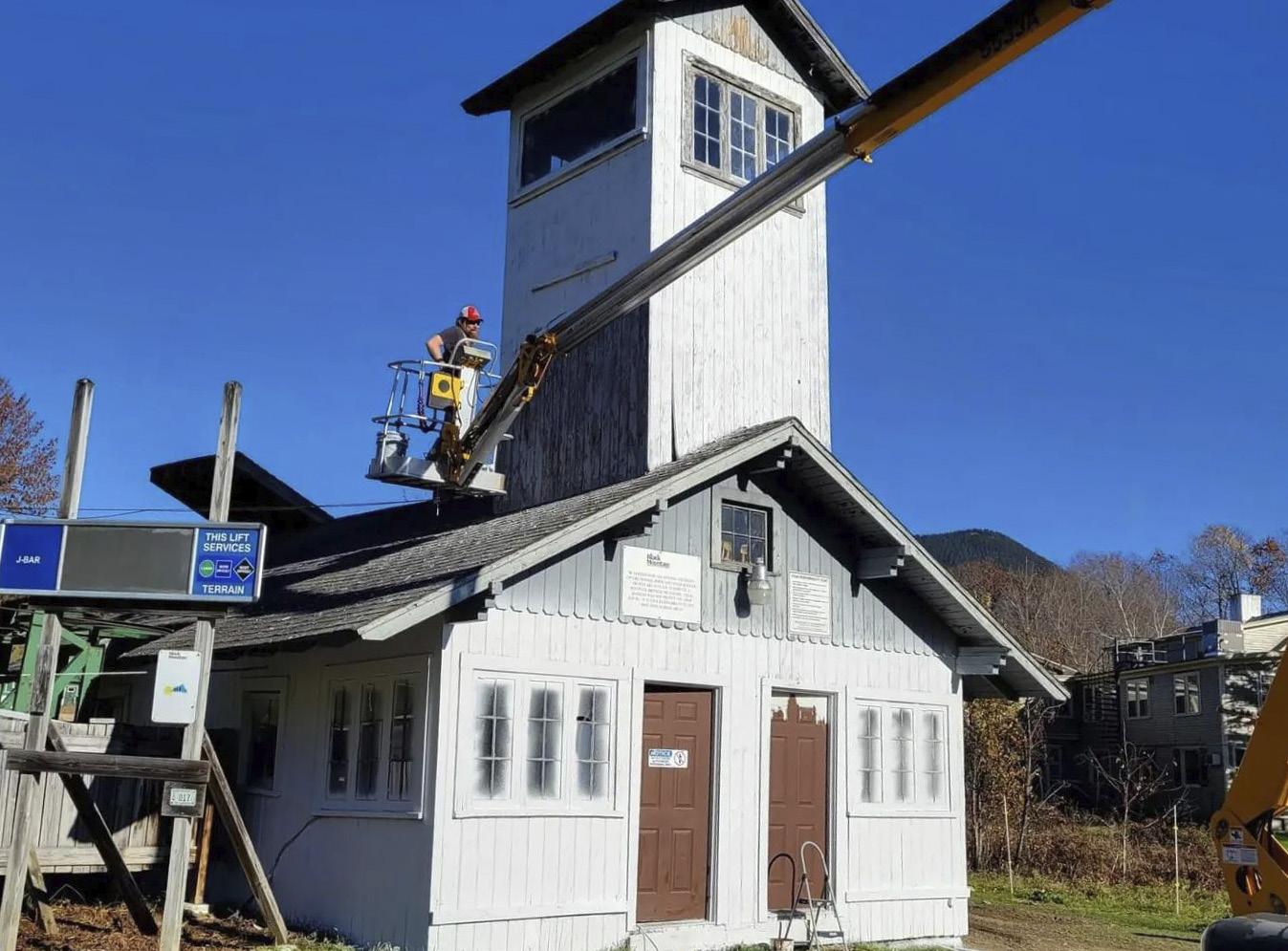

Thanks to the hard work of John Fichera, Doug Fichera, and Danny Allen the snowmaking is once again functional on the hill that used to be Moody Farm. Thanks to the support of an army of volunteers, the towers of what was once the Shovel Handle Lift look new, and the operator tower on the bottom building is adorned with a snowflake, like it was in the days of Bill and Betty Whitney. But there is more to do.
The rehabilitation of Whitney’s Hill is going to take years to complete if it is ever going to return to being a state-of-the-art teaching facility like it was in the days of skimeister Benno Rybizka, Franz Koessler, and Arthur Doucette.
For a little guy living in the valley of giants, the Fichera family has achieved a herculean feat—of keeping a resort alive, and affordable for the locals and other little guys. But what comes next?
Will the resort be gobbled up by a mega-resort, or will another group or family come forward to usher Black Mountain and Whitney’s Hill into its next 100 years? Will the future of Black Mountain look something like Whale Back, Mad River, or Cochrane’s? Or will it join the likes of Tyroll, Thorne, Whittier, Intervale, and the thousands of other lost ski resorts across the country?
Only time will tell; but for now, we know that the J-Bar will be spinning, and that there are plans in the works to safeguard the soul of skiing.
For additional information, tickets, and conditions, visit www.blackmt.com.

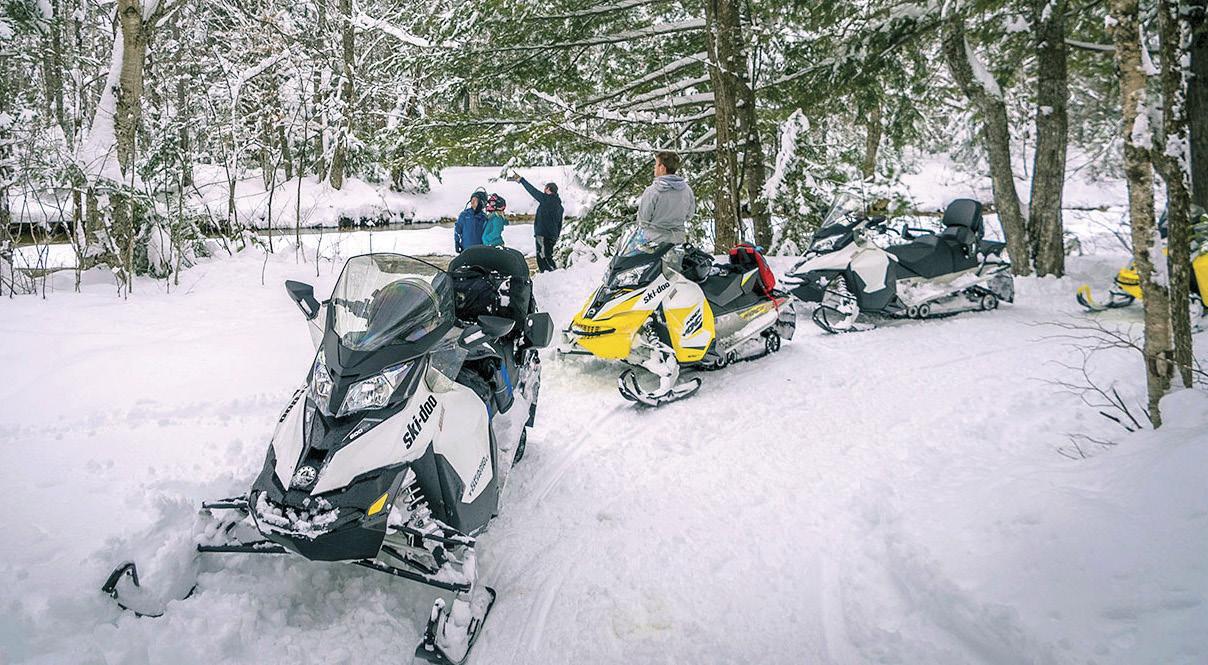
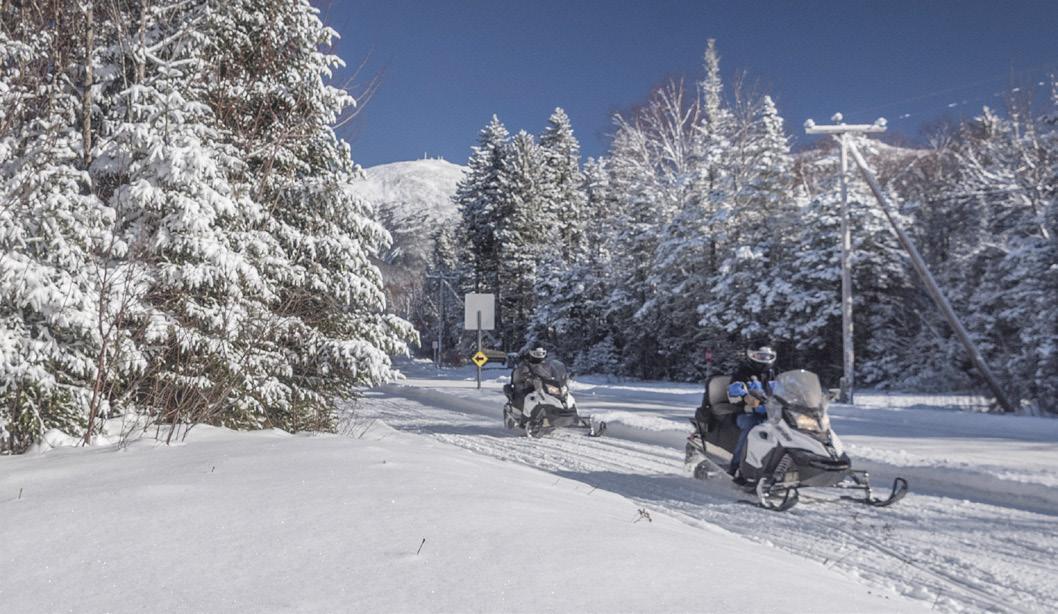


IT’S WORTH THE TRIP! Over 20,000 square feet of home fashion to fit your family’s needs. COME SEE WHAT’S COZY FOR THE WINTER SEASON!
Welcome to Northern New Hampshire’s LARGEST FURNITURE and APPLIANCE showroom! Our nine-level warehouse helps to ensure availability, and we carry many manufacturers in our large showroom. An in-house team of full-time service professionals guarantees we stand behind what we sell.




Visit our online virtual showroom for the best selection of the latest styles in furniture and appliances in the North Country!








